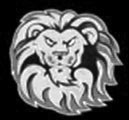Early Los Angeles City Views (1925 +)
Historical Photos of Early Los Angeles |
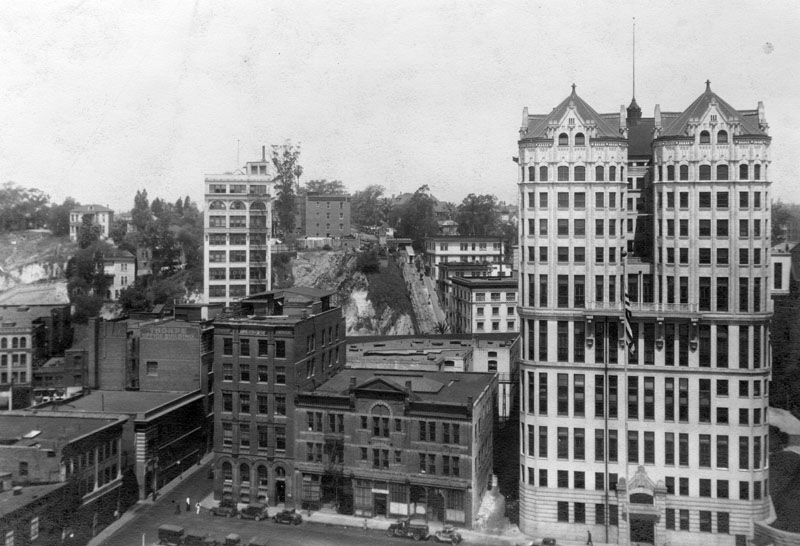 |
|
| (ca. 1925)^ - View looking west to the Hall of Records and other nearby buildings. Constructed between 1909 and 1911 to the cost of over a million dollars, the 12-story original Hall of Records at 220 N. Broadway was demolished in September, 1973. Court Flight can be seen behind, on Broadway (center of photo). |
Historical Notes Opened on September 24, 1905, Court Flight was built by Attorney R. E. Blackburn of the McCarthy real estate firm and Samuel G Vandegrift. It along with Angels Flight (built in 1901) were constructed to serve the wealthy residents of Bunker Hill. |
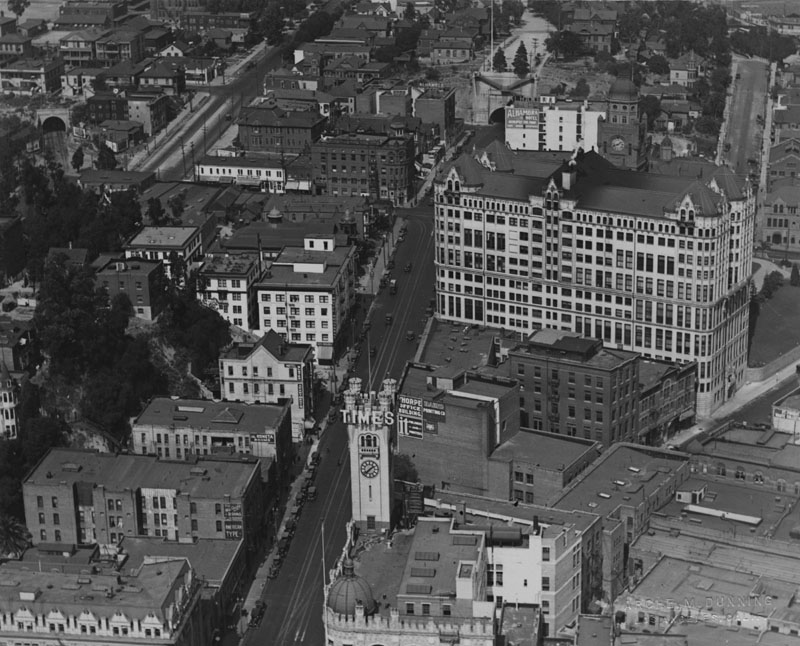 |
|
| (ca. 1925)^ - Panoramic view of the Civic Center in the 1920s, looking north from First and Broadway, with the old Los Angeles Times Building in the foreground and the Hall of Records, the old County Courthouse, and the Broadway Tunnel beyond. |
Historical Notes The third Los Angeles Times building opened on Oct. 1, 1912 — on the second anniversary of the bombing of the second Times building. It was used until the new Times Building (current location) was opened in 1935. The building was torn down in early 1938. |
* * * * * |
Broadway and 1st Street
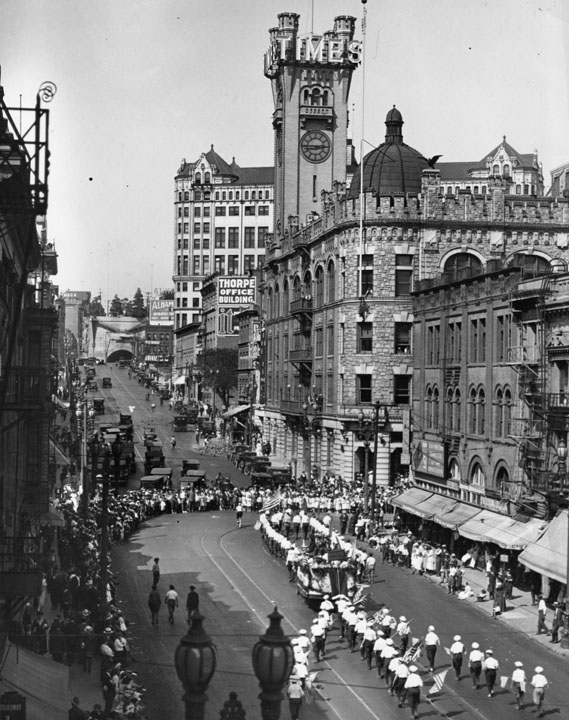 |
|
| (1920s)^ - View looking north showing a parade on Broadway rounding the corner at 1st Street and then heading east. The LA Times Building stands on the northeast corner. In view is the Broadway Tunnel and the Hall of Records. |
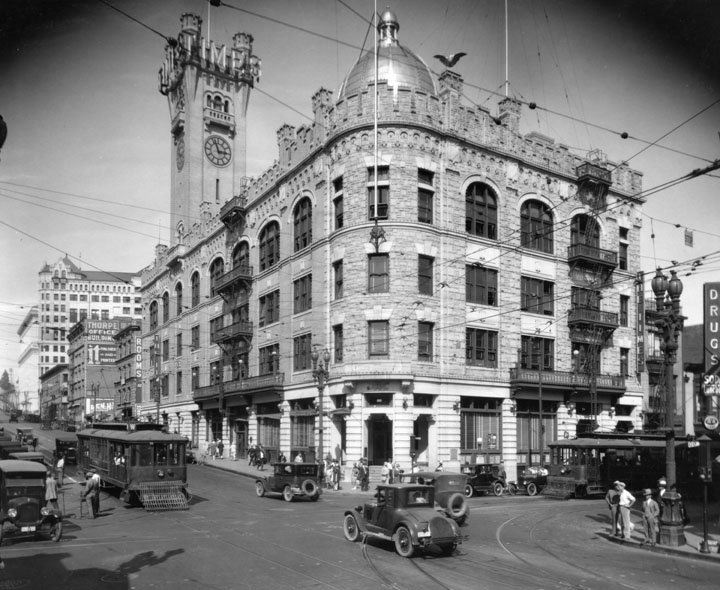 |
|
| (1926)^ - View looking toward the LA Times Building on 1st and Broadway. Cars, streetcars and pedestrians are seen at the busy intersection. |
Historical Notes In 1935 the Los Angeles Times moved into its current building located on 1st and Spring, its 4th building since it started publishing in 1881. Click HERE to see more in Early Views of the LA Times. |
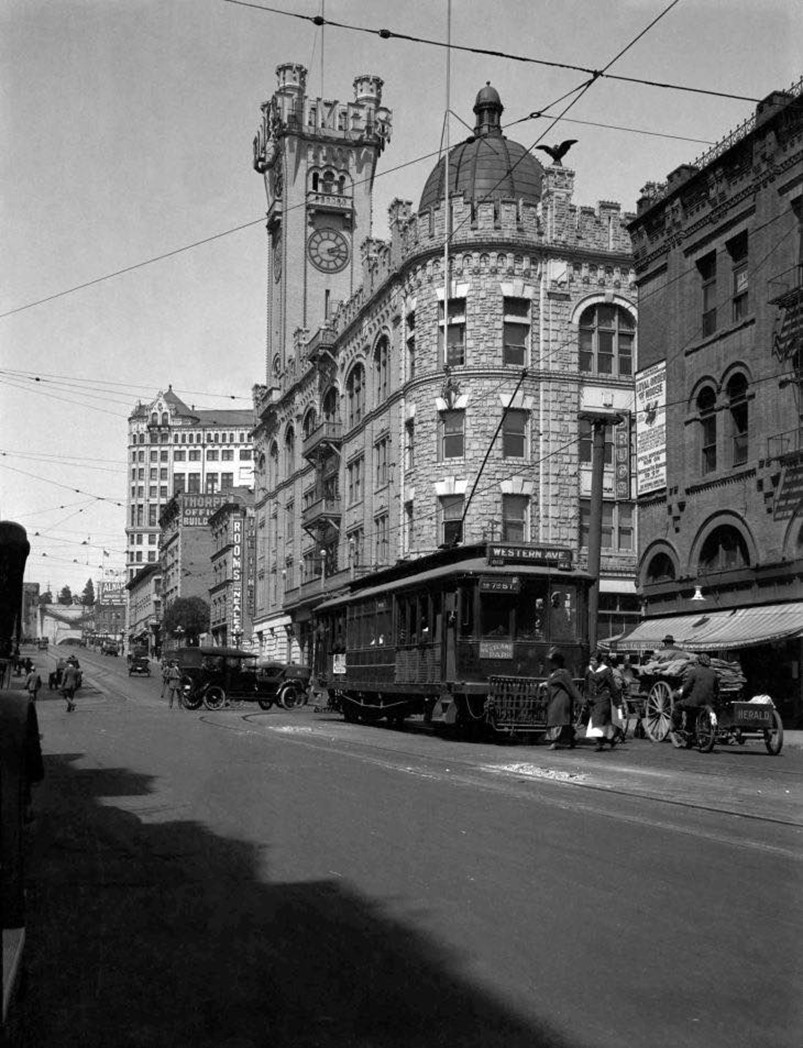 |
|
| (1920s)* – Looking north on Broadway, just south of 1st Street. Note pedestrians, a bicyclist delivering the Los Angeles Herald newspaper, a horse-drawn vehicle piled with what looks like textiles, a Pacific Electric Railway car, and several automobiles. The headquarters of the Los Angeles Times is behind the streetcar, and the county’s Hall of Records and the Broadway Tunnel are further up the street. Source: Homestead Museum |
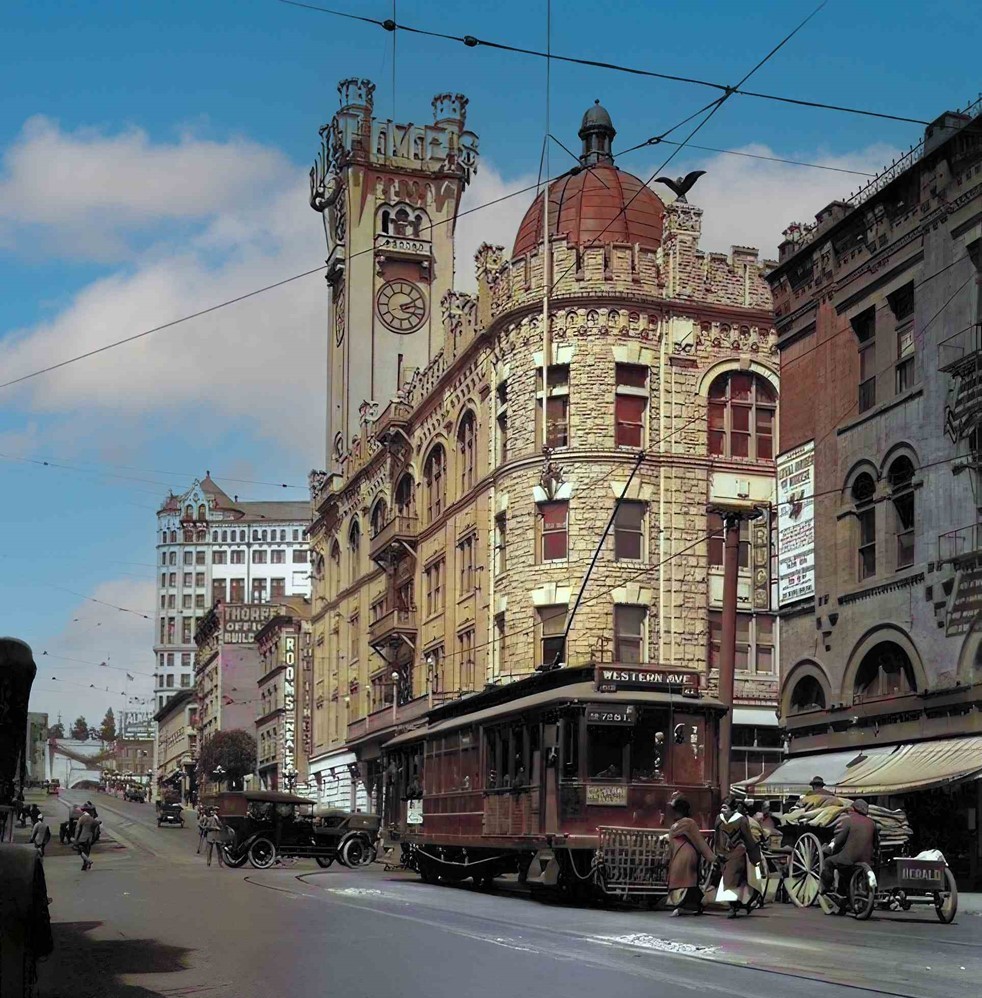 |
|
| (1920s)* – Looking north on Broadway toward 1st Street with the ornate Los Angeles Times building seen on the NE corner. Photo Source: Homestead Museum; AI image enhancement and colorization by Richard Holoff |
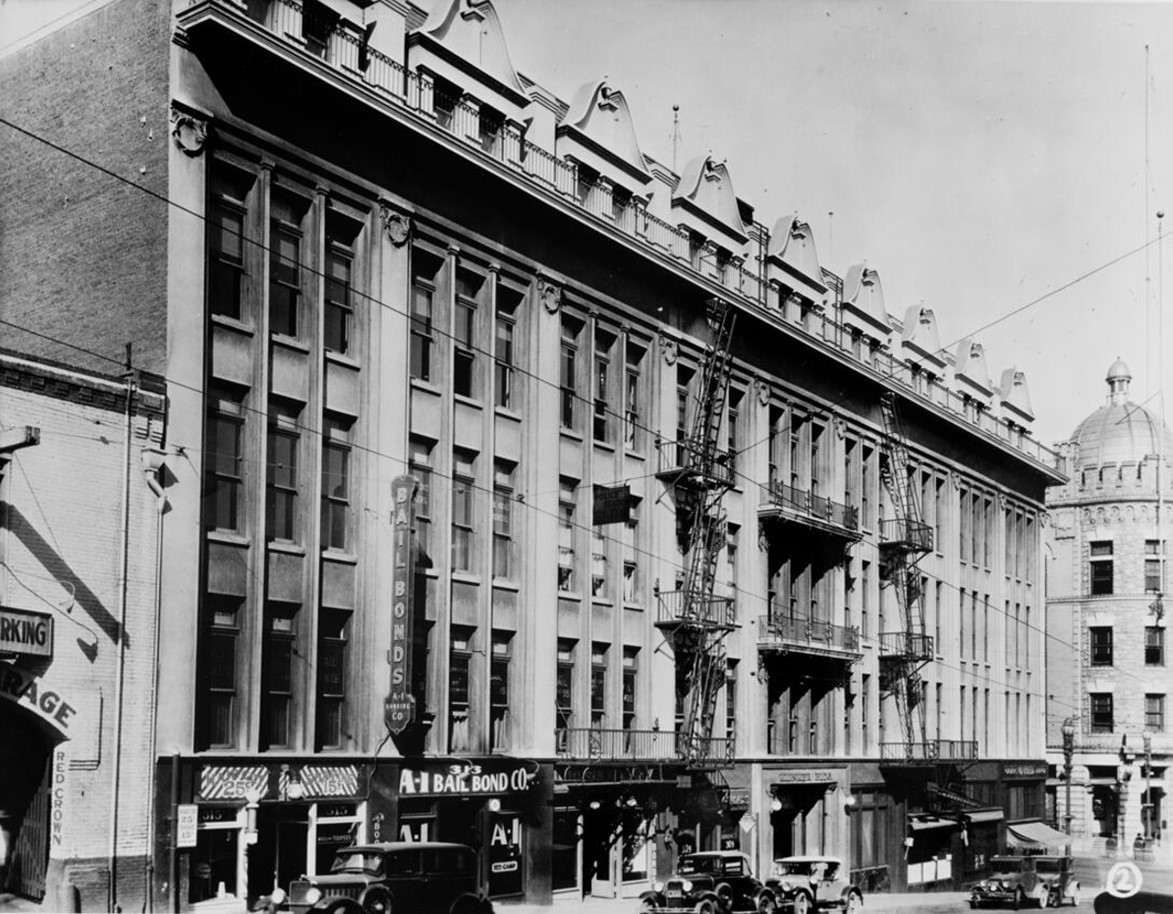 |
|
| (ca. 1929)* – View showing the Tajo Building located at 307 W. 1st Street (NW corner of First and Broadway). The LA Times Building is seen across the street on the NE corner. |
Historical Notes The Tajo Building housed various tenants over the years, including the USC Law School from 1911 to 1925, the Mexican consulate in the 1920s, and the United States District Court for the Southern District of California for nearly a decade. It was also the second home of the Los Angeles Stock Exchange for a short time. |
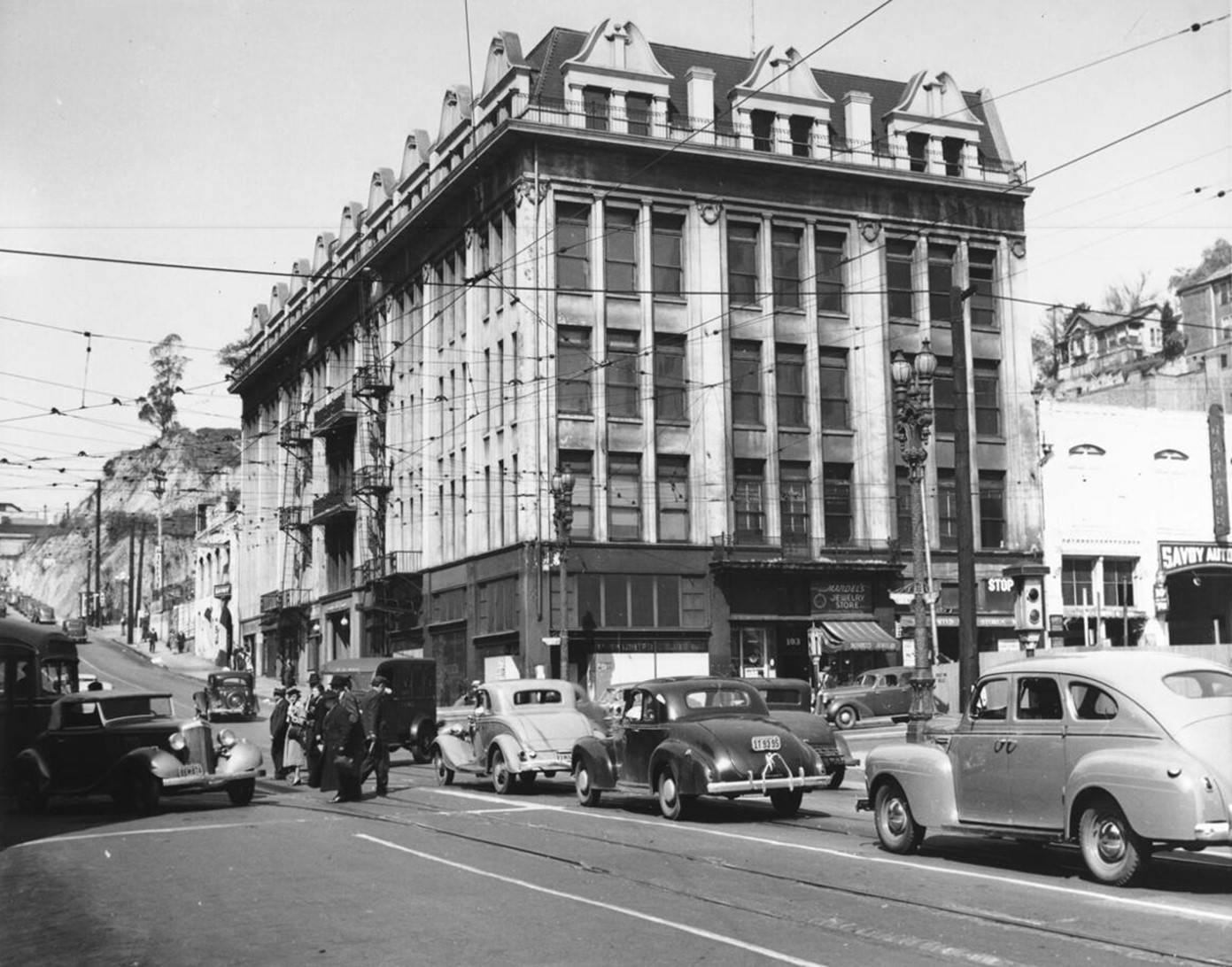 |
|
| (1940)* – Looking west on 1st Street at Broadway, where the Tajo Building is seen on the NW corner. Note the homes at upper-right on top of Bunker Hill which would be leveled down in the 1950s and 1960s. |
Historical Notes The Tajo Building was built in 1898 and designed by architects George Herbert Wyman and William Lee Woollett. The building had a stone front facade over a brick structure, with retail stores on the first floor and offices on the upper floors. It featured decorative wall dormers on the top floor as a notable architectural feature. The City of Los Angeles acquired the property around 1936 to allow for the widening of First Street, and the Tajo Building was demolished in 1940. The site is now occupied by the Los Angeles County Law Library. |
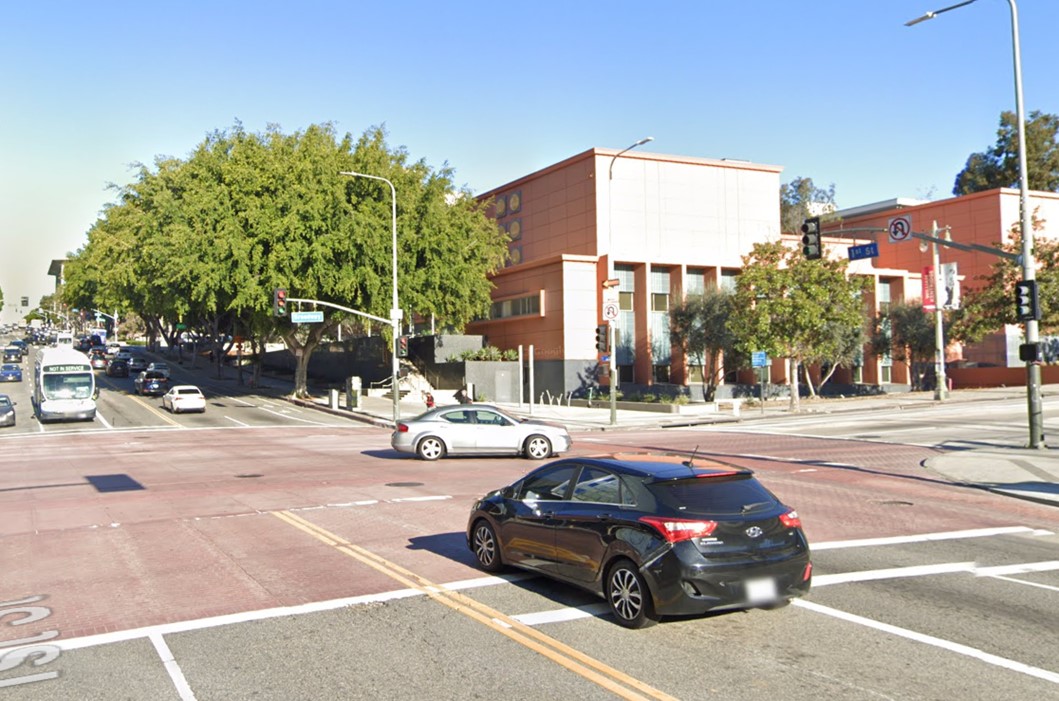 |
|
| (2023)* - Looking toward the NW corner of Broadway and 1st Street where the Los Angeles County Law Library stands today. Once the site of the Tajo Building (1898 - 1940). |
Then and Now
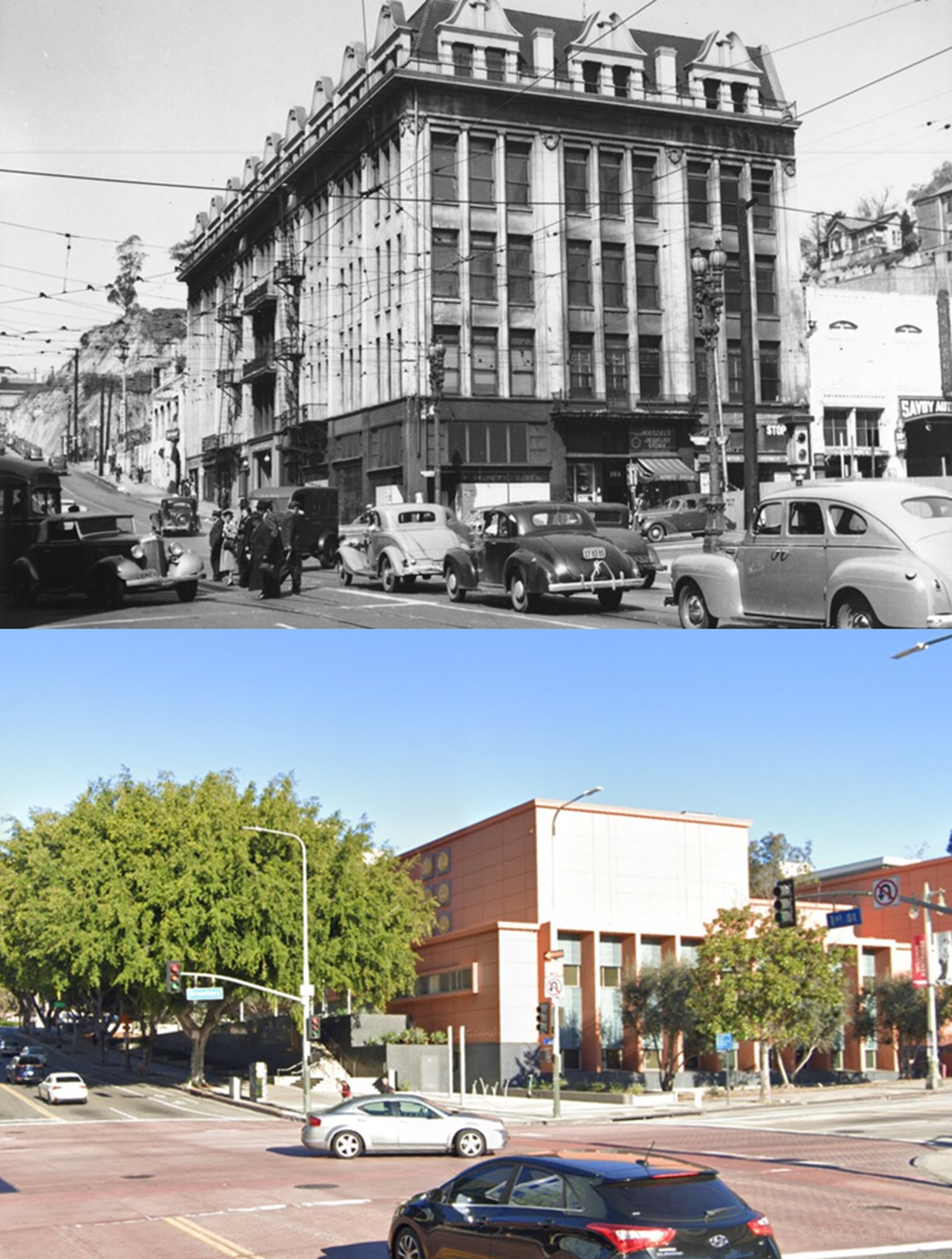 |
|
| (1940 vs 2023)* - Looking toward the NW corner of Broadway and 1st Street where the Los Angeles County Law Library stands today. Once the site of the Tajo Building (1898 - 1940). Photo comparison by Jack Feldman. |
* * * * * |
Grand Avenue
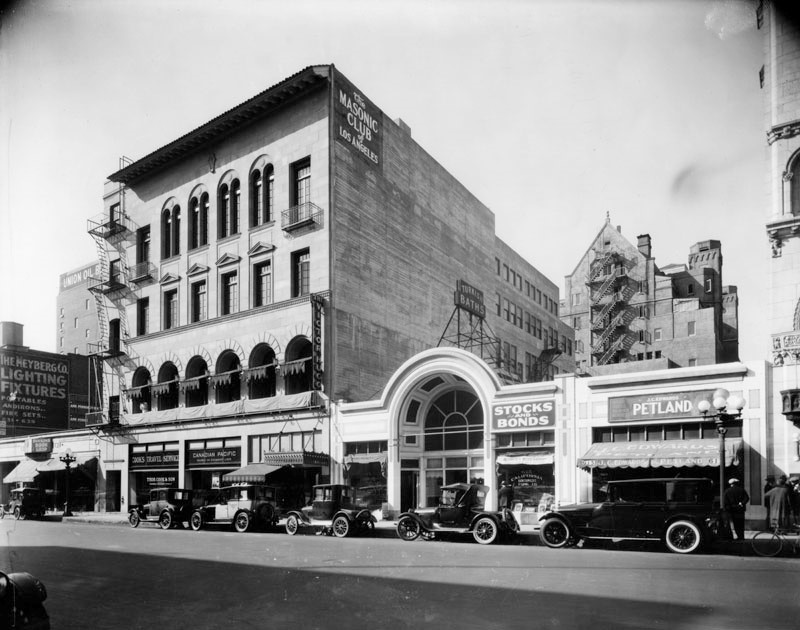 |
|
| (1925)^ - View showing the west side of S. Grand Avenue between 6th and 7th streets, showing several shops, hotels, and the Masonic Club of Los Angeles. The visible shops are: The Meyberg Co.; Dawson's Book Shop; The Victor Hugo Hotel; The Masonic Club of Los Angeles; Cooks Travel Service; Canadian Pacific; California Southwest Farms Co.; and J.C. Edwards Petland, toward the far right. Several cars are parked in front of these shops, some are sporty 2-seaters, and the others are larger family sedans. Photo dated: December 10, 1925. |
* * * * * |
Main and 7th
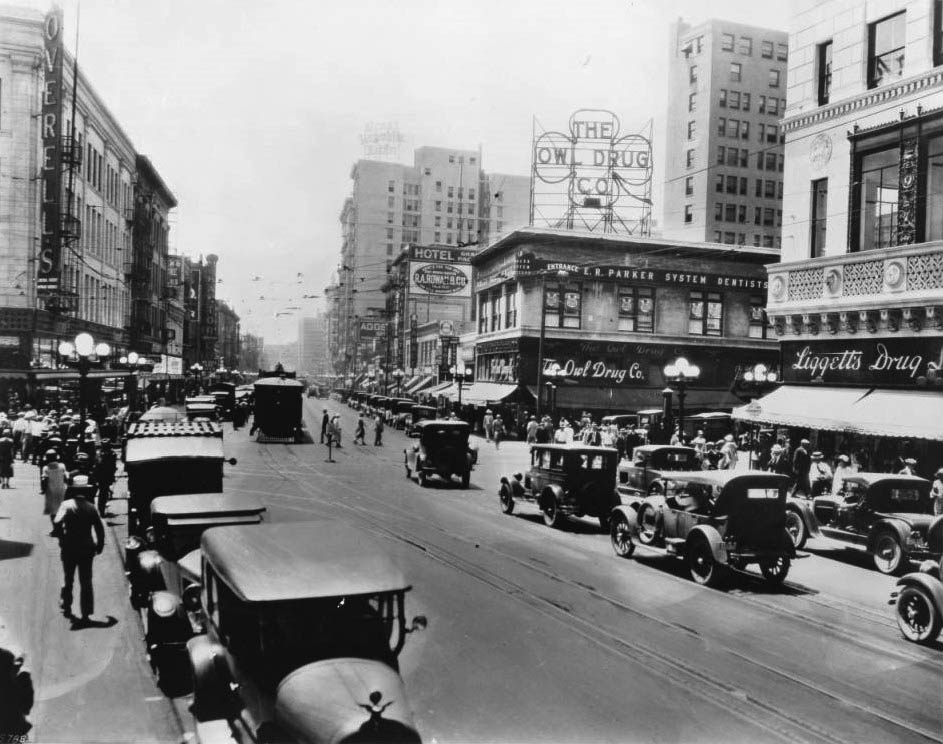 |
|
| (ca. 1926)* - View of Main Street looking south from Seventh Street. Three stores can be can be seen at the corners of the intersection: The Owl Drug Store (S/W), Liggett’s Drug Store (N/W), and Overell’s Furniture Store (S/E). |
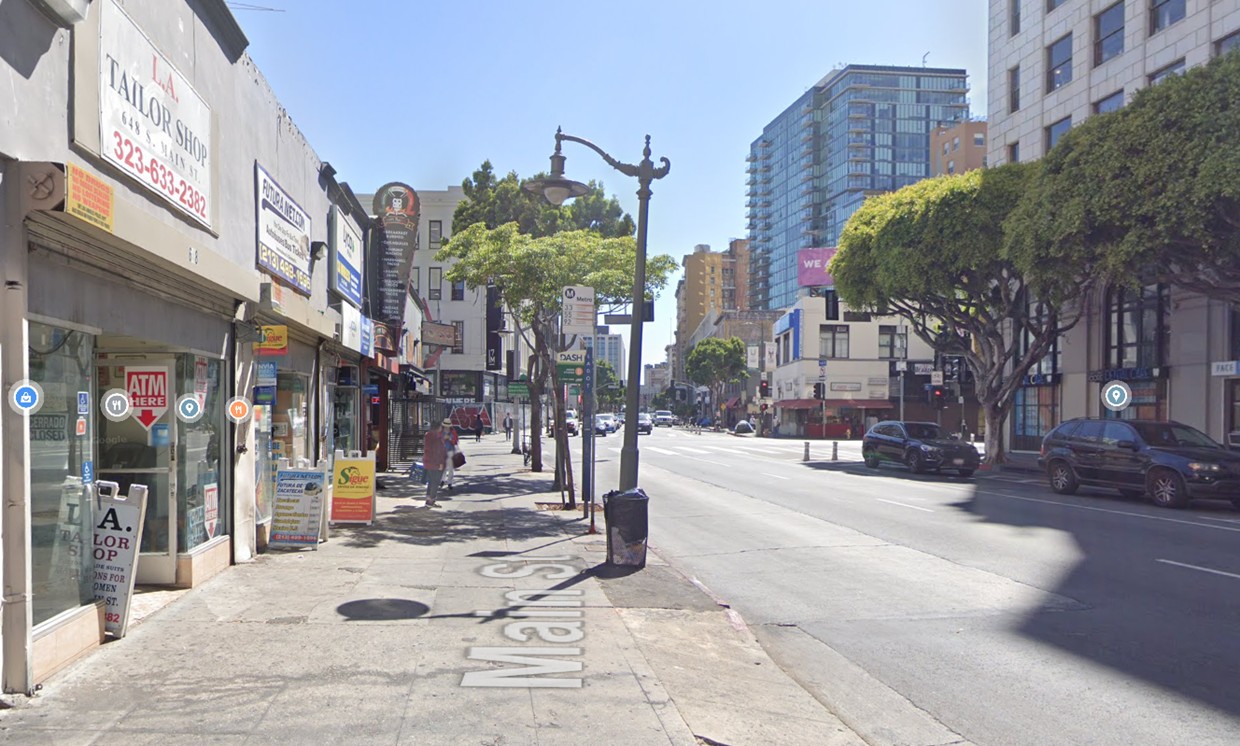 |
|
| (2022)* - Contemporary view of Main Street looking south toward 7th Street. |
Then and Now
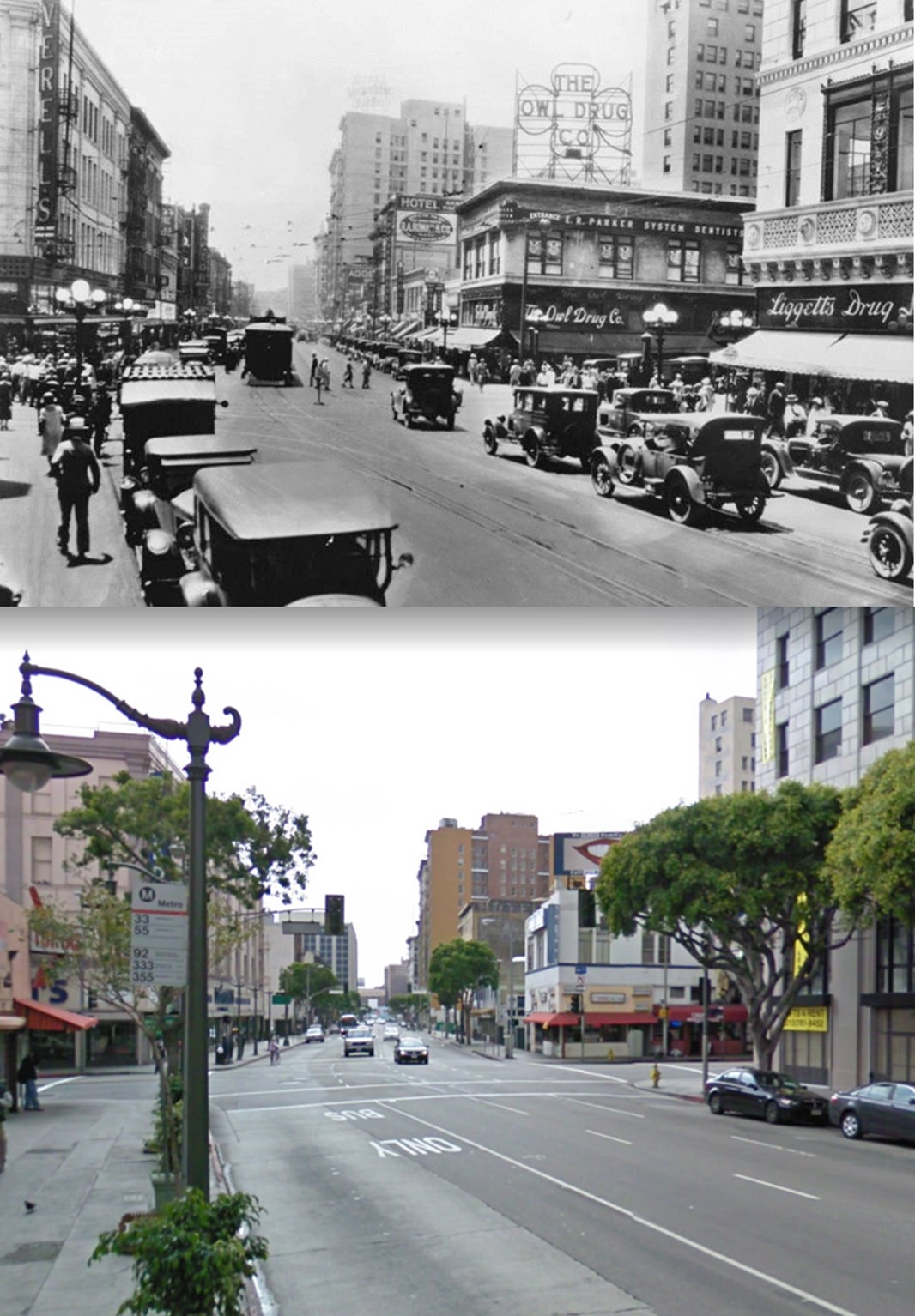 |
|
| (1926 vs. 2009)* – Looking South on Main Street at 7th Street. |
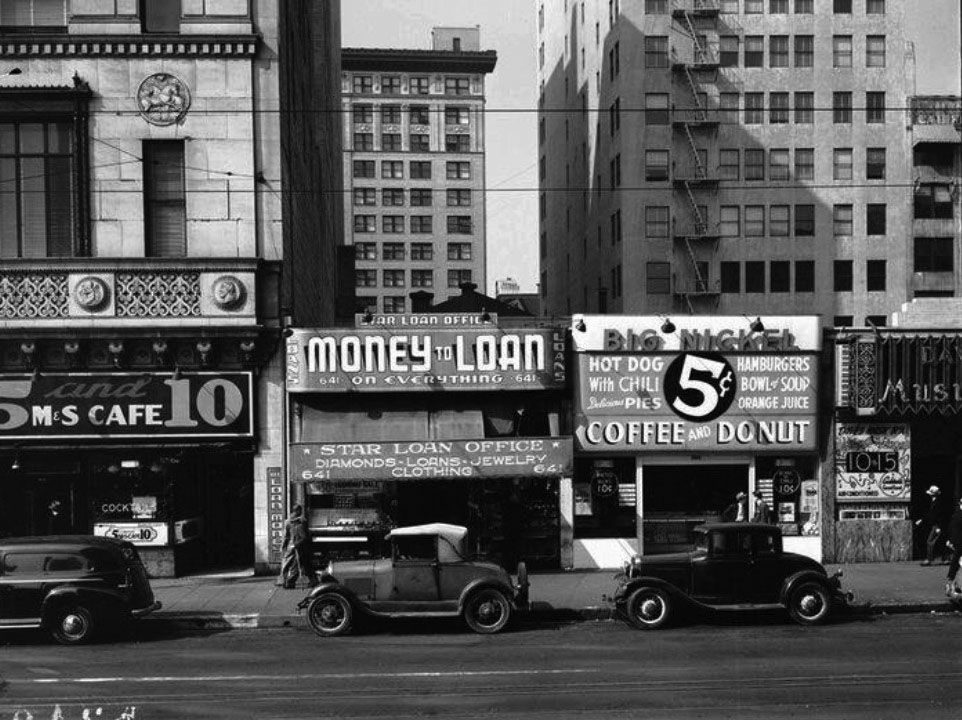 |
|
| (1930s)* - View looking at the west side of Main Street between 6th and 7th streets showing a pawnshop bookended by two coffee shops. Signs read (l to r): 5 and 10 M&S Café, Star Loan Office - Money to Loan on Everything, and Big Nickel Coffee and Donut. |
* * * * * |
Main, Spring, and 9th Street Intersection
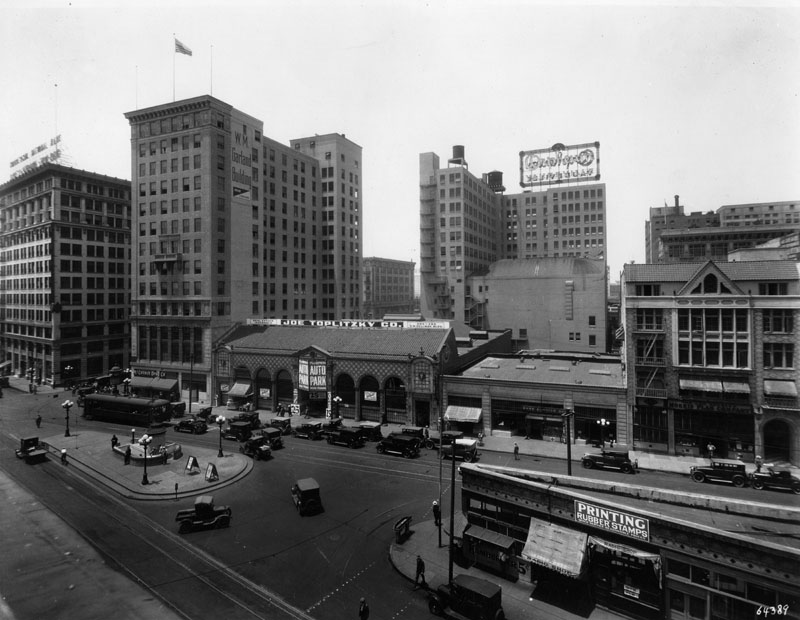 |
|
| (ca. 1925)^ - View showing Spring St. and Main St. at 9th St. looking southwest. Main St. is on the left and Spring St. is seen above it on the right. |
Historical Notes The junction of Main, Spring, and 9th streets became one of the most photographed intersections because of its configuration. Click HERE to see more. |
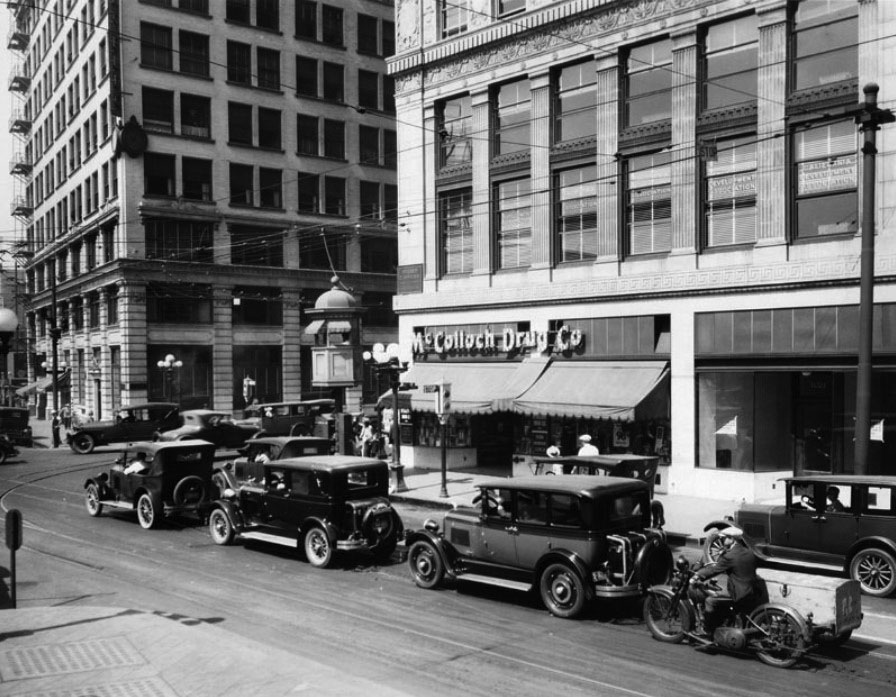 |
|
| (1925)* – Close-up view looking southwest showing the intersection of 9th and Main streets. Note the kiosk on the corner in front of the McColloch Drug Store. Also, look at the motorcycle in the lower-right. The sidecar looks suspiciously like a coffin. |
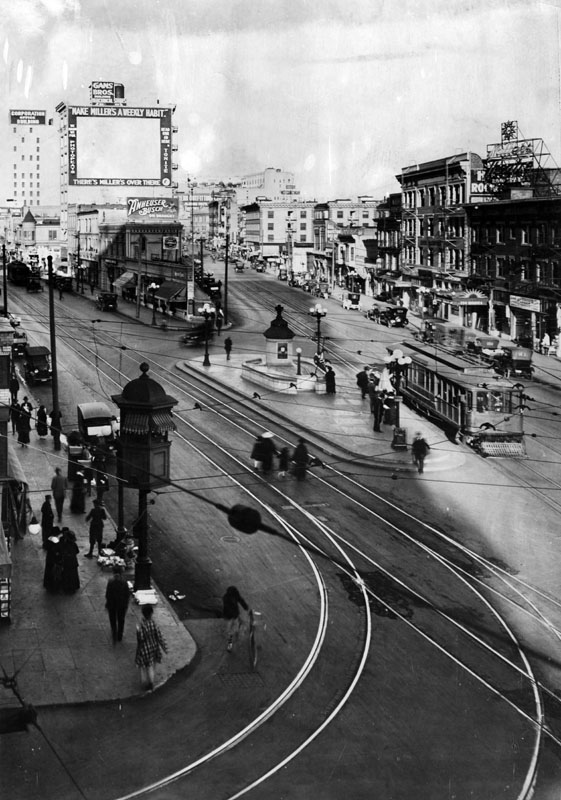 |
|
| (1930)* - Looking north from 9th Street where Spring Street (left) and Main Street (right) split. The streets are shown bustling with the activity of pedestrians, automobiles and streetcars. Note the elevated kiosk at the corner. |
Historical Notes Elevated booths were used by the Los Angeles Railway and the Yellow Cars as a switchman’s tower to control the flow and path of streetcars through the intersection. Click HERE to see more Early Views of the Historic Intersection of Main, Spring, and 9th Streets. |
* * * * * |
Hollywood
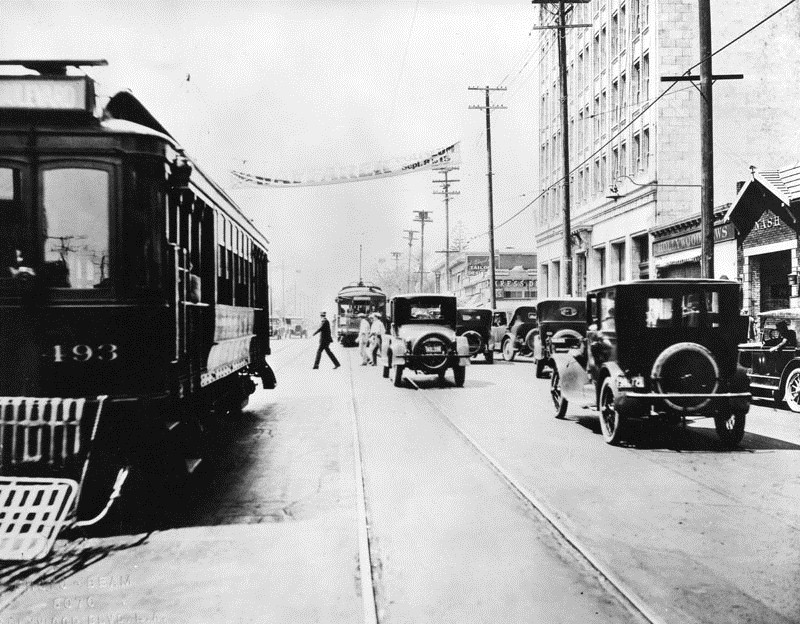 |
|
| (1920s) - Looking west on Hollywood Blvd. toward Cahuenga Blvd. In the foreground is street car no. 493, in the background are 1920's cars and another street car. Over the street is a banner, reading: The Wayfarer at the Coliseum, Sept. 8-15. |
Then and Now
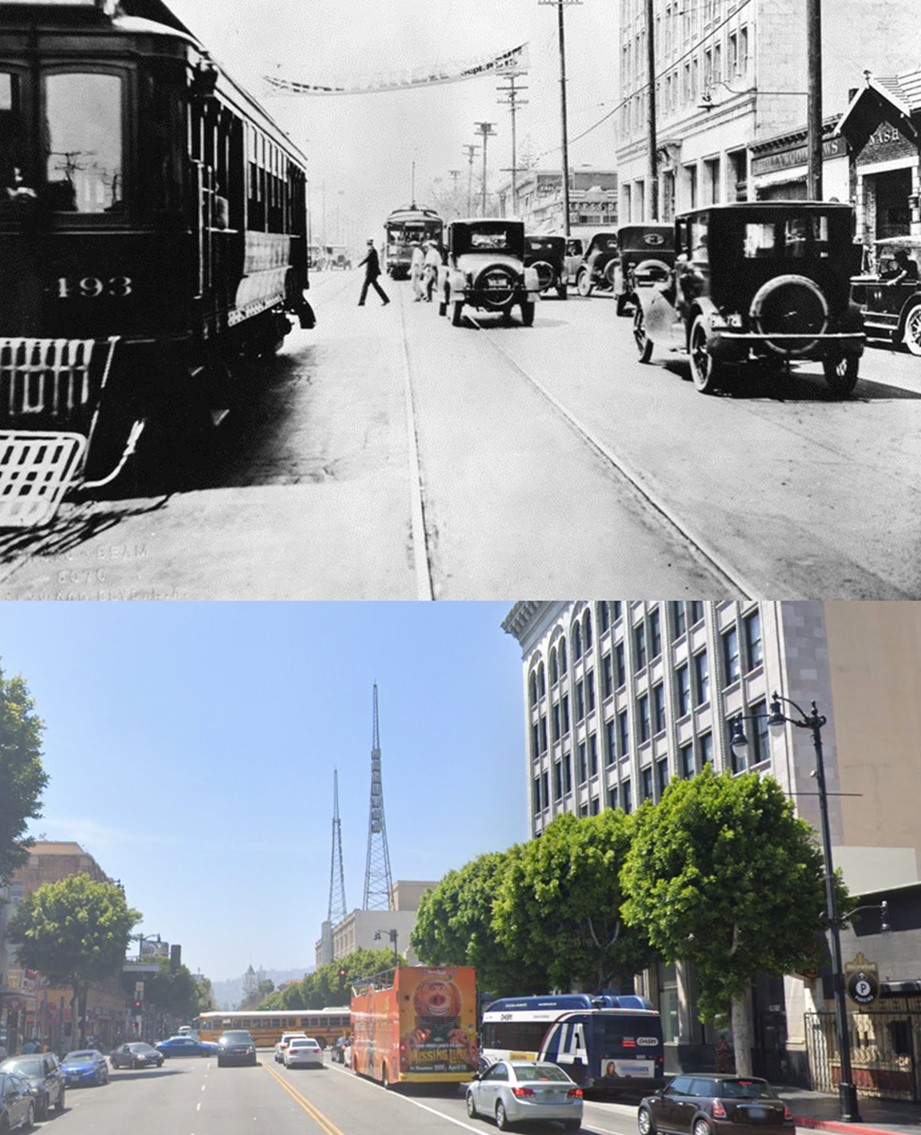 |
|
| (1920s vs. 2020s)* – Looking West on Hollywood Boulevard toward Cahuenga. |
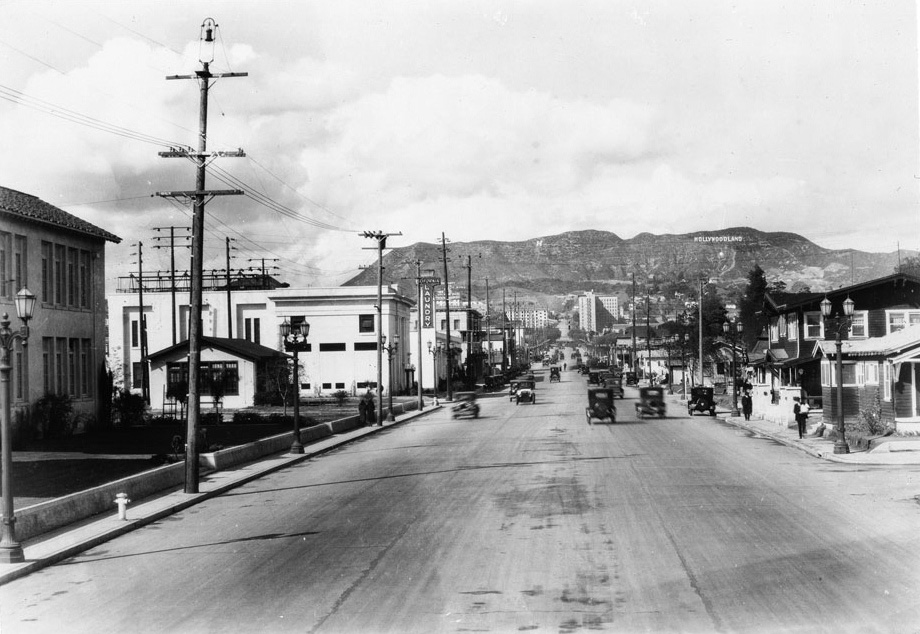 |
|
| (ca. 1925)#^ - View looking north on Vine Street from Barton Avenue with the Hollywoodland Sign seen in the distance at the top of the Hollywood Hills. On the left is Vine Street Elementary School. Further up on the northwest corner of Vine and Romaine streets stands DWP's Power Distribution Station No. 6. (Click HERE to see more Early Power Distribution Stations). |
Then and Now
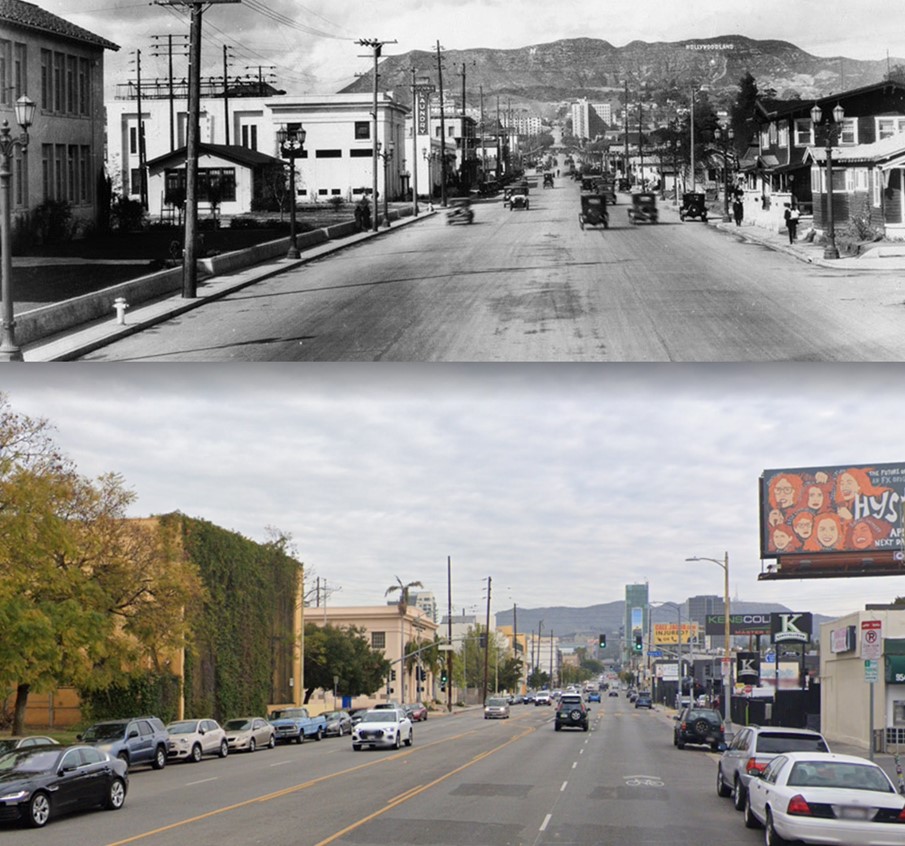 |
|
| (1925 vs. 2021)* - Looking north on Vine Street at Barton Avenue. Photo comparison by Jack Feldman. |
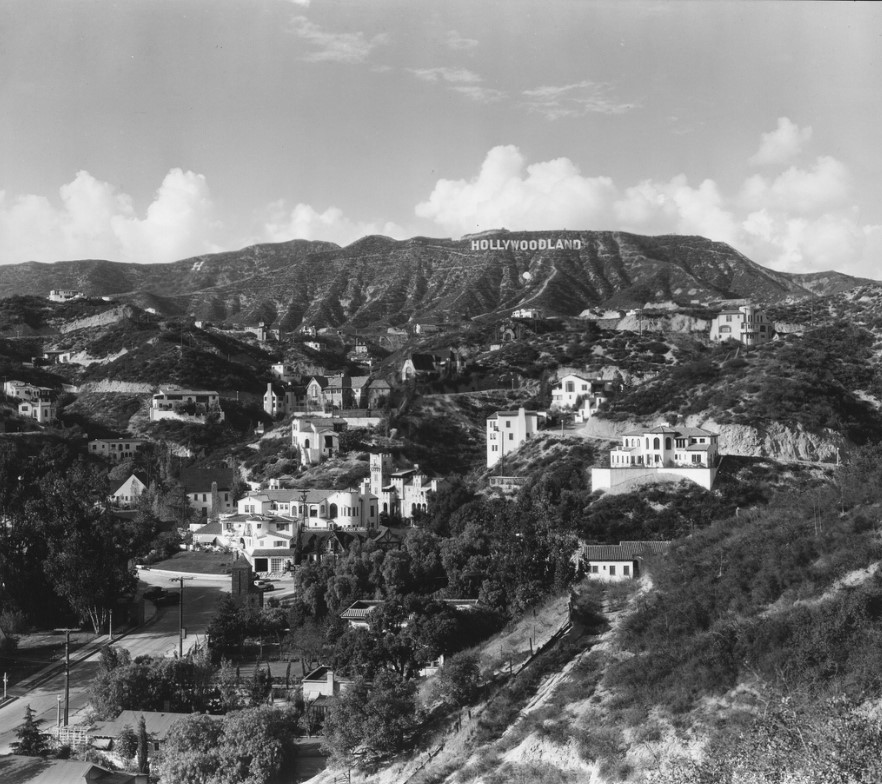 |
|
| (1926)* - View of the Hollywood Hills with the Hollywoodland Sign in the background. |
Historical Notes Click HERE to see more in Early Views of Hollywood (1920 +) |
* * * * * |
Broadway Tunnel (South Portal)
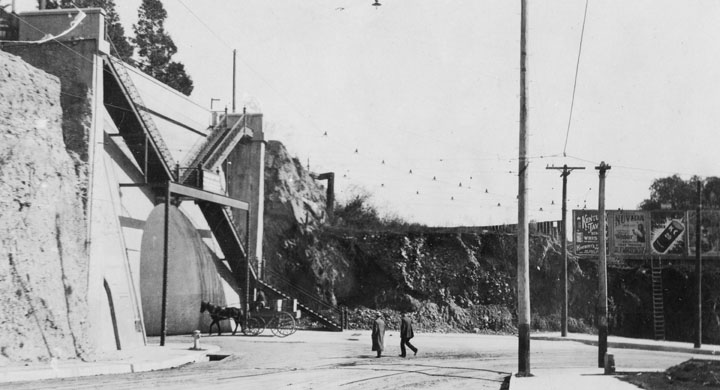 |
|
| (ca. 1902)^ - South approach to the Broadway Tunnel and the stairway leading up to Fort Hill. A man is riding a horse-drawn wagon into the tunnel while two men are crossing the unpaved road and appear to also be heading toward tunnel opening. There was a sign over the Tunnel which read: “$50.00 fine for riding through this tunnel faster than a walk.” |
Historical Notes Completed in August 1901 at a cost of $66,000, the Broadway Tunnel carved through Fort Moore Hill to connect the Civic Center with the neighborhoods to the north. Measuring 760 feet in length, 40 feet in width, and 22 feet in height, it was one of the widest urban tunnels in the country at the time. Its steep grade required a speed restriction, and signs posted at the entrance threatened a $50 fine for traveling faster than a walk. In its earliest years, the tunnel symbolized Los Angeles’ determination to overcome natural obstacles in the name of growth, linking areas of the city that had long been divided by the hill. |
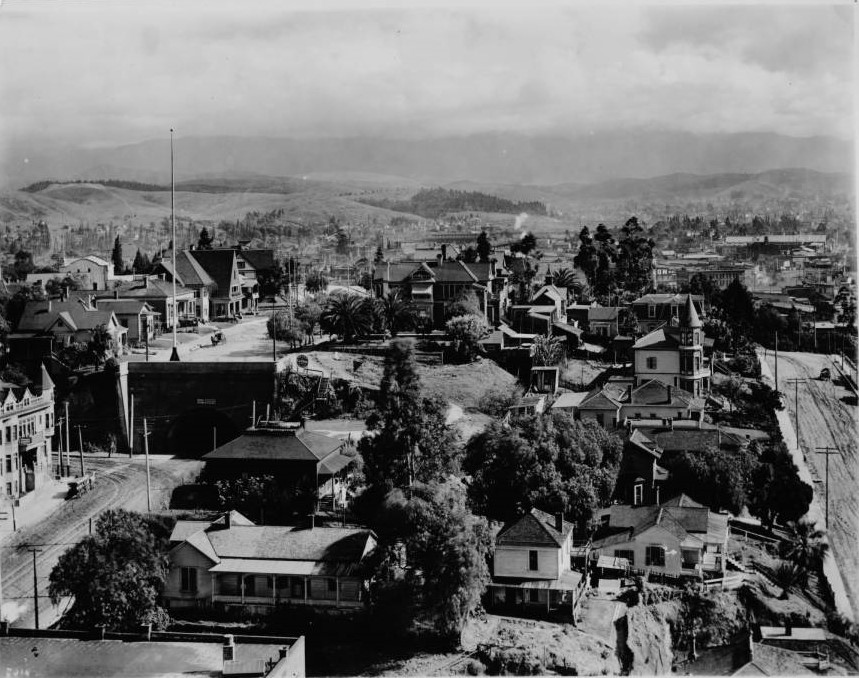 |
|
| (1905)* - View looking north from Temple between Broadway and Spring Street. The old Broadway Tunnel can be seen toward the left with a flagpole on top. A horse-drawn carriage can be seen on the road directly above the tunnel. |
Historical Notes The push for the Broadway Tunnel began in the 1890s, when traffic congestion at First and Spring Streets reached dangerous levels. Horses, wagons, and buggies crowded downtown’s narrow streets, and city leaders argued that opening a passage through Fort Moore Hill would relieve pressure on the city’s north-south arteries. By 1905, the tunnel had already become a vital link, its southern portal standing as both a practical solution and a civic statement—evidence of a city willing to reshape its landscape to keep pace with rapid expansion. |
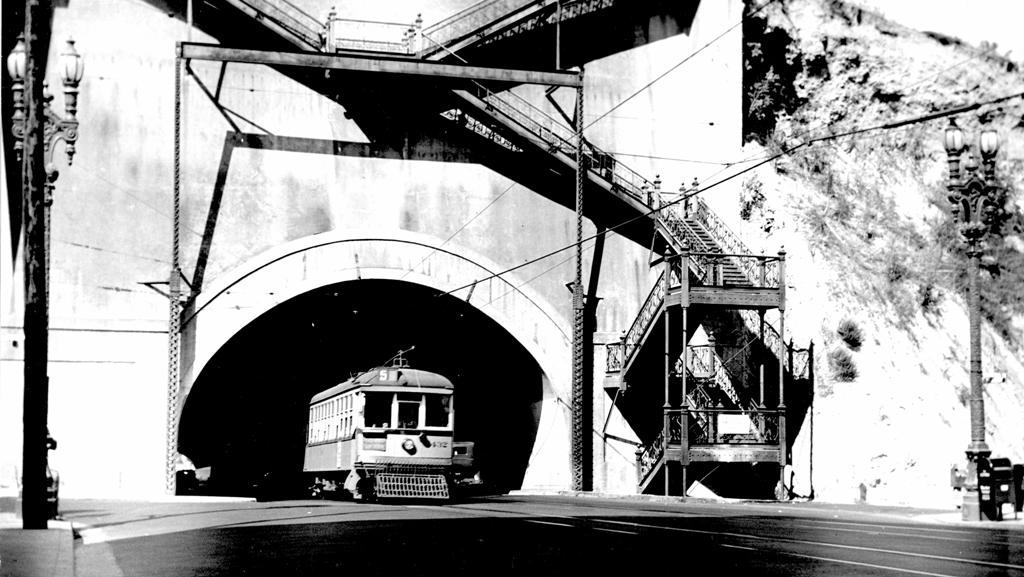 |
|
| (ca. 1925)* - View of the south portal of the Broadway Tunnel, near Broadway and Temple Street. The ‘5 line’ streetcar 1435 can be seen headed southbound on Broadway. |
Historical Notes By the 1910s, the tunnel needed modernization to handle the demands of automobiles and heavier traffic. In 1915, it underwent reconstruction: the roadway was lowered to reduce the grade, wood block flooring was added to quiet wagon and automobile noise, and the bore was lined with bright white glazed tile. A dramatic staircase climbed the southern face of the tunnel to the top of Fort Moore Hill, providing pedestrian access to the neighborhoods above. For a generation, the tunnel was both a vital transportation artery and an iconic landmark woven into daily life, with streetcars, wagons, and cars all streaming through its tiled passage. |
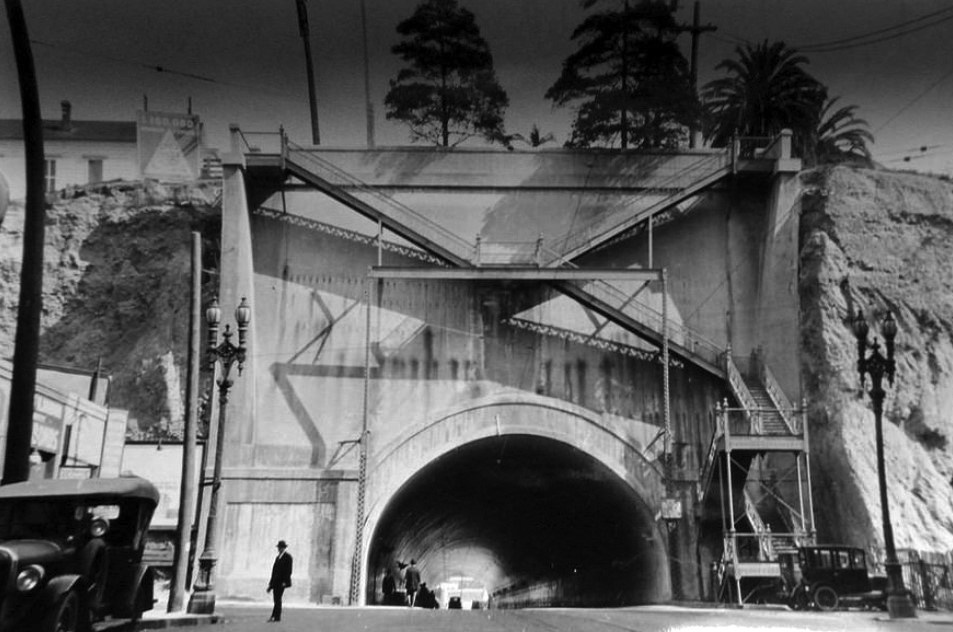 |
|
| (1926)* - Straight-on view showing the full extent of the Broadway Tunnel as seen through the southern portal looking north. Several pedestrians are seen walking through the tunnel on the sidewalk adjacent to the road. A steel-frame pedestrian staircase makes its way up the front face of the tunnel. |
Historical Notes Seen from its southern portal, the Broadway Tunnel embodied the scale of early 20th-century infrastructure in Los Angeles. Wide sidewalks accommodated pedestrians who walked beneath the hill alongside automobiles and streetcars, while staircases offered a way up to Fort Moore Hill itself. This integration of multiple forms of movement—foot traffic, public transit, and private vehicles—reflected the city’s ongoing transition from horse-drawn transport to an automobile age. |
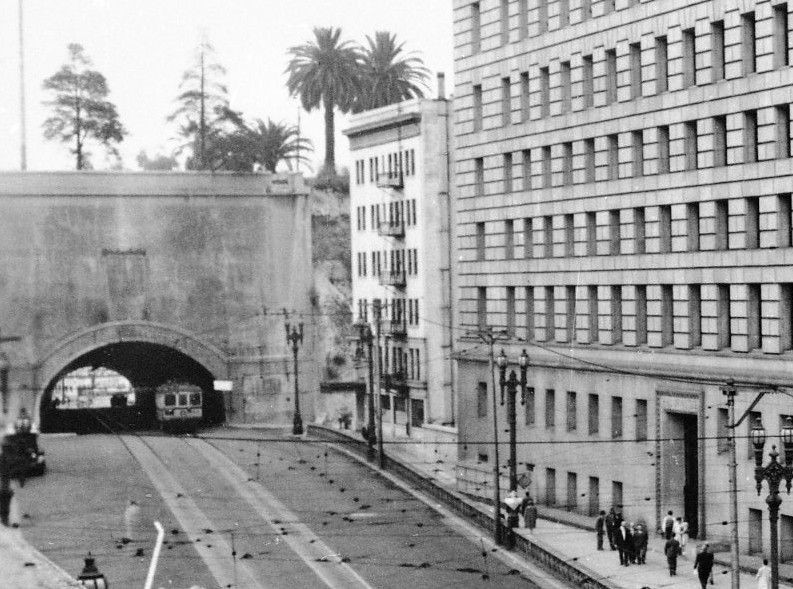 |
|
| (ca.1930)* - Looking north showing the Broadway Tunnel with the steel-frame pedestrian staircase now removed. The 1925-built Hall of Justice is seen on the right. |
Historical Notes By the late 1920s, the tunnel was flanked by symbols of Los Angeles’ rising civic presence. The newly built Hall of Justice towered over its southern approach, reinforcing the sense that the tunnel was now part of a grander Civic Center landscape. As the city built upward and outward, the tunnel continued to carry thousands of daily commuters, but it was also increasingly overshadowed by the massive civic buildings springing up around it. |
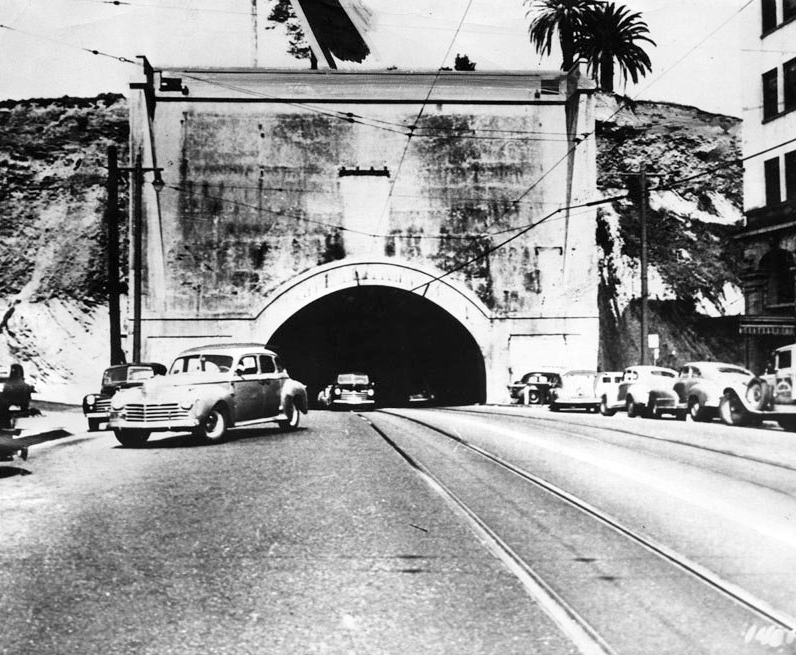 |
|
| (1944)^ – View looking north showing the entrance to the Broadway Tunnel on September 4, 1944. Herald-Examiner Collection |
Historical Notes By the 1940s, the Broadway Tunnel was nearing the end of its usefulness. The city had grown beyond the modest improvements of its 1915 renovation, and the rise of the automobile demanded broader thoroughfares and new freeway alignments. While still in use during World War II, its days were numbered. Within five years, the tunnel would be closed and demolished to make way for the Hollywood Freeway, erasing a piece of Los Angeles’ early civic ambition but opening the path to a modern highway system. |
Then and Now
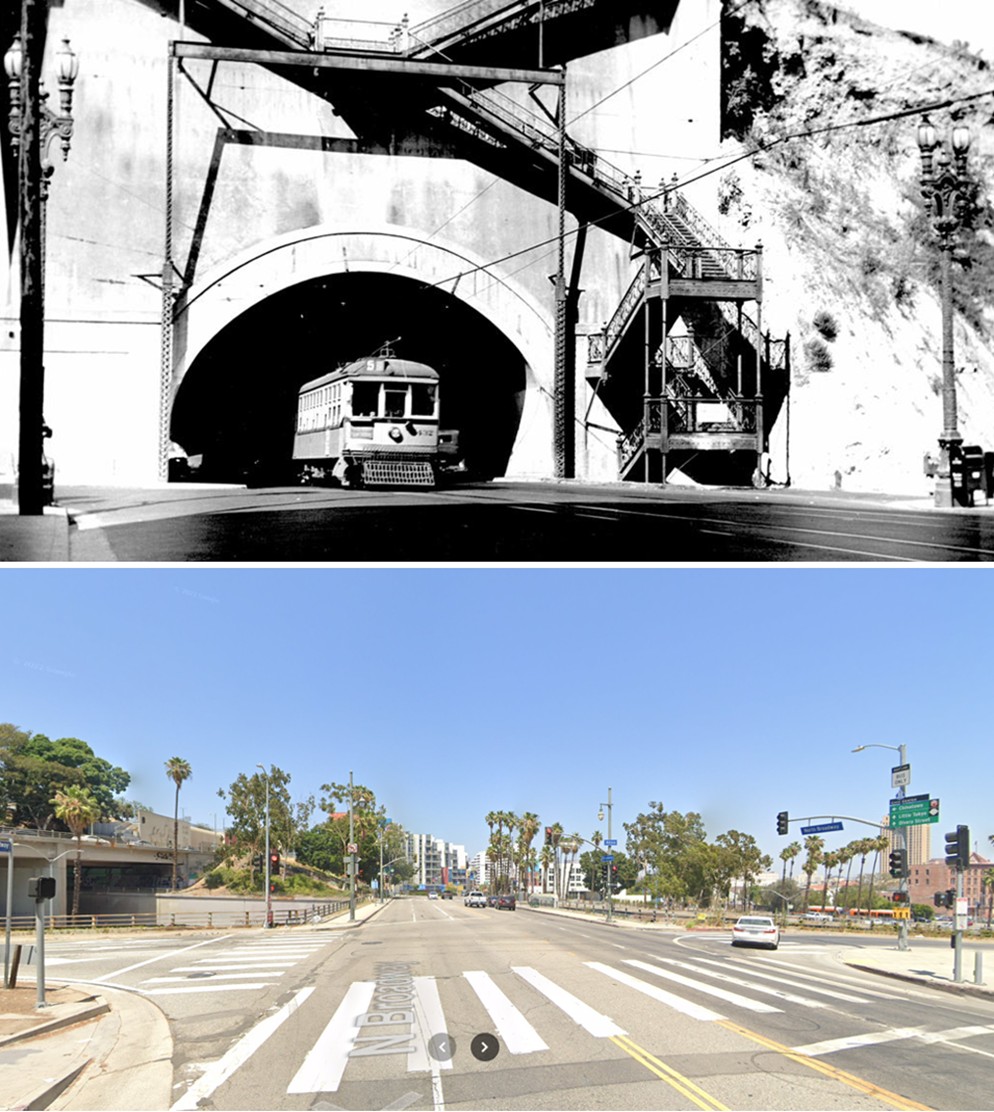 |
|
| (1925 vs 2025)* - Looking north on Broadway toward Aliso Street and the 101 Freeway, at the site where the Broadway Tunnel and Fort Moore Hill once stood. Photo comparison by Jack Feldman. |
Historical Notes The demolition of the Broadway Tunnel in 1949 coincided with the leveling of Fort Moore Hill to make way for the Hollywood Freeway. Where once stood a tiled passage carrying wagons, streetcars, and automobiles beneath the hill, a wide overpass now carries Broadway above the freeway cut. The transformation illustrates Los Angeles’ mid-20th century shift from localized civic infrastructure to regional automobile corridors. Today, nothing remains of the tunnel except its memory in photographs, while Broadway itself continues to span the space where the hill and its tunnel once defined the landscape. |
* * * * * |
Broadway Tunnel (North Portal)
 |
|
| (1926)* – View looking south showing the northern portal of the Broadway Tunnel as seen from Sunset Boulevard. Cars are going in and out of the tunnel while pedestrians are seen walking on the sidewalk at right. Note the signboards that surround the tunnel opening. |
Historical Notes The Broadway Tunnel was completed in August 1901, cutting through Fort Moore Hill to connect North Broadway (then Fort Street) at Sand (later California) Street with Buena Vista Street (later Sunset Boulevard, now César Chávez Avenue). At 760 feet long, 40 feet wide, and 22 feet high, it was among the widest tunnels of its kind in the country at the time. The tunnel provided much-needed connectivity as Downtown Los Angeles expanded, allowing cars, wagons, and pedestrians to pass beneath what had once been an imposing barrier hill. By the mid-1920s, the northern portal had become a bustling gateway, channeling people and goods between the growing Civic Center and Sunset Boulevard. Commercial signs and billboards clustered around its entrance, showing how the tunnel had become part of the urban fabric—not just a piece of infrastructure, but a reflection of the community it served. |
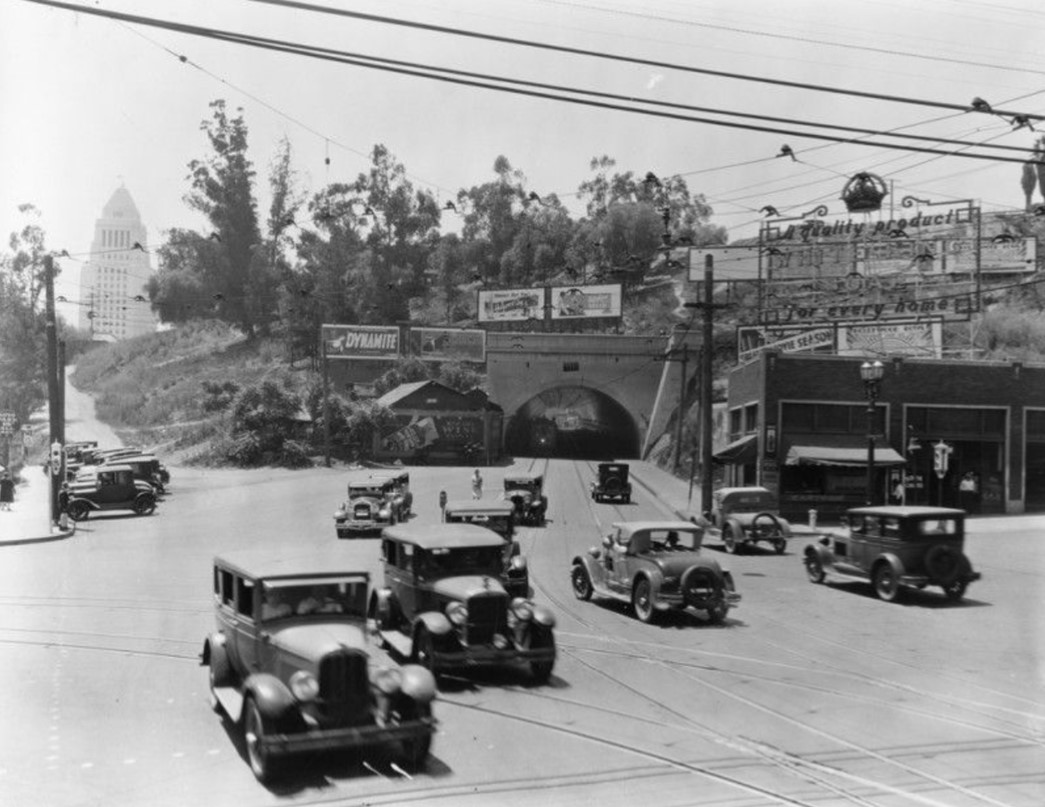 |
|
| (1929)* - Southwest corner of North Broadway and Sunset Boulevard, showing the north portal of the Broadway Tunnel, which later was demolished, the hill removed and the street widened. The newly constructed City Hall (1928) can be seen in the background. |
Historical Notes City Hall’s presence looming in the background by 1929 signals Downtown L.A.’s administrative and civic ascendancy. As governmental institutions grew nearby, the tunnel’s northern portal was more than a thoroughfare — it connected the everyday lives of citizens to the centers of power. Meanwhile, Justicia Street (a dirt road at that point) climbed the hill, showing how the older, less developed terrain was still part of living urban topography. |
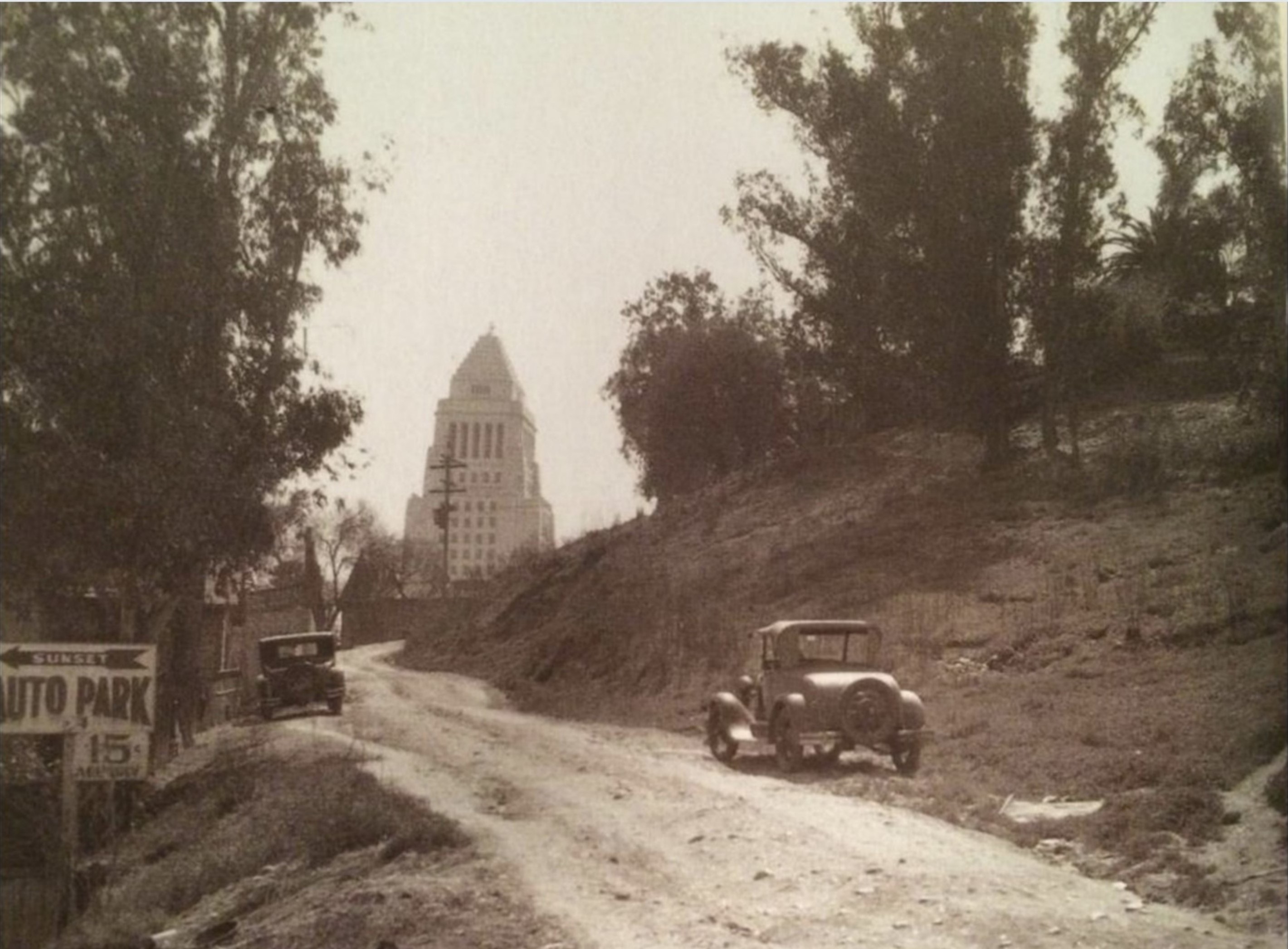 |
|
| (ca. 1929)* - View looking south on Justicia Street from Sunset Boulevard, with City Hall in the background. The north portal of the Broadway Tunnel lies just to the right, out of view. |
Historical Notes Justicia Street was one of the last dirt roads in downtown Los Angeles. |
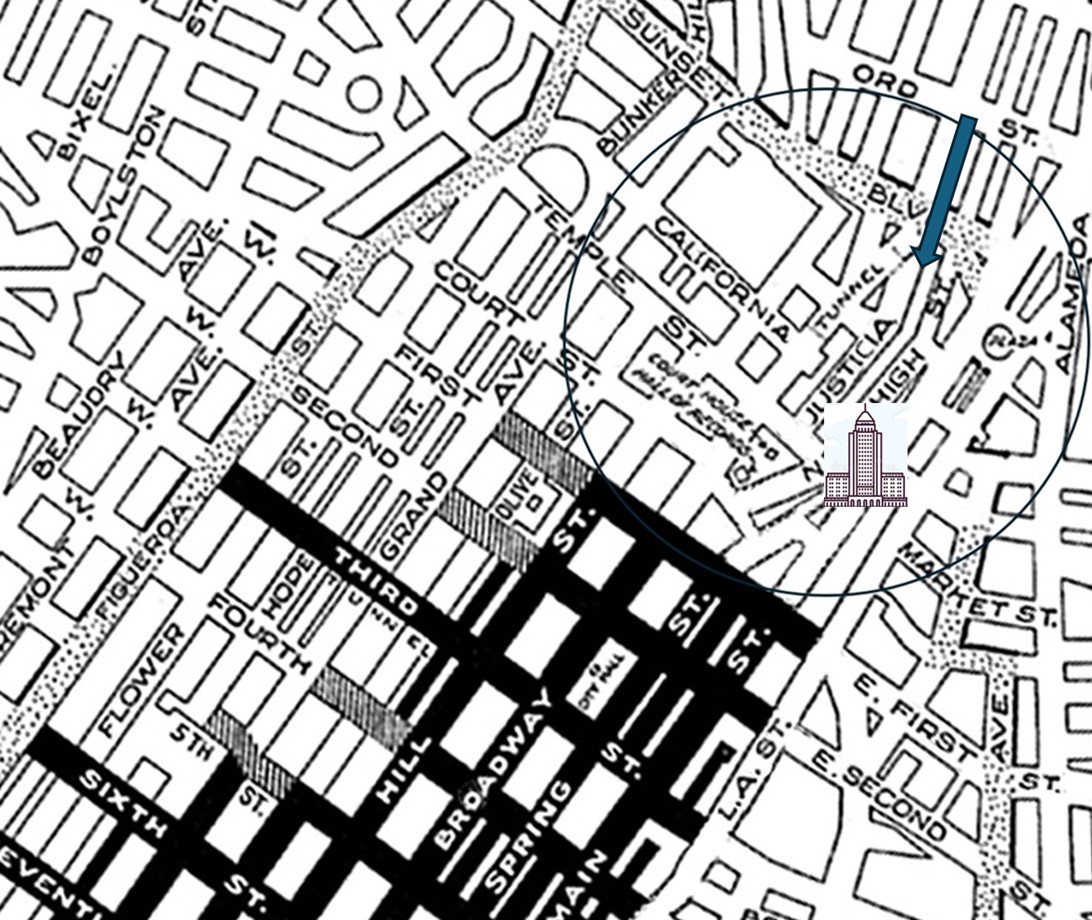 |
|
| (1920s)* - Map showing the early street layout near the northern portal of the Broadway Tunnel at Sunset Boulevard (now Cesar Chavez Avenue). The arrow indicates the location and direction from which the previous photo was taken, looking south on Justicia Street toward the top of Los Angeles City Hall. |
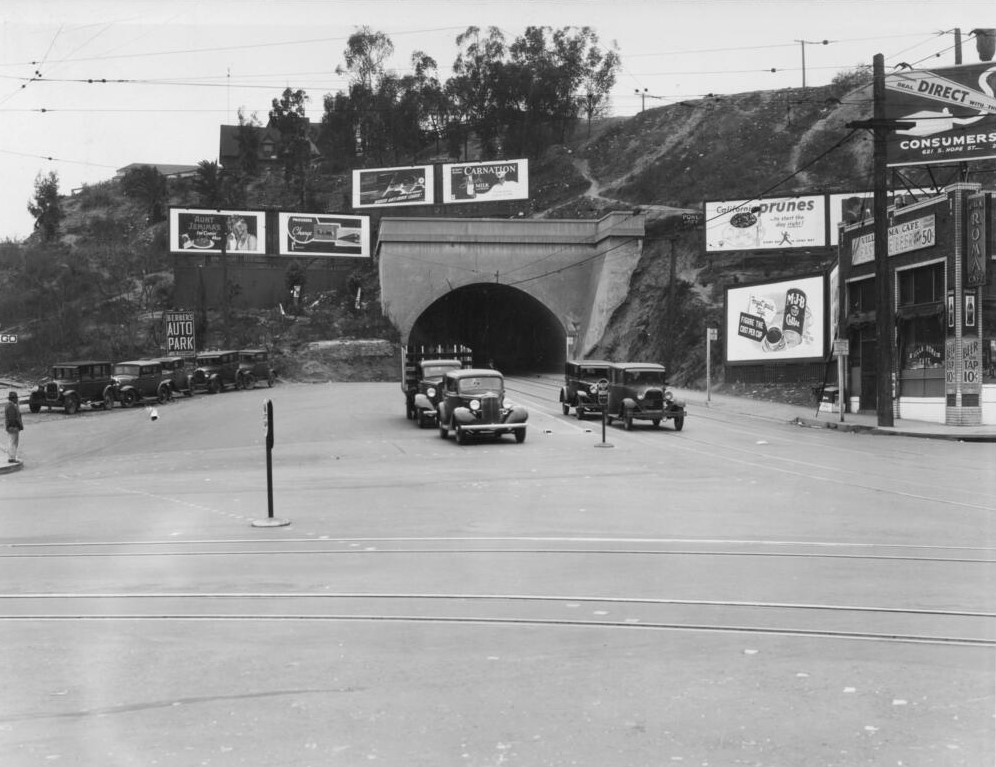 |
|
| (1935)* – Looking south toward the northern portal of the Broadway Portal from Sunset Boulevard with billboards all around the tunnel entrance. |
Historical Notes In the 1930s, the portal was adorned with billboards and signs, evidence of the commercialization of urban space. The tunnel wasn’t merely a pass-through—it was part of a visual landscape, a way to project identity, advertise, and assert modernity. This era also saw increasing car traffic, making road access—even under hills—ever more important. |
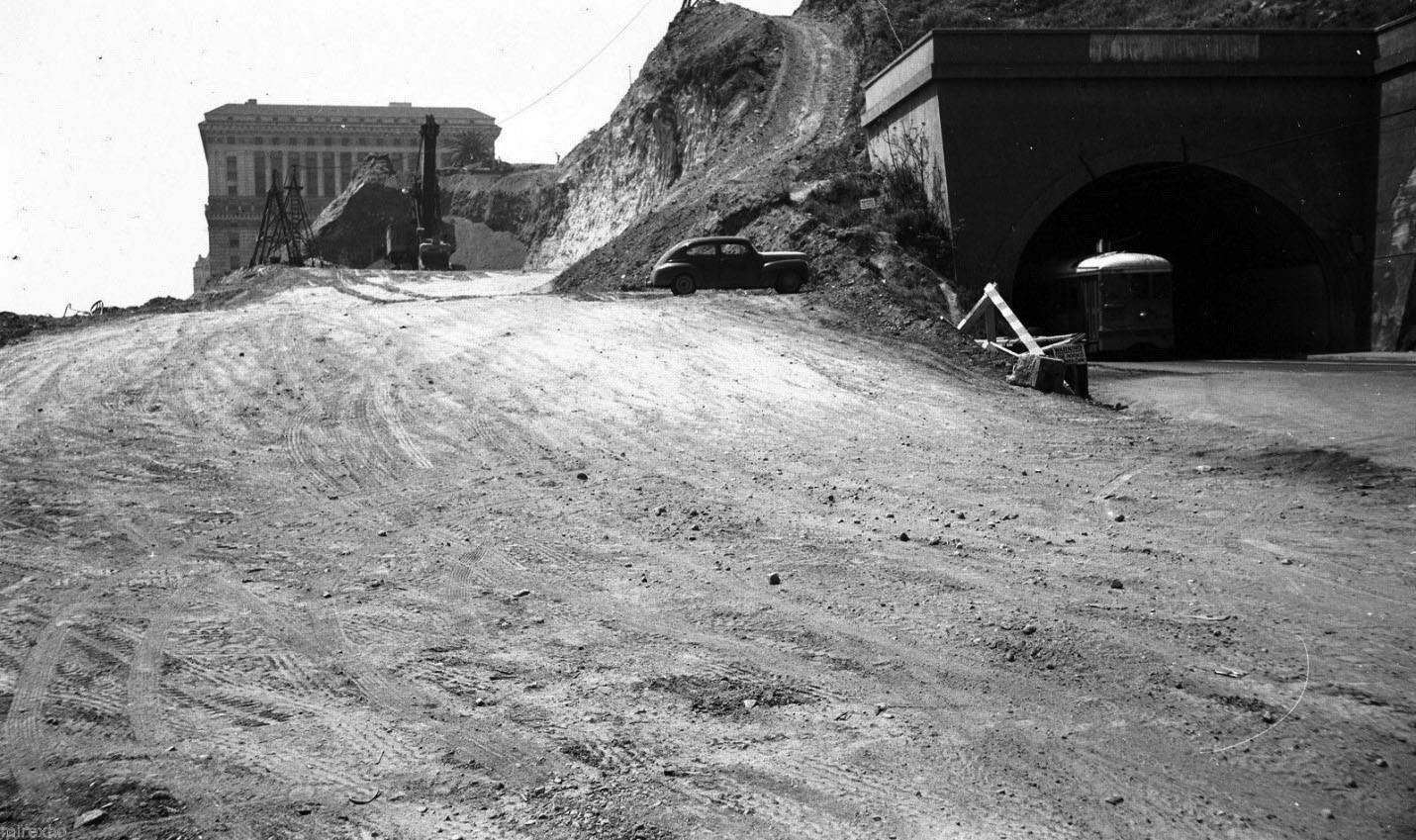 |
|
| (1949)^ - View looking south toward the north portal of the Broadway Tunnel, still in use, while the hill around it is being removed with the Hall of Justice in the background. |
Historical Notes By 1949, Fort Moore Hill was in the process of being removed. The northern portal, though still carrying traffic, was surrounded by heavy construction and earth-moving as the city prepared for the Hollywood Freeway (US-101). Bridge and road planners saw the hill itself as a barrier—not just to cars, but to coherent urban growth. The tunnel under the hill, once a forward-looking solution, was now viewed as an obstacle to freeway development and more efficient mobility. |
.jpg) |
|
| (1949)* - View showing the north end of the Broadway Tunnel as it is being razed to make room for the construction of the Hollywood Freeway. An electric streetcar moves along the tunnel by-pass tracks just in front of the Federal Courthouse and City Hall at left. The Los Angeles County Hall of Justice is partially visible behind the tunnel. Photo Date: June 11, 1949 |
Historical Notes Just days after its formal closure (June 2, 1949), the northern portal was being dismantled. Streetcar lines that once rounded the portal were rerouted or removed; the architecture of the tunnel was torn down. The removal of Fort Moore Hill dramatically reshaped the Downtown skyline, paving the way for overpasses and new freeway infrastructure. The City Hall, the Hall of Justice, the Courthouse—all public institutions—now found themselves adjacent to highways where once was hill and tunnel. |
 |
|
| (2023)* - Looking south on Broadway as it crosses the 101 Freeway at the old Broadway Tunnel site. |
Historical Notes Decades later, the freeway’s course now carves beneath Broadway exactly where the tunnel once ran. The ground that was once covered by hill and tunnel is now reshaped into overpasses and roadbeds. The site has transitioned from being a passage beneath earth to being an overpass over concrete—symbolic of how Los Angeles embraced the automobile age, often at cost of older, more pedestrian-scaled infrastructures. |
Then and Now
 |
|
| (1949 vs. 2022)* - Looking south from the northern portal of the 1901-built Broadway Tunnel. In 1949, the construction of the 101 freeway through downtown L.A. reduced Fort Moore Hill to a stump and converted the section of Broadway between Temple and Sunset from a tunnel to a freeway overpass. Photo comparison by Jack Feldman. |
Historical Notes The transformation from 1949 to today tells a larger story of urban reshaping: where once Broadway descended into a tunnel under Fort Moore Hill, now it crosses above the 101 Freeway. The hill has almost entirely vanished; the terrain that once created natural elevation and visual variety was leveled to accommodate traffic and freeway design. Downtown Los Angeles shifted from a landscape shaped by hills and tunnels to one defined by flat roadbeds, overpasses, and high-capacity vehicular movement. Today, the freeway runs below the ground level seen in early photo, and the ground level shown is now the overcrossing of the freeway. |
* * * * * |
Broadway Tunnel Demolition (South Portal)
 |
|
| (1949)* - Los Angeles Transit Lines (ex-Los Angeles Railway) W Line car no. 1557 passes through the by-pass curve in front of a massive tunnel opening. The W Line ran from mid-city to Highland Park. |
Historical Notes By 1949, the Broadway Tunnel had served Los Angeles for nearly half a century, carrying cars, wagons, and streetcars beneath Fort Moore Hill. The W Line car seen here was still making its run from Mid-City to Highland Park, even as crews began preparing to dismantle the tunnel. Daily life carried on, but change was in the air. The city was already planning to replace this passage with a modern freeway that would reshape the heart of downtown. |
.jpeg) |
|
| (1949)* – View showing the Broadway Tunnel’s south entrance at time of demolition. Construction equipment and workers are seen above the tunnel. The Board of Education is seen in the background of Fort Moore Hill. |
Historical Notes The removal of the tunnel was part of a much larger transformation that would permanently alter the geography of Los Angeles. Fort Moore Hill, once a prominent rise overlooking the city, was steadily being carved away to make room for the Hollywood Freeway. Buildings like the Board of Education stood high above the work, watching as the last remnants of the hill that had once defined the area were erased in the name of progress. |
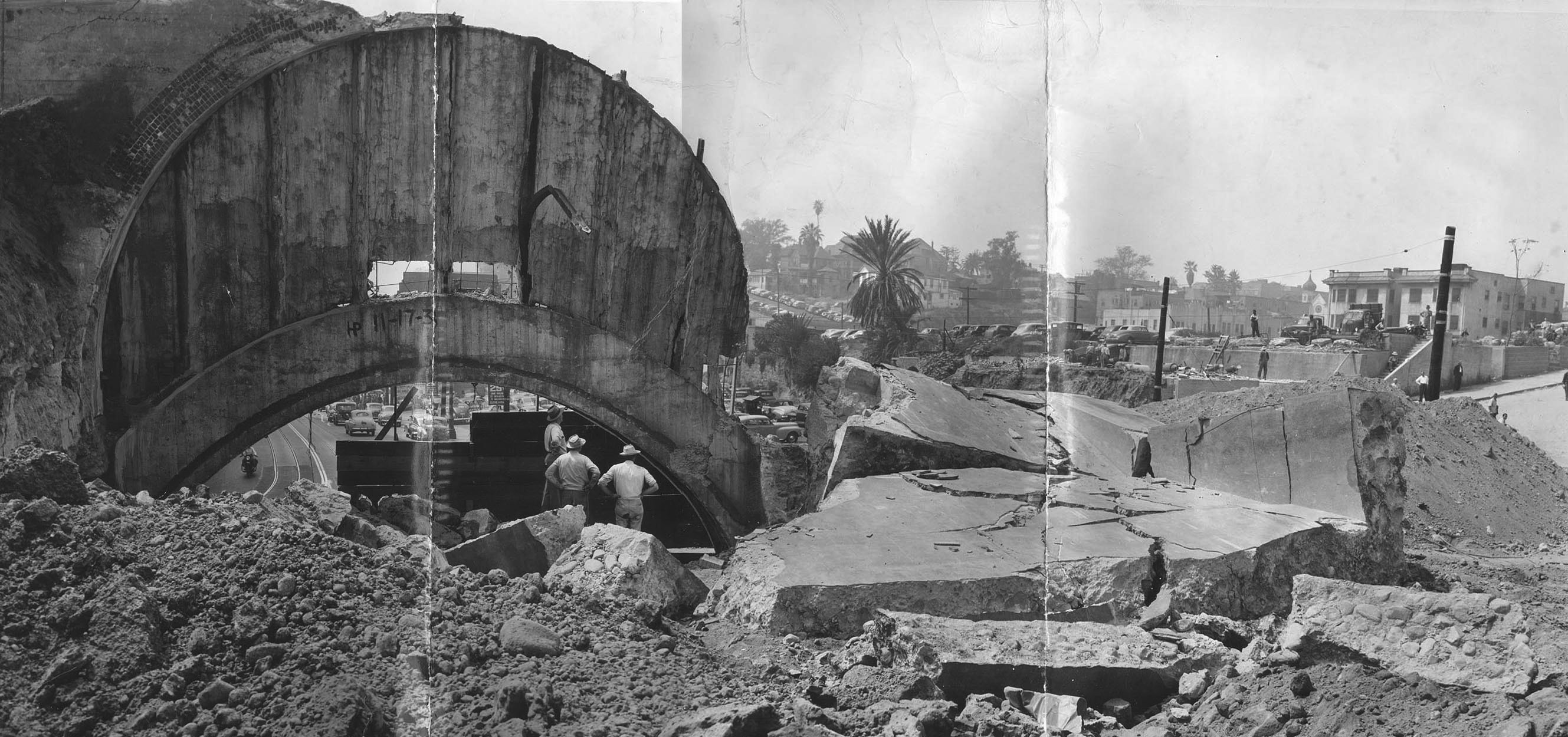 |
|
| (1949)* – View looking southwest showing the Broadway Tunnel and Fort Moore Hill being chiseled away. LA Times photo |
Historical Notes The project was as much about removing the land itself as it was about demolishing the tunnel. Fort Moore Hill, which had been a landmark since the 1840s, was reduced almost entirely to rubble. Homes and streets disappeared along with it, and the city’s natural landscape was reshaped into the flat, engineered ground needed for a freeway. The hill that once separated neighborhoods was no longer an obstacle—an example of how mid-20th-century Los Angeles remade itself for cars and highways. |
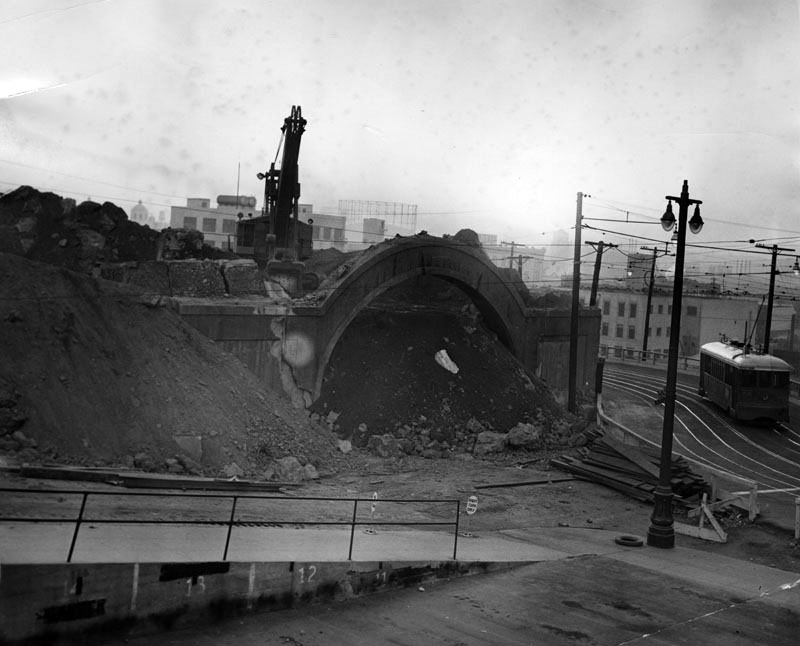 |
|
| (1949)^ - View showing the demolition of the North Broadway Tunnel on September 29, 1949. A trolley car swings by on the right. |
Historical Notes Even as the tunnel was being torn down, the city’s streetcars were still in operation, clinging to their last years of service. This moment captures the overlap of eras: the streetcar age colliding with the freeway age. Within a few years, the Pacific Electric and Los Angeles Railway systems would vanish, replaced almost entirely by the automobile. The demolition of the Broadway Tunnel marked one of the turning points where the old Los Angeles gave way to the new. |
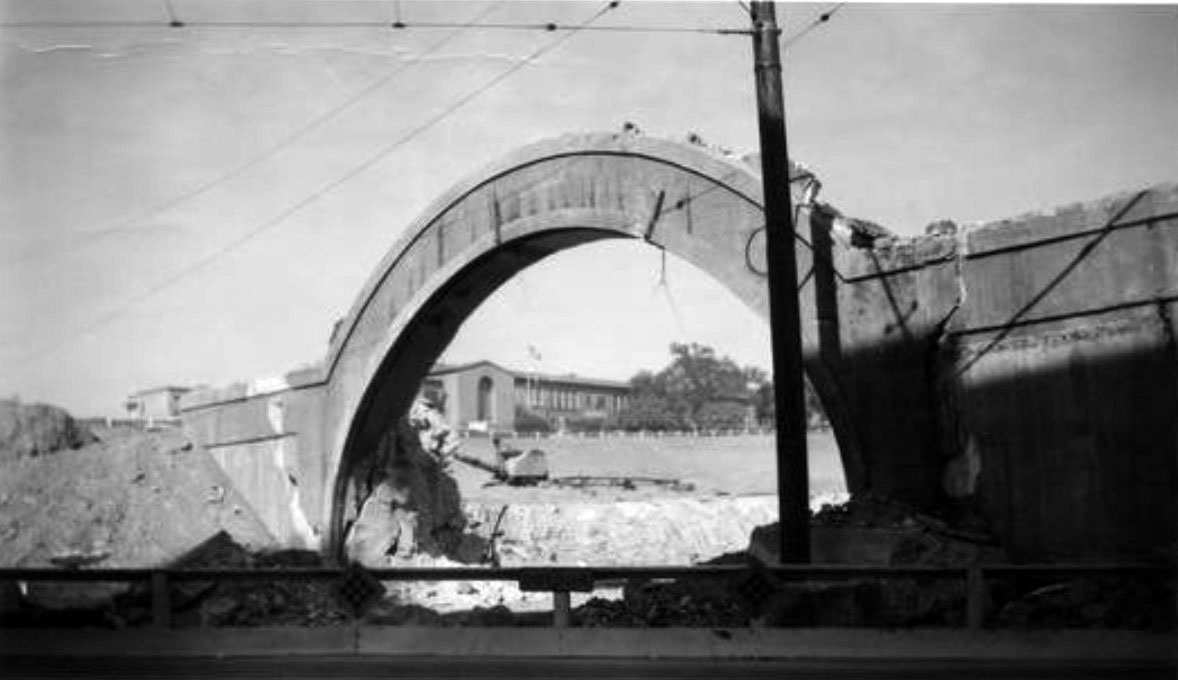 |
|
| (1949) – View showing the last remaining section of the Broadway Tunnel, its southern portal arch, just before its demolition. The Board of Education is seen on top of hill. Photo date: Oct. 1949 |
Historical Notes By October, only the southern arch of the Broadway Tunnel remained, standing like a monument to a vanished city. Within days it too was gone, and with it one of downtown’s defining landmarks. Broadway, which had once slipped under a hill, would soon be carried on a bridge across the Hollywood Freeway. The shift was symbolic as well as physical: Los Angeles had traded hills, tunnels, and streetcars for overpasses, freeways, and automobiles. |
Then and Now
 |
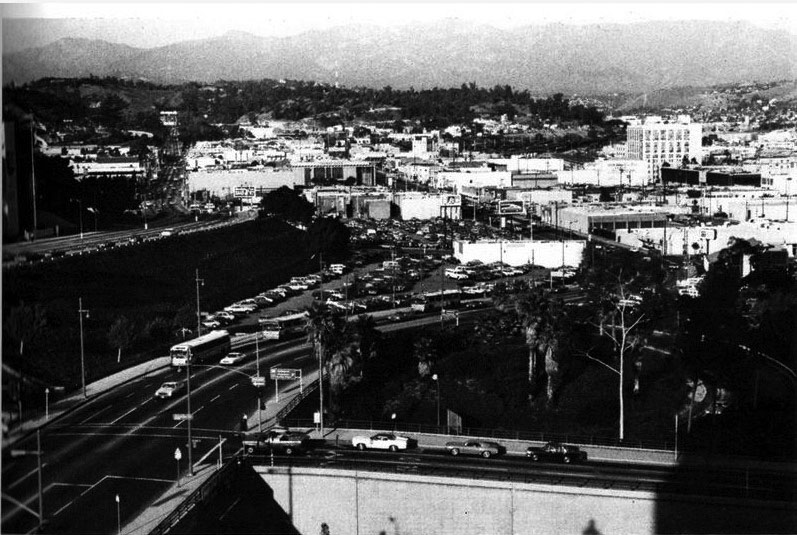 |
|
| (1905 vs. 1987) - Broadway in 1905 dives into the tunnel under Fort Moore Hill; by 1987 it soars above the Hollywood Freeway. |
Historical Notes In 1905, the Broadway Tunnel was a marvel of engineering, cutting through Fort Moore Hill to link the growing northern neighborhoods with downtown. By 1987, nothing remained of the hill or the tunnel. In their place stretched the Hollywood Freeway, a symbol of Los Angeles’s devotion to the automobile. The story of Broadway mirrors the story of the city itself—always tearing down, always rebuilding, always moving forward, even at the cost of its past. |
* * * * * |
Los Angeles Plaza
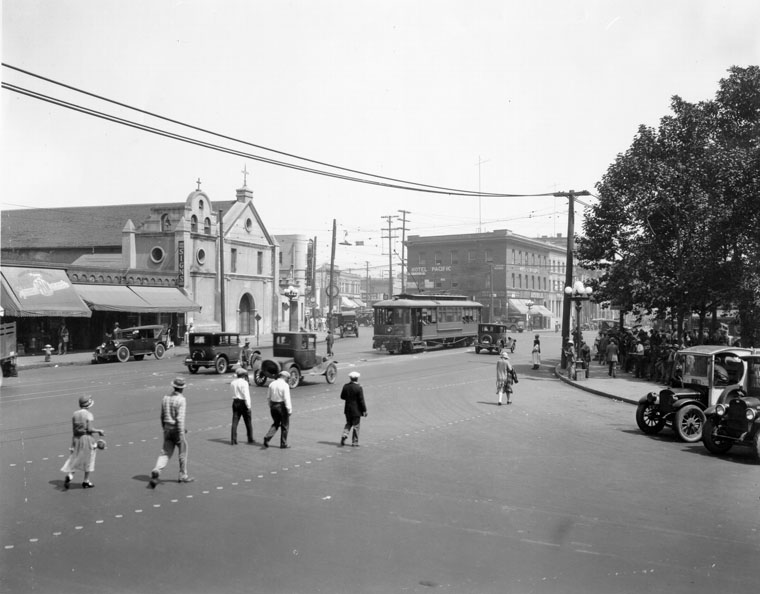 |
|
| (ca. 1925)^ - The Plaza Church on Main Street across from the Plaza and Olvera Street. Behind the streetcar is the Hotel Pacific, the office of Philip Morici and Co., "Agencia Italiana," and the grocery store of Giovanni Piuma, who also made wine (Piuma Road in Malibu was named for him). The area north of the Plaza was at this time an Italian neighborhood. |
Historical Notes The area’s decline as the center of civic life led to its reclamation by diverse sectors of the city's poor and disenfranchised. The Plaza served as a gateway for newly arrived immigrants, especially Mexicans and Italians. During the 1920s, the pace of Mexican immigration into the United States increased to about 500,000 per year. California became the prime destination for Mexican immigrants, with Los Angeles receiving the largest number of any city in the Southwest. As a result of this dramatic demographic increase, a resurgence of Mexican culture occurred in Los Angeles. |
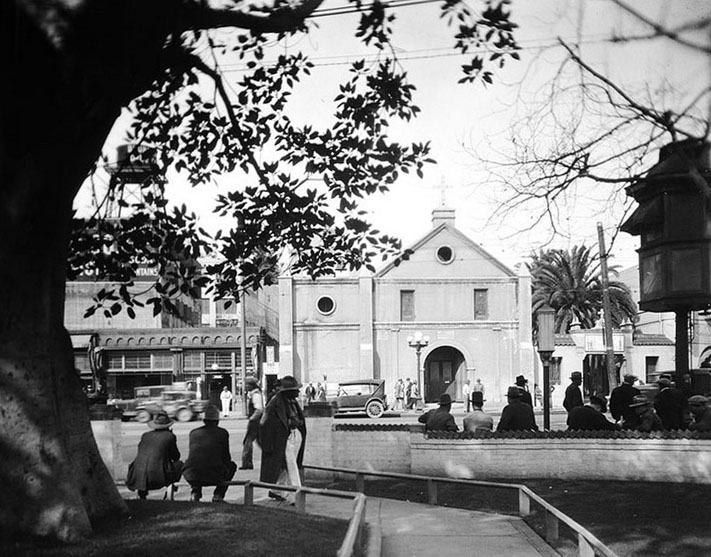 |
|
| (ca. 1925)^ - Exterior view of the Plaza Church from across the street. An elevated LARY booth can be seen on the right edge of the photo. |
Historical Notes Elevated kiosks were used by the Los Angeles Railway and the Yellow Cars (LARY) as a switchman’s tower to control the flow and path of streetcars through intersections. Click HERE to see more in Early Plaza of L.A. |
* * * * * |
Knott's Berry Farm
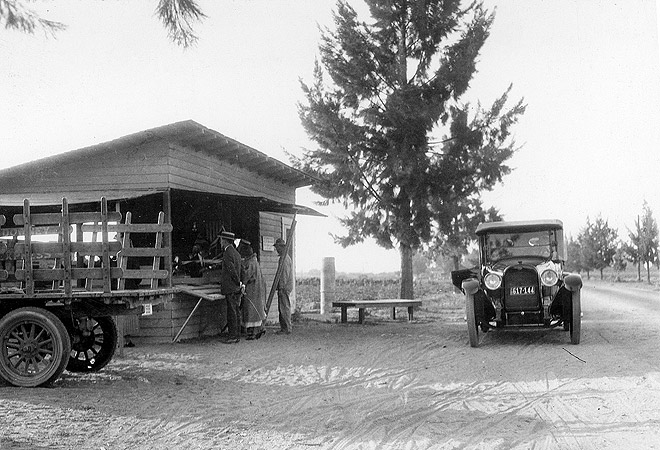 |
|
| (1926)^#*# - Walter Knott's roadside berry stand along Western Avenue in 1926. |
Historical Notes In 1923, Walter Knott opened his first roadside produce stand on Western Avenue in Orange County. The dusty highway passing through Knott’s berry farm was fast becoming the principal route between Los Angeles and the beach cities of the Orange Coast, and beach-bound motorists discovered the farmer’s humble wooden shack—located near the midpoint of their drive—as a place to momentarily escape the automobile and sample Knott’s farm-fresh berries and preserves.^#*# |
 |
|
| (n.d.)*##^ - Walter and Cordelia Knott, the power couple behind Knott’s Berry Farm, stand in front of one of their original stands. The license plate on the Model T dates to 1920, the year the couple came to Buena Park to farm berries. |
Historical Notes Walter Knott and his family developed their Buena Park berry farm into a popular tourist attraction in the 1920s. Originally selling berries, homemade berry preserves and pies from a roadside stand, Knott built a restaurant, shops and stores onto the property by the 1930s. These were then augmented with minor attractions and curiosities until Knott gradually created Ghost Town, transforming them from a way-point to a Western themed destination in 1940.^* |
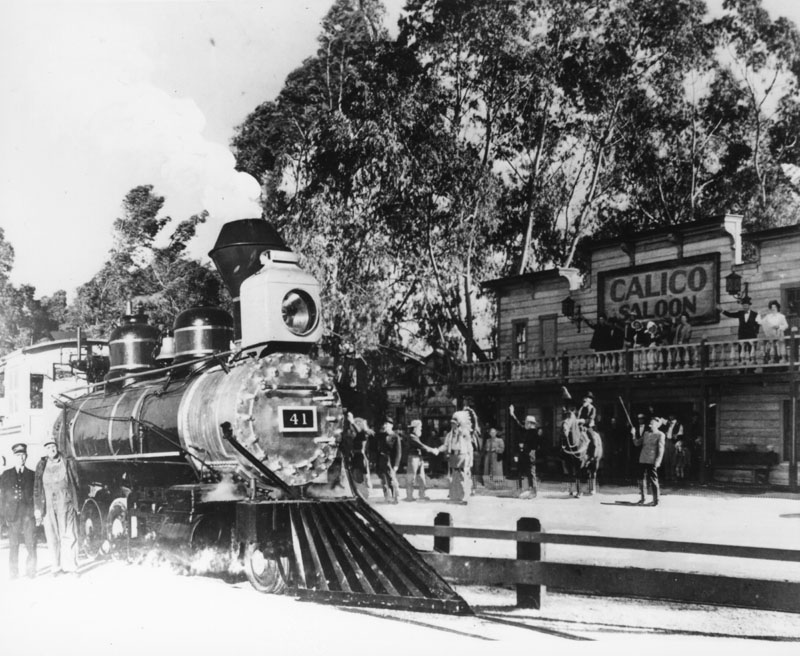 |
|
| (1958)^ - An older-model train near the Calico Saloon at Knott's Berry Farm. Employees of the western-theme park are dressed in period costumes. |
Historical Notes The idea of an amusement park really picked up in the 1950s when Walter Knott opened a "summer-long county fair". In 1968, for the first time, an admission of 25 cents was required to get into the park. The Calico log ride was added in 1969. Click HERE to see more in Early Views of Southern California Amusement Parks. |
* * * * * |
The Pike
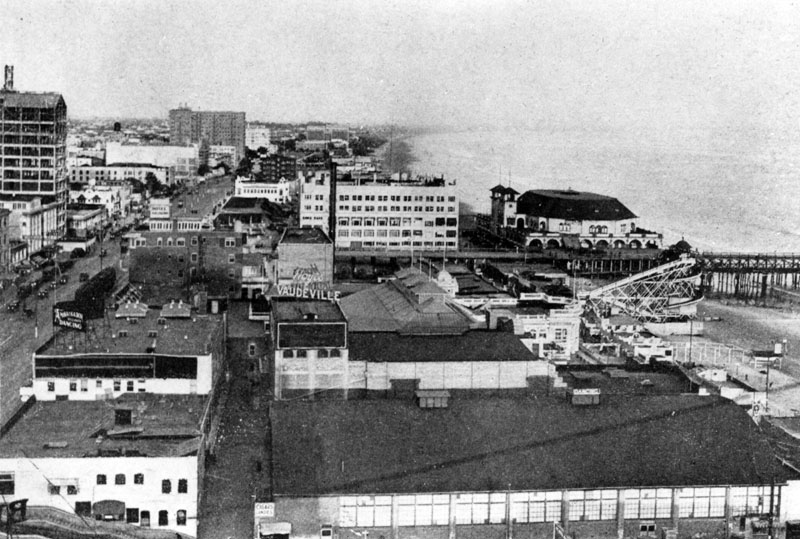 |
|
| (ca. 1925)^ - Aerial view of The Pike, the Municipal Auditorium, right, and the pier in Long Beach. A sign, Hoyt's Vaudeville, identifies Hoyt's Theater directly behind The Pike's roller coaster. The twelve story Heartwell Building at 19 Pine Avenue, left, is under construction. The wide boulevard following the shore is Ocean Boulevard. |
 |
|
| (ca. 1928)^ - The Pike and Pleasure Pier, center, jut out into the ocean from the shore. The ornate bathhouse with its portico sits in the midway. Advertisements for the various attractions at The Pike are on the side of the pier underneath the roller coaster. Portions of the Virginia Hotel and its tennis courts are just beyond The Pike and breakwaters and ocean vessels are on the horizon. |
Historical Notes Click HERE to see more in Early Views of Southern California Amusement Parks |
There's Oil In Them Hills - Signal Hill
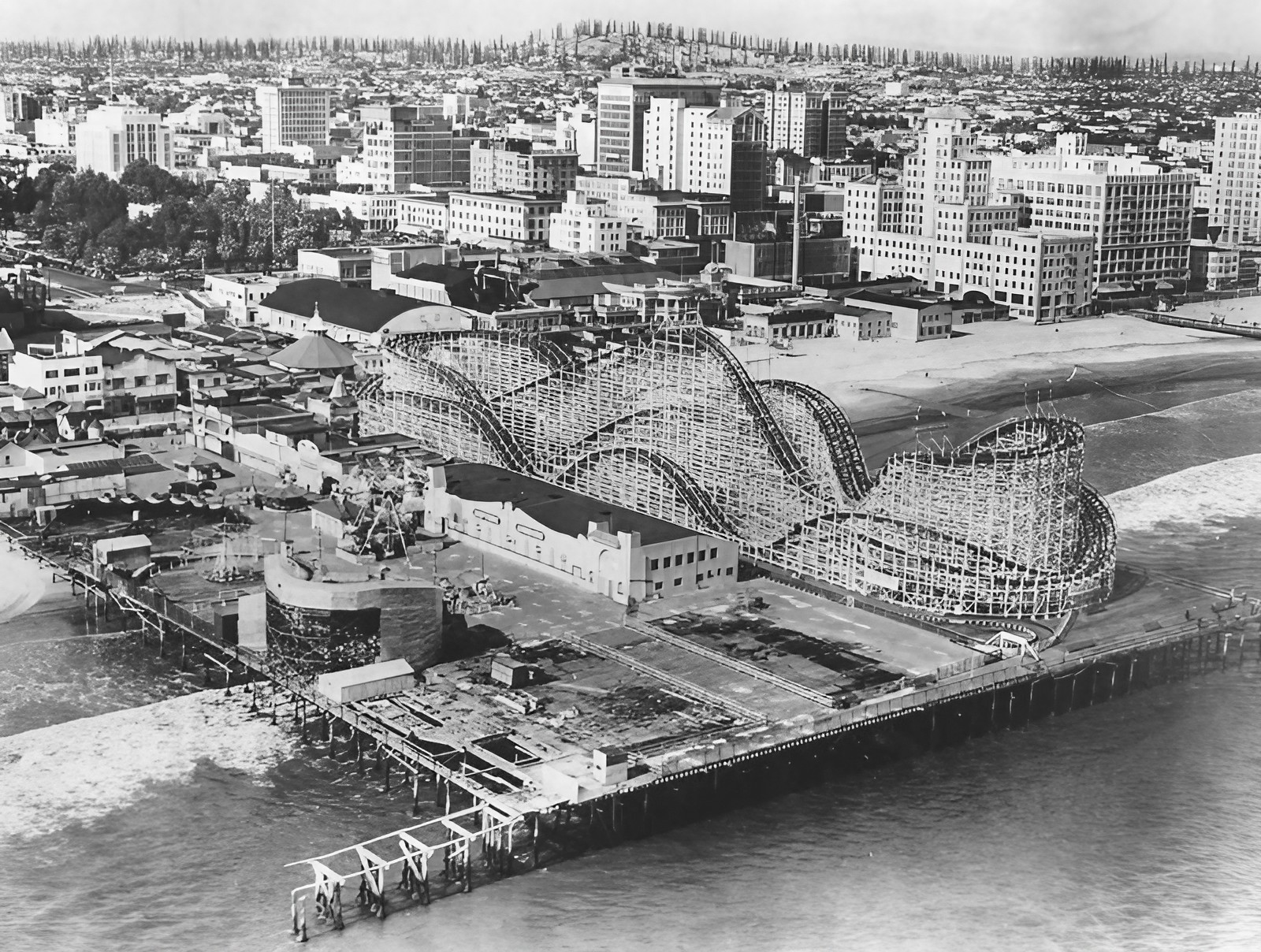 |
|
| (ca. 1940)* - Aerial view of a fairly deserted Pike amusement park and downtown Long Beach. The large roller coaster, the Cyclone Racer (center) is the largest attraction at the park. Numerous oil derricks can be seen in the background on top of Signal Hill. |
Historical Notes In the early 1920s, Signal Hill was a peaceful community overlooking Long Beach. Large homes dotted its slopes, while lower lands held farms of beans, vegetables, and flowers, many tended by Japanese-American families. That all changed on June 23, 1921, when Shell Oil’s Alamitos #1 well erupted, shooting oil 114 feet into the air. The discovery turned Signal Hill into part of the Long Beach Oil Field — one of the most productive in the world — and earned it the nickname “Porcupine Hill” for the bristling forest of derricks that quickly followed. |
Signal Hill
.jpg) |
|
| (1922)* - Panoramic view of a residential neighborhood in Long Beach, facing north and east, with the Signal Hill oil field in the background. The neighborhood consists of hundreds of single family homes and small apartment buildings. The streets seem to be unpaved, and there are only a few automobiles parked on the street on the right. The entire horizon is lined with the oil derricks of Signal Hill. |
Historical Notes Signal Hill changed forever when oil was discovered. The hill would soon become part of the Long Beach Oil Field, one of the most productive oil fields in the world. On June 23, 1921, Shell Oil Company's Alamitos #1 well erupted. The gas pressure was so great the gusher rose 114 ft. in the air. Soon Signal Hill was covered with over 100 oil derricks, and because of its prickly appearance at a distance became known as "Porcupine Hill". |
 |
|
| (1924)^ – View showing Signal Hill in 1924, the year it was incorporated. |
Historical Notes Signal Hill was originally an unincorporated part of Los Angeles County. Oil was first found there in 1921, and when the city of Long Beach tried to absorb it, the oil companies banded together with the town's residents to form their own city, which was incorporated in 1924. |
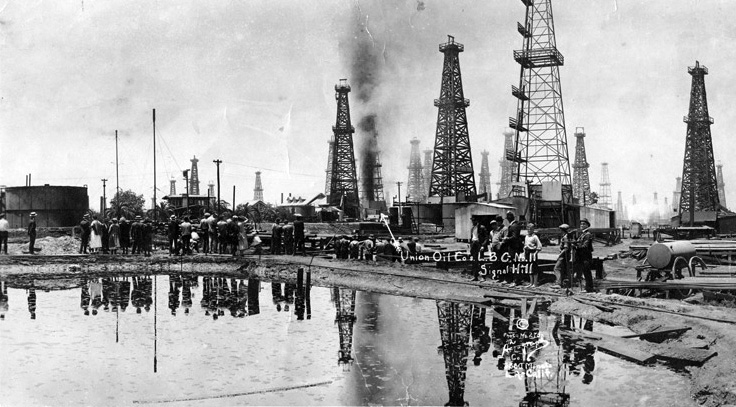 |
|
| (ca. 1923)* - Postcard view of an oil well erupting into the air as a large group of people stand and watch. |
Historical Notes Alamitos #1 well is one of the world's most famous wells. This discovery well led to the development of one of the most productive oil fields in the world and helped to establish California as a major oil producing state. Because of this it is designated as a California Historical Landmark No. 580 (Click HERE to see more in California Historical Landmarks in LA County). |
 |
|
| (1926)* - Two men sit on a car parked next to an oil field full of derricks in Signal Hill. A sign reading, "Pacific Coast Welding" is visible at the roofline of the small structure behind the car. |
Historical Notes Between 1913 and 1923 an early California movie studio, Balboa Amusement Producing Company (also known as Balboa Studios), was located in Long Beach and used 11 acres on Signal Hill for outdoor locations. Buster Keaton and Fatty Arbuckle were two of Balboa Studio actors who had films shot on Signal Hill. |
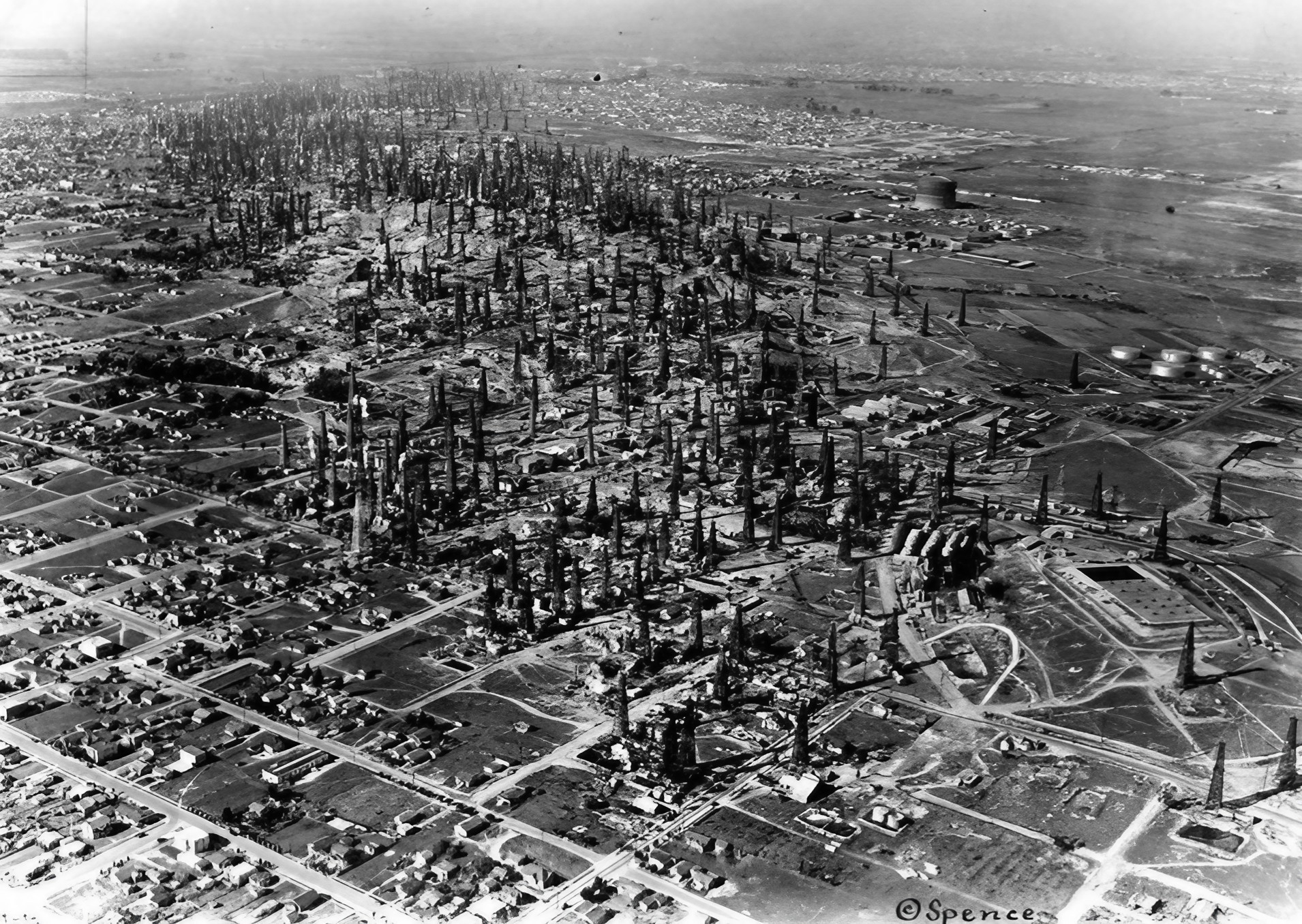 |
|
| (1930)* - Aerial view of Signal Hill's oil field, from Reservoir Hill. A sea of oil wells almost cover the entire City of Signal Hill. |
Historical Notes Before oil was discovered in Signal Hill, there were large homes built on the hill itself, and in the lower elevations was an agricultural area where fruits, vegetables, and flowers were grown. Many of the truck farmers were Japanese. |
 |
|
| (1937)* - A forest of oil derricks sprouts up on the Signal Hill oil field. |
Historical Notes Production peaked in the 1930s, with more than 260,000 barrels a day coming from the Long Beach Oil Field. Locals described the sound of the machinery as “the heartbeat of the hill,” a rhythm that never truly stopped. |
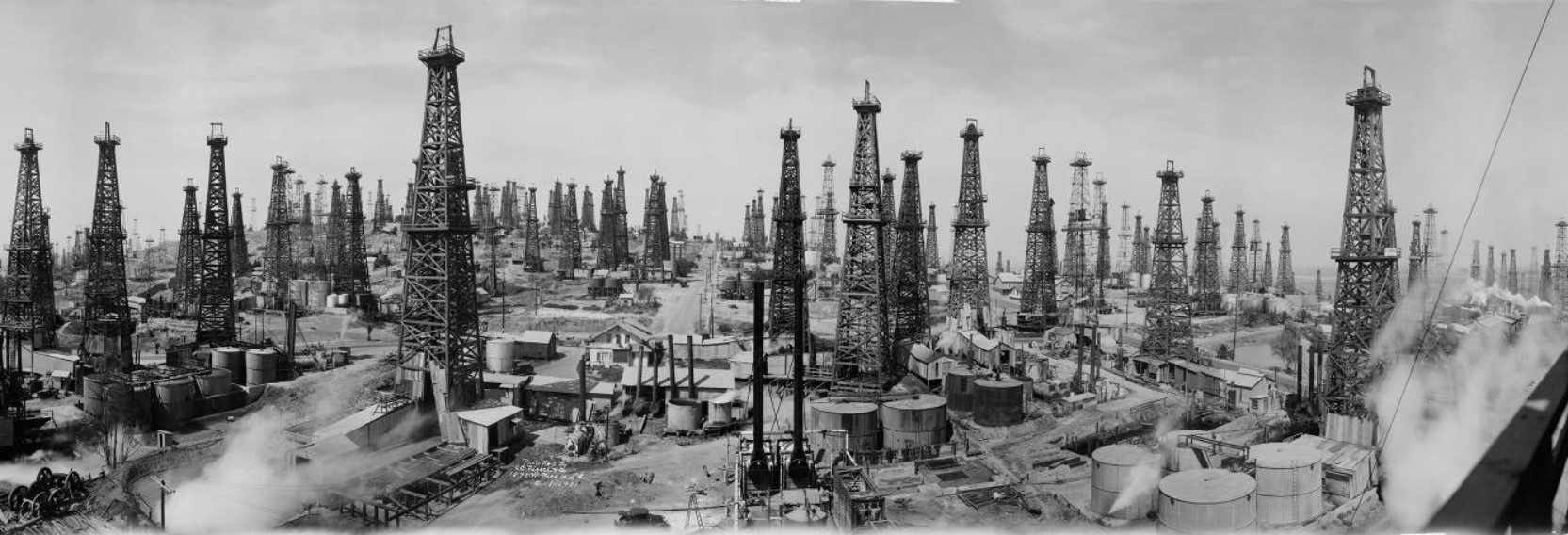 |
|
| (1931)*- Panoramic view of the oil field at Signal Hill. There are hundreds of oil rigs, or derricks, most with sheds or circular structures nearby, distributed along dirt roads. There are a few houses scattered among the oil rigs. Steam is rising from some of the rigs in the immediate foreground. |
Historical Notes Some residents stayed despite the noise and hazards. They learned to live alongside the industry, adapting to life where drilling rigs might be closer than the nearest neighbor. |
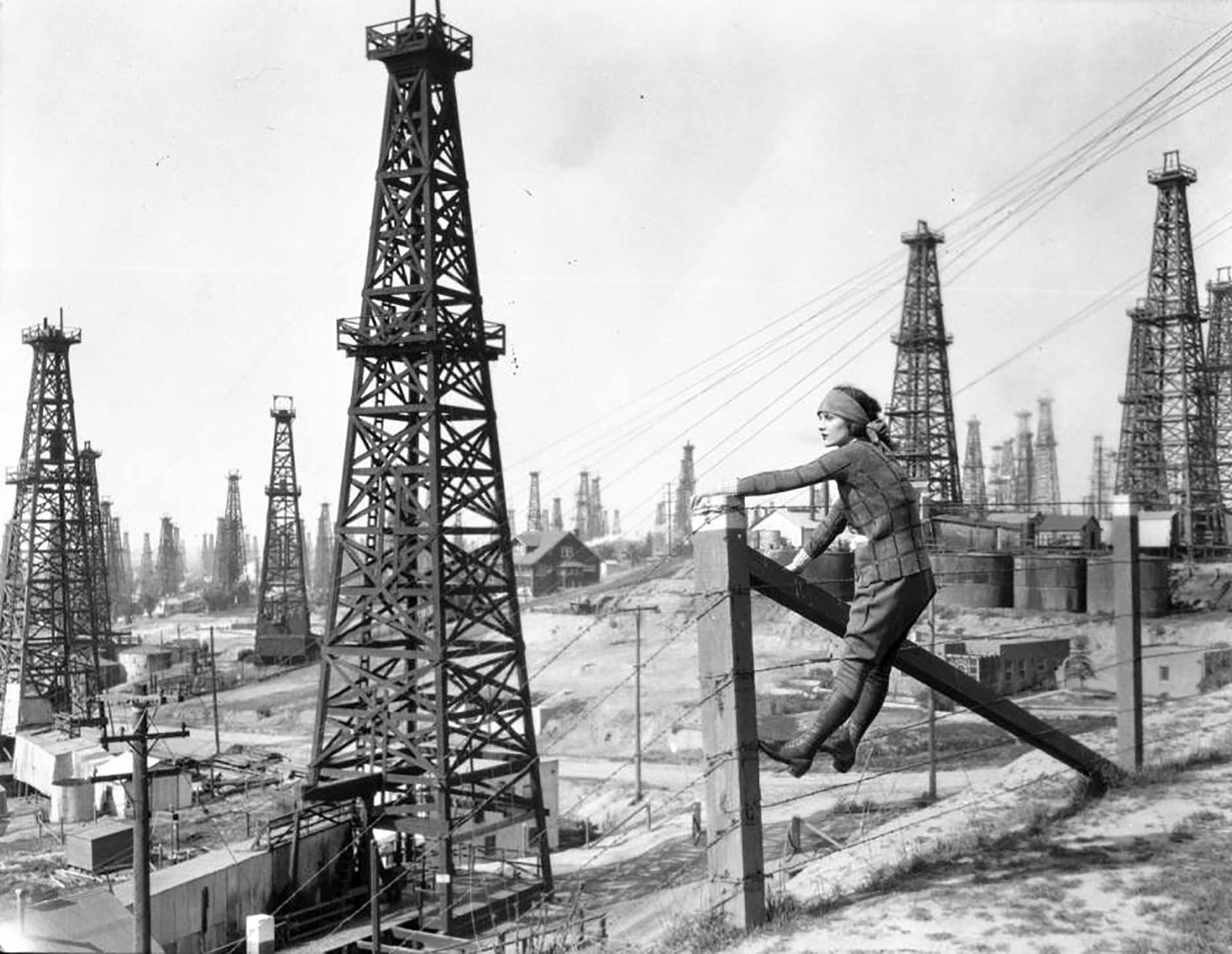 |
|
| (ca. 1930s)* – View showing a woman posing on a fence at the Signal Hill oil field. |
Historical Notes The oil fields became a strange kind of tourist draw. Visitors posed for photographs among the towering derricks, and their geometric lines against the sky inspired photographers and artists alike. |
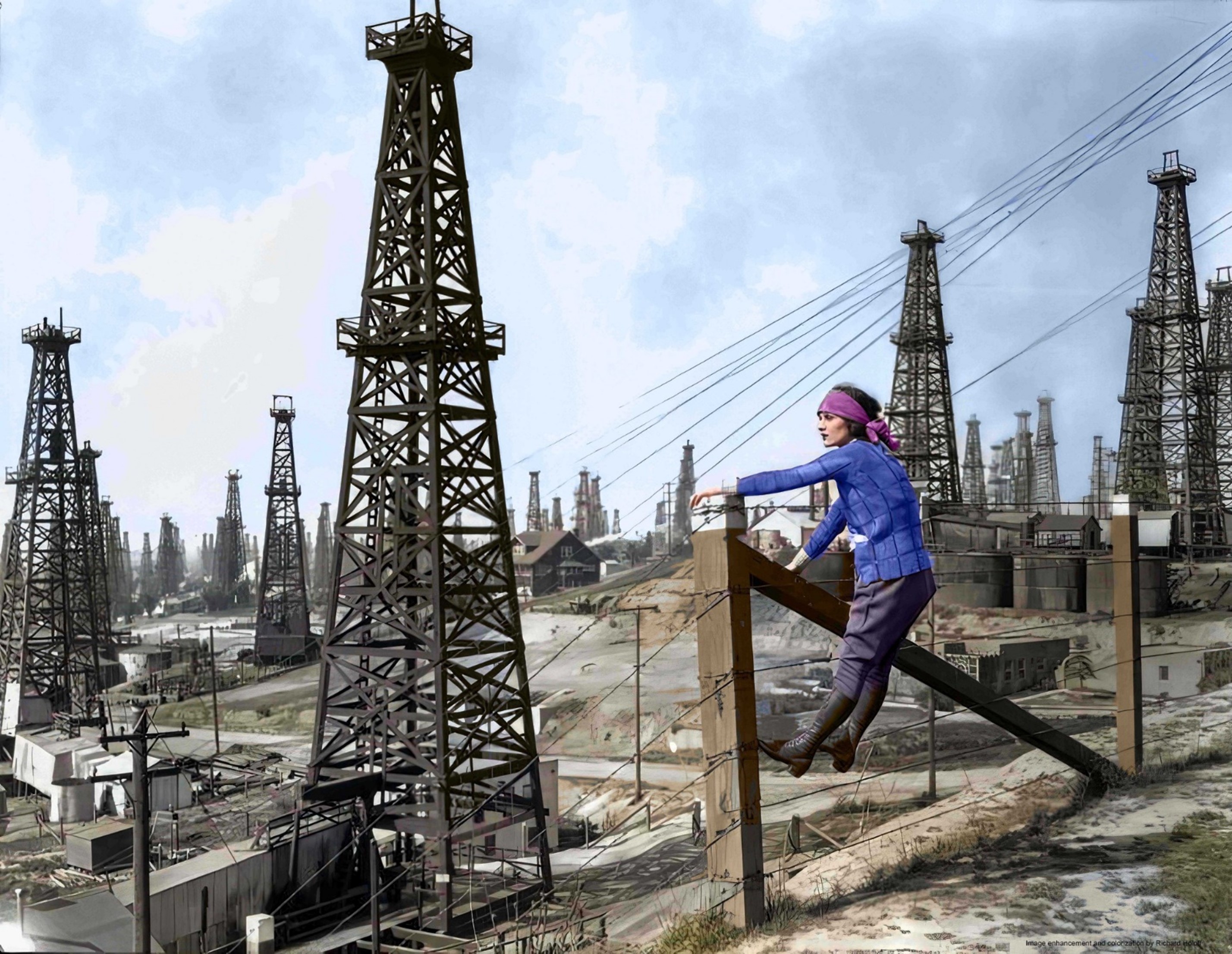 |
|
| (ca. 1930s)* – View showing a woman posing on a fence at the Signal Hill oil field. Image enhancement and colorization by Richard Holoff |
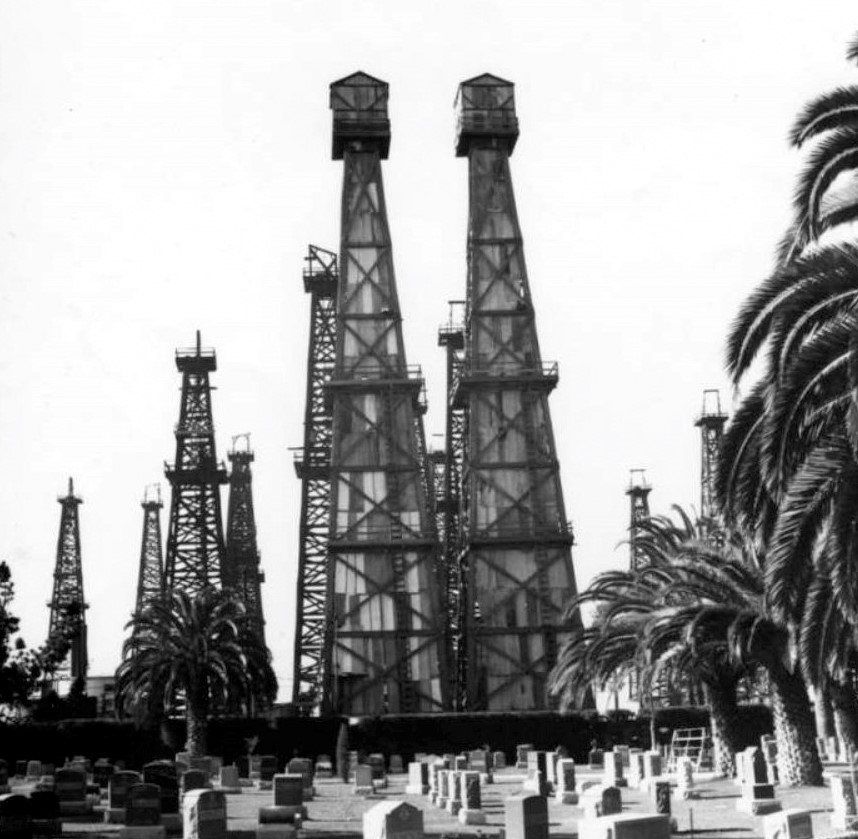 |
|
| (ca. 1940)* – View showing several large oil derricks drilling for oil in a Signal Hill field next to Sunnyside Cemetery in Long Beach. Photo by Ansel Adams |
Historical Notes Even the cemetery was surrounded by drilling. Adams’ photo captures the quiet irony of resting places standing in the shadow of California’s oil boom. |
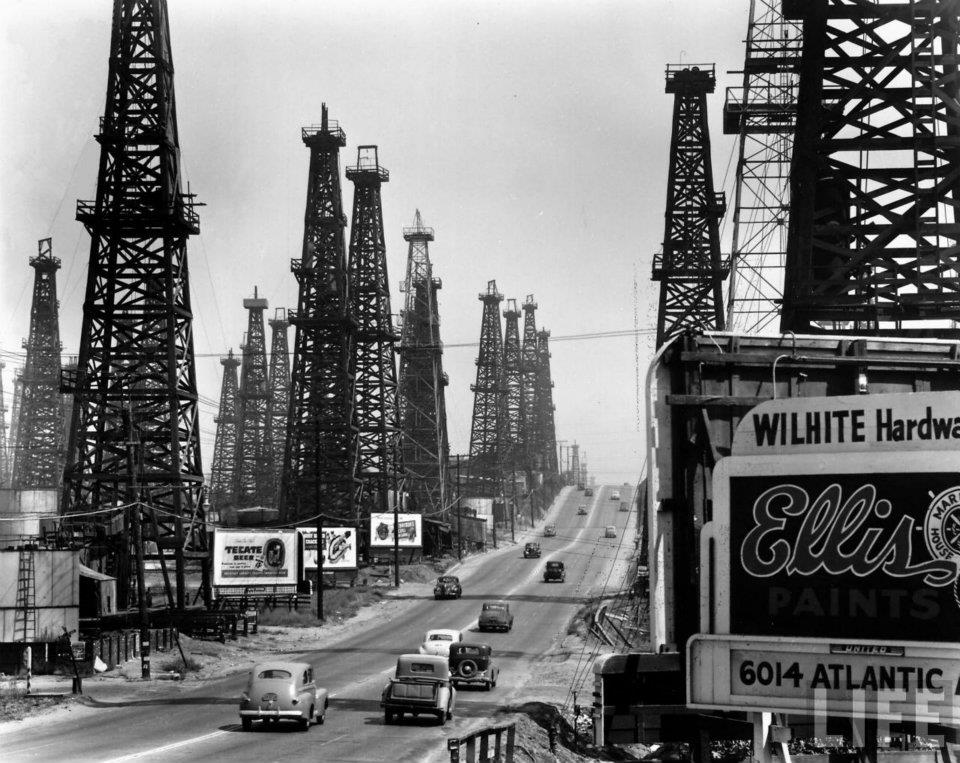 |
|
| (ca. 1940s)* - View of Long Beach Boulevard passing through Signal Hill. |
Historical Notes Motorists drove between rows of derricks lining both sides of the street. By now, steel rigs were replacing the older wooden ones, signaling modernization but also the beginning of a slow decline in peak production. |
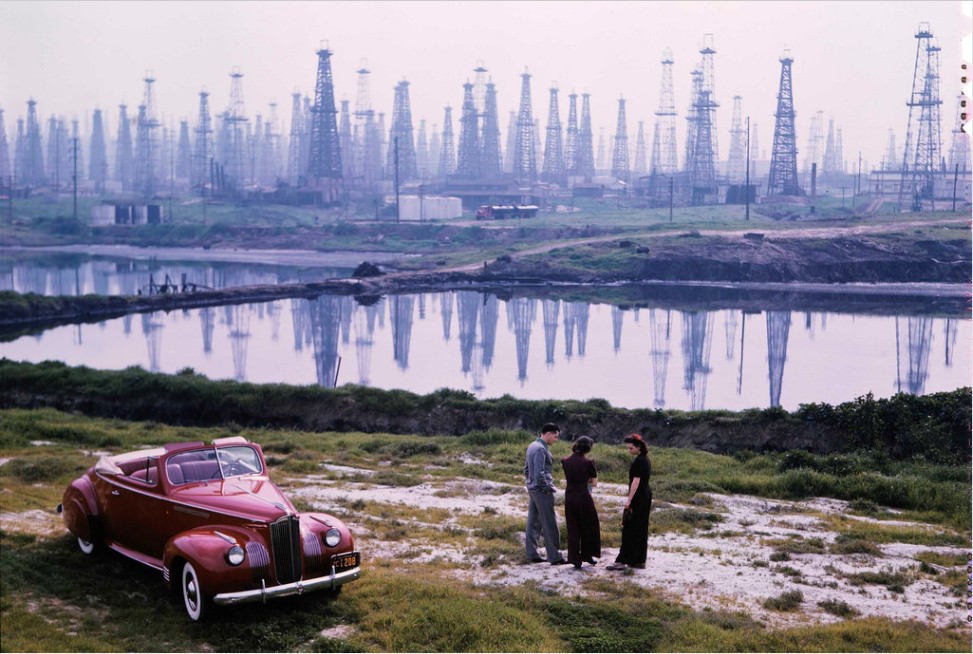 |
|
| (1941)* - Signal Hill |
Historical Notes World War II brought new demand. Signal Hill’s oil powered local aircraft factories and supplied fuel to the Navy’s Pacific Fleet. Drilling went on day and night to meet wartime needs. |
 |
|
| (1951)* – Postcard view of Signal Hill as seen from Long Beach, CA. It was nicknamed “Porcupine Hill” because of its prickly appearance when seen from a distance. |
Historical Notes The City of Signal Hill is completely surrounded by the city of Long Beach. It was incorporated on April 22, 1924, roughly three years after oil was discovered there. Among the reasons for incorporating was avoiding annexation by Long Beach with its zoning restrictions and per-barrel oil tax. Signal Hill's first mayor, Jessie Nelson, was California's first female mayor. As of the 2010 census, the city population was 11,465.* |
* * * * * |
Rose Bowl
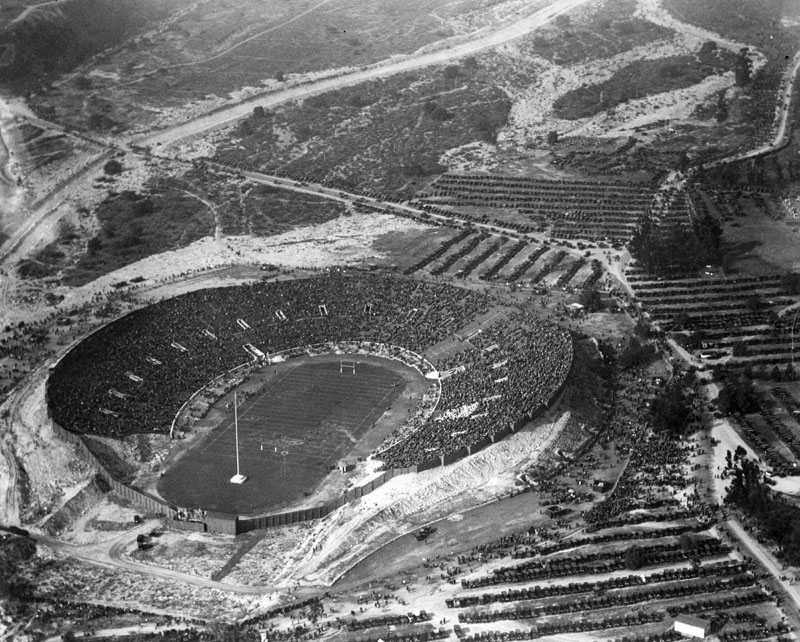 |
|
| (1925)^ - Aerial view of the Rose Bowl on New Years Day, January 1, 1925. The stadium is almost full, yet crowds of people are still walking in. The football score that day was: Notre Dame, 27 vs Stanford, 10. |
Historical Notes After crowds out-grew Pasadena's Tournament Park, architect Myron Hunt drew up plans for the construction of the Rose Bowl stadium in 1921. The Arroyo Seco dry riverbed was selected as the location for the stadium, which was under construction from 1921-1922. The Rose Bowl was opened on October 8, 1922 at a cost of $272,198, but was officially dedicated on January 1, 1923 with the first Rose Bowl game between USC and Penn State (USC defeated Penn, 14-3).^ |
 |
|
| (1923)* - Panoramic view of the 1923 Rose Bowl Game between Penn State University and the University of Southern California at the Rose Bowl Stadium in Pasadena. The stands are almost filled, with the exception of some of the higher areas on the far side of the stadium. Small groups of what appear to be military men are seated on chairs on the track surrounding the field. The game is in progress, with the two teams in the middle of a series near midfield. There are men positioned at several places along the near sideline with photographic cameras, and one man near midfield has a motion picture camera. There is a very tall flag pole on the far right with a large American flag. A large number of automobiles are parked on the far right, beyond the open part of the stadium, where there are also a couple hundred people watching the game over the stadium fence. |
Historical Notes January 1, 1923 was the first time that the Rose Bowl Game was held at the Rose Bowl Stadium. The game featured Penn State University and the University of Southern California, with the score ending at USC 14 to PSU 3.*^#* The name of the stadium was alternatively "Tournament of Roses Stadium" or "Tournament of Roses Bowl", until being settled as "Rose Bowl" before the 1923 Rose Bowl game.^* Click HERE to see more in Early Views of USC. |
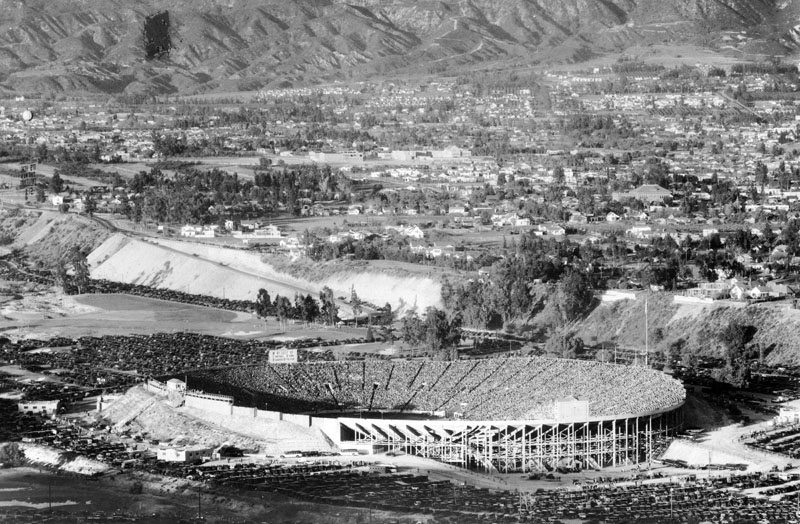 |
|
| (ca. 1928)^ - Aerial view of the Rose Bowl after the southern stands were constructed making it a complete bowl. Though the stadium appears to be filled to capacity, people are still trickling in, and row upon row of automobiles can be seen neatly parked in the lots. View also shows the residential homes surrounding the stadium, as well as the mountains in the background. |
Historical Notes The stadium was originally built as a horseshoe and was expanded several times over the years; the design was intended to accommodate as many patrons as possible. The southern stands were completed in 1928, making the stadium a complete bowl. For many years, the Rose Bowl had the largest football stadium capacity in the U.S., and from 1972 to 1997, the maximum seating capacity was 104,594. Current official seating capacity is 92,542. The Rose Bowl game grew to become the "granddaddy" of all bowl games, because of its stature as the oldest of all the bowl games. The Rose Bowl stadium is a National Historic Landmark, and was added to the National Register of Historic Places on February 27, 1987.^ |
Click HERE to see more in Early Views of the Rose Bowl |
* * * * * |
East Hollywood
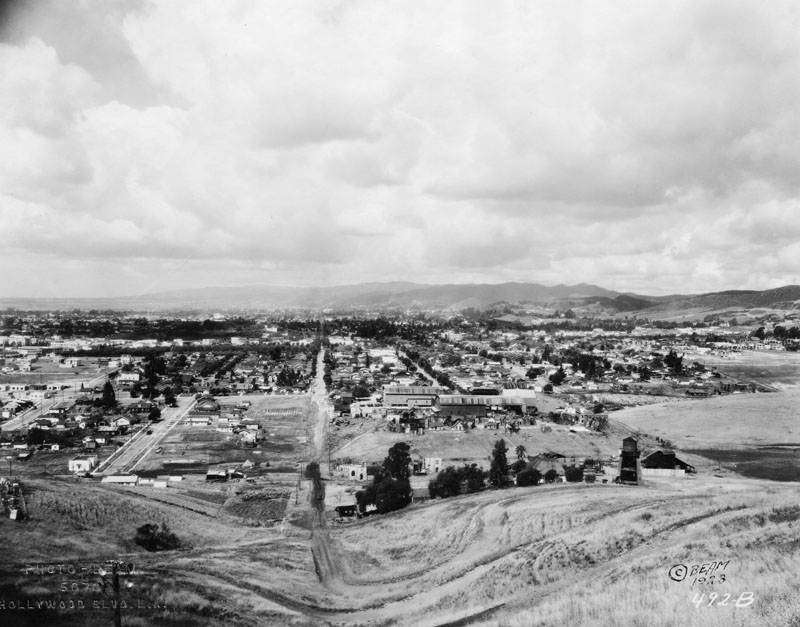 |
|
| (1923)^ - Looking west from Olive Hill, down Hollywood Boulevard on the East side of Hollywood in what appears to be a residential area. |
Historical Notes The famous street was named Prospect Avenue from 1887 to 1910, when the town of Hollywood was annexed to the city of Los Angeles. After annexation, the street numbers changed from 100 Prospect Avenue, at Vermont Avenue, to 6400 Hollywood Boulevard.^* |
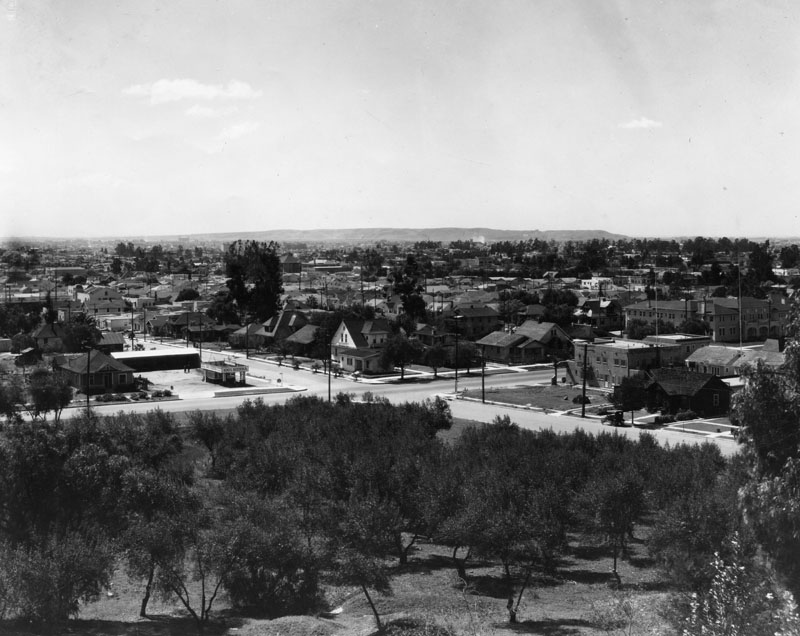 |
|
| (ca. 1920s)^ - Panoramic view of a residential area in East Hollywood in the early 1920s, looking southwest from Sunset Boulevard and Edgemont Street. In the foreground are the olive trees of Olive Hill. Today, Kaiser Permanente Hospital stands at this corner. |
Historical Notes Olive Hill is located in the East Hollywood district. Barnsdall Park sits on top of Olive Hill near the intersection of Hollywood and Vermont, and is home to the famous Hollyhock House that was designed in the 1920's by the internationally acclaimed architect Frank Lloyd Wright. |
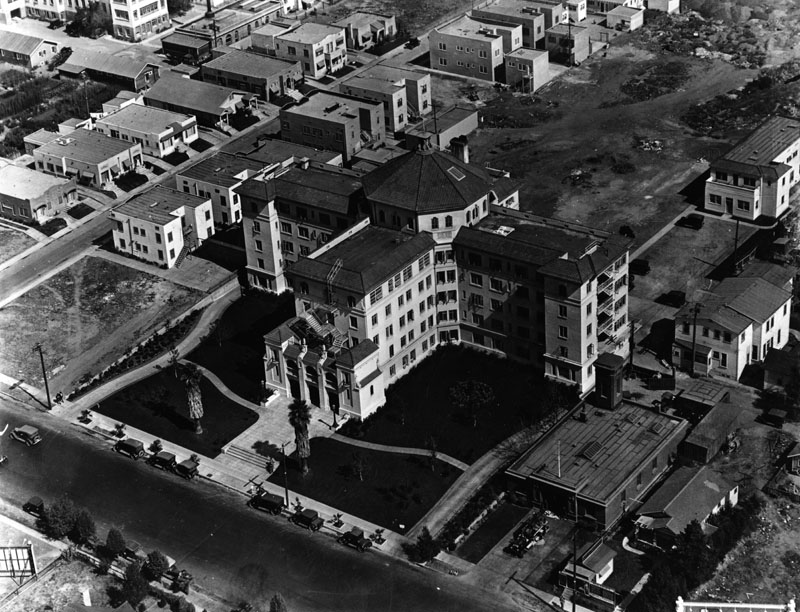 |
|
| (ca. 1925)^ - Aerial view of Hollywood Presbyterian Hospital, located at 1300 North Vermont Avenue. There is a fire station at right, and open space is seen at left and behind the hospital. Duplexes and apartment buildings are seen as well, and possibly a nursery growing ground at left. |
Historical Notes Hollywood Presbytarian Hospital was founded as Hollywood Hospital in 1924. It was later known as Queen of Angels-Hollywood Presbyterian Medical Center. In 2004, it was sold to the CHA Medical Group of South Korea for $69 million.^* |
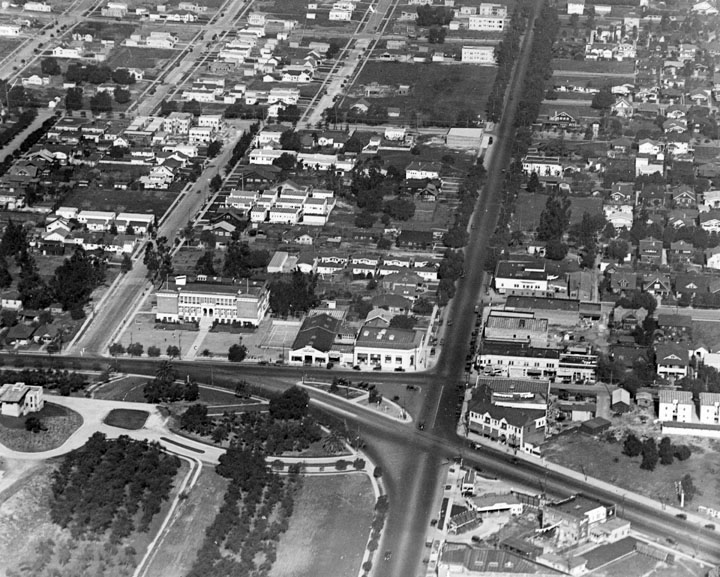 |
|
| (1930)^ - Aerial view of Hollywood Blvd. and Vermont. Vermont runs up and down (north/south) in this picture, while Hollywood Blvd. comes in from the left. The surrounding buildings and lawns in the Los Feliz area can be seen. |
Click HERE to see more in Early Views of Hollywood (1920 +) |
* * * * * |
Downtown
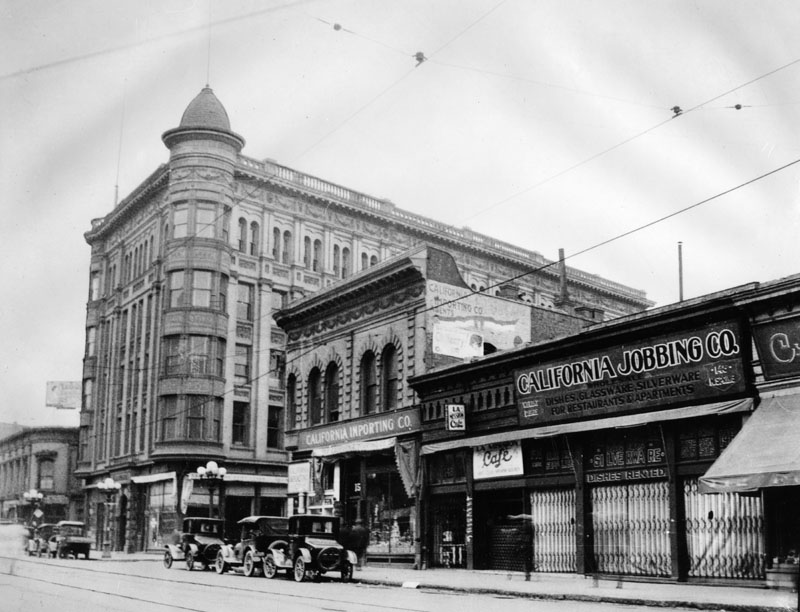 |
|
| (1925)^ - The five-story J.A. Bullard Block on Spring and Court Streets, looking north on Spring in 1925. The building is on the northeast corner of the intersection. California Importing Co. is on the southeast corner. Next to it is the L.A. Mission Cafe and California Jobbing Co., featuring dishes, glassware, silverware for restaurants and apartments. Streetcar tracks are seen on Spring, and cars are parked on the street. Behind the Bullard Block is Market Street. |
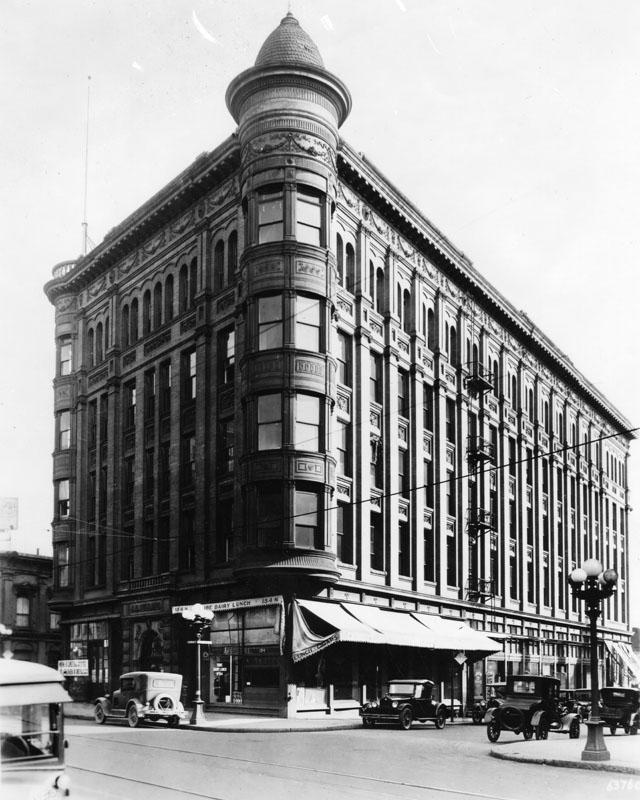 |
|
| (ca. 1925)^ - Exterior view of the Bullard Block located on the northeast corner of Spring and Court streets. At one time the building housed the courthouse. Note the ornate 5-bulb lamps on the corners. Click HERE to see more in Ealry L.A. Street Lights. |
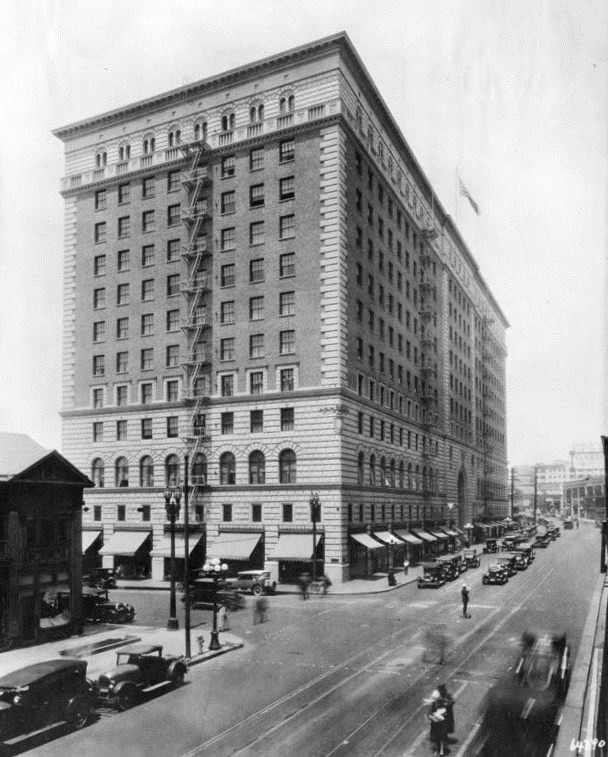 |
|
| (1926)^ -View looking southwest showing the Barker Brothers furniture store building, located at 818 W. 7th St. Cars are moving along Seventh St. and Pacific Electric streetcar tracks are visible in the foreground. A policeman is seen standing on a box in the middle of the intersection directing traffic. |
Historical Notes Barker Brothers' fine furnishings was a Los Angeles upscale furniture chain that closed in 1992 after operating for more than 110 years. Obadiah J. Barker was a Los Angeles business man and the founder and president of the furniture company, Barker Brothers. Born in Bloomfield, Indiana, Barker moved with his family to Colorado Springs, Colorado as a young man. He attended Colorado College and also attended dental school in St. Louis. However, he did not complete dental school and moved to Los Angeles with his parents and brothers in 1880. The family began a successful furniture business on Spring Street in Los Angeles. The company became one of the world's biggest house-furnishing stores.^* |
Main and 4th Street
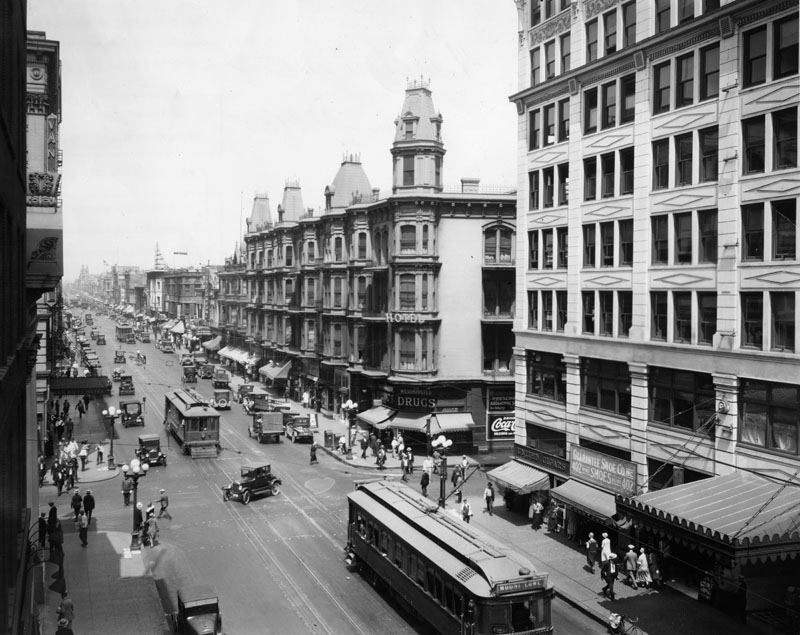 |
|
| (1926)^ - Main and 4th streets, showing the Westminster Hotel on the northeast corner and the San Fernando Building (right) on the southeast. |
7th and Hill Streets
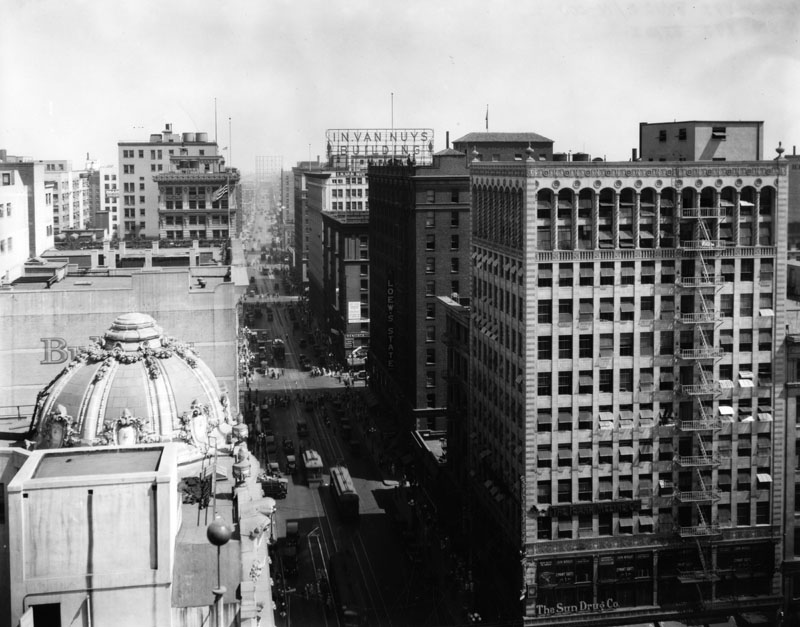 |
|
| (1926)^ - 7th Street, east from Hill Street, with several historical buildings in view. |
Historical Notes On the left: the domed building is the Pantages Theatre. It was designed by architect B. Marcus Priteca, and opened on August 16, 1920; Bullock's Department Store, built in 1906 by Parkinson & Bergstrom and founded by John G. Bullock. Bullock's grew from one building to several, encompassing real estate along Seventh and surrounding the historic St. Vincent's Court and up Hill Street. It closed in 1986, and is now the St. Vincent's Jewelry Center. On the right: the Real Estate building, with The Sun Drug Co. occupying the ground floor, built in 1922 and designed by architects Curlett & Beelman; Loew's State Theatre, built in 1921 and designed by architect Charles P. Weeks; the I.N. Van Nuys Building, designed in the Beaux Arts style by architects Morgan, Walls and Clements, and built by Scofield-Twaits Company in 1910-1911.^ |
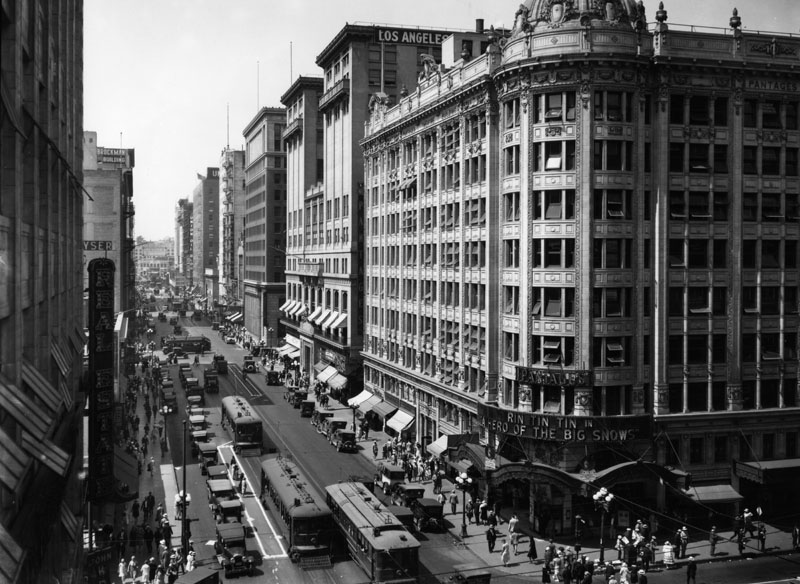 |
|
| (1926)^ - View of 7th Street, west from Hill Street. Crowds of people and numerous cars and trolleys can be seen lining the streets and sidewalks. |
Historical Notes The prominent building on the right corner is the Pantages Theatre; its large marquee is advertising the Rin Tin Tin movie "A Hero of the Big Snows". The theater was designed by architect B. Marcus Priteca, and opened on August 16, 1920. Directly behind the Pantages is the Los Angeles Athletic Club, built in 1911 by Parkinson & Bergstrom. This building was notable at the time for being the first in Southern California to have a swimming pool on an upper floor. Other historical buildings visible in this photograph are: The Brack Shops, built in 1914; Union Oil Building and Roosevelt Building, both built in 1922 by Curlett & Beelman; the Real Estate Building; and The Brockman Building, built in 1911 by Barnett, Haynes & Barnett.^ |
jpg.jpg) |
|
| (ca. 1926)^ - A view of the northwest corner of 7th & Hill, looking down the 7th Street side of the Pantages Theatre building. Its large marquee is advertising the Ritz Brothers movie "Marriage License". Cars, trolleys and people are seen all down the street. A horse-drawn carriage is at lower right. |
Historical Notes The Pantages Theatre, a nine-story steel-framed building designed by architect B. Marcus Priteca, was the city’s second theatre (and the country’s sixteenth) built for the namesake vaudeville circuit. It is a richly ornamented Beaux Arts structure that includes a 2,200 seat theatre, shops, and offices on the upper floors.*^# The home of the Pantages circuit prior to this was the 1910 building at 534 S. Broadway. That theatre is now known as the Arcade.^^*# |
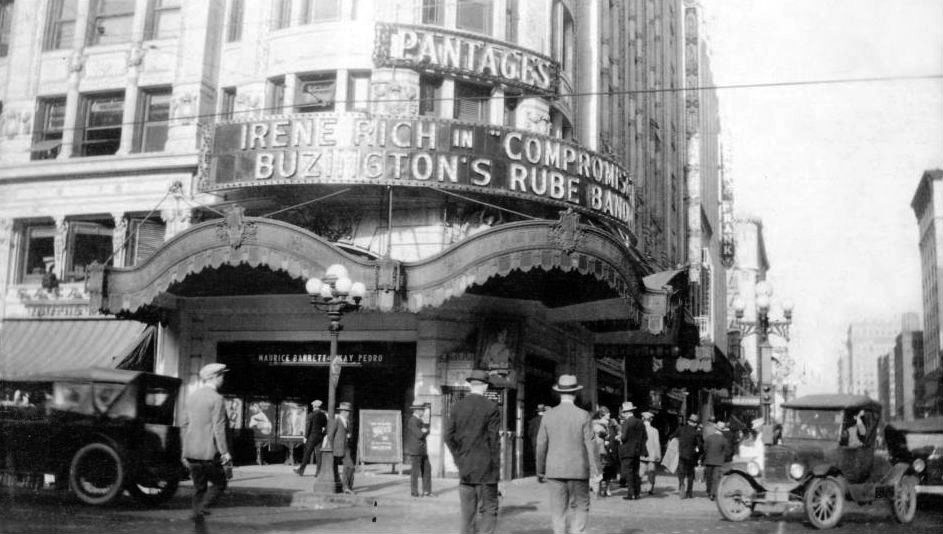 |
|
| (1925)#*#^ - View of the front entrance to the Pantages Theatre. Several men are seen crossing the street as a late model coupe waits to make a turn. The beautiful curved marquee reads: Irene Rich in "Compromise" and Buzington's Rube Band. Note the ornate 5-lamp streetlight posts in front of the theatre. Click HERE to see more Early L.A. Streetlights. |
Historical Notes The Pantages opened as the second Pantages theater in downtown Los Angeles (the Arcade theater was the first), this B. Marcus Priteca designed theater included Greek treatments for owner Alexander Pantages. The theater’s exterior was coated in white terra cotta.##^^ Greek-born Alexander Pantages got his start in show business selling seats for readings of newspapers to miners in Alaska who were starved for information and entertainment.^^*# |
* * * * * |
Broadway and 5th Street
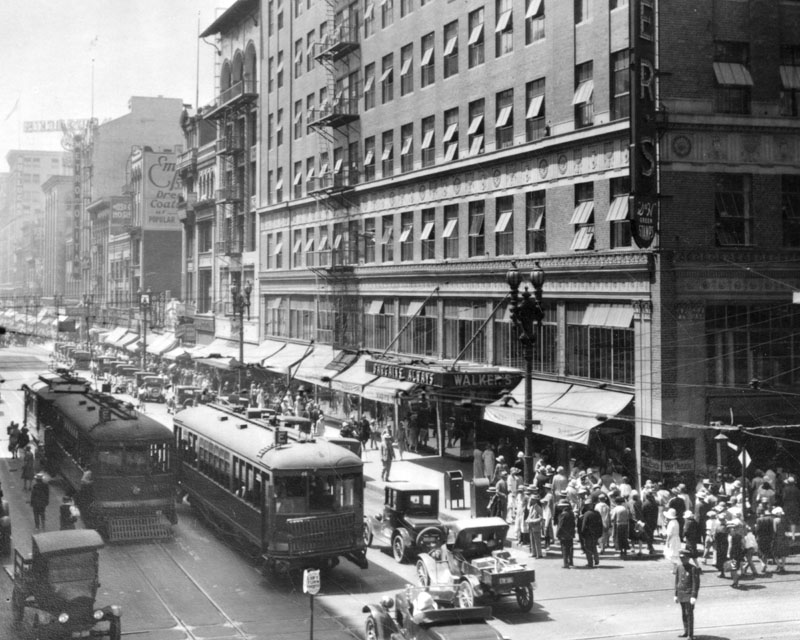 |
|
| (1926)^ - Exterior view of Walker's Department Store at the corner of Broadway and Fifth Street. A crowd of people are waiting to cross the street. A policeman is directing traffic while two streetcars pass each other. |
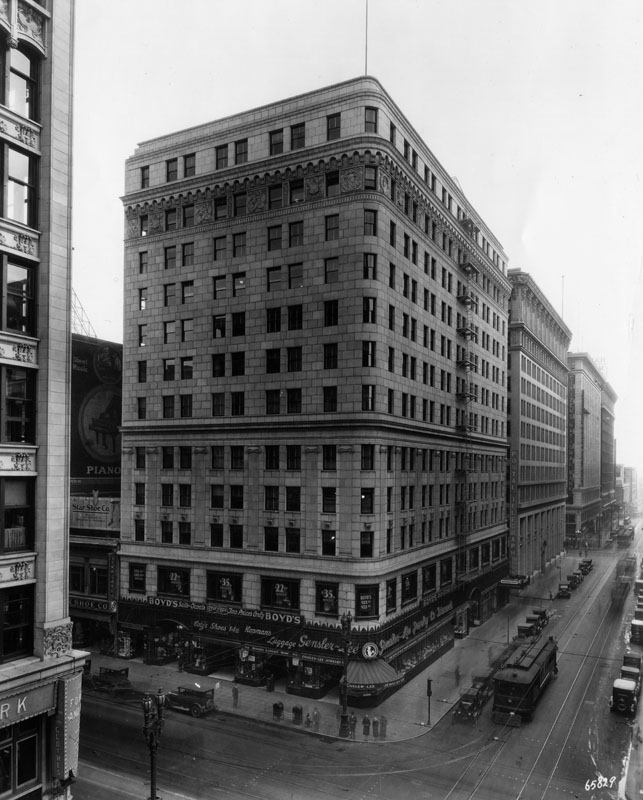 |
|
| (ca. 1927)^ - Looking across the intersection of Broadway and 5th, showing the Chester Williams Building, occupied by Gensler-Lee Jewelry and Boyd's Suits and Coats. A glimpse of the Metropolitan Building at 315 W. 5th Street (far left), shows part of the sign for the Foreman & Clark's clothing store upstairs. |
Historical Notes The 12-story Chester Williams Building was constructed in 1926 and located at 215 West Fifth Street. The building also has the address 452 South Broadway. It was designed by Architects Curlett & Beelman. In 2012, the Chester Williams Building was converted to a 88-unit apartment complex. The opening of the renovated Chester Williams makes the intersection of Fifth Street and Broadway only the second Historic Core crossing where all four corners are occupied by residential buildings. The first such intersection, at Sixth and Spring streets, was marked in 2010 with the opening of SB Tower. |
Broadway and 7th Street (Downtown's 'Busiest Intersection')
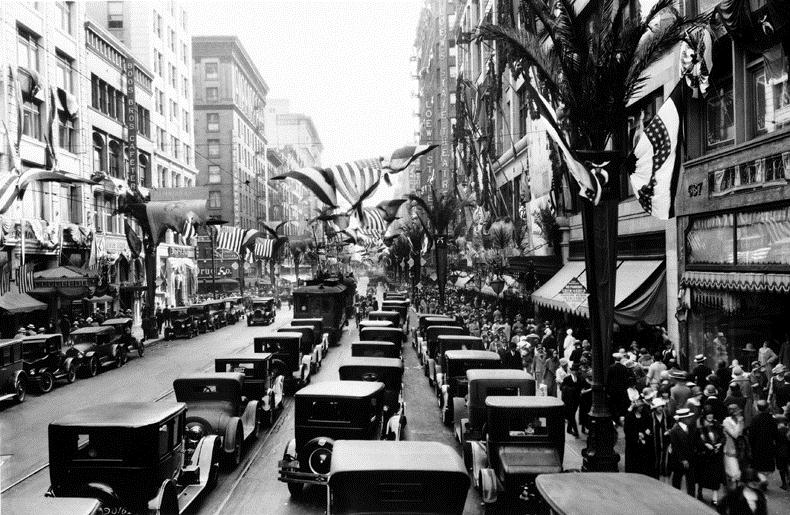 |
|
| (ca. 1925)^ - Broadway and 7th Street, looking south. The street is decorated with flags and signs welcoming the Shriners to Los Angeles. |
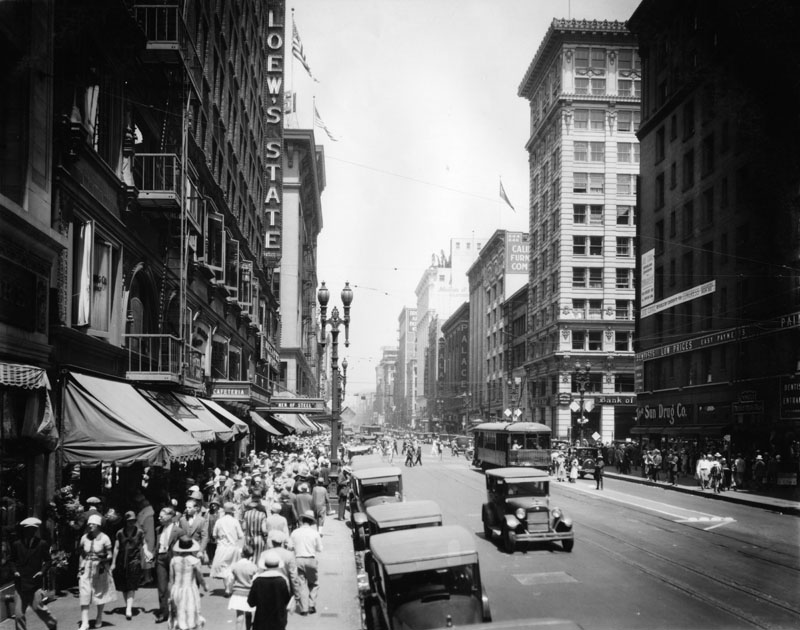 |
|
| (1926)^ - View looking north toward the intersection of Broadway and 7th St. On the left is the Loew's State Theatre. On the corner across the street is the Sun Drug Co. (S/E corner). Also, on the east side of Broadway and further north, can be seen Bank of America, the California Furniture Company and the Palace Theatre. |
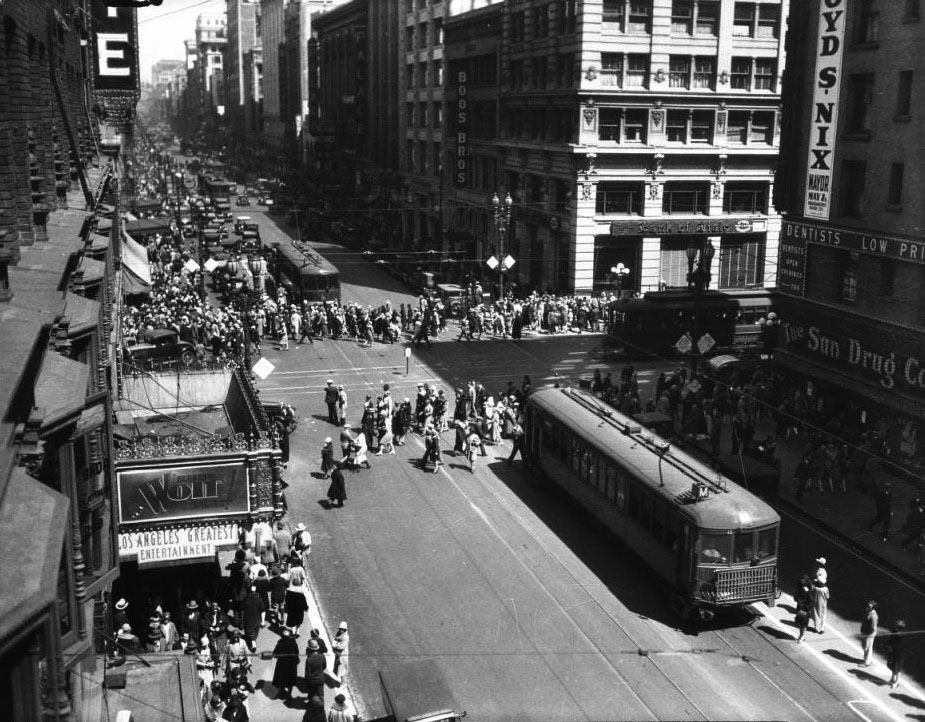 |
|
| (ca. 1926)*# - View looking down from what appears to be the the fire escape of the Lowe's State Theatre (see previous photo) toward the intersection of Broadway and 7th Street. Thousands of people fill the streets. Three streetcars are seen near the intersection. |
 |
|
| (1926)^ - A view of Broadway looking north from 7th Street. On the left, the large building on the N/W corner is the Bullock's Department Store . Beyond it is the Kress store. On the lower right can be seen the sign for the Boos Bros. Cafeteria. Note the beautiful two-lamp streetlight standing tall over the crowds of people. Click HERE to see more in Early Los Angeles Streetlights. |
 |
|
| (ca. 1926)*# - Street view looking south from the intersection of Broadway and 7th Street.. A crowd of people are crossing the street from right to left while an automobile tries to make a right turn through them. Crowds of other people huddle together on the sidewalks. A few are gathered by two post boxes and a street lamp at the foreground left corner. |
Historical Notes The Loew's State Theatre building can be seen at the right. Also in view are the Isaacs Building, Marshall Field & Company, Chicago Wholesale Dry Goods, Johnson Rass Company, Wholesale Millinery, Machin Shirt Company, Clayburgh Brothers Woolens at 745 South Broadway, a dentist's office at 706 South Spring, and the Lankershim Hotel.*# |
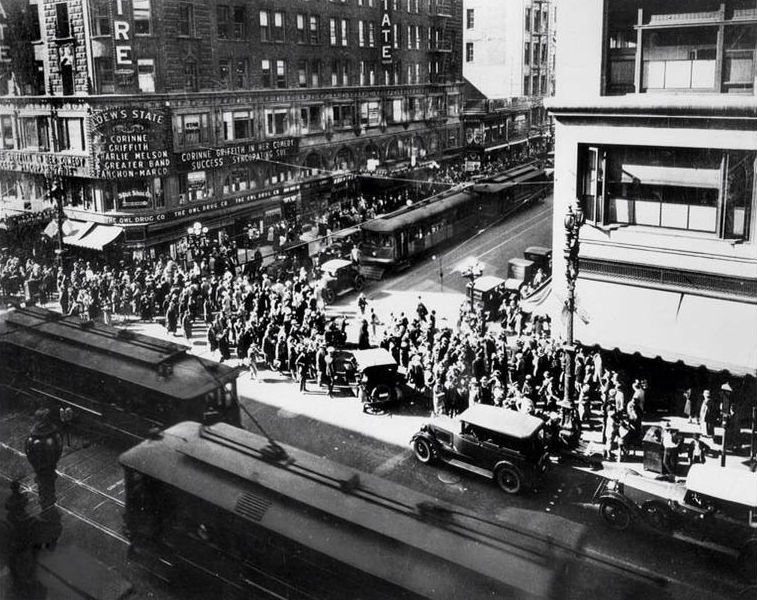 |
|
| (1926)^^*# - View looking southwest from above of Broadway and 7th Street, downtown's busiest intersection. The streets are filled with streetcars, cars, and people. Loew's State Theatre is playing "Syncopating Sue" starring Corinne Griffith. |
Historical Notes Loew's State Theatre was built as the west coast showcase for the product of the Loew's subsidiary Metro Pictures. The opening was on November 12, 1921 at one of downtown's busiest intersections, 7th and Broadway. Loew's State once used entrances on both streets. The 7th St. entrance was closed in 1936.^^*# |
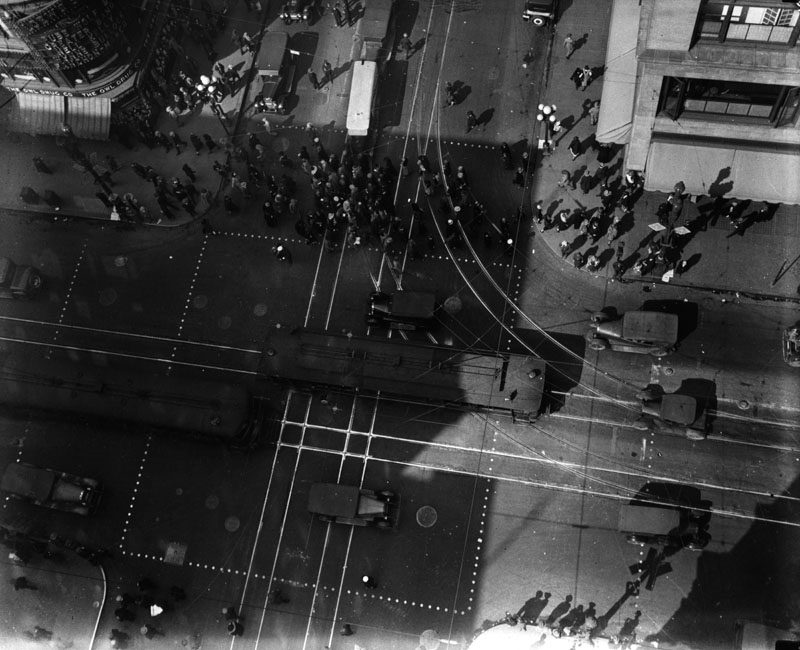 |
|
| (ca. 1926)^ - Birds-eye view over the intersection of 7th and Broadway. At the upper-left (S/W corner) is the Loew's State Theatre. Acroos the street at upper-right (N/W corner) is Bullock's Department Store. |
Historical Notes Seventh Street and Broadway was a busy junction for the Pacific Electric Railway, with southbound cars leaving on the San Diego Coast Route, stopping at Whittier, Santa Ana, Oceanside, and La Jolla. Westbound trains along Wilshire Boulevard head towards the Santa Monica Bay District and Beach Road North.*# |
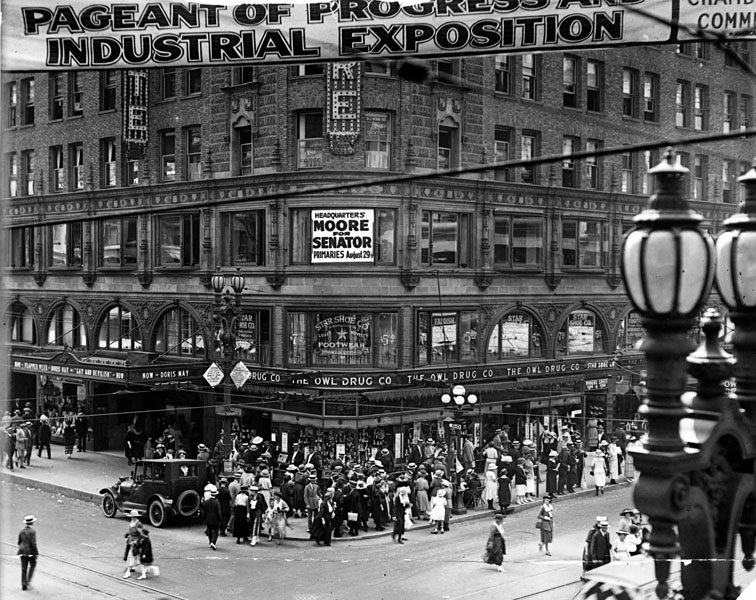 |
|
| (ca. 1926)^ - Exterior view of Loew's State Theatre building. The streets are crowded with pedestrians crossing and standing along the sidewalks. Marquee reads: Now- Flapper week-Doris May in "Gay and Devilish." Occupants of the building also includes a dentist, Headquarters for Moore for Senator campaign, Star Shoe Co. and the Owl Drug Co. |
Historical Notes In 1924 Marcus Loew engineered the merger of Metro with the Goldwyn Co. (which Sam Goldwyn had departed from in a 1922 power struggle) and the Louis B. Mayer group -- resulting in Metro-Goldwyn Pictures. By 1925, Mayer's name was also part of the company name, thus becoming MGM. MGM's prestige product was well suited to the type of theatres operated by the Loew's Corporation. Although at its height in the late 1920's, the circuit totaled only about 160 theatres, they were typically lavish first runs in major cities.^^*# |
 |
|
| (1926)^ - A view of Broadway looking north from the roofline above 7th Street. On the left, the large building is the Bullock's Dept. store. Beyond it is the Kress store. And on the lower right can be seen the sign for the Boos Bros. Cafeteria. Above that is a sign for the Palace Theatre. |
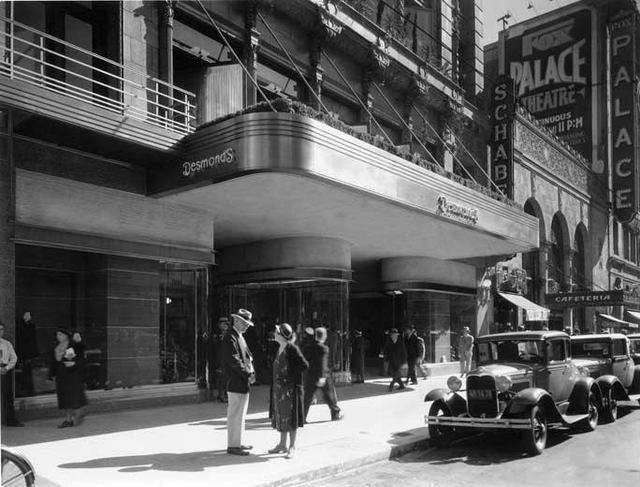 |
|
| (ca. 1929)**## – View looking south on the 600 block of Broadway showing three popular spots: Desmond’s Department Store, Schaber's Cafeteria, and the Palace Theatre with two Ford Model A’s parked in front. |
Historical Notes The first Desmond's Department Store was opened on Olvera Street in 1862. In 1921, Ralph R. Huesman purchased the store from the Desmond family and led the expansion of the retailer to several locations throughout the Southern California market. ^ |
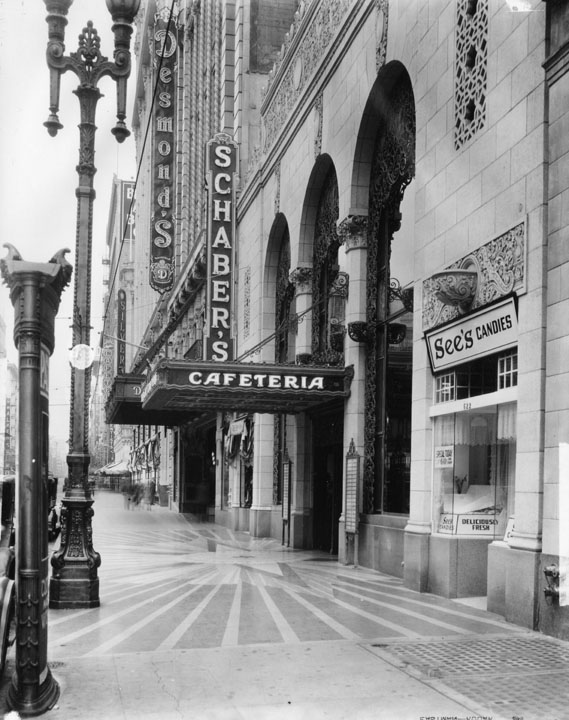 |
|
| (ca. 1928)* - View looking north showing the ornately detailed buildings on the 600 block of S. Broadway, including Schaber's Cafeteria, Desmond's, and See's Candies in the foreground. See's features chocolates at 60 cents a pound. |
Historical Notes Charles Alexander See II (1882–1949) arrived in the United States from Canada in 1921 with his wife Florence MacLean Wilson See (1885–1956), and his widowed mother Mary Wiseman See (1854–1939). Mary See had developed the recipes that became the foundation of the See's candy business while helping run her husband's hotel on Tremont Island in Ontario. The family opened the first See's Candies shop and kitchen at 135 North Western Avenue in Los Angeles in November 1921. They leased the shop from the French Canadian pioneer of Los Angeles Amable La Mer. They had twelve shops by the mid-1920s and thirty shops during the Great Depression. In 1936 See's opened a shop in San Francisco. In 1972 the See family sold the company to Berkshire Hathaway Inc. In 2007, Warren Buffett called See's "the prototype of a dream business". ^* |
* * * * * |
Broadway and 9th Street
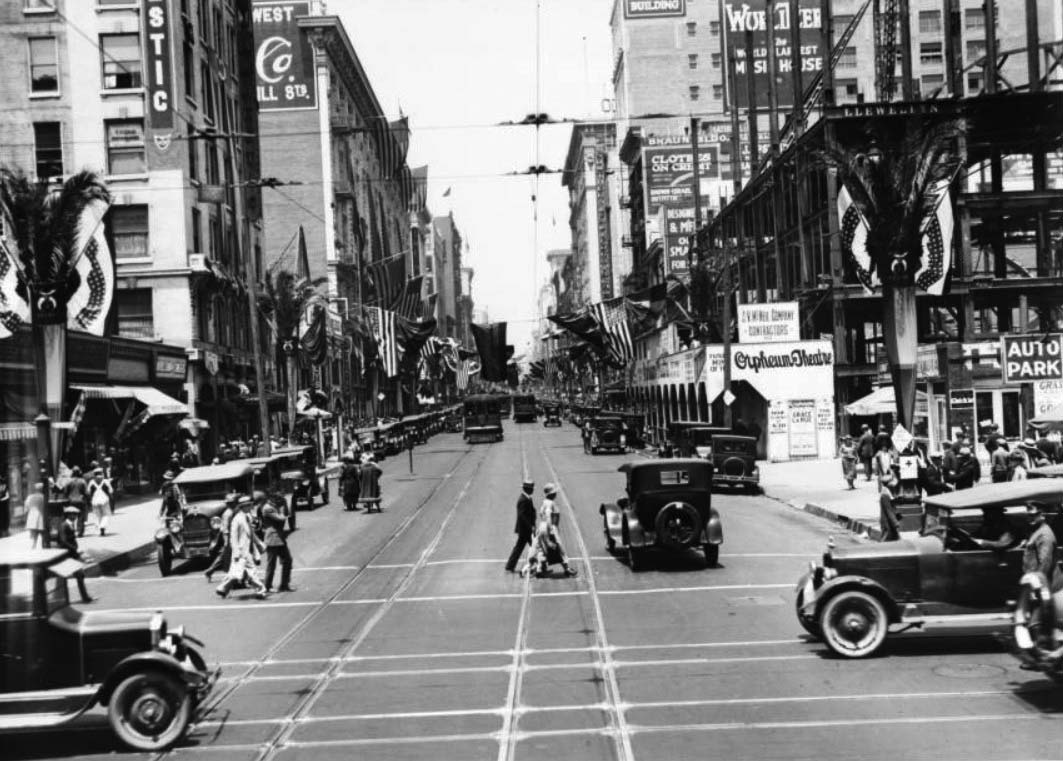 |
|
| (ca. 1925)* – View looking north on Broadway from 9th Street with the Majestic Theater seen at left. At right can be seen the construction of the Orpheum Theatre. |
Historical Notes The Orpheum Theatre at 842 S. Broadway opened on February 15, 1926 as the fourth and final Los Angeles venue for the Orpheum vaudeville circuit. Earlier Orpheum theatres in downtown Los Angeles included: ◆ 110 S. Main St. -- Grand Opera House was the home of Orpheum vaudeville from 1894 to 1903. ◆ 227 S. Spring St. -- The Los Angeles Theatre, later called The Lyceum, was known as the Orpheum from 1903 to 1911. ◆ 630 S. Broadway -- Now the Palace Theatre -- this was the Orpheum between 1911 and 1926. |
Then and Now
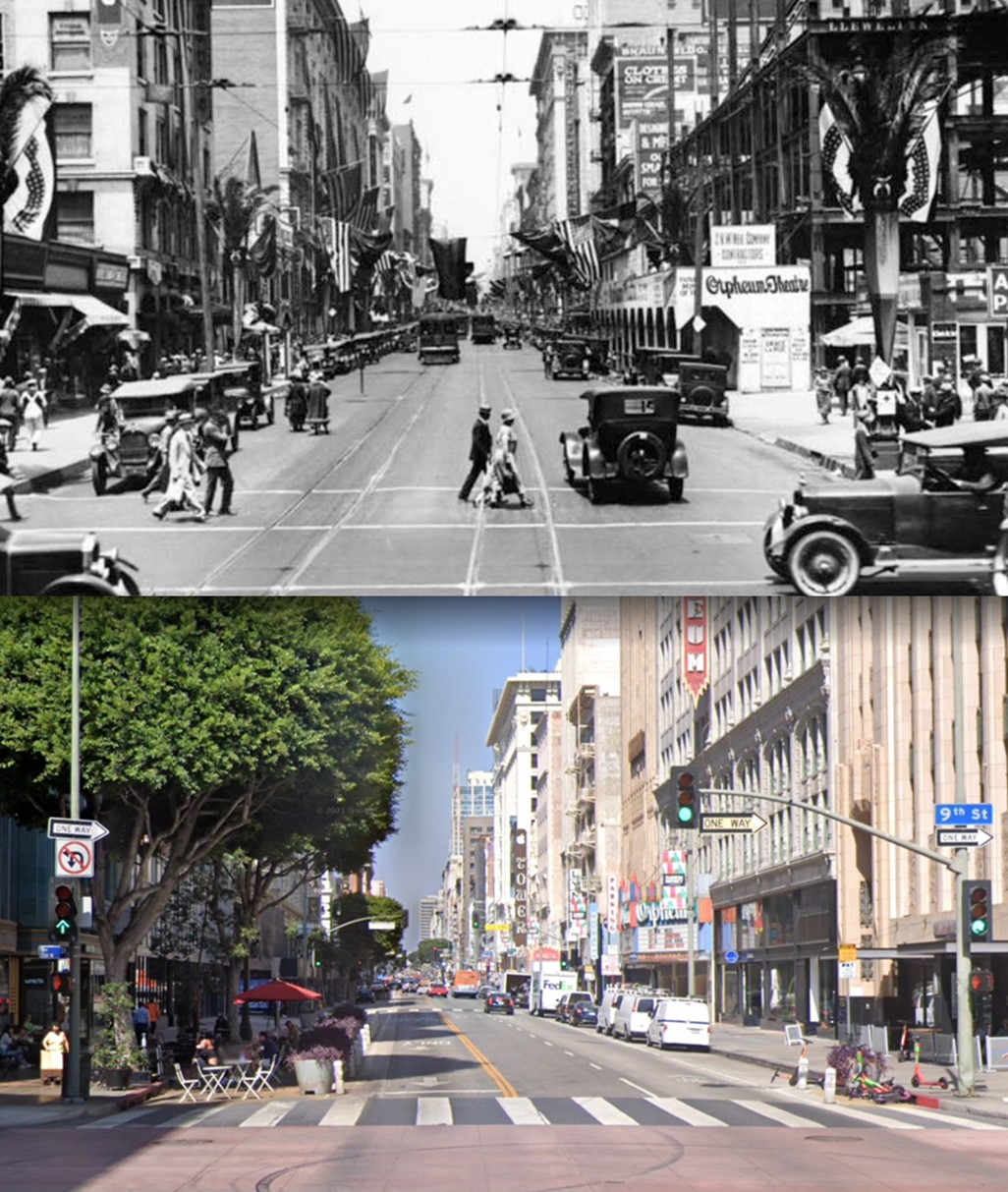 |
|
| (1925 vs. 2021)* - Broadway and 9th Street looking North. |
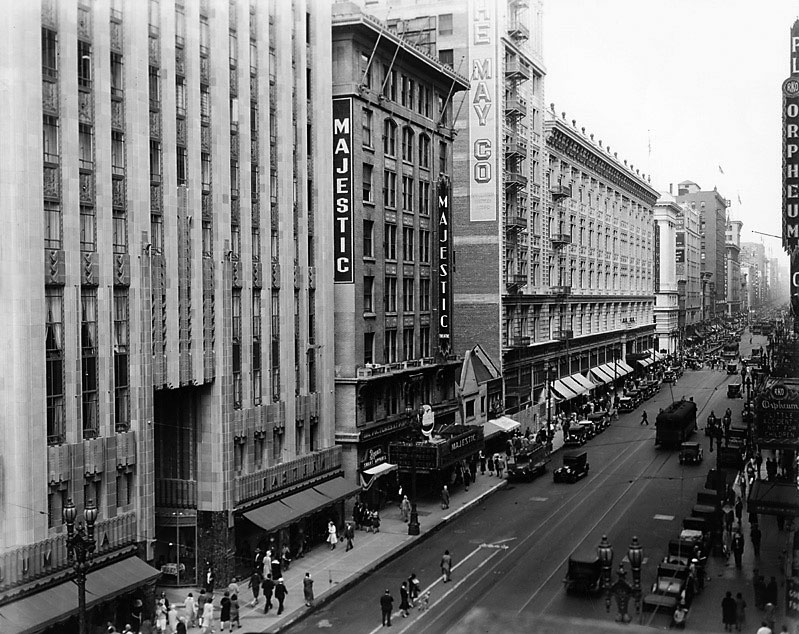 |
|
| (1930)^ – View of Broadway looking north from 9th Street showing The May Company (previously Hamburger's) on the SE corner at 8th Street. Note that Tally''s Broadway Theater is now gone. The May Company was still working on the storefronts of its addition on the Tally's site. The Majestic Theater is seen at center with the newly opened Eastern Columbia Building on the left. The Majestic is running "Top Speed" with Joe E. Brown. Acorss the street, the Orpheum Theatre is playing "Little Accident," with Douglas Fairbanks, Jr. and Anita Page. |
Historical Notes In 1933, the Majestic Theatre was demolished to make way for a parking lot, which eventually becoame the three-story garage that stands on the site today. Click HERE for contemporary view. |
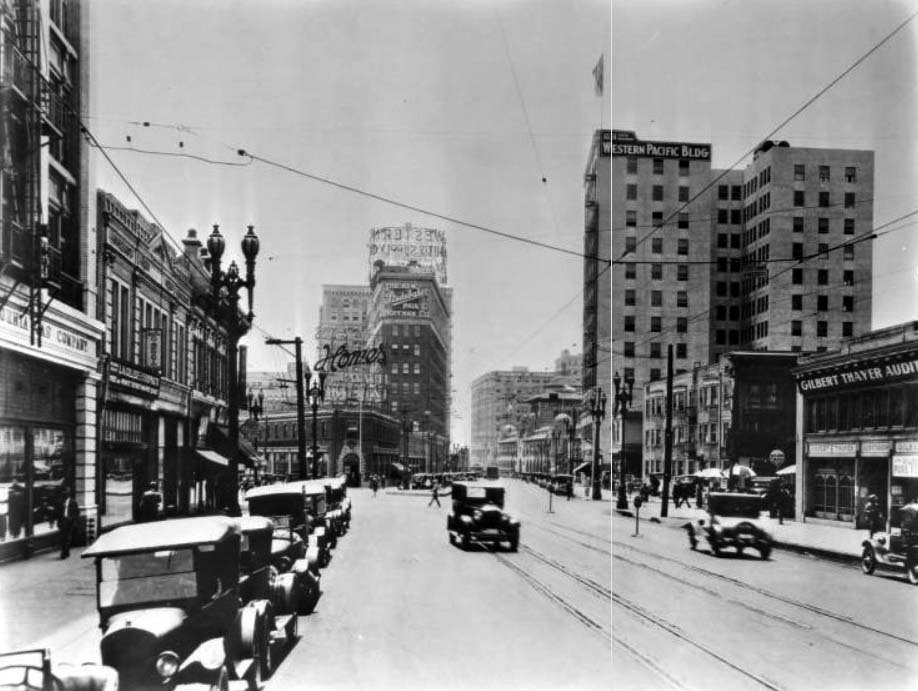 |
|
| (ca. 1926)* - View of Broadway looking south from 9th Street. To the right, the Western Pacific Building at 1031 South Broadway is visible above the shorter buildings in front of it, in which is included the Gilbert Thayer Auditorium. Legible signs include: "California Gas Co.", "The New Studebaker / Paul C. Hoffman Co.", "We Sell Homes [...]", "Rooms", "L.A. Chiropractic", "Chamber of Commerce", "Garage", "Auto Park 20¢", "Stop" and "Examine". |
Broadway and 10th Street (now Olympic Blvd)
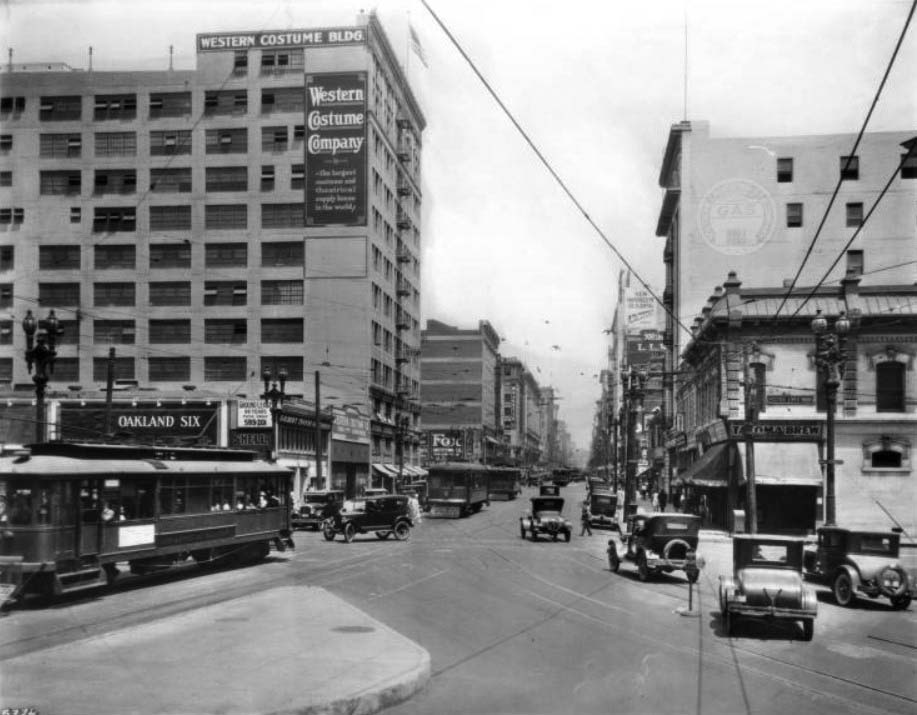 |
|
| (ca. 1926)* - View looking north on Broadway from 10th Street (now Olympic Blvd). At the left, the twelve-story Western Costume Company building stands towering above the rest of the scene, coupled with the Southern California Gas Company building across the street to the right. More high-rise buildings are visible in the background while automobiles and cable-cars make their way through the city, below. Legible signs include: "Oakland Six", "Ground Lease/ 99 years / Phone Owner 593-201", "Shell Gasoline", "Gilbert Thayer Auditorium", "Fox Outfitting Co.", "Tacoma Brew", "Hotel Lyle", "Blackstone's", "Majestic", "Stop", "L.A. Chiropractic", "Loew's State", "Southern California" and "New Orpheum Building / Joe Tru[...]sky Co. / Agent". |
Historical Notes Olympic Boulevard was originally named 10th Street. In 1932, the entire length of the street, from East L.A. to Santa Monica, was renamed Olympic Boulevard for the Summer Olympics being held in Los Angeles that year.^* Click HERE to see the same view in 1890. Click HERE to see the same view in 2015. |
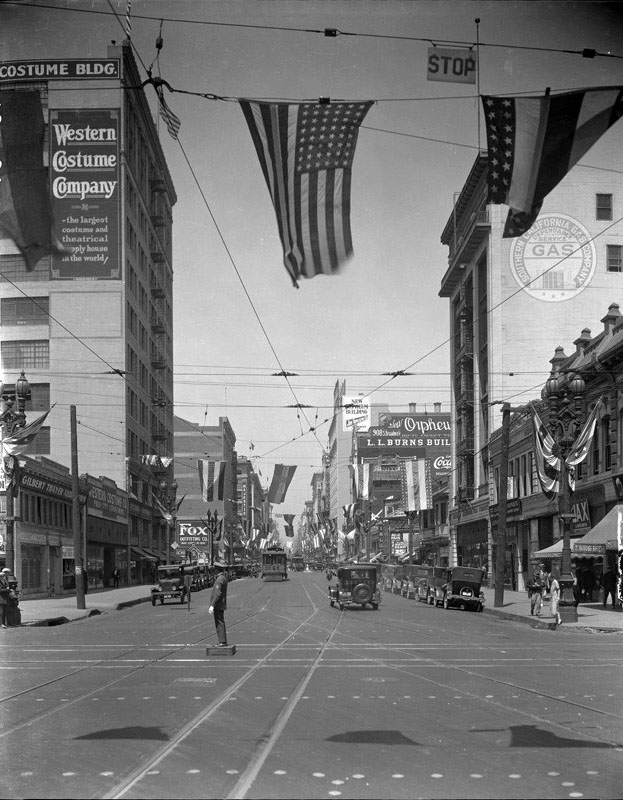 |
|
| (ca. 1926)* – View looking north on Broadway at 10th Street. A Policeman on a box directs traffic. Buildings include (l to r): Gilbert Thayer Auditorium, Western Costume Co., Majestic, Orpheum Theatre (1926), Southern California Gas Co. |
Historical Notes The above photo was taken prior to the construction of the United Artists Theater Building, built in 1927 just north of the Western Costume Co. Building. (see next photo) |
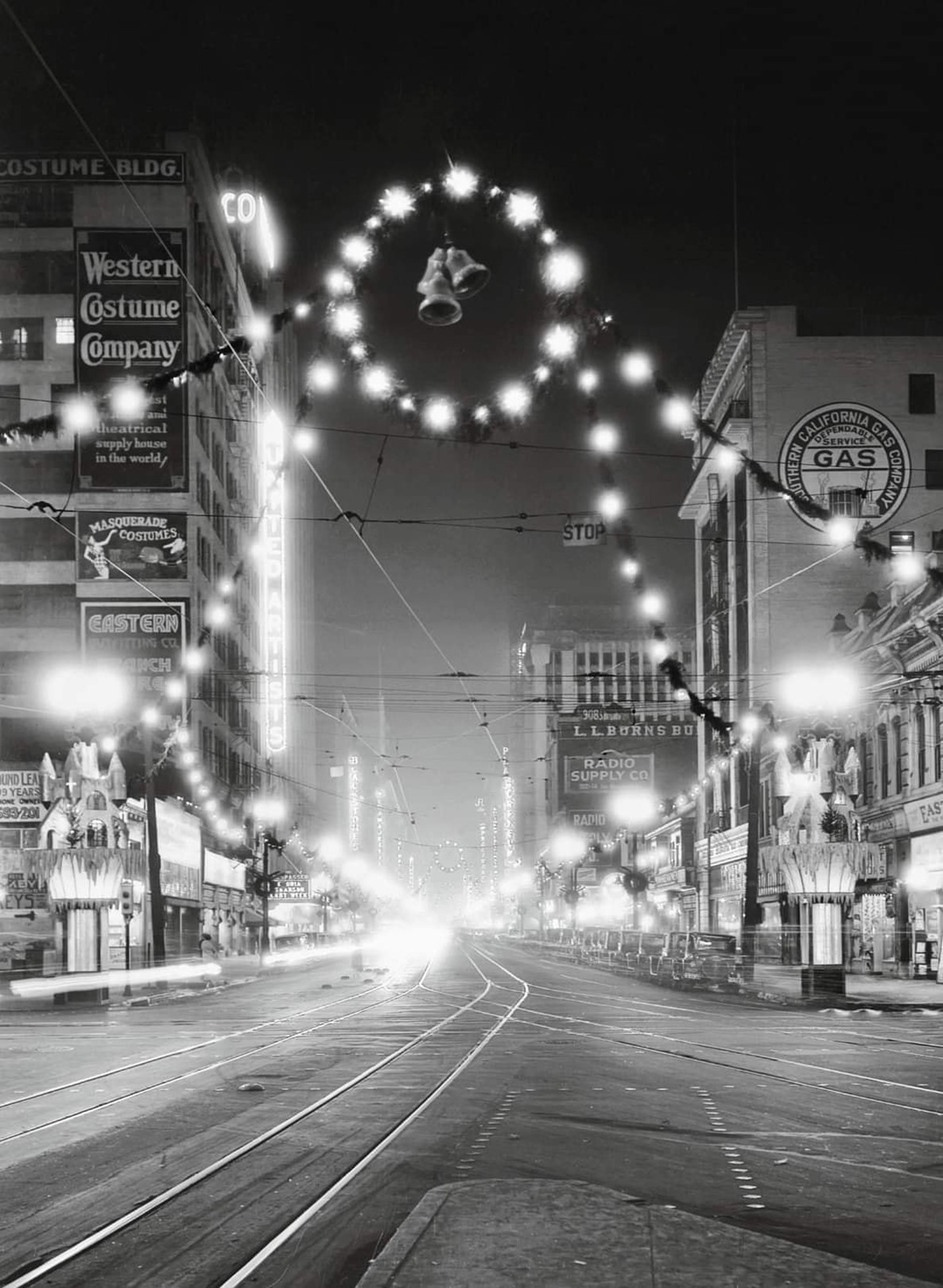 |
|
| (ca. 1929)* - View of Broadway looking north from 10th Street (Olympic Blvd) during Christmas. Note the new United Artists Theater Building (built in 1927) behind the Western Costume Building. |
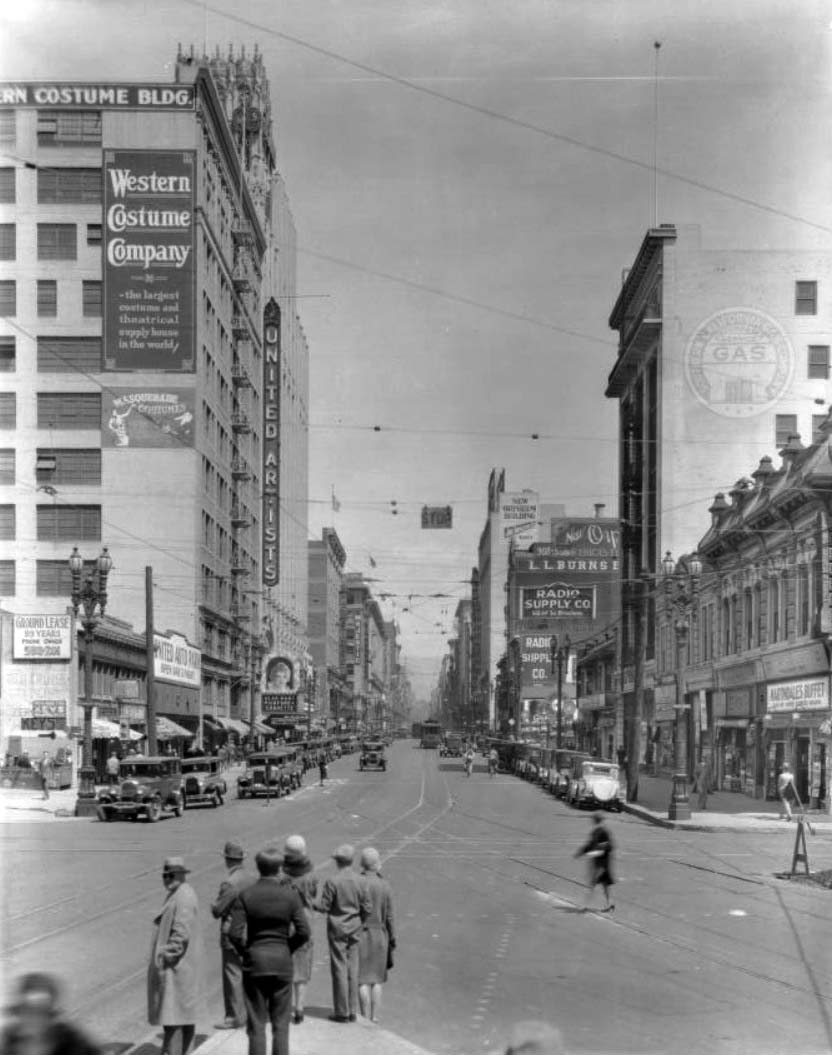 |
|
| (ca. 1929)* - View of Broadway looking north from 10th Street (Olympic Blvd). Several people stand waiting in the foreground for the trolley car that is making its way to them from the distance. The United Artists Theater Building (built in 1927) can be seen at center-left. |
 |
|
| (1928)^ – Looking south on Broadway at 10th Street showing a woman standing on the safety island. Broadway Place is just visible on the left with 10th Street (now Olympic Boulevard) crossing behind the camera. The beautiful Los Angeles Examiner Building is seen down Broadway on the right. |
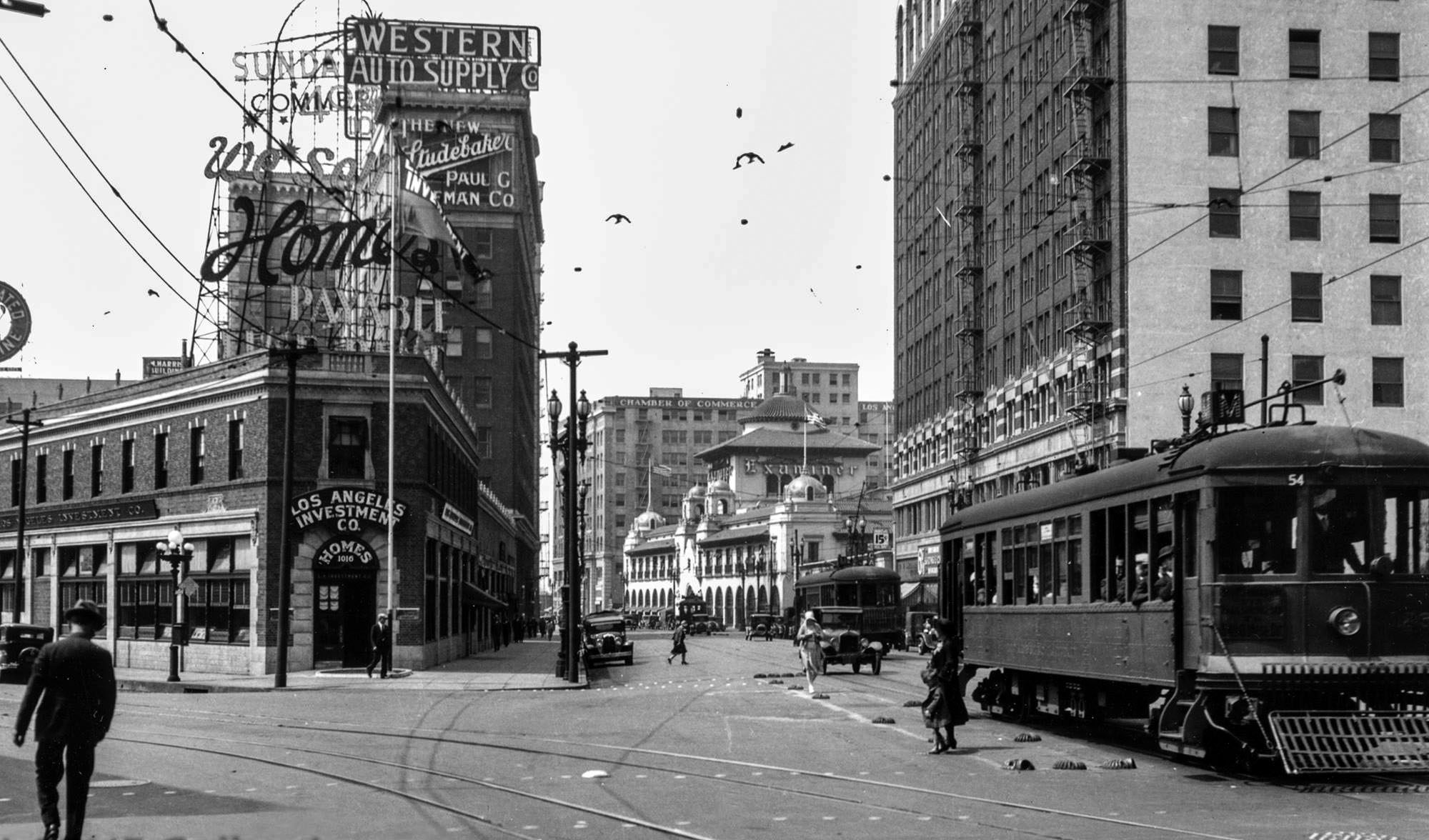 |
|
| (ca. 1926)+ - View looking south on Broadway showing two streetcars of the LA Railway's "M Line" with the Examiner Building in the background on the S/W corner of Broadway and 11th Street. Further back is the Chamber of Commerce Building on the N/W corner of Broadway and 12th Street. The Los Angeles Investment Co. and Western Auto Supply are at left, followed by the Paul G Hoffman Studebaker sales office. |
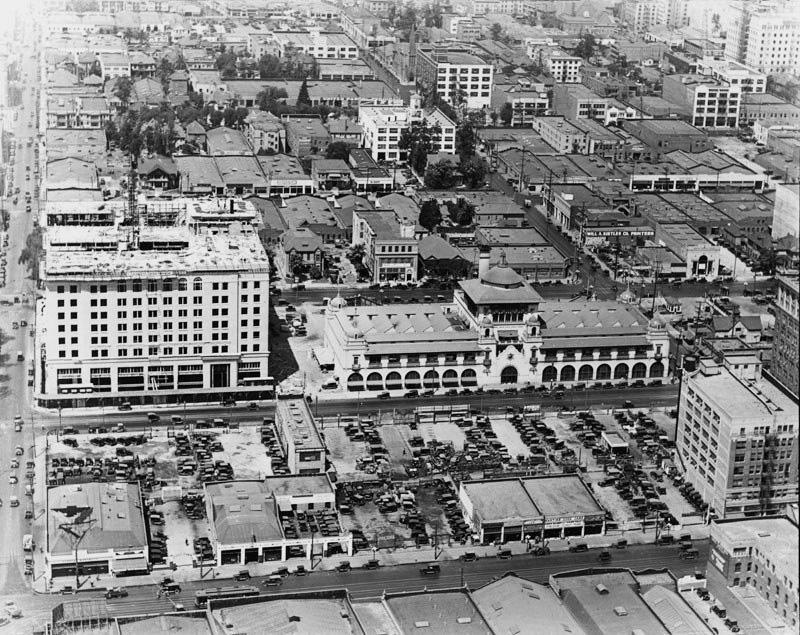 |
|
| (ca. 1926)^ - Aerial view showing the Chamber of Commerce Building and the Los Angeles Examiner Building located on the west side of Broadway between 11th and 12th streets. |
Then and Now
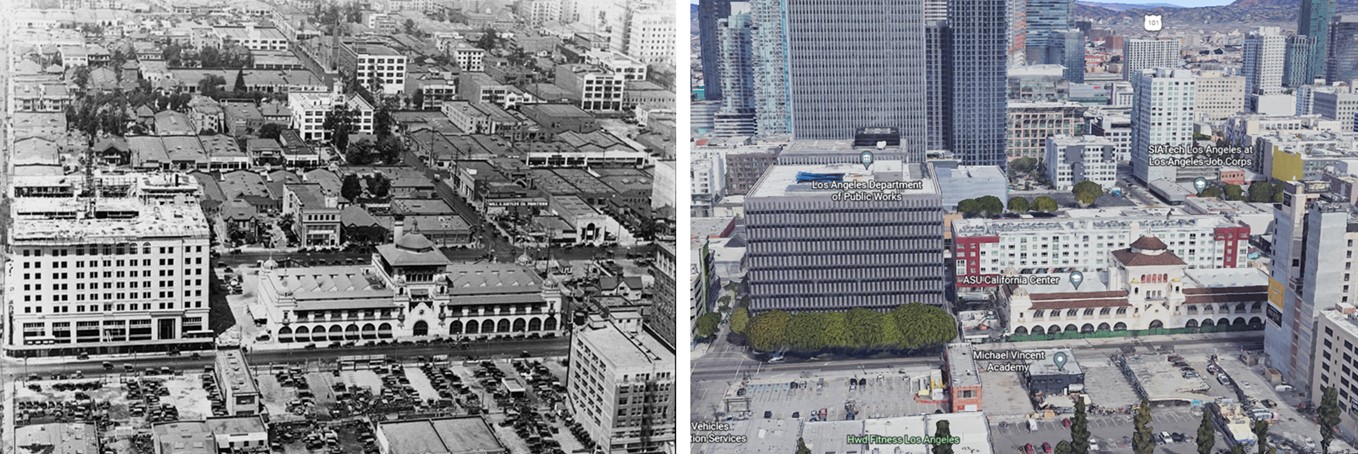 |
|
| (1926 vs. 2020) – Aerial view looking west from above Broadway between 11th and 12th streets. |
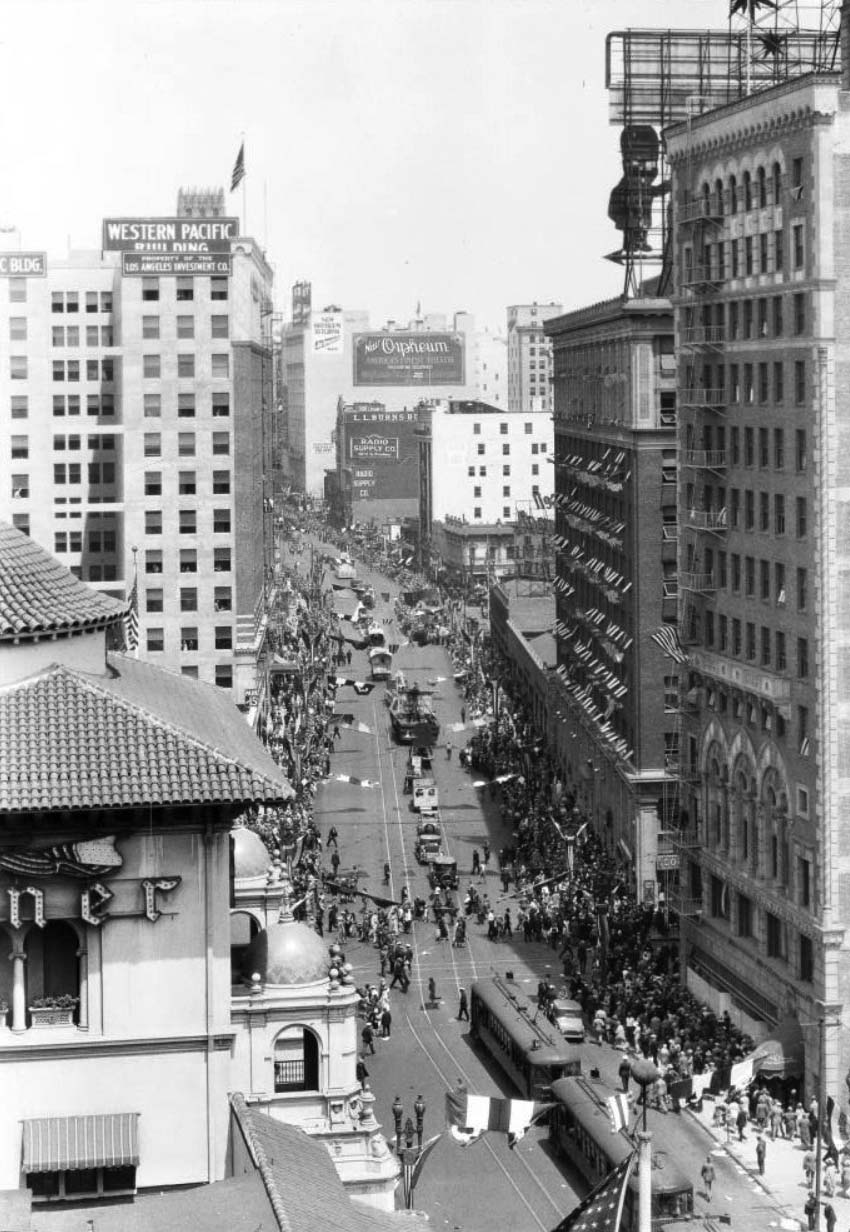 |
|
| (1928)* - View looking north on Broadway toward 11th Street over the Los Angeles Examiner Building as seen from the Chamber of Commerce building. A parade celebrating the dedication of the new City Hall can be seen on the street below, including onlookers, floats, flags, automobiles, and trolley cars. Multiple-storied buildings with rectangular windows line the street. Visible signs on the buildings include, "Western Pacific Building", "Property of the Los Angeles Investment Co", "New Orpheum Building", "New Orpheum America's Finest Theatre Presenting Exclusively [?]", "908 S. Broadway L.L. Burns [?]", "Radio Supply Co. 912-14 So. Broadway", and "Southern California Gas Company". |
Figueroa St. and Adams Blvd.
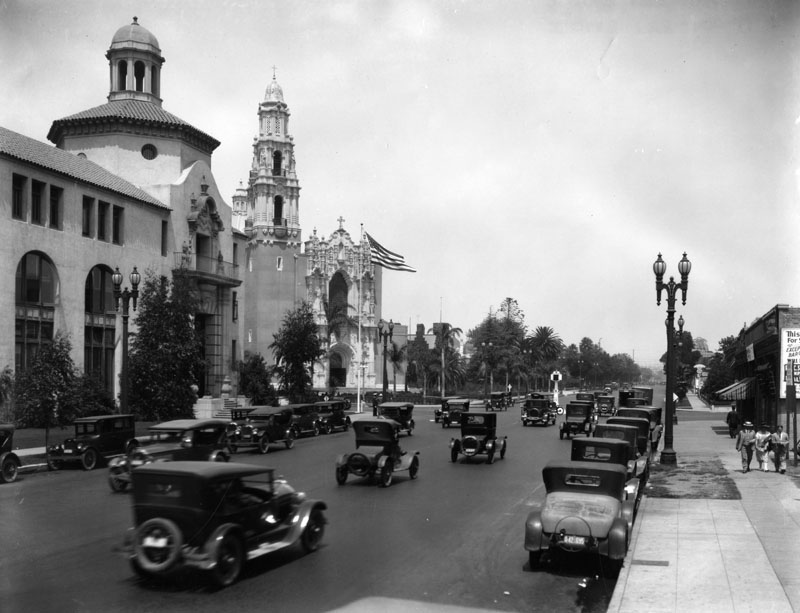 |
|
| (1926)^ - Figueroa Street looking northwest toward West Adams Boulevard. On the left is the Automobile Club of Southern California and St. Vincent Catholic Church. |
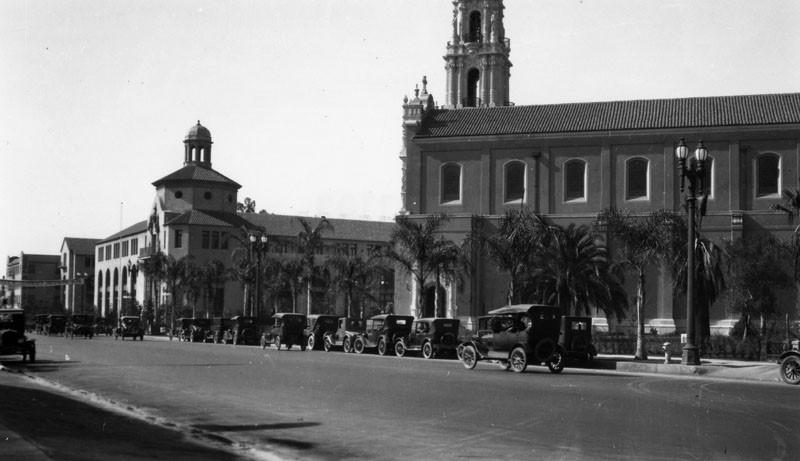 |
|
| (ca. 1926)^ - View looking south on Figueroa St. toward West Adams Blvd. The Automobile Club is on the left and St. Vincent Church is to the right. |
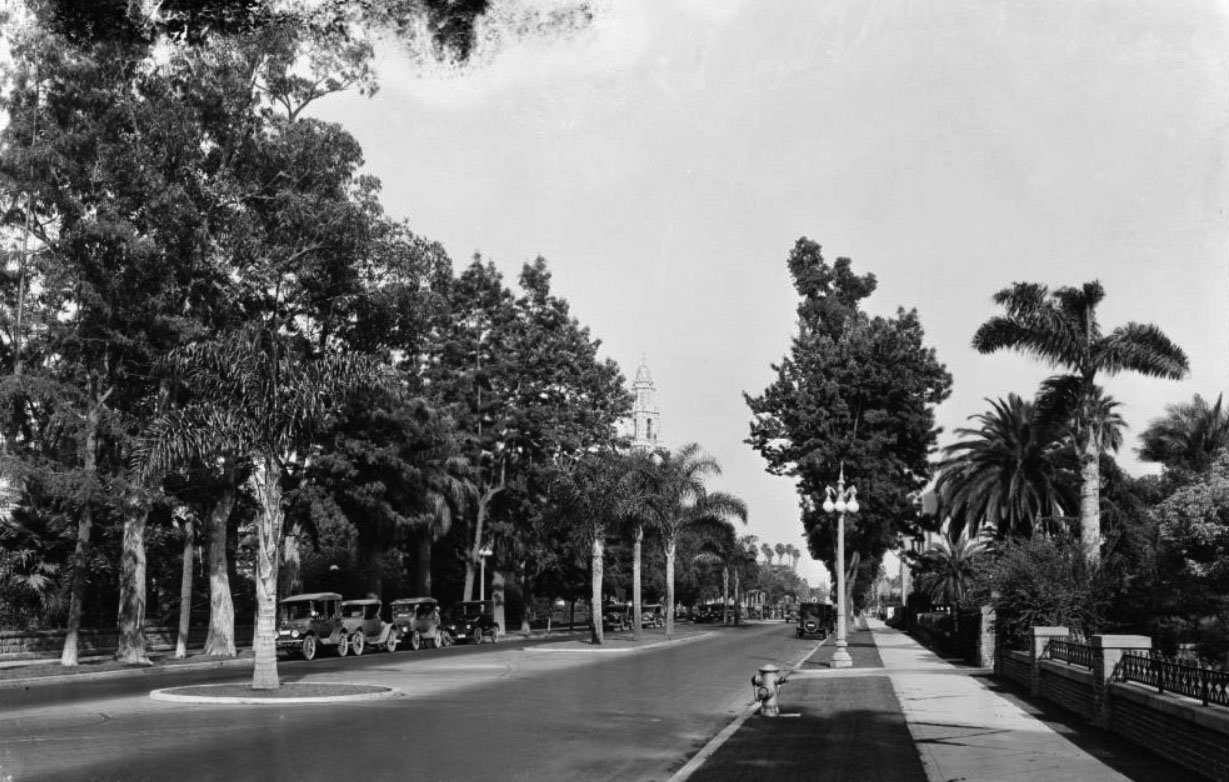 |
|
| (ca. 1926)*# – View looking east on Adams Boulevard toward Figueroa Street. Palm trees line the center median with the St. Vincent Catholic Church bell tower can be seen in the distance above the trees. Note the ornate multi-globe street light (Llewellyn "Chester" Lamps). |
Historical Notes Called Llewellyn “Chester” lamps, these six-globe streetlights were installed in the West Adams district beginning in 1903 (Named for Chester Place, one of the first gated communities in Los Angeles). Click HERE to see more. |
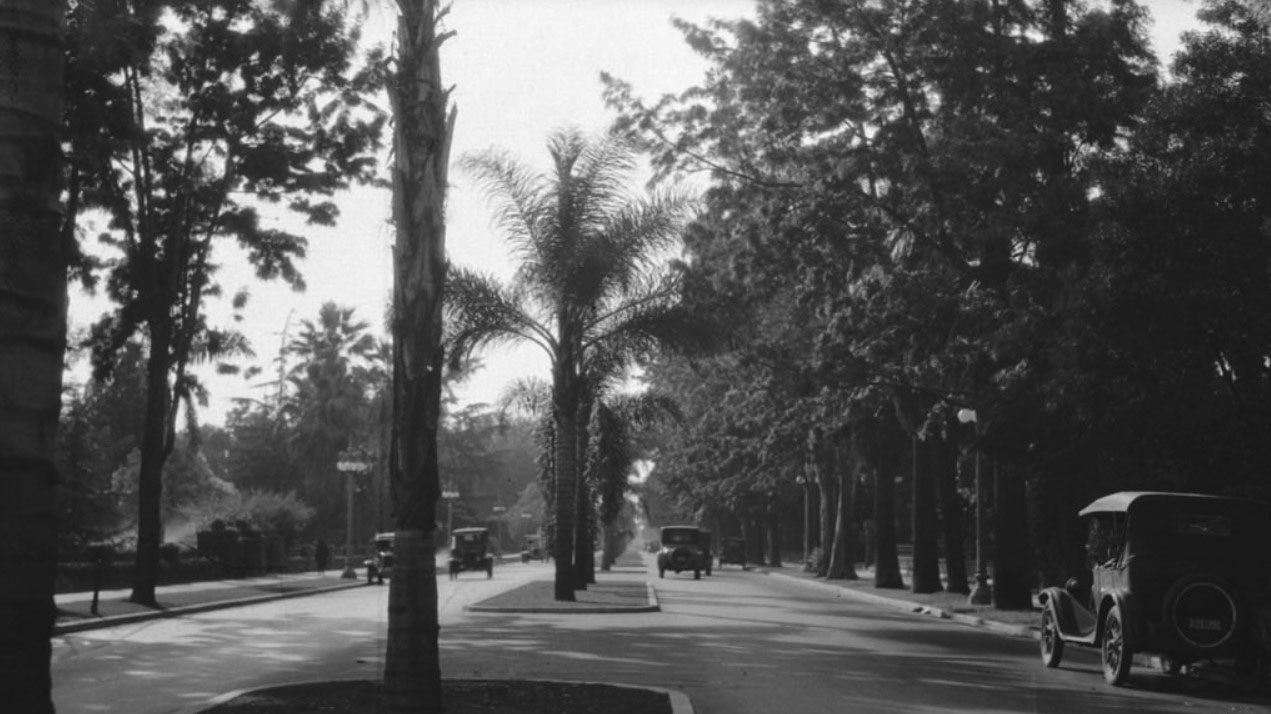 |
|
| (1926)^# – View looking down Adams Boulevard west of Figueroa Street showing palm trees lining the center median. |
Historical Notes Click HERE to see more views of Adams and Figueroa. |
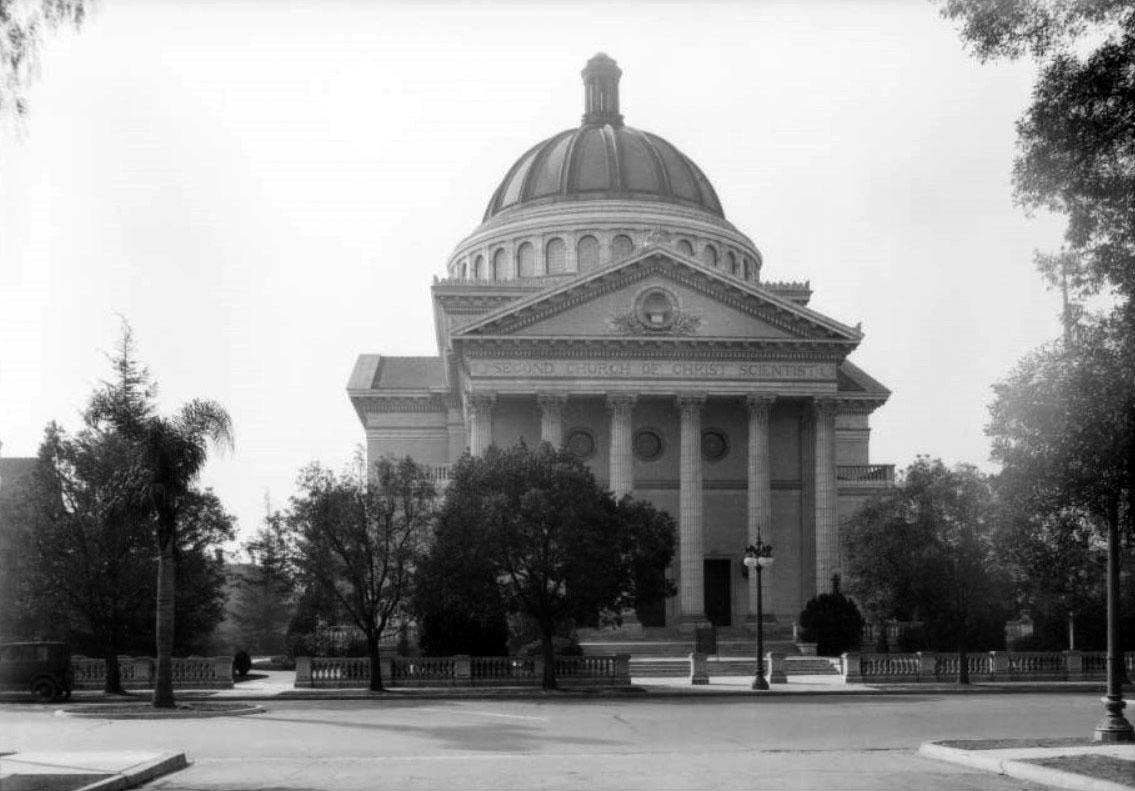 |
|
| (ca. 1928)*^ - View looking south on Portland Street toward Adams Boulevard. A six-globe streetlight stands in front of The Second Church of Christ Scientist (today the Art of Living Foundation) at 946 W. Adams Blvd. |
Historical Notes Built in 1910, the Beaux Arts/Italian-Renaissance style building was designed by Alfred Rosenheim (who also designed the Cameo Theater in 1910 and the Globe Theater in 1913, both on Broadway in downtown Los Angeles. Rosenheim is also responsible for other Los Angeles landmarks, including the nearby Britt Residence, Hamburger’s Department Store, Clune’s Broadway Theatre Building, and the Hellman Building, all of which are LA Historic-Cultural Monuments. |
* * * * * |
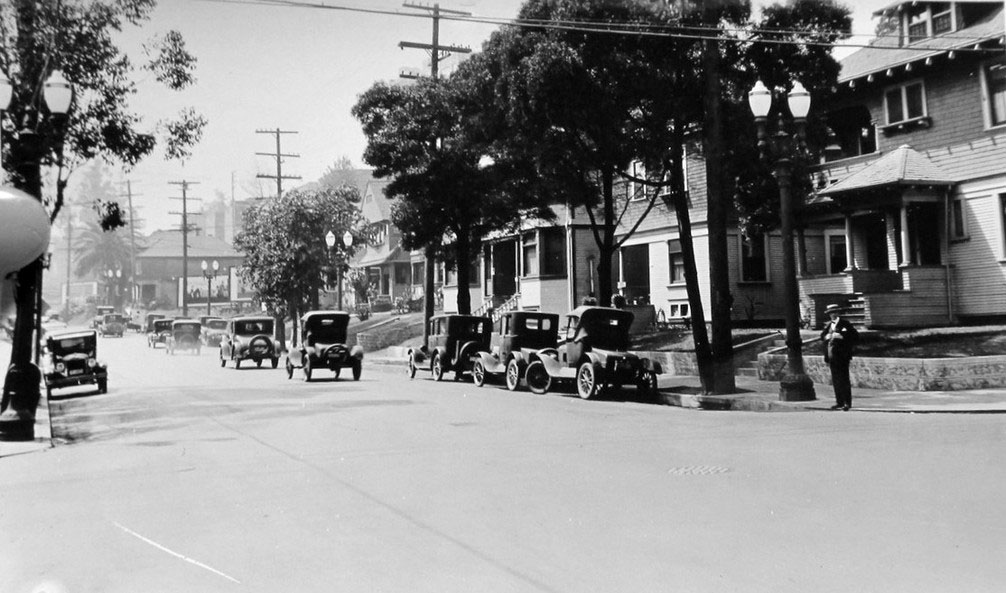 |
|
| (1926)**^ - View looking west on 8th Street at Francisco St. |
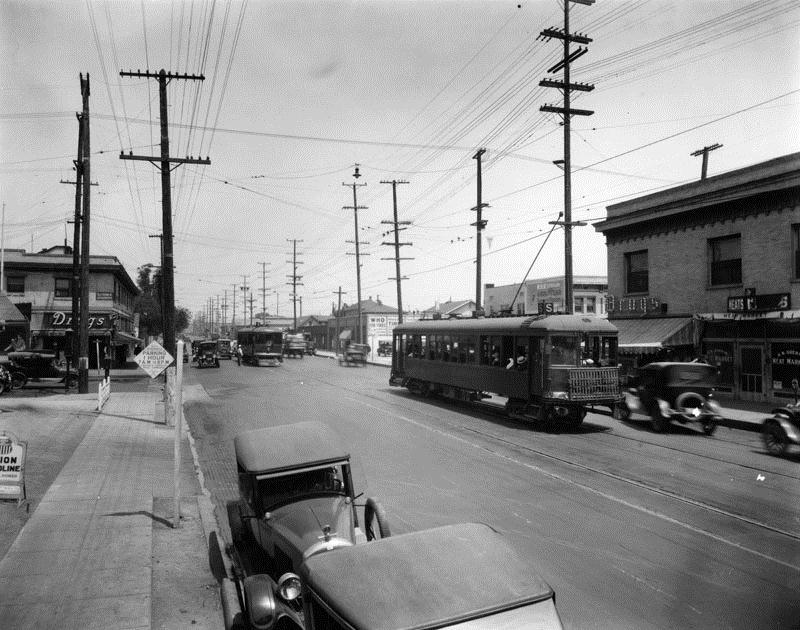 |
|
| (ca. 1926)^ - View of San Pedro Street, looking north from Washington Boulevard. Streetcars are running in both directions. |
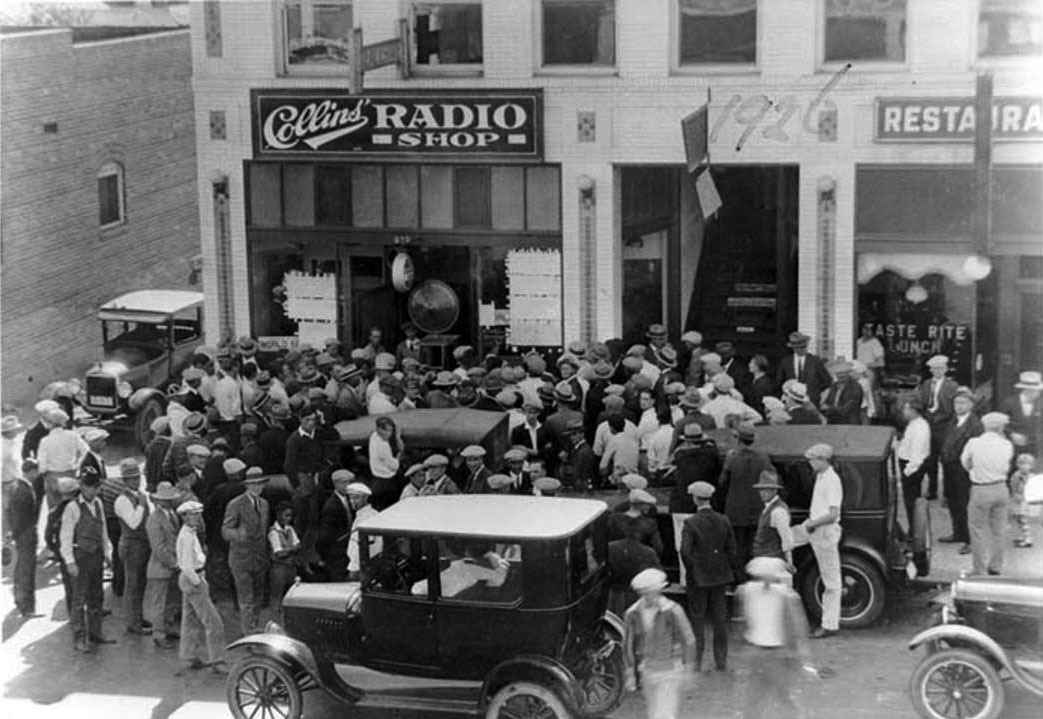 |
|
| (1926)*^ - A crowd of listeners outside Collins' Radio Shop at 223 South San Fernando Blvd in 1926, listening to the World Series. |
Historical Notes The 1926 World Series pitted the NL champion St. Louis Cardinals against the AL champion New York Yankees. The Cardinals defeated the Yankees four games to three in the best-of-seven series. This was the first World Series appearance for the Cardinals, the first of eleven World Series championships in Cardinals history, while the Yanks were in their fourth World Series in six years, winning one for the first time in 1923. They would play in another 36 World Series through the end of the 2013 season. |
* * * * * |
San Fernando Valley - Van Nuys
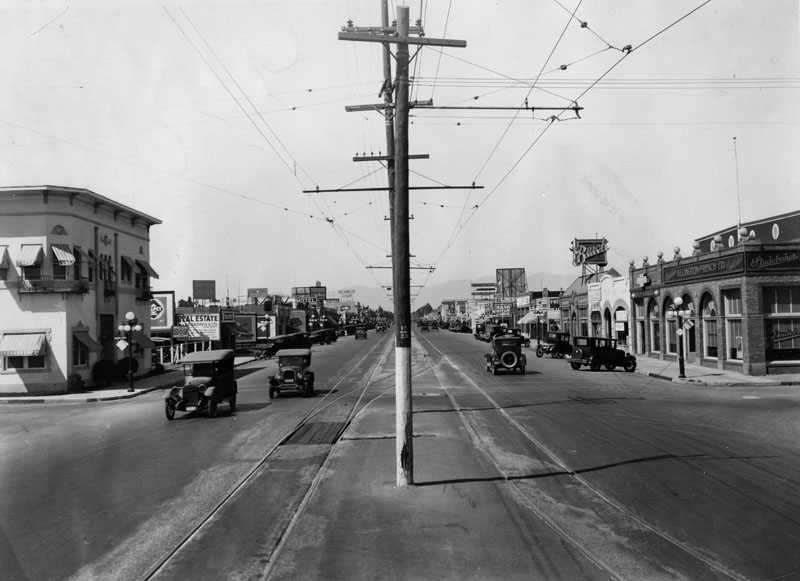 |
|
| (1927)* - Looking north on Van Nuys Boulevard from near Calvert Street. Utility poles rise in the center median, flanked by automobile lanes and embedded streetcar rails. Small commercial buildings line both sides of the boulevard, with diagonal street parking. Visible signage includes automobile dealerships (Studebaker, Buick, Nash, Ford), a cigar and soda shop, a real-estate office, and a hotel. |
Historical Notes In 1927, Van Nuys Boulevard still carried streetcar rails in its median, a reminder of the early electric transit era in the San Fernando Valley. As the boulevard developed, automobile traffic and angled parking became more common, and many of the small commercial storefronts reflect the rapid growth of the Valley’s suburbs at the time. The poles running down the center carried overhead trolley wires that supplied electricity to the streetcars operating along Van Nuys Boulevard. |
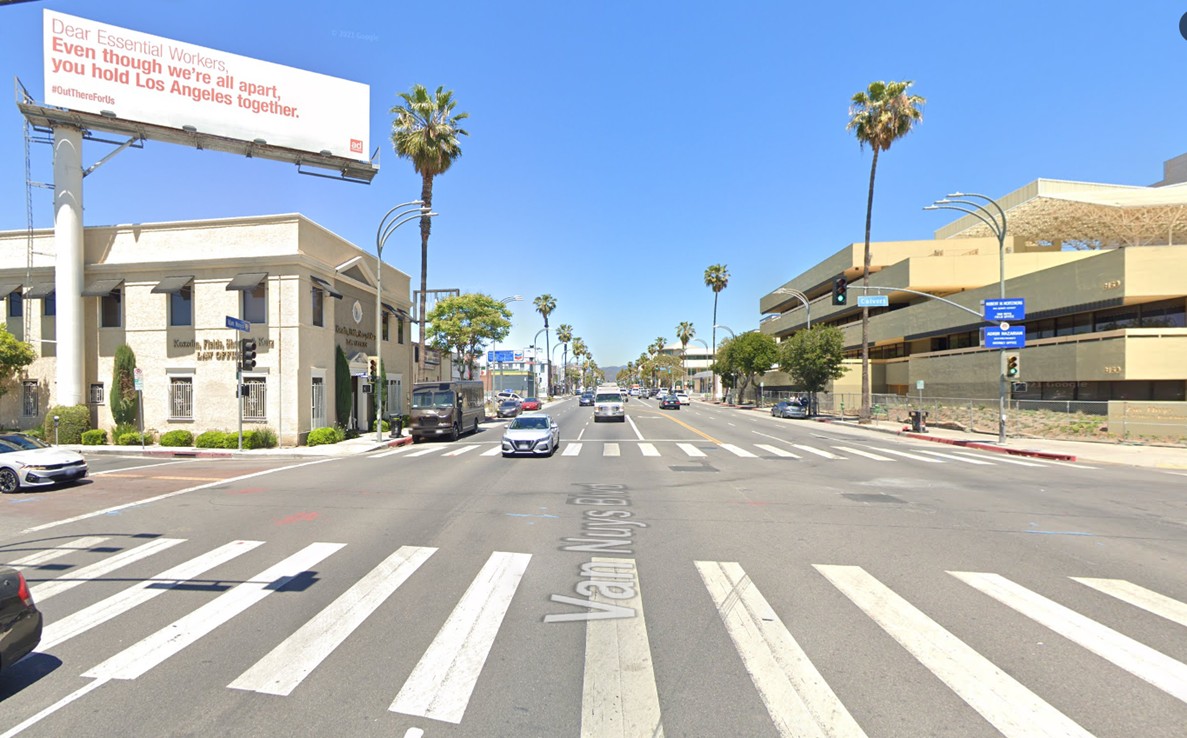 |
|
| (2021)* – Looking north on Van Nuys Boulevard at Calvert Street. A surviving commercial building on the northwest corner remains in use, although it has been modified since the original photo. |
Historical Notes Nearly a century after the 1927 view, the street has evolved dramatically. The streetcar rails are long gone, and the median is now dedicated to vehicular lanes and modern traffic flow. The remaining corner building serves as a physical link to the boulevard’s early commercial era amid more contemporary architecture and heavier traffic volumes. |
Then and Now
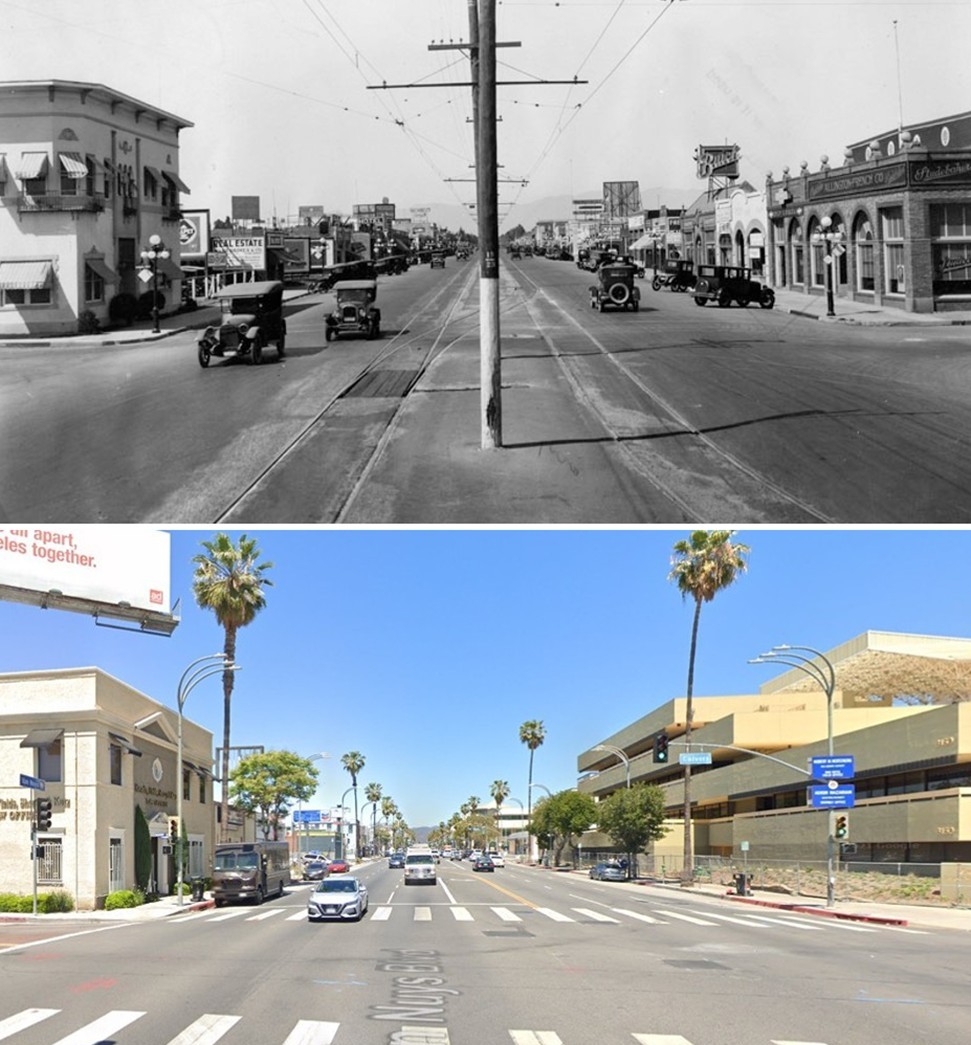 |
|
| (1927 vs 2021)* – Then-and-now comparison of Van Nuys Boulevard looking north at Calvert Street. Note the central utility poles and streetcar tracks in the earlier view, and the surviving northwest-corner building. Photo comparison by Jack Feldman. |
Historical Notes These two views show how one street can reflect nearly a century of change. The 1927 photograph captures the tail end of streetcar service in the Valley, while the 2021 photo highlights how automobile-dominated boulevards replaced dedicated transit rails. The tall poles that once lined the center carried overhead wires powering Pacific Electric streetcars. The fact that a corner building still stands offers a tangible connection across time. |
 |
|
| (1926)* - Looking north on Van Nuys Boulevard showing the Van Nuys Hotel (left-center) on the west side of the street, near the northwest corner of Van Nuys Boulevard and Delano Street. Streetcar tracks and overhead wires run down the center of this wide thoroughfare. |
Historical Notes The Van Nuys Hotel, visible here, served as a landmark in its era, located at a key intersection in the growing town of Van Nuys. At the time this photo was taken, the street’s width and its transit infrastructure underscore how the boulevard was conceived as a major civic and commercial axis, not just a residential street. The tall poles in the center supported the streetcar’s electric lines, which powered the Pacific Electric cars serving the Valley during this period. |
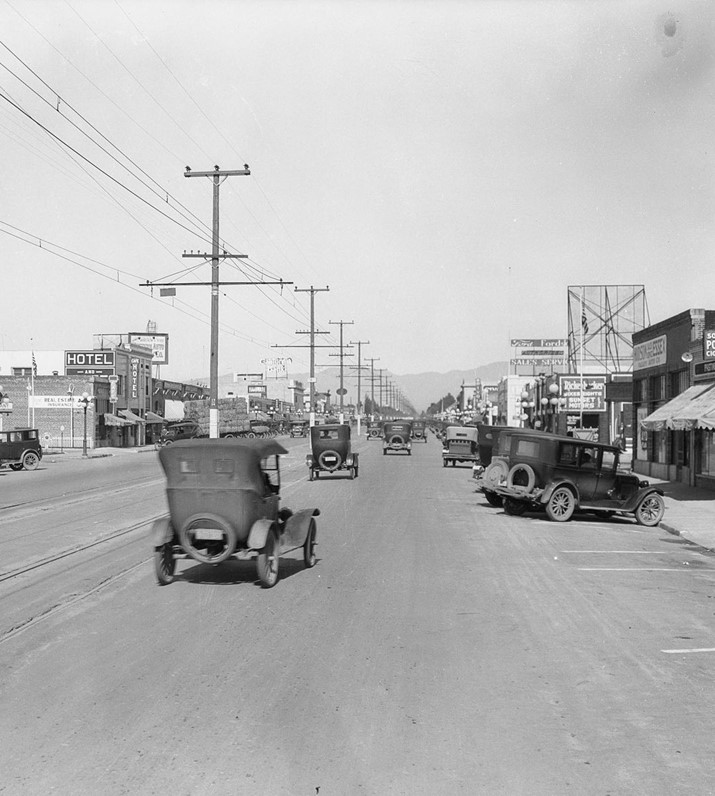 |
|
| (1926)* - Looking north on Van Nuys Boulevard at the Van Nuys Hotel (west side of street, left-center). The hotel stands amid early commercial development, with power lines and streetcar tracks visible down the boulevard’s median. |
Historical Notes While many of the buildings that lined Van Nuys Boulevard in the mid-1920s have since been demolished or heavily altered, the Van Nuys Hotel building (6211 Van Nuys Blvd) remains — a rare surviving piece of that early era of development. This image helps illustrate the transition from small-town fields to a boulevard defined by transit, commerce, and lodging. |
Then and Now
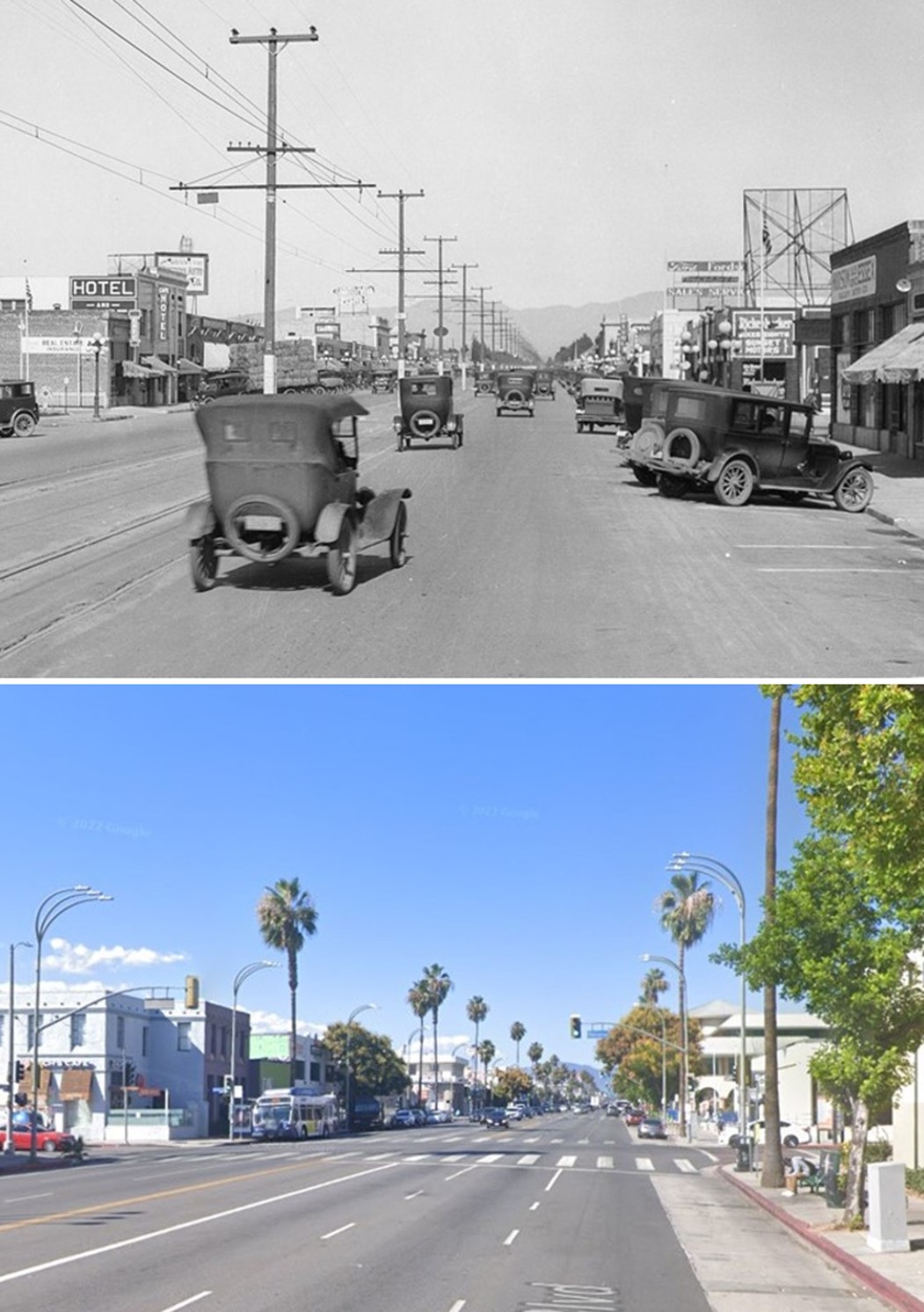 |
|
| (1926 vs. 2022)*- Then-and-now view of Van Nuys Boulevard looking north at the Van Nuys Hotel (west side, left-center) near Delano Street. The older photo shows the hotel amid early development; the modern view shows the greatly altered streetscape. Click HERE to see more of the Van Nuys Hotel. Photo comparison by Jack Feldman. |
Historical Notes This comparison emphasizes the change from a transit-oriented boulevard—complete with streetcar tracks, overhead wires, and center-line poles—to a roadway shaped by the automobile. Those poles once supplied electric power to the Pacific Electric cars serving Van Nuys. The survival of the hotel building offers one of the few anchors to the 1920s streetscape, reminding viewers of the layered history beneath the modern façade. |
Click HERE to see more in Early Views of the San Fernando Valley |
* * * * * |
Flooding in Early Los Angeles
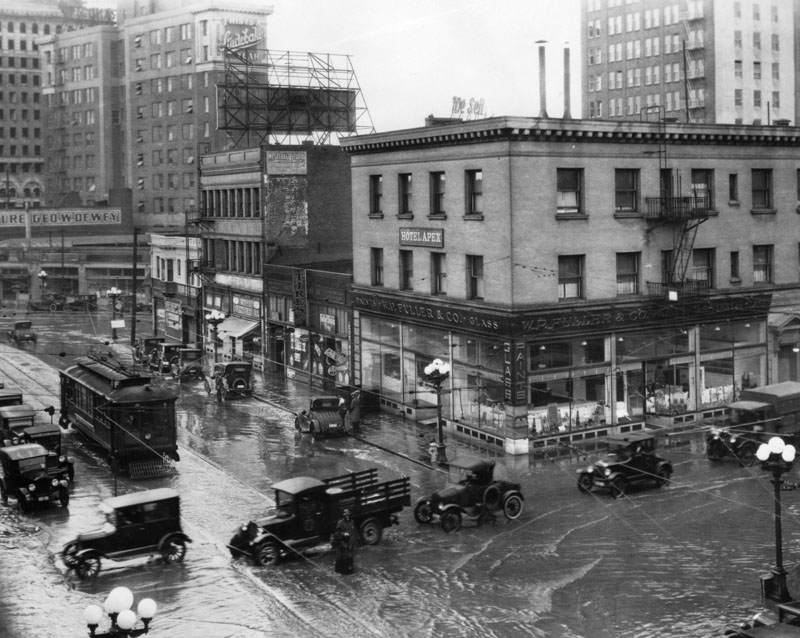 |
|
| (1925)* - A wet policeman directs traffic through one of downtown’s most chronically flooded intersections, Main and 10th Streets. He is dressed in full rain gear. The Hotel Apex is on the corner, along with W. P. Fuller & Co., paints and glass. |
Historical Notes Despite being in the heart of the business district, Main and 10th was notorious for poor drainage—heavy rains routinely turned this low intersection into a shallow lake. Before the city built a modern storm-drain network, runoff followed the natural contours of the land, pooling in streetcar-era intersections like this one for hours after storms. Scenes like this contributed to the push for stronger flood-control planning as auto traffic increased in the late 1920s. |
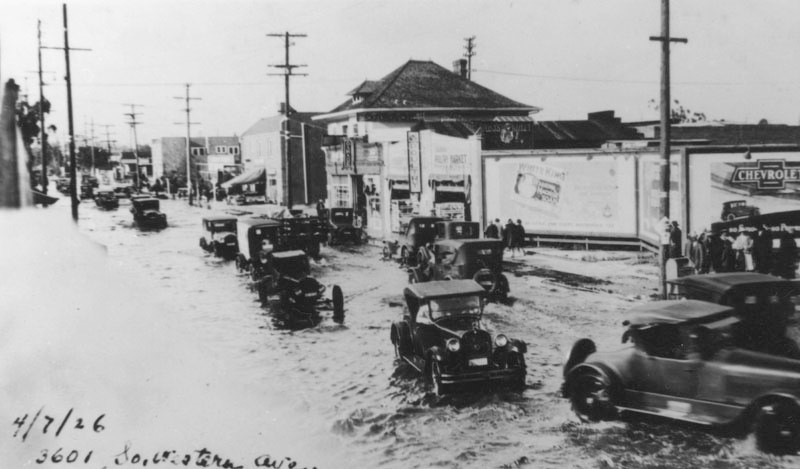 |
|
| (1926)* - View of South Western Avenue during the April 7, 1926 flood, a typical sight along major thoroughfares before the city installed adequate storm drains. |
Historical Notes The April 1926 storms were among the wettest late-season events recorded, bringing widespread flooding from downtown to the newly expanding residential districts. Western Avenue, though paved, still lacked proper drainage, so water flowed freely across the roadway, forcing cars and streetcars to navigate slowly through the floodwater. Although the Los Angeles County Flood Control District had been established in 1915, many areas remained vulnerable for decades as the region struggled to keep drainage infrastructure ahead of rapid growth. |
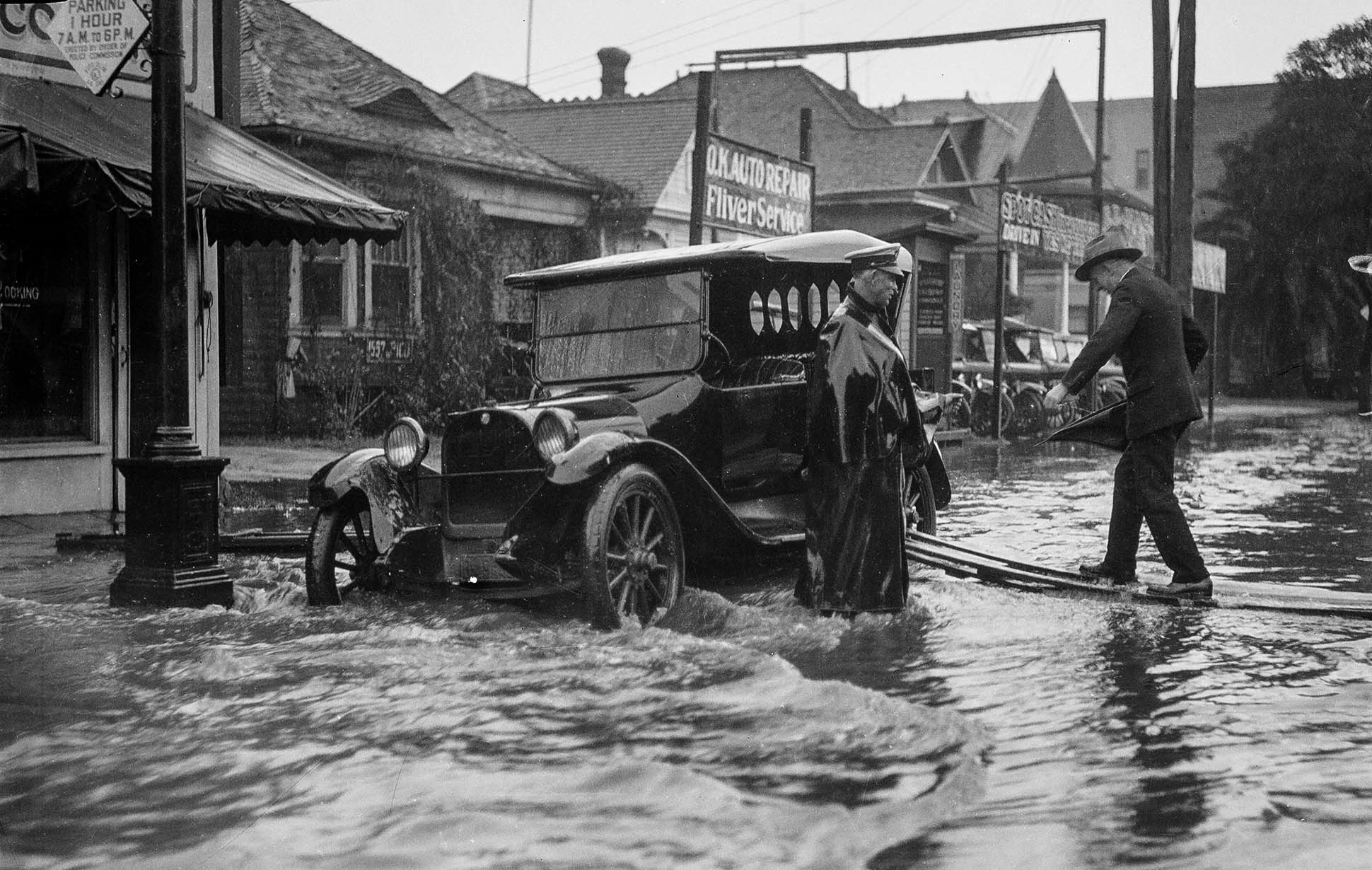 |
|
| (1926)* – A man is assisted back to his vehicle on a flooded stretch of Pico Boulevard during the 1926 storms. |
Historical Notes This scene on Pico Boulevard shows how newly improved commercial streets still became impassable when intense downpours overwhelmed gutters and catch basins. Early automobiles were especially prone to stalling in deep water, so police and bystanders frequently helped stranded drivers reach their cars or navigate makeshift plank walkways placed across the flooded roadway. |
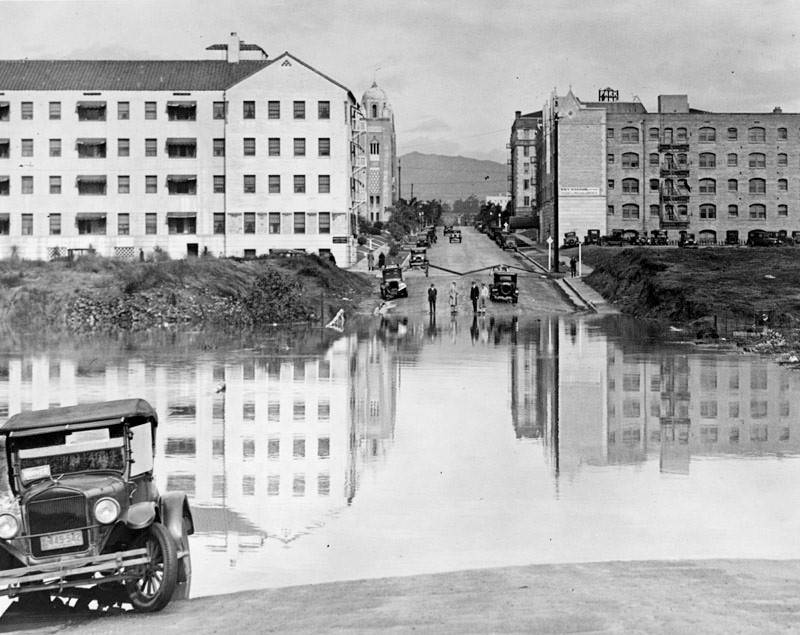 |
|
| (ca. 1927)* - Looking north at the flooded intersection of South New Hampshire Avenue and 5th Street. A car is parked in the foreground, while a barrier blocks traffic from entering deeper water. |
Historical Notes This apartment district grew faster than the drainage system designed to serve it. Heavy rain funneled into the low spot at New Hampshire and 5th, creating temporary ponds that blocked traffic and left residents waiting for the water to drain naturally toward distant storm inlets. These recurring episodes reflected the mismatch between rapid development and still-limited infrastructure in the mid-1920s. |
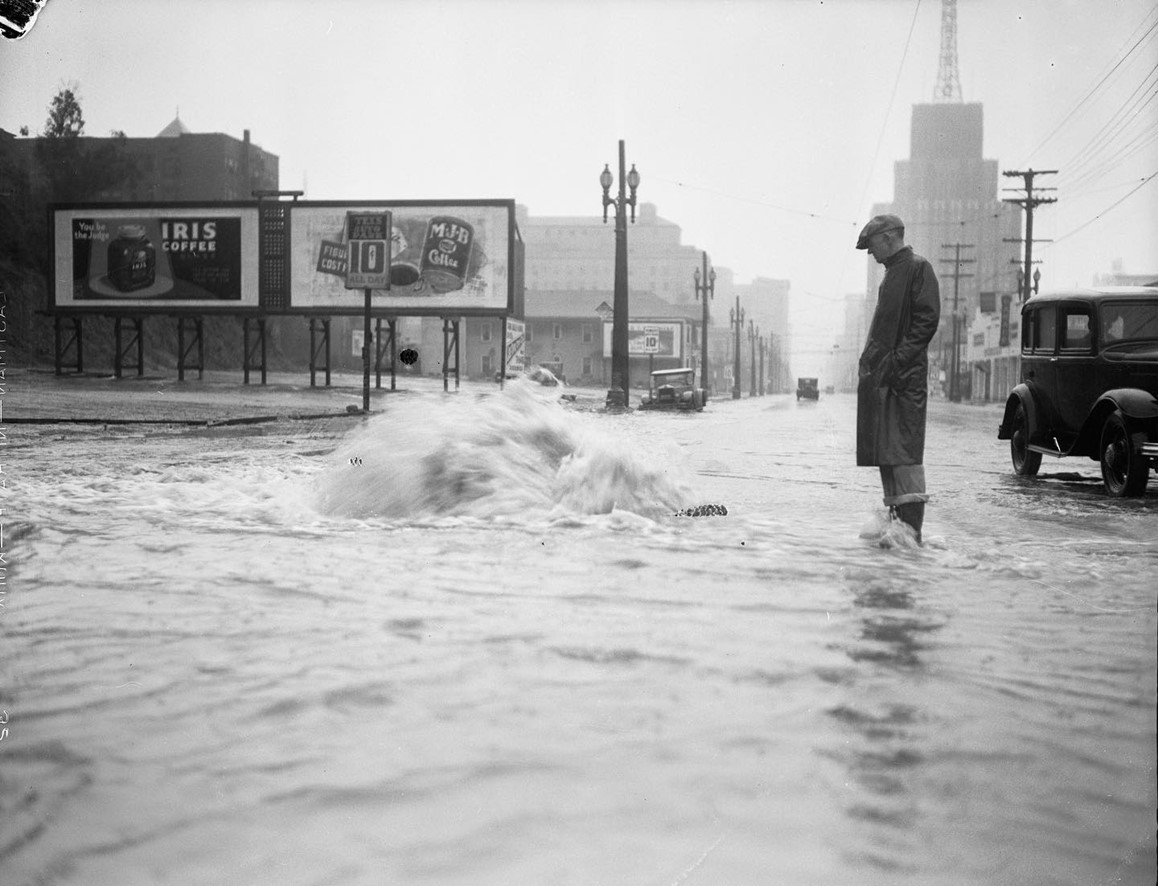 |
|
| (1933)* - A manhole erupts at 4th and Flower following heavy rain. The Richfield Tower rises in the background, with competing coffee advertisements visible at left. (LA Times/UCLA archive) |
Historical Notes Steep streets around Bunker Hill funneled large volumes of runoff into a storm-sewer system often too small for major storms. The surging manhole seen here signaled that the pipes were operating at or beyond their limits—a frequent downtown problem in the 1930s. Such incidents strengthened calls for a more coordinated, region-wide flood-control system. |
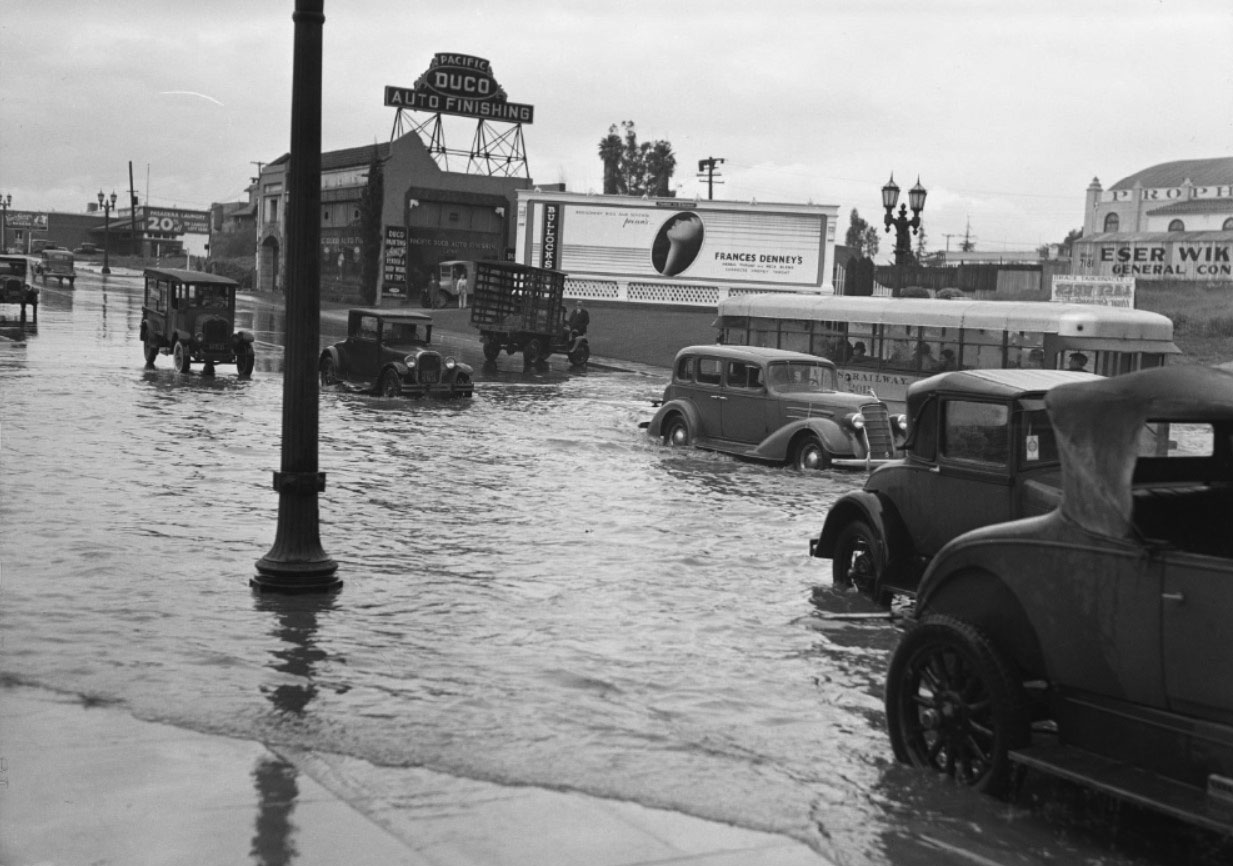 |
|
| (1930s)* – Storm-flooded Beverly Boulevard at its intersection with Lake Street, a common sight during heavy rains in the 1930s. |
Historical Notes Flooding at Beverly and Lake was typical in the 1930s, when Los Angeles and the county were still debating responsibility for major drainage upgrades. Paved boulevards accelerated runoff, overwhelming intersections like this one during strong storms. Such scenes foreshadowed the devastating 1938 flood, which ultimately spurred federal involvement in constructing the region’s modern flood-control channels and dams. |
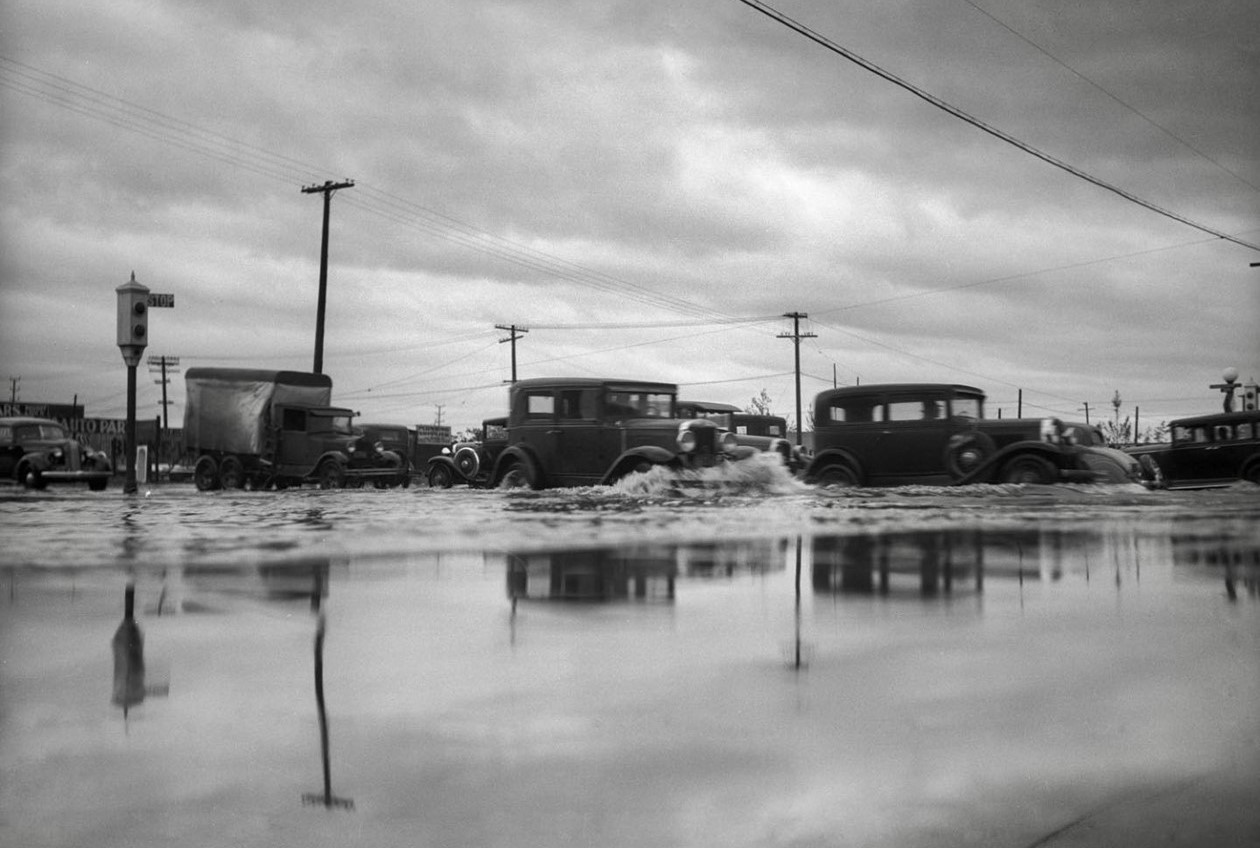 |
|
| (1935)* - Floodwater fills the intersection of Manchester and Central in South Los Angeles. |
Historical Notes South Los Angeles’ flat topography and growing network of paved streets made intersections like Manchester and Central prone to flooding during winter storms. By the 1930s, rapid development had far outpaced the storm-drain system, leaving streetcars and motorists regularly stranded in standing water after heavy downpours. |
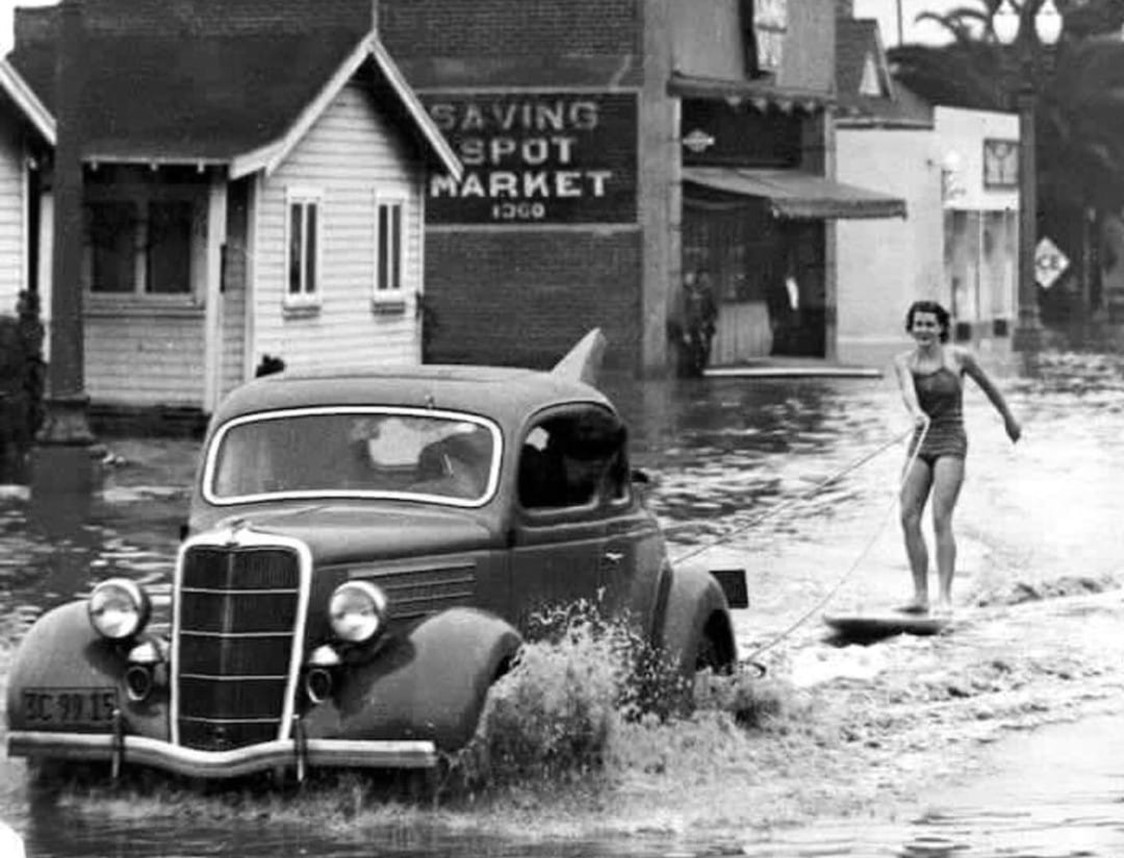 |
|
| (1937)* - After several days of rain, 17-year-old Mary Ann Hopkins glides across a flooded Venice street. |
Historical Notes Venice was built on former marshland and filled in canals, which made the area prone to flooding after heavy rain. During the 1937 storms, streets around Washington Boulevard, including the block with the Saving Spot Market at 1360 W. Washington Boulevard, were covered with standing water, and several nearby businesses experienced similar conditions. In this photo, 17 year old Mary Ann Hopkins glides across one of these flooded streets, a common sight in low lying Venice neighborhoods during major winter storms. |
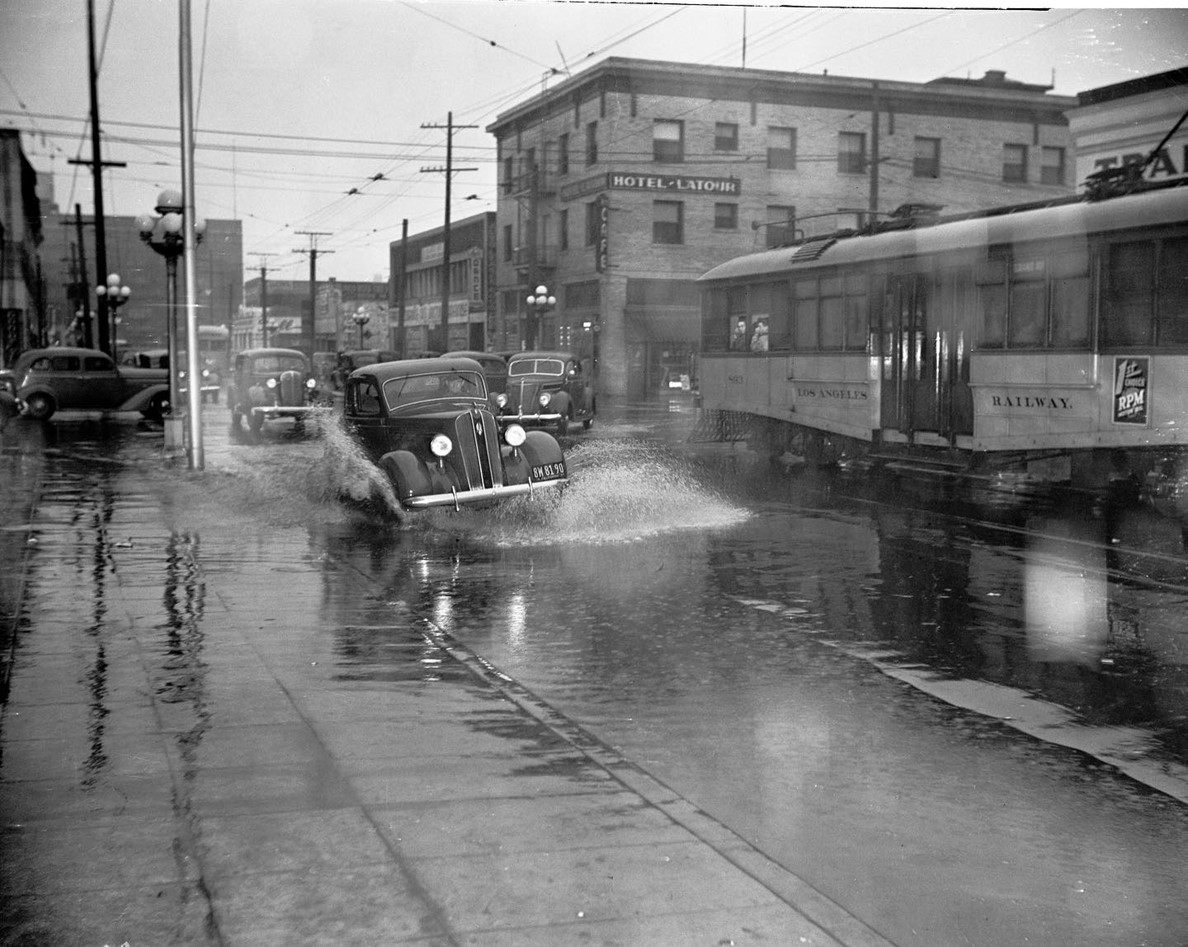 |
|
| (1937)* – Looking east on Pico Boulevard toward Hill Street during a December 1937 storm, as a car navigates around a streetcar through deep curbside water. |
Historical Notes This view at Pico and Hill reflects the streetcar era, when heavy rainfall routinely created long stretches of standing water along curbs and tracks. Both motorists and streetcars were forced to creep through these flooded zones, a common winter experience before widespread postwar upgrades to downtown drainage. |
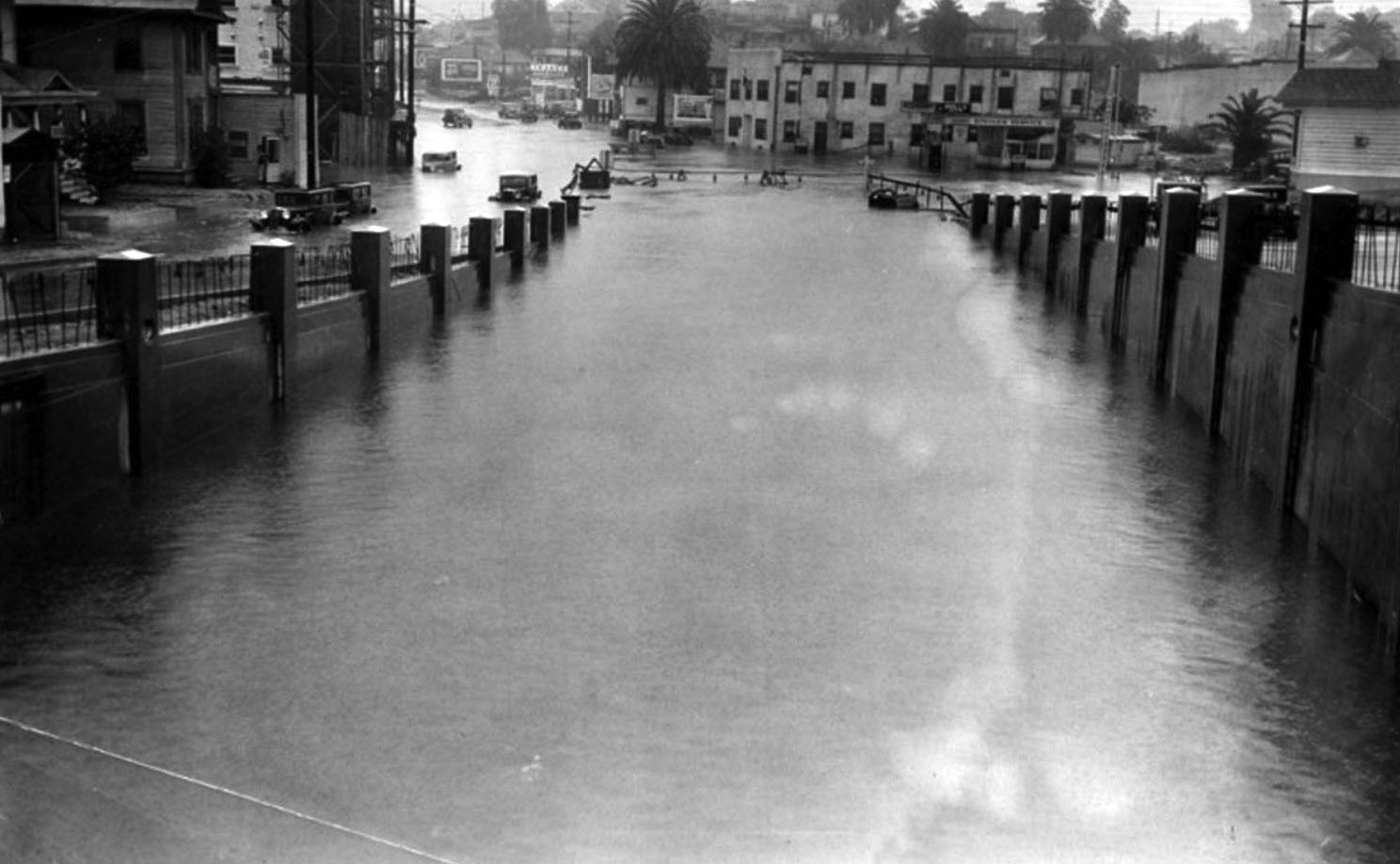 |
|
| (1939)* - A 5.42-inch storm floods the new Temple–Figueroa underpass under construction, leaving stalled cars along its edge. (Herald Examiner Collection) |
Historical Notes The flooded Temple–Figueroa underpass highlights the challenges early grade-separation projects faced before pumps and permanent drainage were added. Underpasses under construction frequently acted as temporary basins for runoff, filling quickly during storms and stranding motorists—problems engineers had to resolve as more such structures were built for the expanding roadway network. |
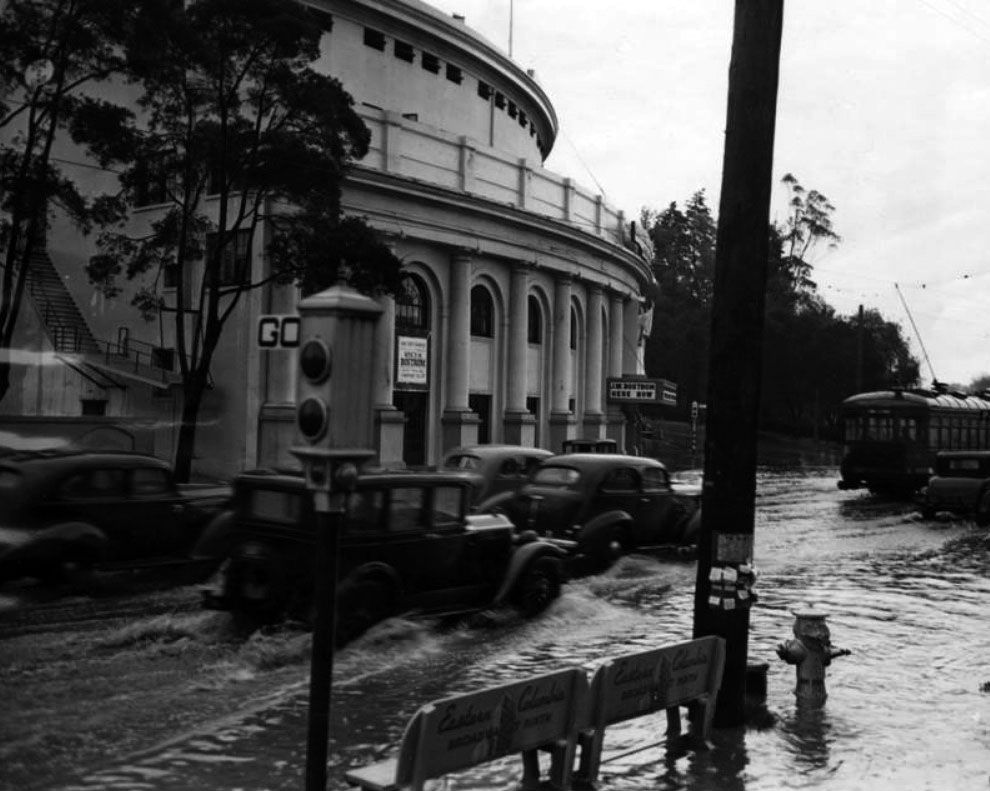 |
|
| (1940)* - Cars slosh through floodwater in front of Angelus Temple in Echo Park on February 1, 1940, passing an old-style semaphore traffic signal. |
Historical Notes By 1940, most Los Angeles streets were paved, but intense winter rains still overwhelmed drainage in hilly districts like Echo Park. Runoff from surrounding slopes collected on low-lying streets near the lake, as seen here in front of Angelus Temple—a recurring issue that later improvements reduced but did not fully eliminate. |
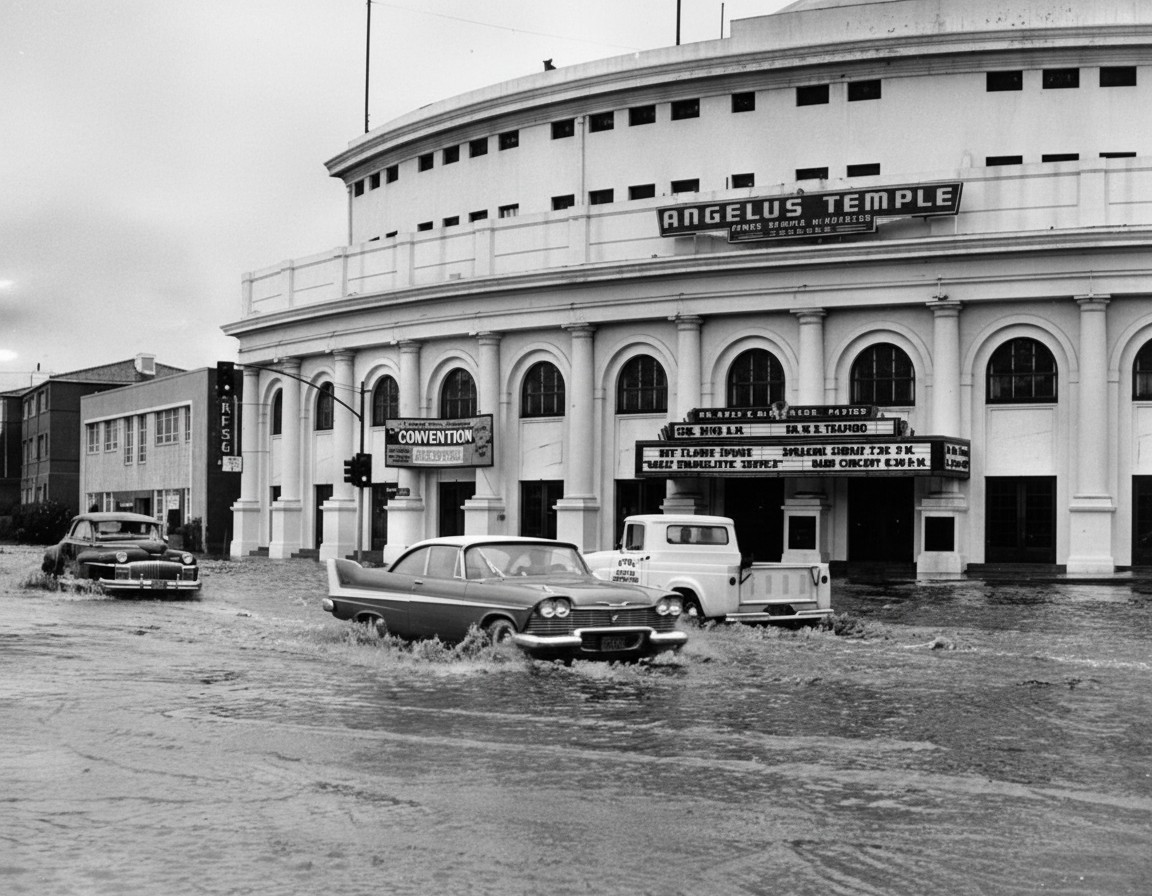 |
|
| (1958)* – Flooding in front of Angelus Temple at Glendale Boulevard and Park Avenue, directly across from Echo Park, in 1958. |
Historical Notes Even after major flood-control projects along the Los Angeles River were completed, localized flooding persisted around Angelus Temple. Situated below steep hills, this intersection continued to collect runoff during intense rainbursts, echoing conditions seen in the 1930s and 1940s. |
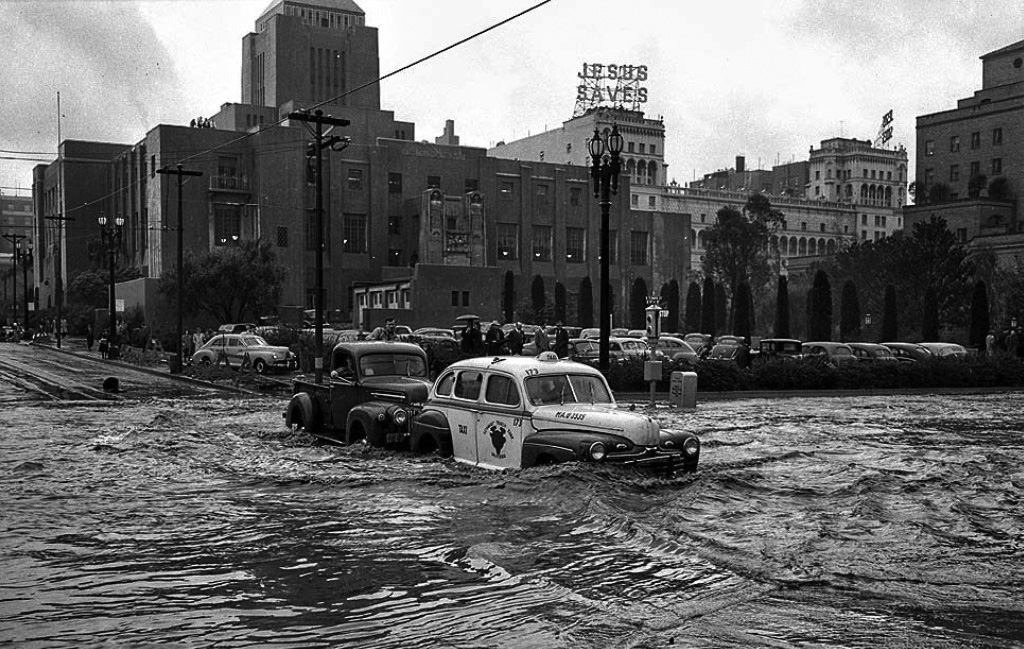 |
|
| (1948)* – A tow truck pushes a stalled taxi across the flooded intersection at 5th and Flower after a heavy rain. In the background can be seen (l to r): the Goodhue Central Library, Church of the Open Door / Biola Institute, and the California Club. |
Historical Notes The March 1948 storm dropped more than an inch of rain in one day, stalling cars and tying up downtown traffic. Tow trucks stayed busy rescuing stranded motorists as intersections like 5th and Flower briefly turned into deep pools. While farmers welcomed the rainfall, city drivers experienced it as a major inconvenience. |
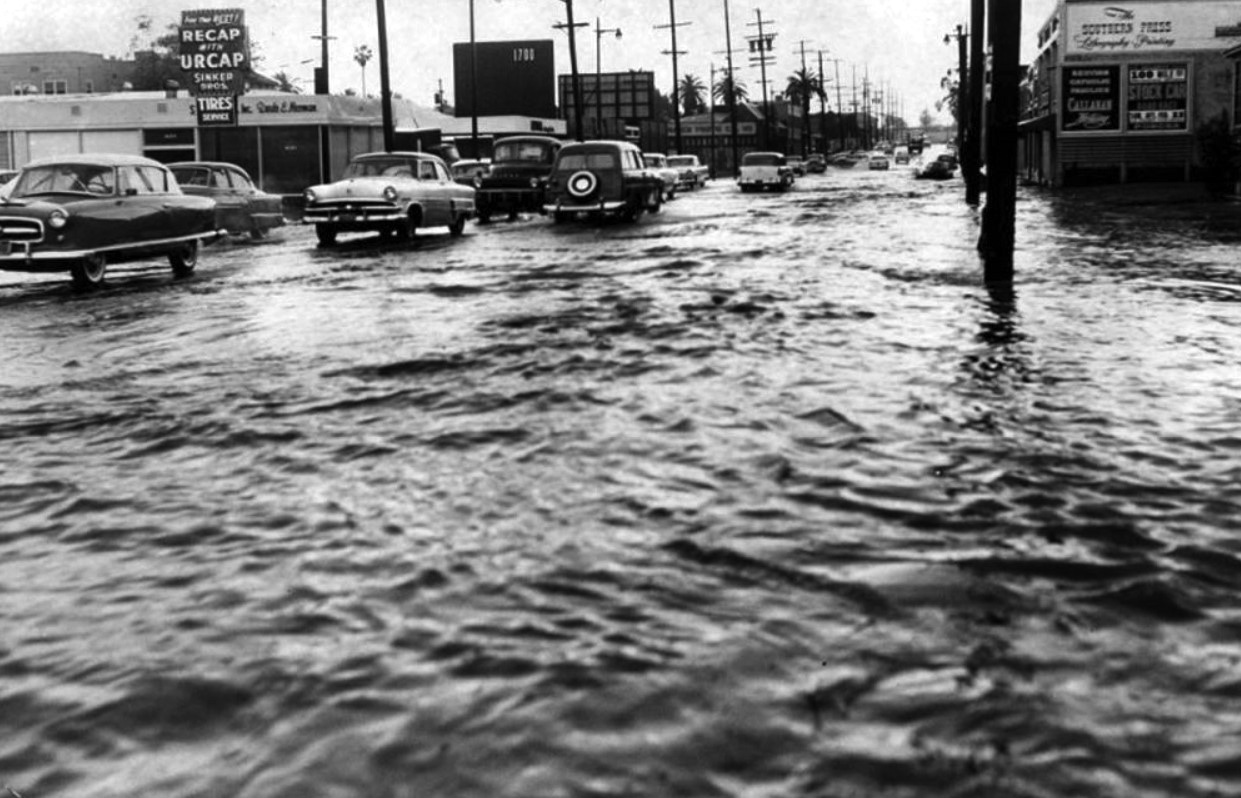 |
|
| (1958)* - Motorists inch through floodwater on Pico Boulevard near Union Avenue in the Pico Union District.. |
Historical Notes Despite postwar improvements to storm drains and the channelization of the Los Angeles River, intersections in older districts like Pico-Union continued to flood during intense rain cells. Water funneled toward low points near major intersections, slowing drivers and creating brief but disruptive street closures. |
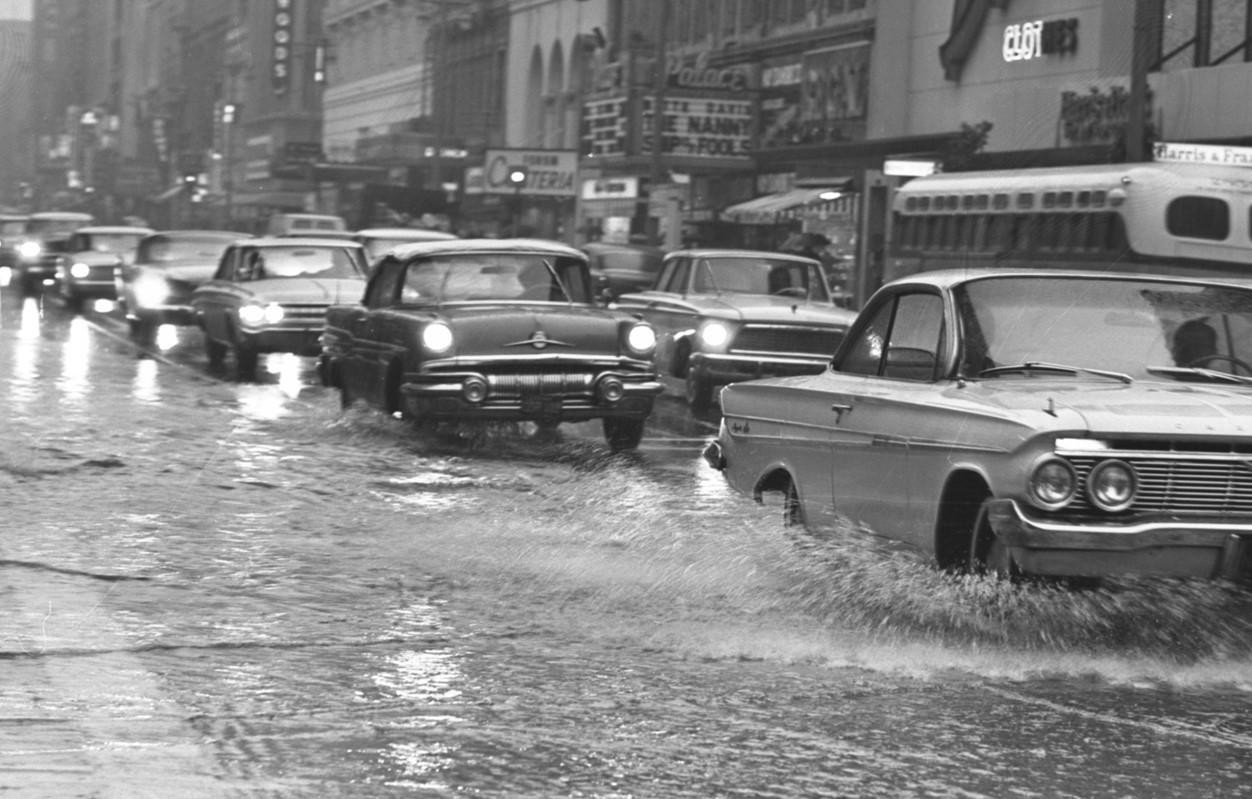 |
|
| (1965)* - Rainy day in DTLA. View is looking north on the 600 block of Broadway. The Palace Theatre is seen in the background featuring two films: The Nanny and Ship of Fools. |
Historical Notes By the mid-1960s, flood-control projects had minimized the threat of widespread inundation, but downtown streets still reflected Los Angeles’ reliance on asphalt over natural drainage. Heavy rain quickly filled gutters and created reflective sheets of water along Broadway, leaving pedestrians to navigate a familiar mix of puddles, traffic, and winter storms. Click HERE to see Early Views of Flooding in the San Fernando Valley. |
* * * * * |
Early LA Signs and Billboards
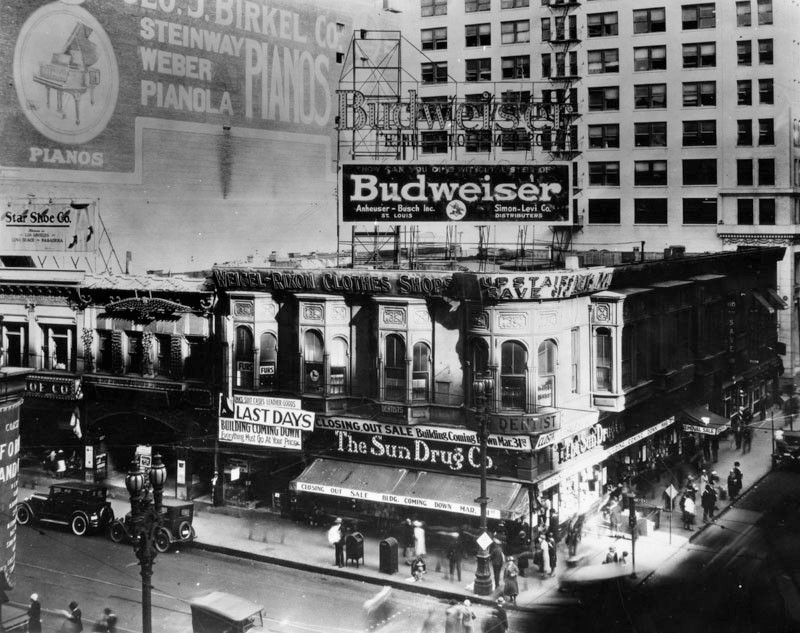 |
|
| (1920s)^ – View showing the Sun Drug Co. Store on the northeast corner of Broadway and 5th Street. Above the building is a billboard for Budweiser. On the front of the building a sign reads: "Last Days" and "Closing Out Sale, Building Coming Down March 31st." The large building on the left has advertisement for pianos covering the majority of its brick wall. |
Historical Notes The Sun Drug Co. building (also known later as the Swelldom Building) was part of the theatrical and retail heart of downtown. Signs like “Last Days” and “Closing out Sale” signified both the high turnover of retail tenants and the pressures of urban redevelopment even then. The large piano advertisement covering a brick wall reflects how businesses maximized wall space for advertising when billboards (or painted wall ads) were among the few ways to reach people beyond immediate footsteps. |
.jpg) |
|
| (1926)* - View showing the billboard and store sign above the entrance to the Vogue Drug Co. at 2001 W. Sixth Street. |
Historical Notes Drugstores in the 1920s frequently used external roof signs or entrance signage to catch attention from both pedestrians and cars. The Vogue Drug Co. likely used its entrance sign not just for branding, but as a way of presenting itself as modern and clean—qualities important in drugstore marketing of the time. |
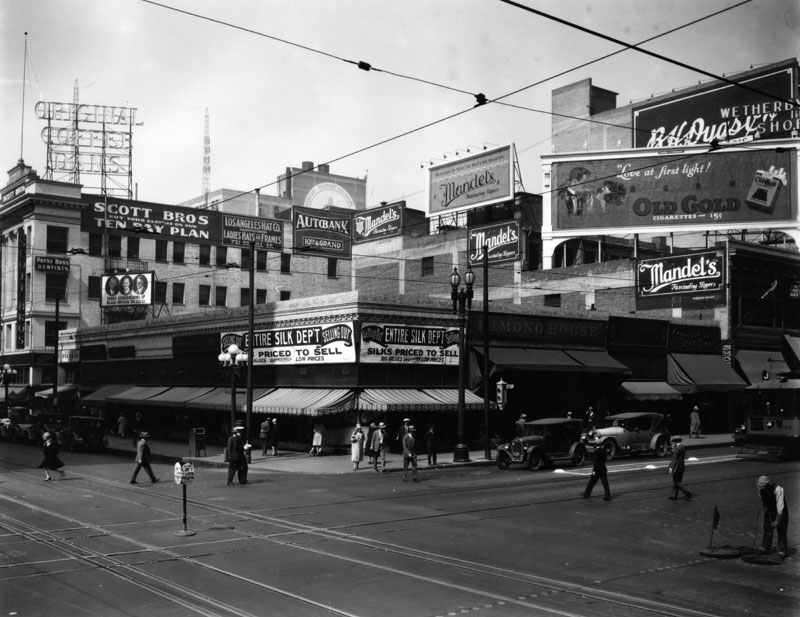 |
|
| (1927)^ - View of south Hill Street on the left, and west 7th Street on the right. Several business advertisements can be seen on the buildings of this southwest corner. Some are just the names of the business, such as: Coffee Dans; Payne Bros. Dentists; Kimono House, and Wetherby Shoe. And some offer a bit more information, such as: Scott Bros.; the Los Angeles Hat Co.; Autobanx; Mandel's; and the shop on the very corner announcing a sale. A billboard above Mandel's promises "Love at first light!" with its Old Gold cigarettes that sell for .15 cents. The American Telephone & Telegraph building peeks from behind all of this. Several people can be seen crossing the street and a traffic sign reading "Left turn prohibited" has been posted in the middle of the intersection facing both directions. |
Historical Notes Here we see a mix of simple name signs (business identity) and more elaborate billboard-style ads (such as the “Love at first light!” Old Gold cigarettes sign). Tobacco advertising was very common, and low cost per exposure made it profitable. Also, note the signage for dentists, shoe stores, etc., which show that even quieter professional businesses participated in the visual advertising culture. The traffic sign (“Left turn prohibited”) shows that traffic regulations were being put in place to cope with motor vehicle growth. Also: Within about a year, that corner would see high-rise redevelopment (the Great Western / Sun Builidng), which suggests that commercial pressure and growth responded quickly to pedestrian and vehicular traffic density. |
 |
|
| (1920s)* - View looking south on Broadway toward the Examiner Building on the S/W corner of Broadway and 11th Street. A potpouri of signs can be seen at left including: The Los Angeles Investment Co., Western Auto Supply, and Paul G Hoffman Studebaker sales office. |
Historical Notes Broadway was the prime retail street in Los Angeles during these decades; companies like Western Auto and automotive showrooms (Studebaker, etc.) were trying to catch both pedestrian and car traffic. Signs were layered—smaller store-front signs, large wall ads, billboards—and there was competition for visibility. The mix of industries (auto, investment, retail) shows how varied the downtown economy was, and how sign styles varied accordingly. |
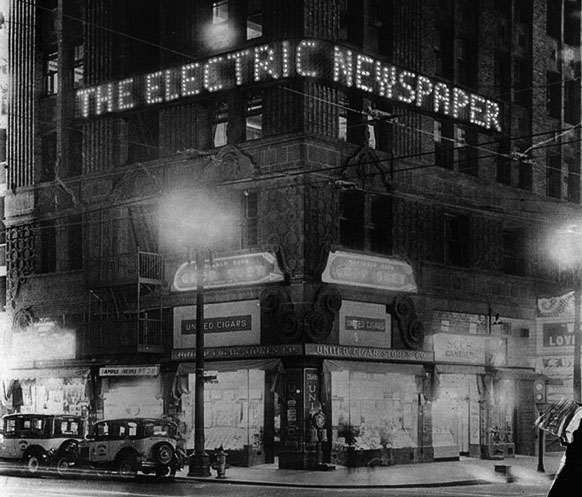 |
|
| (1931)* – View showing the Los Angeles Times--Richfield “Electric Newspaper” during its preview at the NE corner of 6th and Hill streets on the Paramount Theatre Building. |
Historical Notes This “Electric Newspaper” bulletin installation is reflective of a trend among newspapers to use illuminated or flashing signs to display headlines. It was meant to lure readers into buying the paper to get full details. It also shows how competition among daily papers drove innovation in signage. These types of signs helped anchor buildings like the Paramount in the public imagination not just as theaters or offices, but as hubs of current events. |
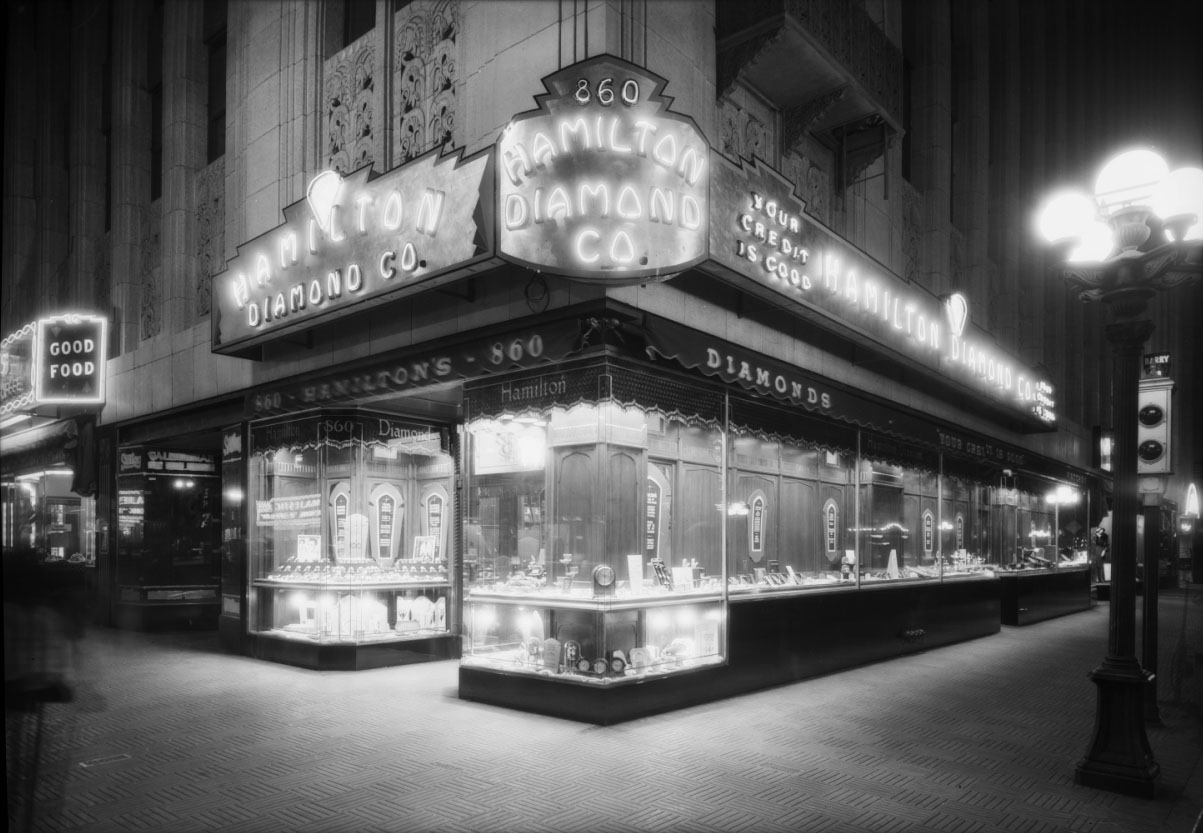 |
|
| (1930)* - A 5-lamp ornate streetlight and the Hamilton Diamond Co. store neon lighting help illuminate the northeast corner of Broadway and 9th Street. |
Historical Notes Neon signage had by 1930 become a standard tool for businesses wanting to stand out after dark. Jewelers in particular often used neon because of the sparkling/glowing effect, which complemented their product. A streetlight plus neon store front lighting shows integration of public infrastructure (street lighting) with commercial illumination to create a more vibrant night-scene downtown. |
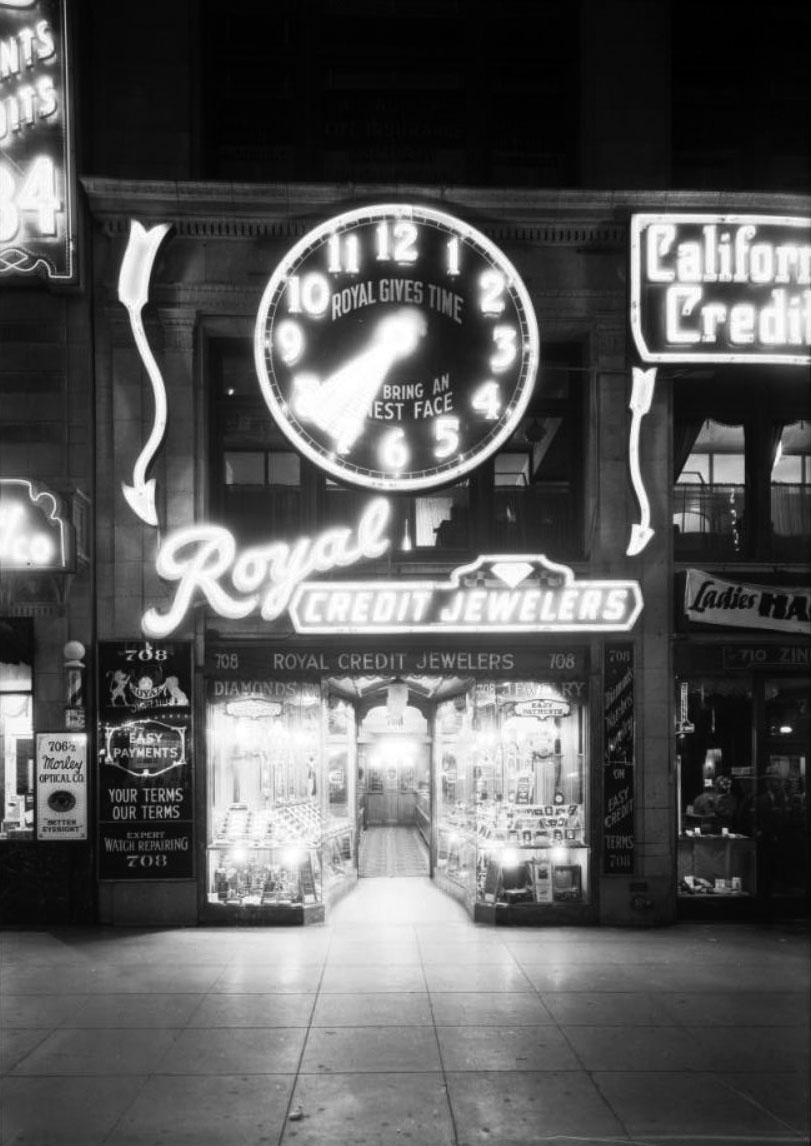 |
|
| (1930)* - “Royal Gives Time”: the Royal Credit Jewelers clock at night, 708 South Hill Street. |
Historical Notes Clocks have always served both functional and promotional roles—telling time for passersby and acting as advertising. A neon-lit clock is especially notable as it’s visible at night, which shows how businesses strove for 24-hour visibility. Also, clocks helped brands be part of daily life: people might arrange meetings by them or think of them as landmarks. |
 |
|
| (ca. 1928)* - View looking at the east side of Main Street between 6th and 7th streets showing a pawnshop bookended by two coffee shops. Signs read (l to r): 5 and 10 M&S Café, Star Loan Office - Money to Loan on Everything, and Big Nickel Coffee and Donut. |
Historical Notes The signs reflect a more modest commercial environment: cafés and pawnshops catered to working people. The phrase “Money to Loan on Everything” shows the ubiquity of informal credit and pawn services in that era. Coffee shops with names like “Big Nickel Coffee and Donut” suggest early mass commercial food culture. Overall, this block illustrates how signage was scaled to neighborhood commerce—not always grand or neon, but functional and bold enough to be seen. |
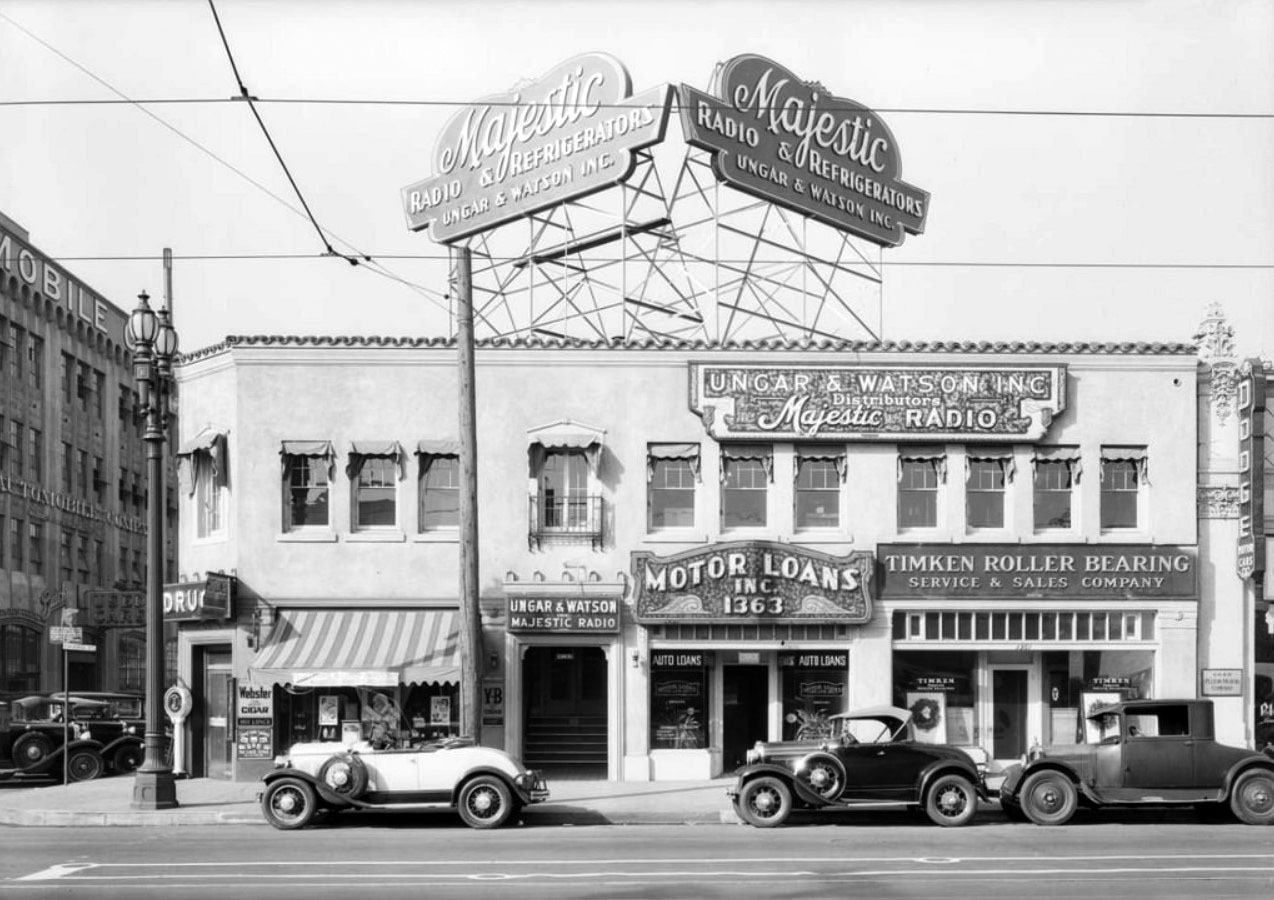 |
|
| (1930)* - Majestic Radio & Refrigerators, 1363 S Figueroa Street. This is the current location of the LA Convention Center. |
Historical Notes Advertising of household appliances and radios in the 1930s corresponded with rising consumerism and electrification. As more homes got electricity, radio became central to entertainment; refrigerators, too, were being adopted. A large sign for “Radio & Refrigerators” would signal modernity and connection to national trends in technology. |
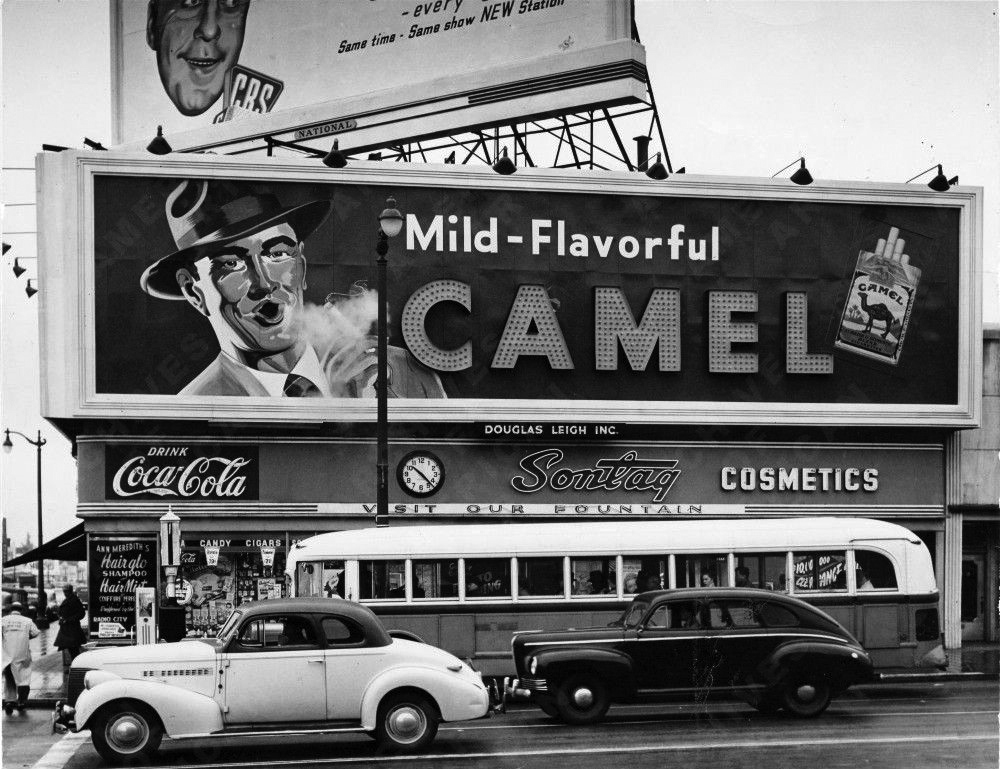 |
|
| (1949)* – Los Angeles street scene showing a unique array of billboards and signs most impressive of which is the billboard that actually smoked. We're looking at the SW corner of Sunset and Vine in Hollywood. At the time there existed a more famous but very similar billboard in New York’s Times Square. The billboard above the Camel sign is promoting Jack Benny's move from NBC to CBS, which happened in January 1949. Sontag Drug Store is seen on ground level. Note the ornate genie lamp streetlight on the left. |
Historical Notes This billboard is a classic example of mid-20th century spectacle in outdoor advertising. The Camel sign with smoke (animated or mechanical effects) shows how advertisers competed by offering novelty, not just size. Jack Benny’s move from NBC to CBS was major entertainment news at the time; using that as billboard content shows how intertwined entertainment, broadcast media, and commercial advertising had become. Also, the Sontag Drug Store display below reminds that anchors like department stores drugstores were major contributors to street-level vibrancy in Hollywood. |
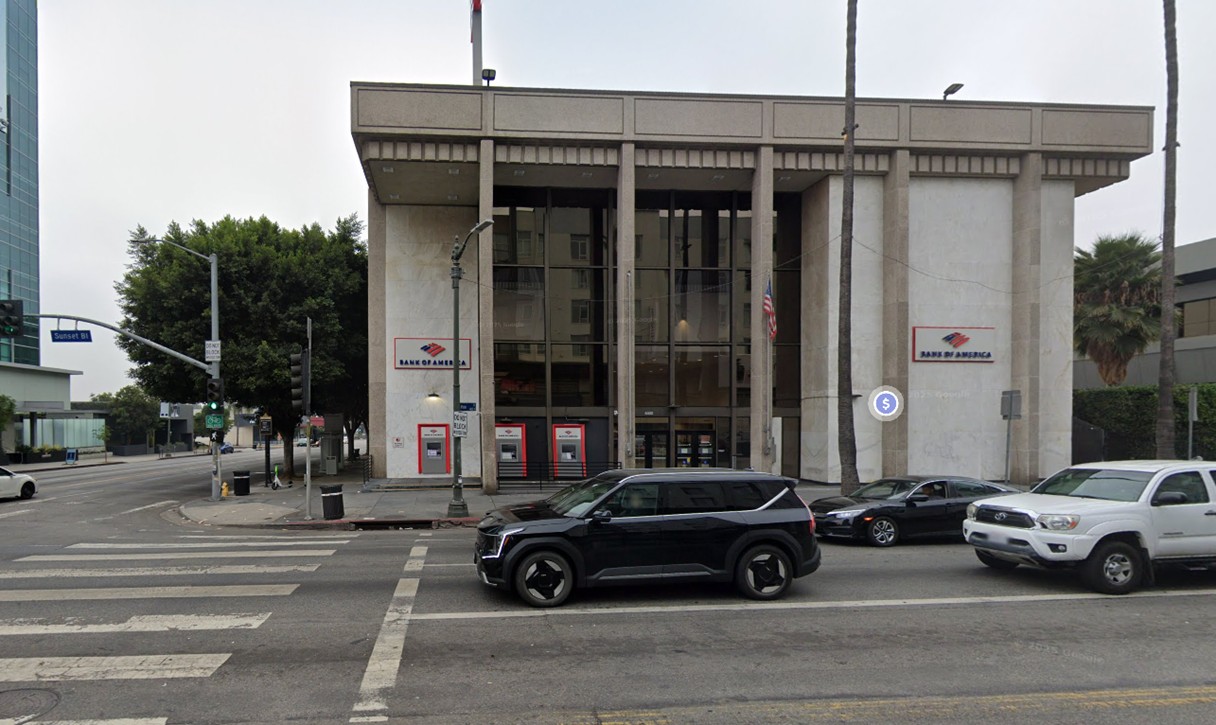 |
|
| (2024)* – Contemporary view of the southwest corner of Sunset and Vine, where today a Bank of America stands. |
Historical Notes This corner has long been a stage for Hollywood’s changing face. In 1949, it was dominated by the famous Camel cigarette billboard that puffed real smoke into the air—one of the most memorable advertising spectacles of its era. Today, the smoke and neon are gone, replaced by the sober lines of a mid-20th-century bank building that reflects the boulevard’s shift from showmanship to commerce. The site continues to anchor one of Hollywood’s most iconic intersections, even as its landmarks have changed with the decades. |
Then and Now
 |
|
| (1949 and 2024)* – Sunset and Vine, Southwest Corner. Photo comparison by Jack Feldman. |
Historical Notes In 1949, the southwest corner of Sunset and Vine was dominated by a massive Camel cigarette billboard designed by Douglas Leigh Inc., with Sontag Drug Store below offering cosmetics, a soda fountain, and a landmark clock. Neon and painted signs made this one of L.A.’s most vibrant advertising corners, reflecting Hollywood’s golden age of consumer culture. Today, the spectacle has given way to a Bank of America branch, a reminder of how this once-flashy intersection has shifted toward a more subdued corporate landscape. |
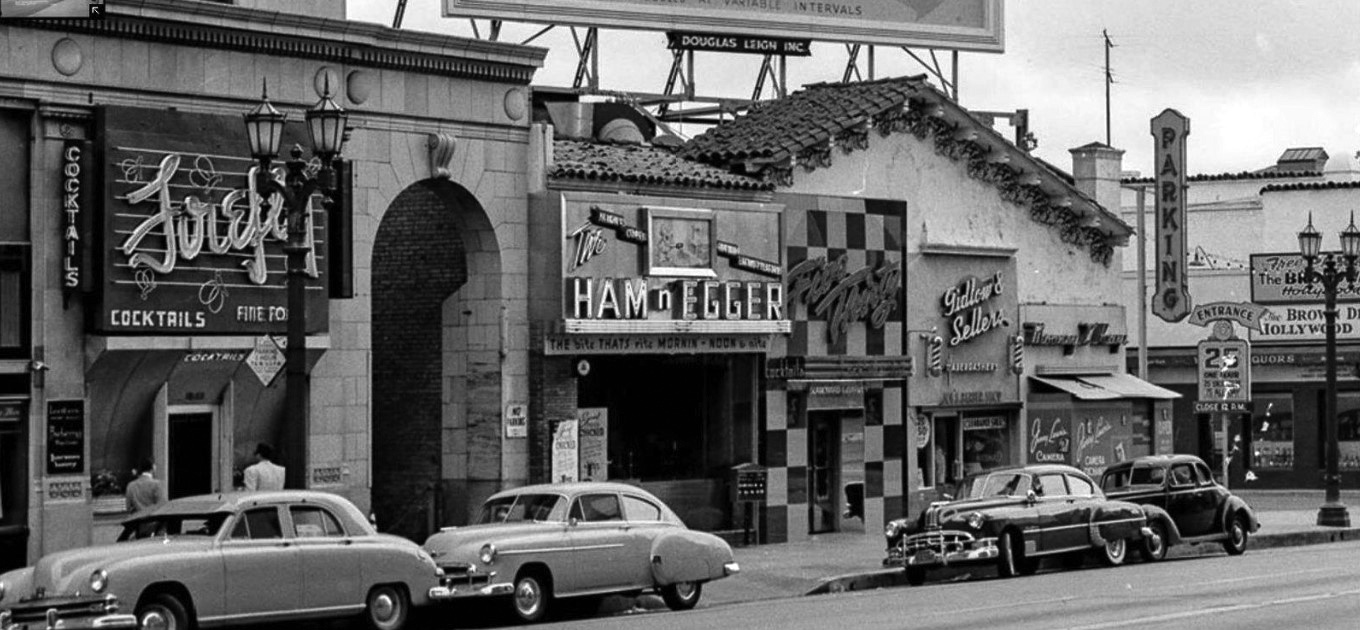 |
|
| (ca. 1950)* - View looking at the east side of Vine Street just south of Hollywood Boulevard. The Firefly Bar (on the left) is located on the ground floor of the Taft Building. The Ham ‘n Egger is seen at center with Giddlow and Sellers Barber Shop at center-right. To the right of the barber shop is Mooney and Kaye which is being converted into Jerry Lewis' Camera Shop. And finally at far right can be seen the edge of the Brown Derby Restaurant. |
Historical Notes By 1950, signs were not only about attracting attention but also increasingly about identity & branding: for example, the Brown Derby is a brand, as is Ham ’n Egger. As Hollywood tourism increased, signs needed to perform for an audience beyond locals. Also, the mix of small shops (barber, camera shop) and restaurants show a layering of commercial signage in the same block, each trying to distinguish itself visually. |
* * * * * |
Early Billboards
.jpg) |
|
| (1917)*^ - View of a man sitting in an early model car in front of a billboard located on Ventura Boulevard at the Calabasas City line. |
Historical Notes This billboard illustrates the use of outdoor advertising not just to sell goods, but also to frame place identity and travel. The place-name “Calabasas” is being positioned as a gateway—to natural canyons, to other communities—to entice travelers or motorists to look favorably on the area. The sponsor, Royal Cord Tires (U.S. Rubber Company), is tapping into a common technique of the era: aligning a commercial brand with themes of mobility, progress, and connection. In 1917, motor travel was still burgeoning; road signage and billboards near city or town lines served a dual purpose: navigation / direction plus advertisement. The rural or semi-rural stretch where this billboard stands underscores how advertisers capitalized on early highways and roads before heavy urban development limited visibility. |
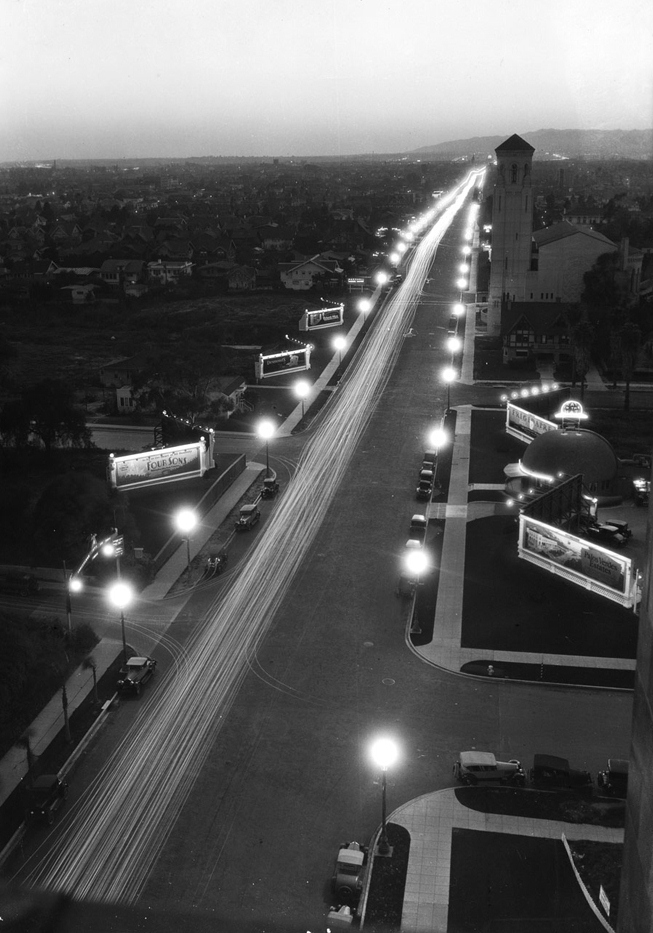 |
|
| (1928)* - Aerial view of a well lit Wilshire Boulevard at night. The original Brown Derby restaurant is visible on the right. Note the numerous signboards on both sides of Wilshire Blvd. The "Wilshire Special" streetlights do a good job lighting up the Boulevard. The Wilshire Christian Church (NE corner of Wilshire and Normandie) can be seen in upper right. |
Historical Notes By 1928, Wilshire Boulevard was already emerging as one of Los Angeles’s grand thoroughfares. The “Wilshire Special” streetlights (pole + lantern style) were a feature meant to elevate the boulevard’s prestige—and at night, lighting and signage combined to create a spectacle. Numerous signboards on both sides of the street testify to the increasing density of commercial advertising, especially in areas of high traffic. The Brown Derby restaurant, a landmark, helped anchor this kind of signage environment—its visibility both day and night made it part of the city’s identity. |
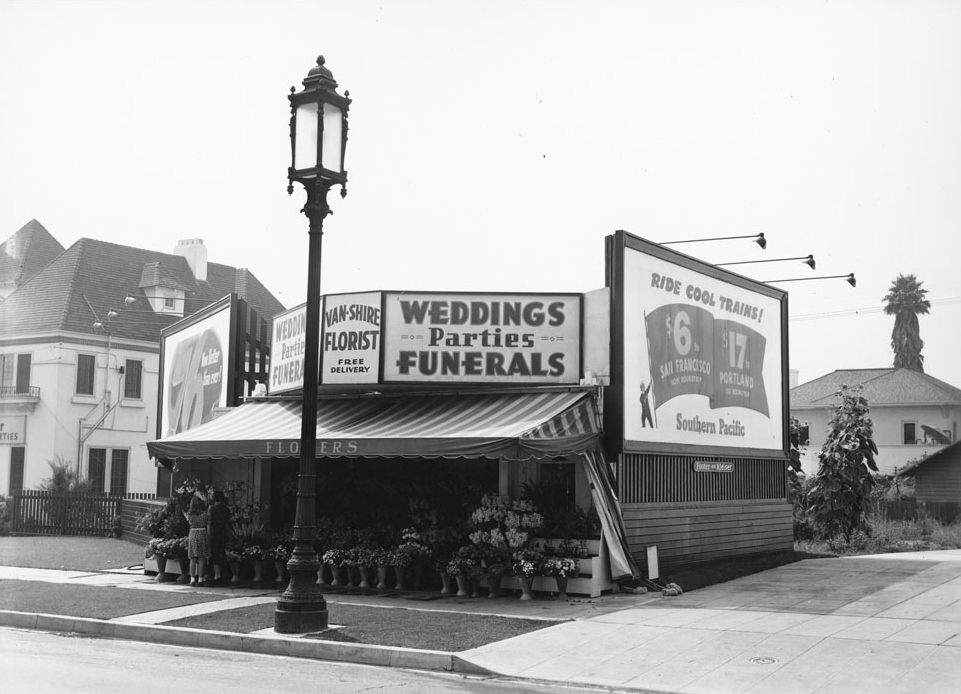 |
|
| (ca. 1928)*# - A "Wilshire Special" streetlight stands in front of the Van-Shire Florist open-air shop. Bilboards on either side of the shop advertise Union 76 gasoline and Southern Pacific railroad. The sign on the right reads "Ride cool trains! $6 to San Francisco. $17 to Portland". |
Historical Notes This image showcases how billboards often advertised transportation (railroads), fuel, and regional/cross-country services—sectors that depended heavily on mobility and travel. The “Ride cool trains!” slogan, fares to San Francisco or Portland, illustrates how railroad companies competed for long-distance travel markets, often using billboards in suburban or semi-urban corridors to reach prospective travelers. At the same time, gasoline brands like Union 76 were becoming household names, and their signs began to dot roadsides and urban fringes. |
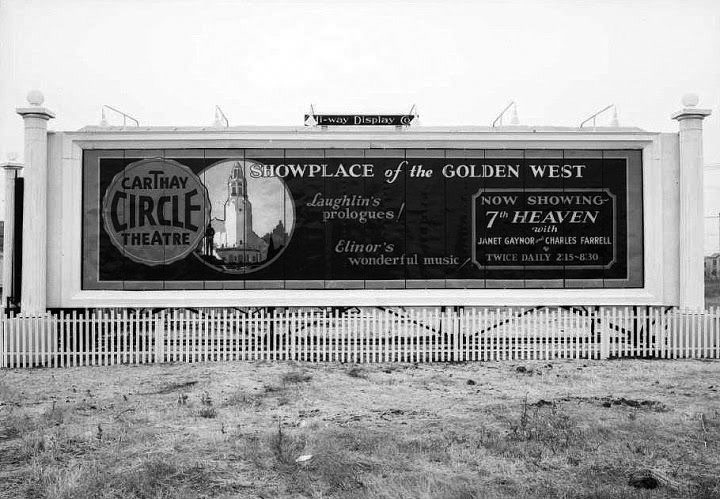 |
|
| (1927)* - A sign with triangular revolving panels advertising the Carthay Circle Theatre on Wilshire Boulevard. In addition to advertising the movie "7th Heaven," the sign also touted the music of Carli Elinor and the prologues by Laughlin. |
Historical Notes The Carthay Circle Theatre sign with moving or revolving elements was part of an early trend toward kinetic or semi-animated signage. Theatres especially used these effects—triangular revolving panels, lights, changing features—to create motion and draw attention, particularly at night. Theatres also drew upon multiple forms of entertainment in their signage: they advertised not just the film (here “7th Heaven”) but also accompanying musical performances (“music of Carli Elinor”) and prologues. This reflects how theatres were multifunctional entertainment hubs and how signage was more than static promotion. |
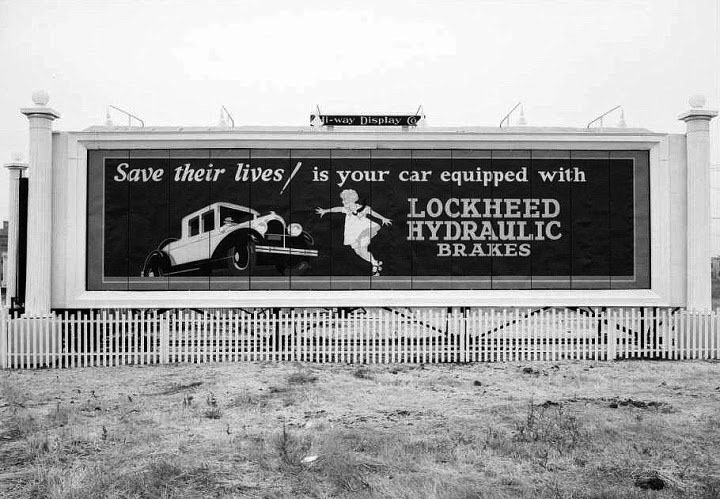 |
|
| (1927)* – Signboard on Wilshire Boulevard advertising Lockheed Hydraulic Brakes – Save Their Lives! |
Historical Notes As motor vehicles became more prevalent, advertising for automotive safety became part of outdoor advertising. The Lockheed Hydraulic Brakes sign exemplifies how technical or mechanical products—brakes, lubrication, tires—were also marketed via billboards. The claim “Save Their Lives!” shows how advertisers used appeals to safety and responsibility, not just performance or status. Also, the strategic placement of these kinds of signs along busy routes or major boulevards shows an early awareness of high visibility where cars passed. |
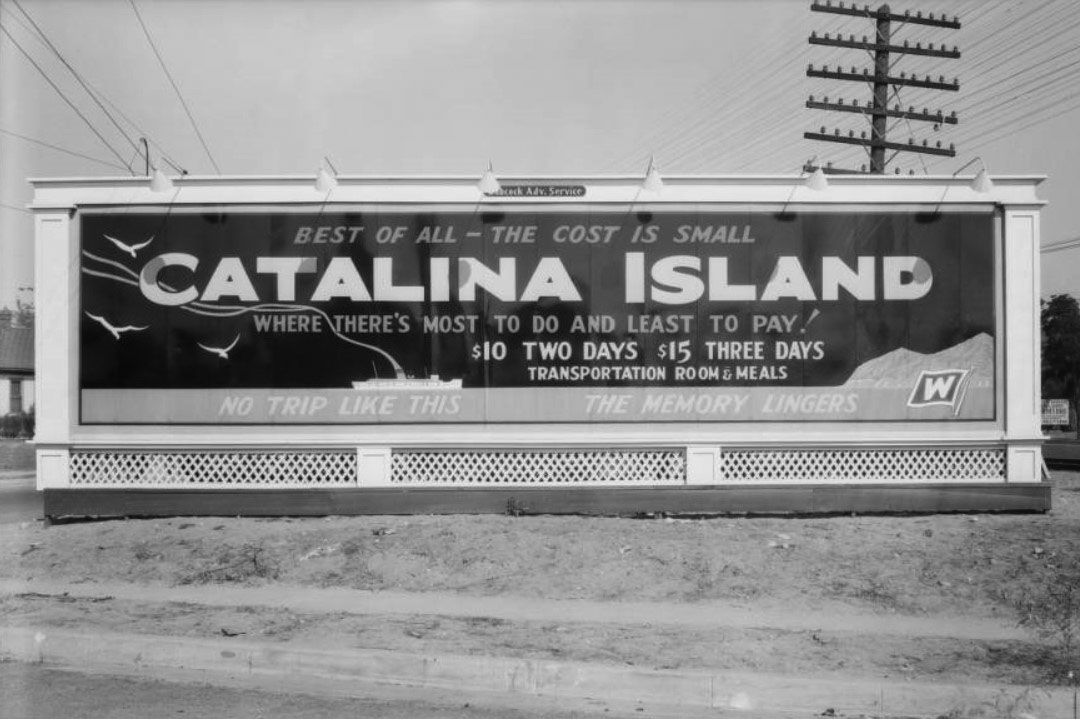 |
|
| (1928)* – Signboard on the corner of Washington and Crenshaw reading: "Catalina Island - Where There’s More to Do and Least to Pay! - The Memory Lingers.” Click HERE to see Early Views of Catalina Island. |
Historical Notes Tourism and travel were frequent subjects of billboard advertising, especially in Southern California, where many destinations (Catalina Island, Palm Springs, etc.) were accessible and marketed to both local and out-of-state visitors. Advertisements promising “More to Do and Least to Pay!” show competitive pricing was part of the lure. Such billboards also made use of evocative slogans or imagery (“The Memory Lingers”) to imply a lasting impression. The positioning at intersections or corners with traffic helped ensure commuters or passersby would absorb the message repeatedly. |
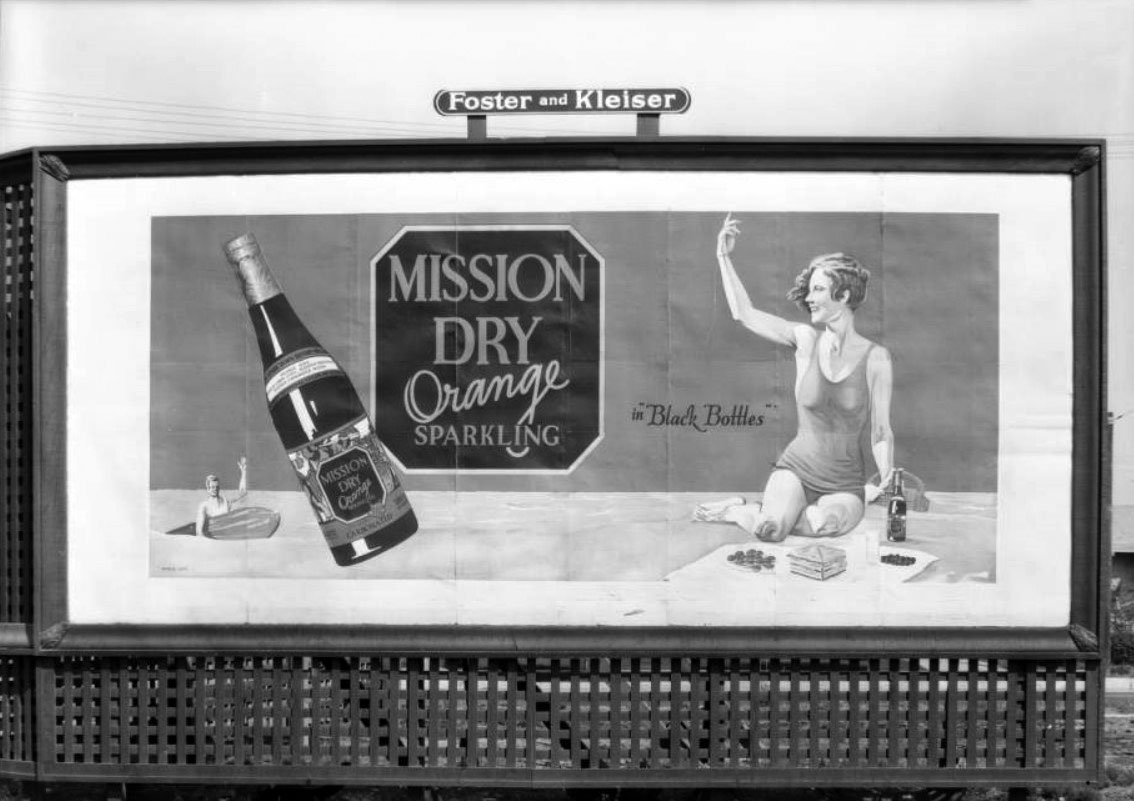 |
|
| (1929)* – Foster and Kleiser signboard located at Washington and Hauser boulevards advertising Mission Dry Orange Sparkling in “Black Bottles. |
Historical Notes Foster & Kleiser was by then already a major player in the billboard business in Los Angeles. Founded in 1901, the company became “the west coast’s leading billboard company.” Wikipedia+1 This billboard for a soft drink (“Mission Dry Orange Sparkling”) reflects increasing sophistication in product branding: design, bottle style (e.g. black bottles), sparkling drinks, and appeal to consumers' tastes. Soft drink brands often employed bold colors and graphic design to stand out, and used billboards targeted along traffic arteries or busy neighborhoods. |
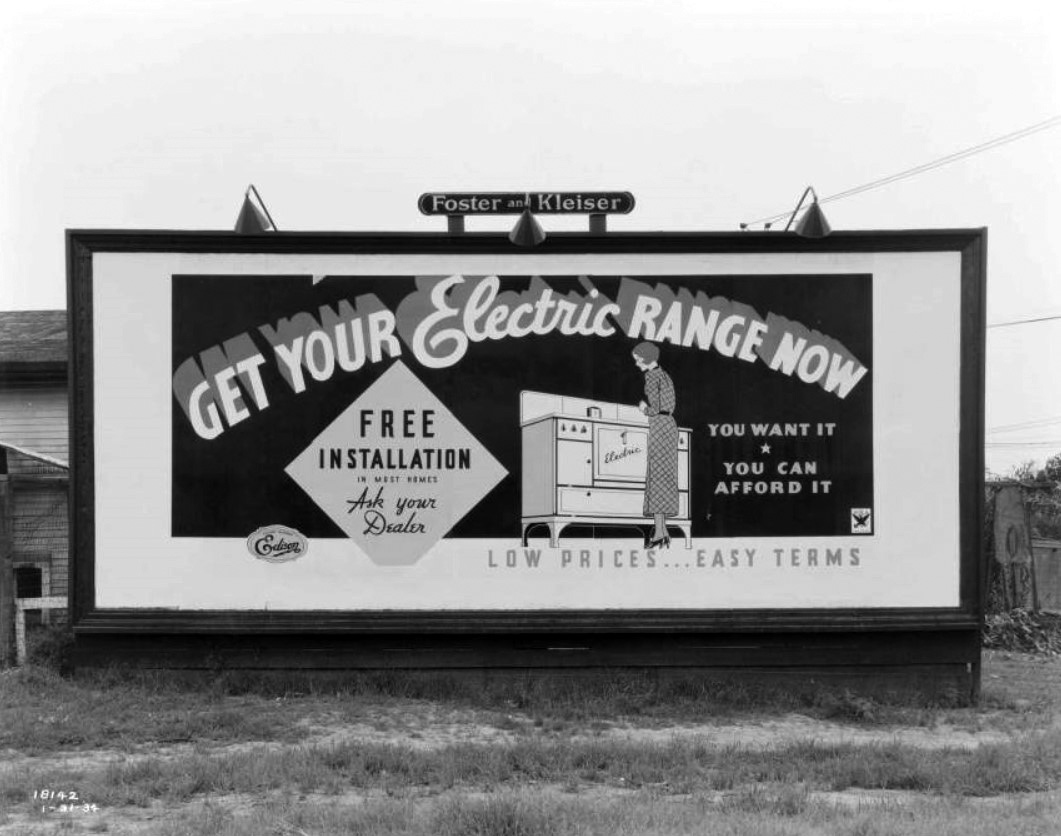 |
|
| (1934)* – SCE billboard for Electric Range with free installation at Inglewood location. |
Historical Notes By the mid-1930s, electrification was widespread in LA, but many households were still converting or upgrading their range appliances. Utility companies (or those selling electric appliances) used billboard advertising to promote “modern kitchen” ideals and free installation or incentives. This reflects broader trends: domestic technologies (range, refrigerator, radio) becoming central to consumer identity. Also, such ads might have carried moral or social implications of “progress,” of moving from older fuel sources to electric, which advertisers leveraged. |
 |
|
| (1935)^ - A Foster and Kleiser billboard outside of 1158 and 1160 W. 8th Street promotes the 1936 Chevrolet; 8th Street Specialty Co. is at 1158 and a small hotel is at 1160. Photograph dated November 15, 1935. |
Historical Notes Automobiles were among the biggest billboard subjects—both as products themselves and symbols of status, modernization, freedom. Advertising new car models (as here, Chevrolet) was essential as manufacturers competed vigorously, especially during the Depression era when each sale mattered more. Foster & Kleiser’s involvement shows how major billboard firms served the auto companies’ needs. Also, placing ads on 8th Street (rather than only at freeway or highway edges) shows that even in more central urban zones, dealerships and related auto-businesses sought high visibility signage. |
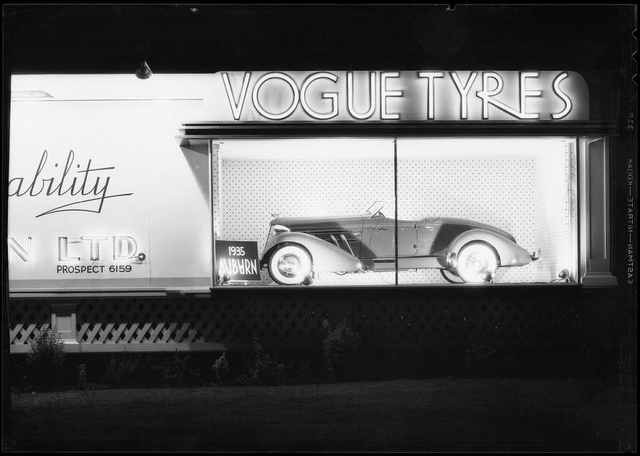 |
|
| (1935)* - View of a Vogue Tyre board with an a 1935 Auburn 851 Boattail Speedster on display. |
Historical Notes The Auburn 851 Boattail Speedster was a stylish, high-end automobile, notable for its aesthetics (the “boattail” rear, sleek lines). Featuring such a car in a billboard sign for a tyre company (Vogue Tyre) ties together the aspirational and functional: a beautiful, luxury auto uses Vogue tyres—and by extension, you could attain something similar. Luxury auto imagery helped car accessory/tyre firms position themselves as high quality. The visual drama of the car (shape, shine) was itself a draw. |
 |
|
| (ca. 1935)* – View looking east on Wilshire Boulevard at Mariposa Avenue showing an Arrowhead Water billboard. The Ambassador Hotel is located just east of the sign. Note the huge replica of a water cooler on the right. |
Historical Notes Billboards for everyday consumables like bottled water remind us that advertising was not only for luxury or novelty but also for essentials. Arrowhead (and its connection with Puritas) illustrate how regional water brands competed for visibility in Los Angeles’s expanding city. The inclusion of a huge replica of a water cooler or similar prop is an example of three-dimensional or oversized “object-signage” meant to capture attention. Also, proximity to landmarks like the Ambassador Hotel increased the sign’s impact. |
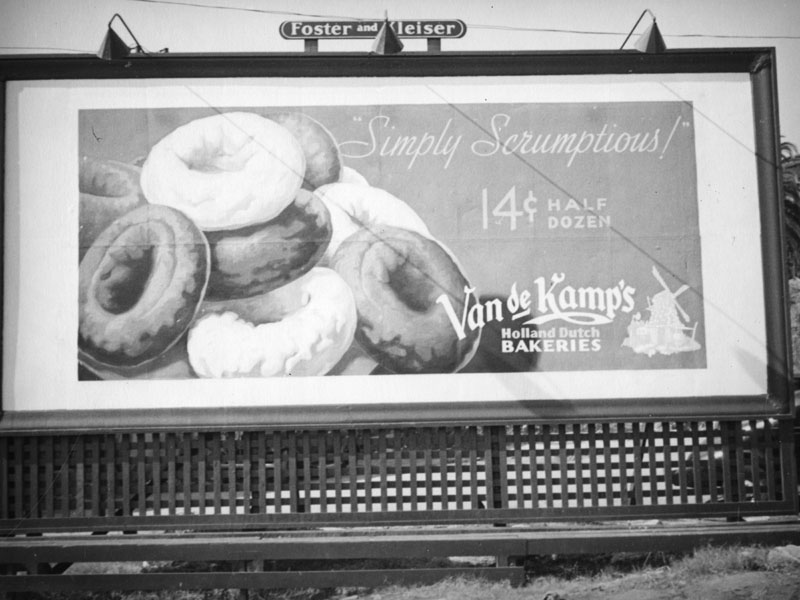 |
|
| (1937)^ - A Foster and Kleiser billboard advertising doughnuts sold at Van de Kamp's Bakeries. Photo by Herman J. Schultheis |
Historical Notes Food advertising—especially baked goods, snacks, desserts—was central to billboard culture. Van de Kamp’s was a name known in Los Angeles. The billboard indicates not just product promotion but branding for everyday pleasures. These signs also functioned as landmarks, sometimes functioning in maps or directions: “Turn left at the big doughnut sign,” etc. Billboards for bakeries were local in flavor but still used formal techniques (lighting, large type, graphics) to draw attention from passing traffic. |
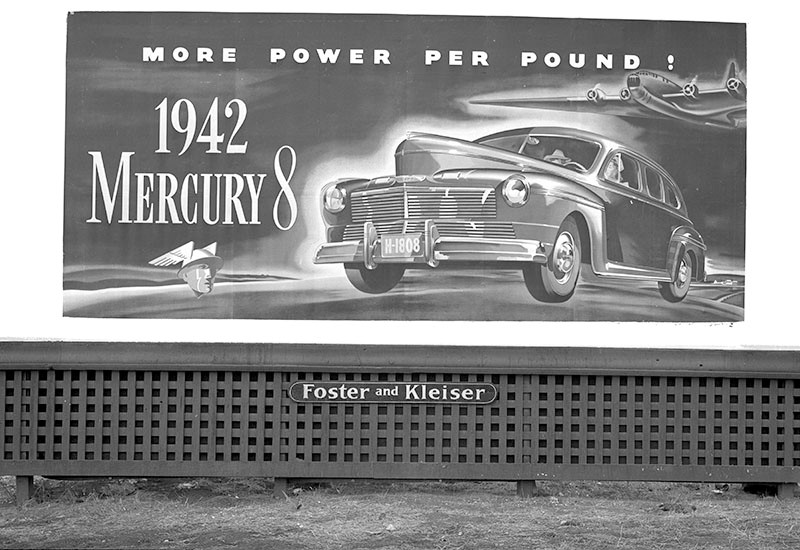 |
|
| (1941)^ - A Foster and Kleiser billboard on Jefferson Boulevard promoting the 1942 Mercury 8. The tag line reads, "More power per pound." Photograph dated December 24, 1941. |
Historical Notes The Mercury Eight was one of the earlier models emphasizing automotive power, design, and performance. Advertising slogans like “More power per pound” point both to technical innovation (lighter construction, more efficient engines) and to consumer desire for both performance and grace. Also, note the historical timing: this was during WWII era; production would soon be interrupted for war efforts, so 1941 is near the peak of car model marketing before wartime constraints. |
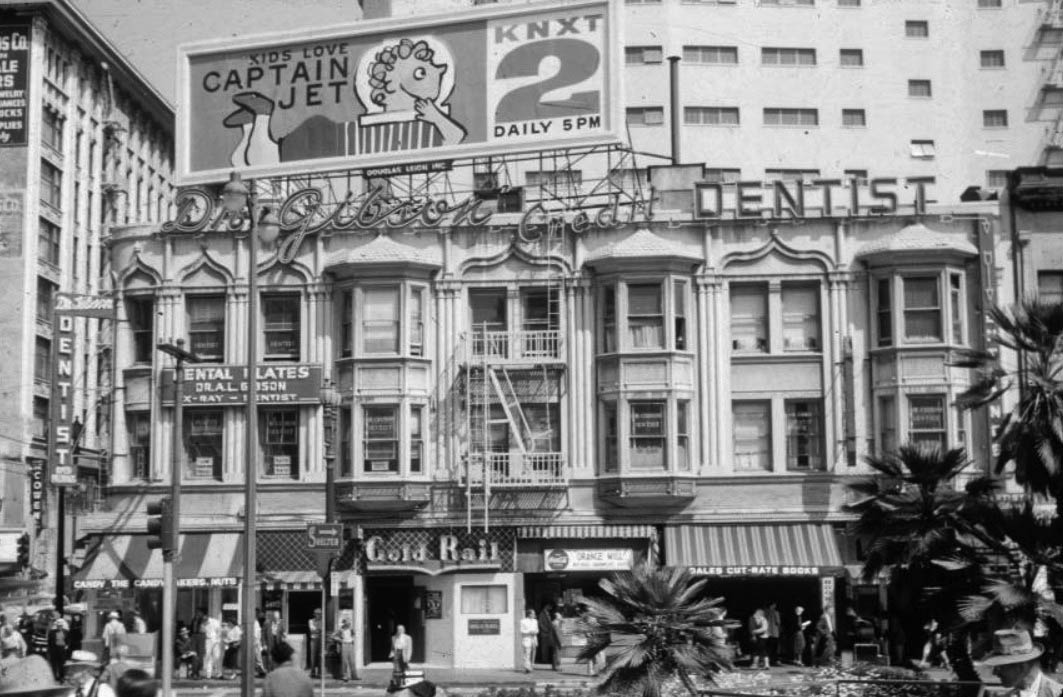 |
|
| (ca. 1950s)* - View showing the Bath Block (aka Willoughby Hotel) at 506 South Hill Street. Dr. Albert L. Gibson’s dental practice occupies the second floor of the former hotel. Billboard for Captain Jet television show atop building. |
Historical Notes By the 1950s, television was becoming a dominant mass medium. Billboards advertising TV shows reflect how advertising landscapes were shifting: not only products and travel, but programming and entertainment. The Captain Jet show billboard shows how TV culture was now integrated into street advertising, merging the public (outdoor) and the broadcast (indoor) spheres. Also, buildings like hotels, dental offices, etc., began to host such signage, showing that any available rooftop or façade became potential ad space. |
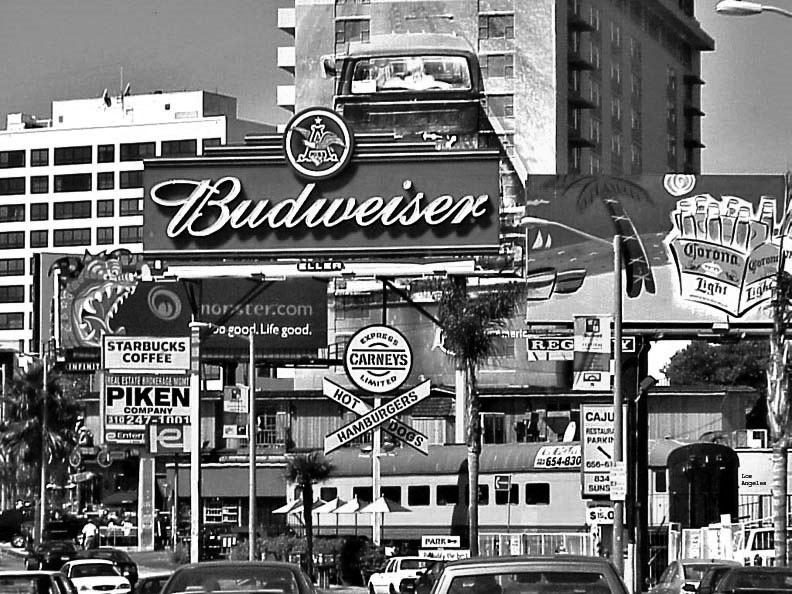 |
|
| (2001)^ - A potpourri of billboards surround Carneys Diner on the Sunset Strip in West Hollywood. |
Historical Notes While this image is much later, it serves as a useful capstone to trace continuity and change: the sunset strip’s billboard culture persisted, but billboard sizes, styles, regulations, and the saturation of ad space had evolved. Billboards in 2001 are more modern in execution, perhaps more regulated, with newer materials, possibly digital or lit in different ways. They also show how signage remains part of Los Angeles’s identity—touristic, performative, expressive. |
* * * * * |
Aviation in Early LA
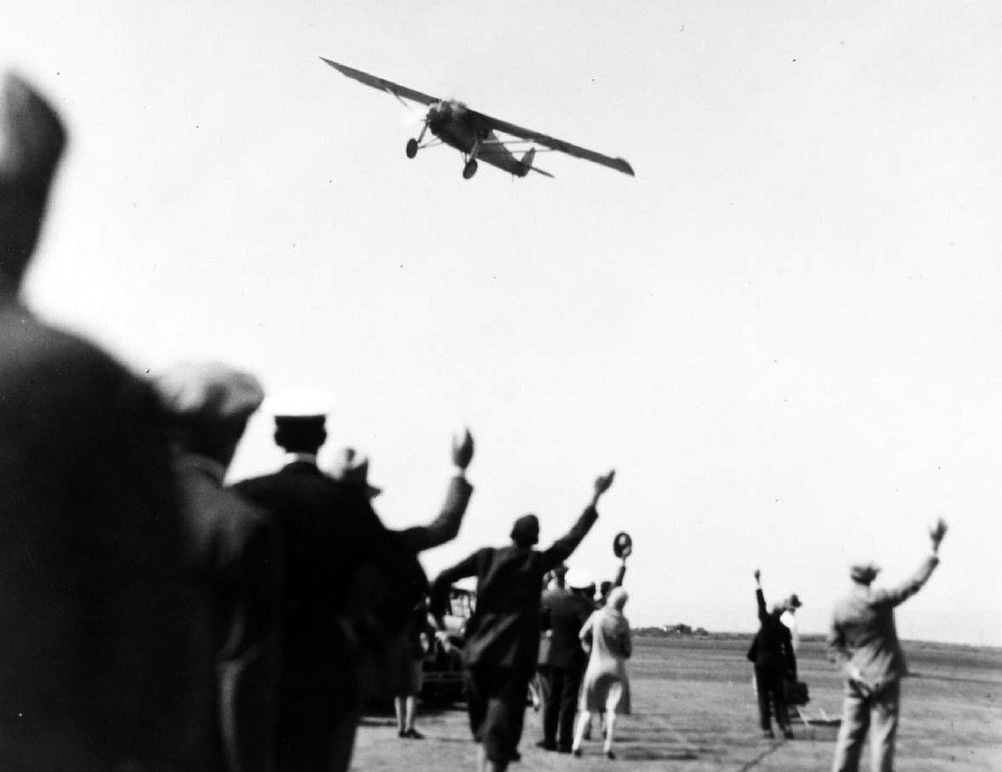 |
|
| (1927)#^#* - Charles Lindbergh in his Spirit of Saint Louis preparing to land as spectators waive. |
Historical Notes In 1927, Charles Lindbergh landed The Spirit of St. Louis at the Vail Field, Montebello (outside of Los Angeles), while on a nationwide tour following his transatlantic flight (May 21, 1927).^* |
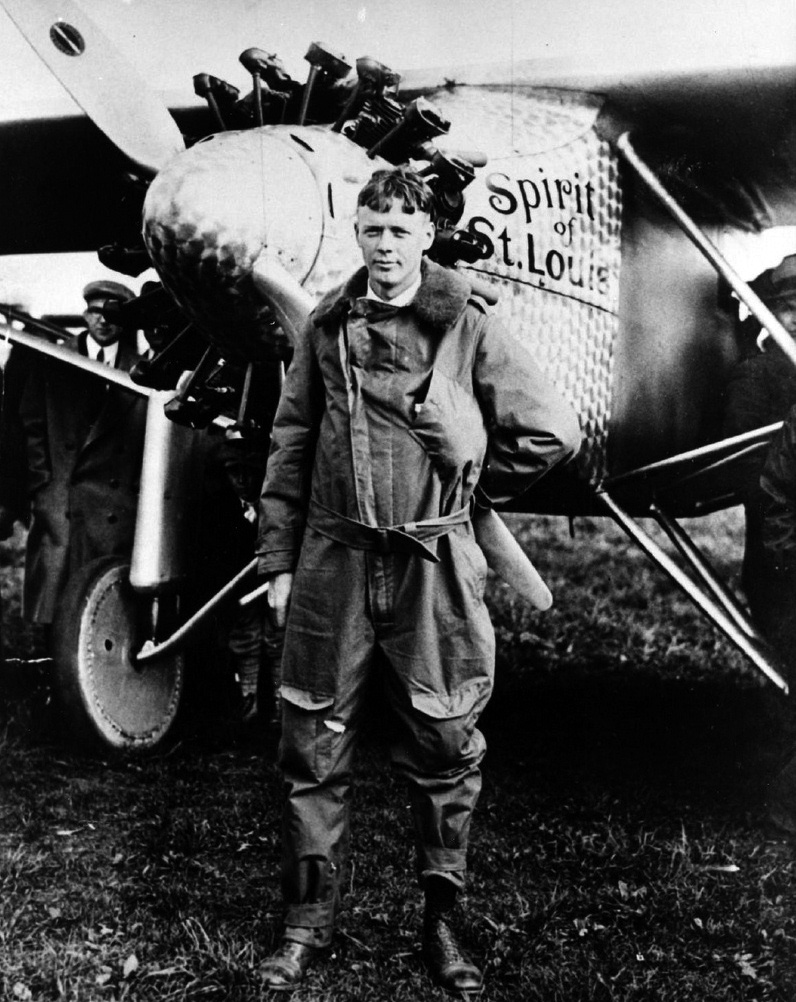 |
|
| (1927)#^#* - Charles Lindbergh in front of the Spirit of St. Louis. |
Historical Notes Charles Augustus Lindbergh (1902-1974), an Army reserve officer and U.S. Air Mail pilot gained instant world fame when on May 21, 1927, he flew solo on a non-stop flight from Roosevelt Field on Long Island to Le Bourget Field in Paris in the single-seat, single-engine monoplane named the "Spirit of St. Louis". Because of this historic exploit, Lindbergh - nicknamed "Lucky Lindy" and "The Lone Eagle", was awarded the Medal of Honor, the nation's highest military decoration. In his later years, Charles Lindbergh became a prize-winning author, international explorer, inventor, and active environmentalist.^* |
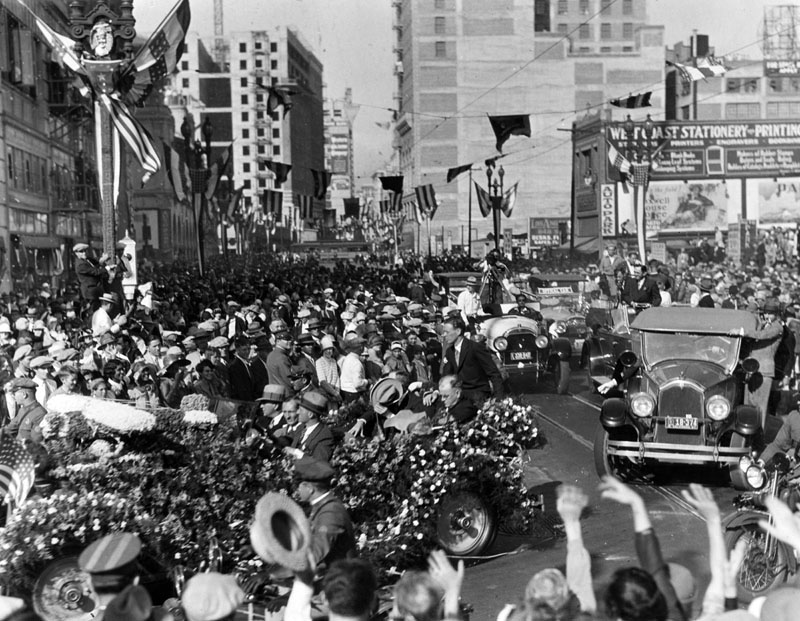 |
|
| (1927)^ - View of a parade honoring Col. Charles A. Lindbergh, as it passes in front several large buildings along Broadway and 10th Street, in Downtown Los Angeles. Col. Lindbergh (wearing a dark suit) can be seen sitting atop the seat at the rear of the car decorated entirely with white roses; then-Mayor Porter sits next to him. Multitudes of people line both sides of the street, and colorful and patriotic banners hang across the street as far as the eye can see. |
Historical Notes The parade through Downtown Los Angeles took place on September 21, 1927, four months to the day after Col. Lindbergh flew solo non-stop from Roosevelt Field to Paris aboard the "Spirit of St. Louis".^ |
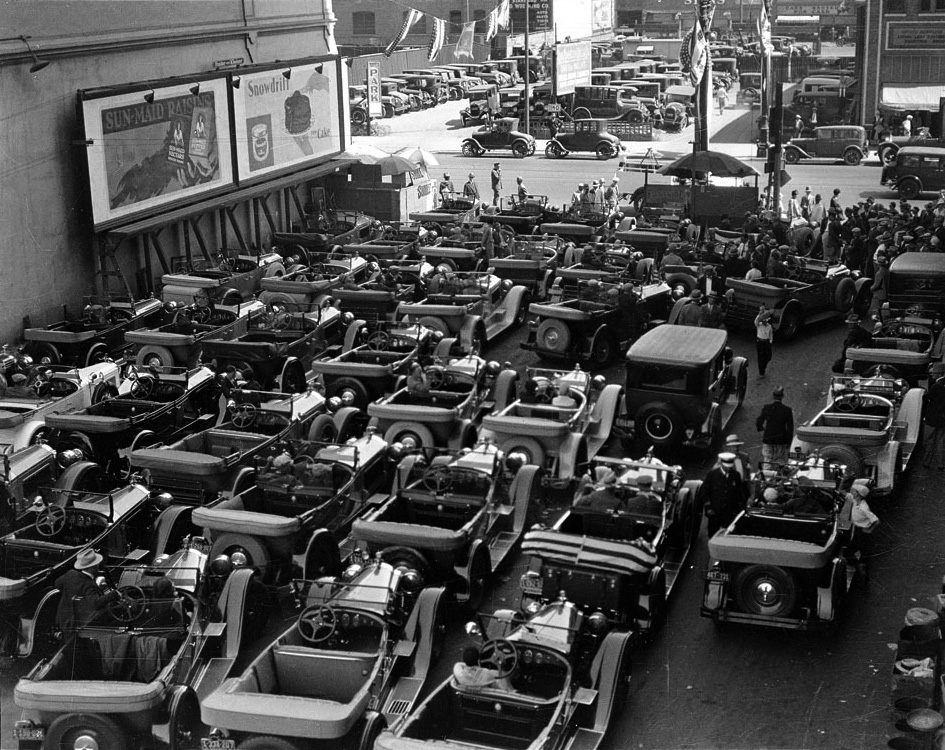 |
|
| (1927)#** - Photograph of parked automobiles at the parade for Charles Lindbergh. Approximately nine rows of cars are parked door-to-door in an alleyway flanking the parade route. Two billboards are attached to the wall at left and advertise for "Sun-Maid Raisins" and "Snowdrift for Cake". A second parking lot can be seen across the street. |
Historical Notes On June 1st, 1927, the U.S Post Office issued a commemorative 10-cent "Lindbergh Air Mail" stamp depicting the Spirit over a map of its flight from New York to Paris, and which was also the first stamp issued by the post office that bore the name of a living person.^* |
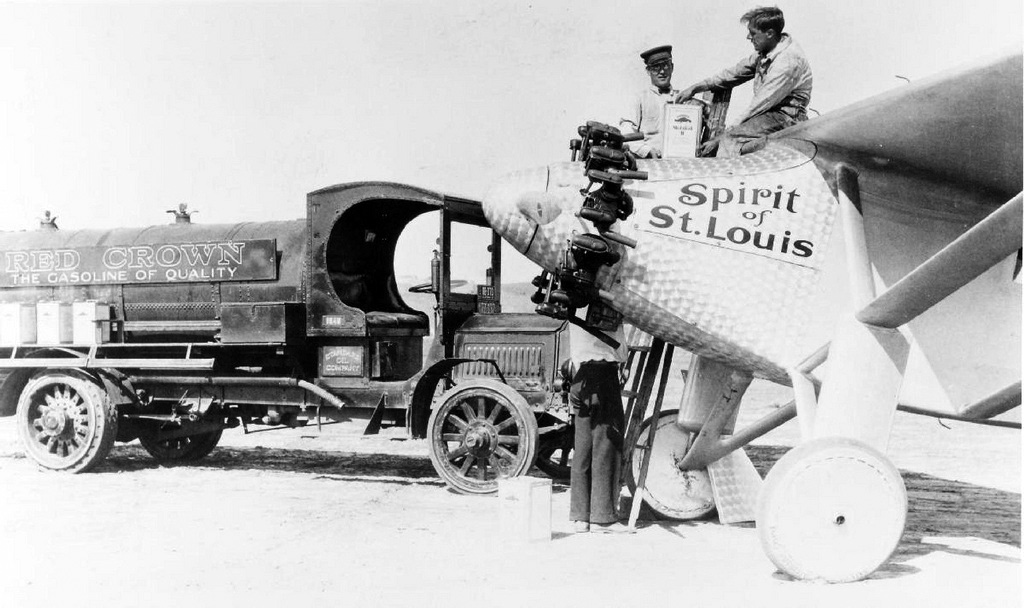 |
|
| (1927)#^#* - Three men are in the process of fueling the Spirit of St. Louis. |
Historical Notes The Spirit of St. Louis had a fuel capacity of 450 U.S. gallons or 2,385 pounds which was necessary in order to have the range to make the transatlantic non-stop flight. The large main fuel tank was placed in the forward section of the fuselage, in front of the pilot, which improved the center of gravity. While locating fuel tanks at the front reduced the risk of the pilot's being crushed to death in the event of a crash, this design decision also meant that there could be no front windshield, and that forward visibility would be limited to side windows only. A periscope was installed to provide a forward view, as a precaution against hitting ship masts, trees, or structures while flying at low altitude. Lindbergh also used special navigation instruments such as the Earth Inductor Compass as its main instrument, allowing Lindbergh to navigate while taking account of the magnetic declination of the earth.^* |
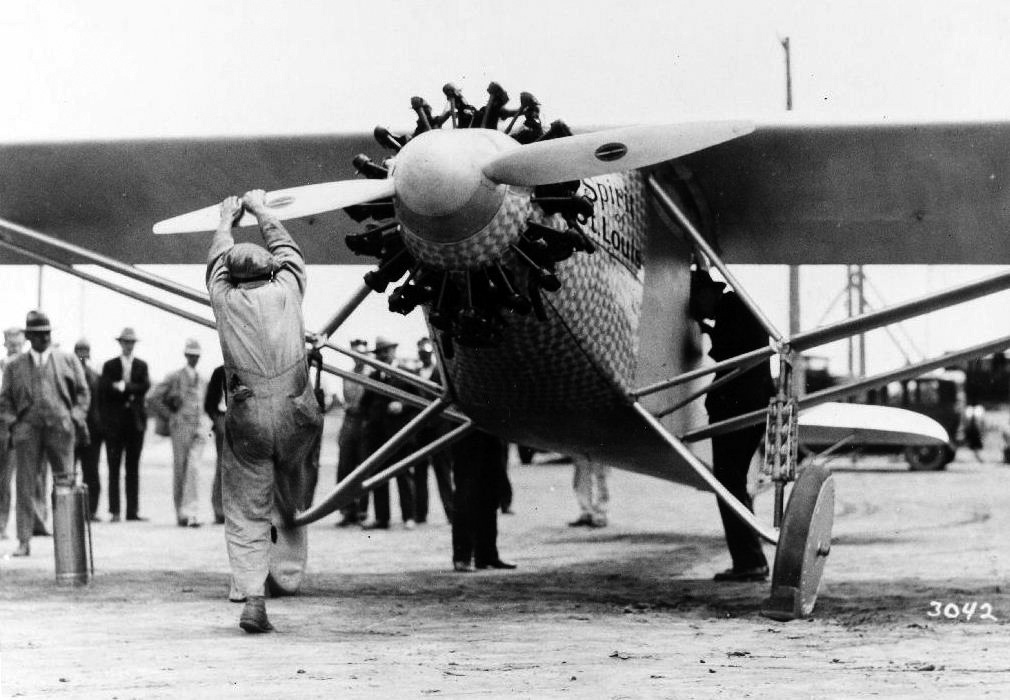 |
|
| (1927)#^#* - Mechanic priming propeller of the Spirit of St. Louis as Charles Lindbergh prepares to take off to continue his goodwill tour. |
Historical Notes After his historic May 1st, 1927 transatlantic flight, Lindbergh flew the Spirit on promotional and goodwill tours across the United States and Latin America for over 10 months.^* |
Click HERE to see more in Aviation in Early Los Angeles |
* * * * * |
Downtown
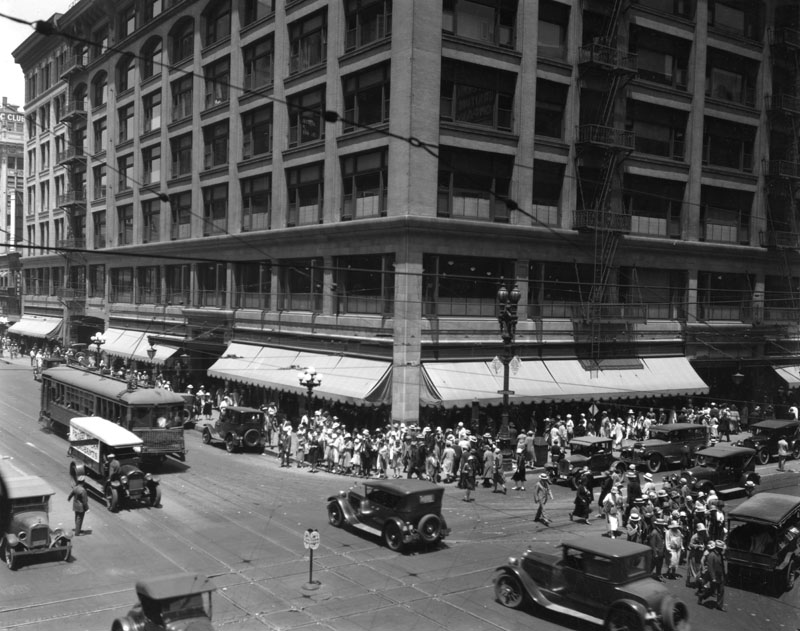 |
|
| (ca. 1928)^ - Crowds of pedestrians are crossing the street in front of the Bullock's department store. A policeman is directing traffic in the lower left of photo. |
Historical Notes Bullock's was founded in 1907 at Seventh & Broadway in downtown Los Angeles by John G. Bullock, with the support of The Broadway Department Store owner Arthur Letts. In 1923, Bullock and business partner P.G. Winnett bought out Letts' interest after his death and the companies became completely separated.*^ Bullock’s flagship store proved so successful that it expanded quarters in 1912. The company purchased adjacent buildings in 1917 and 1919 for a total of 460,000 square feet. By 1920 Bullock’s and Robinson’s functioned as anchors to an elite shopping precinct that was unprecedented in Los Angeles.^##^ |
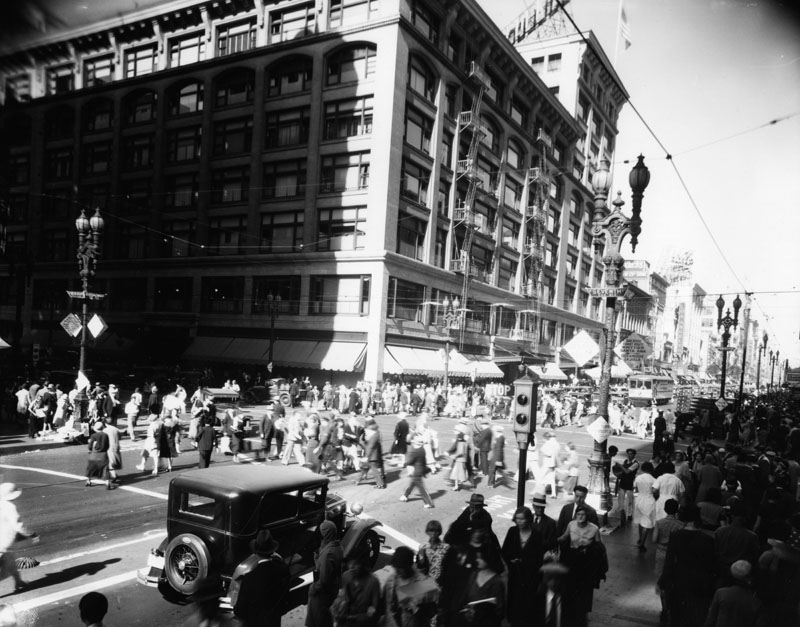 |
|
| (ca. 1930)^ - Crowds of pedestrians are crossing the street in this picture of the intersection of 7th and Broadway. On the far corner (northwest corner of Broadway) is the Bullock's Department Store. |
Historical Notes Between 1923 and 1928, Bullock’s added an additional 400,000 square feet through the construction of three more additions while also purchasing two adjacent buildings.^##^ |
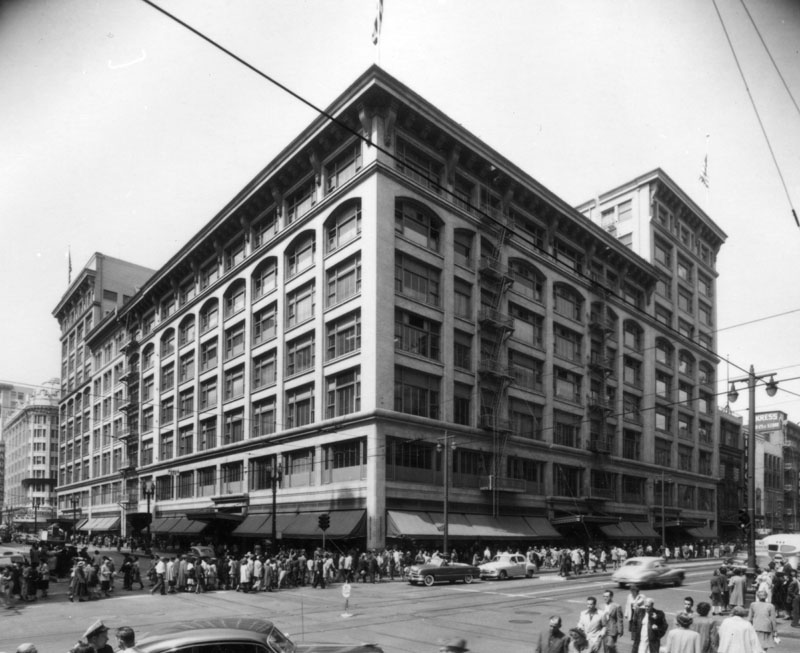 |
|
| (1951)^ - Corner of 7th and Broadway with Bullock's Department Store. A large crowd of pedestrians is in front of the store and crossing the street. Cars, including a convertible, are waiting for the pedestrians to pass in order to turn the corner. |
Historical Notes In 1923, John G. Bullock and business partner P.G. Winnett bought out Arthur Letts' interest after his death and the companies became completely separated. In 1929 Bullock & Winnett opened a luxury branch on Wilshire Boulevard, named Bullock's Wilshire.^##^ Bullock’s Downtown closed in 1986. The building is now the St. Vincent's Jewelry Center.^ |
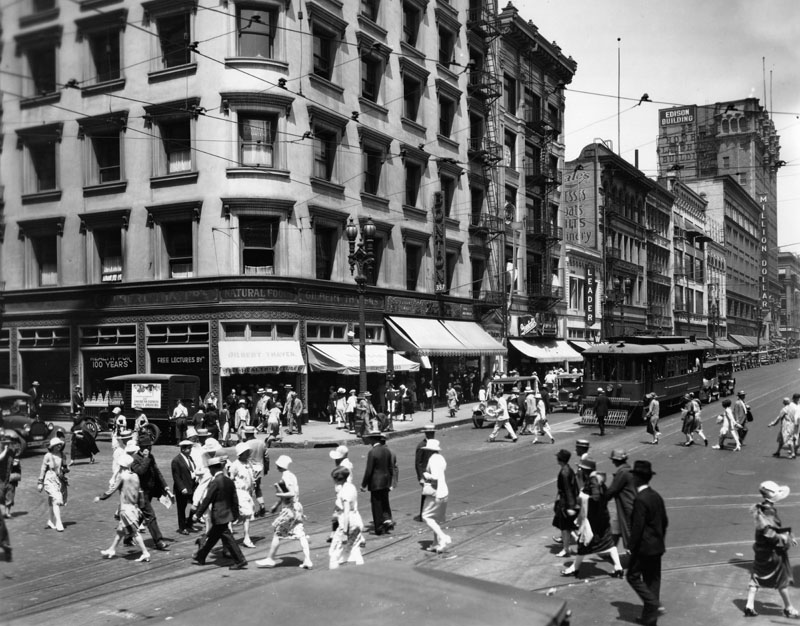 |
|
| (1929)^ - Looking north on Broadway the street is filled with pedestrians crossing 4th St. A trolley and cars can be seen waiting their turn. The Million Dollar Theatre can be seen in the distance (upper right of photo). Note the variety of stylish hats being worn. |
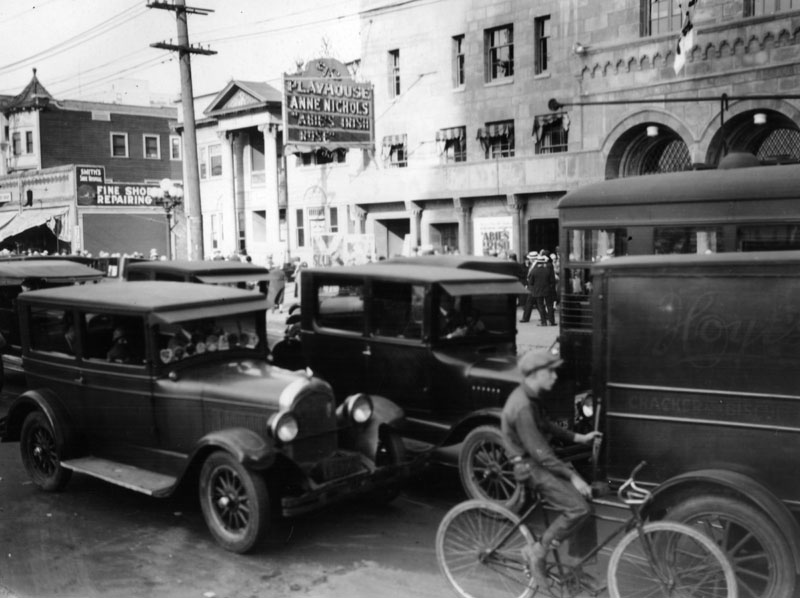 |
|
| (ca. 1929)^ - A view of Variety Arts Theater located at 940 S. Figueroa which at the time of this picture was named Figueroa Playhouse. Across the view of cars and a boy on a bicycle hitching onto a truck, you can see the marquee: "Anne Nichols Abie's Irish Rose". |
* * * * * |
Pico Union District
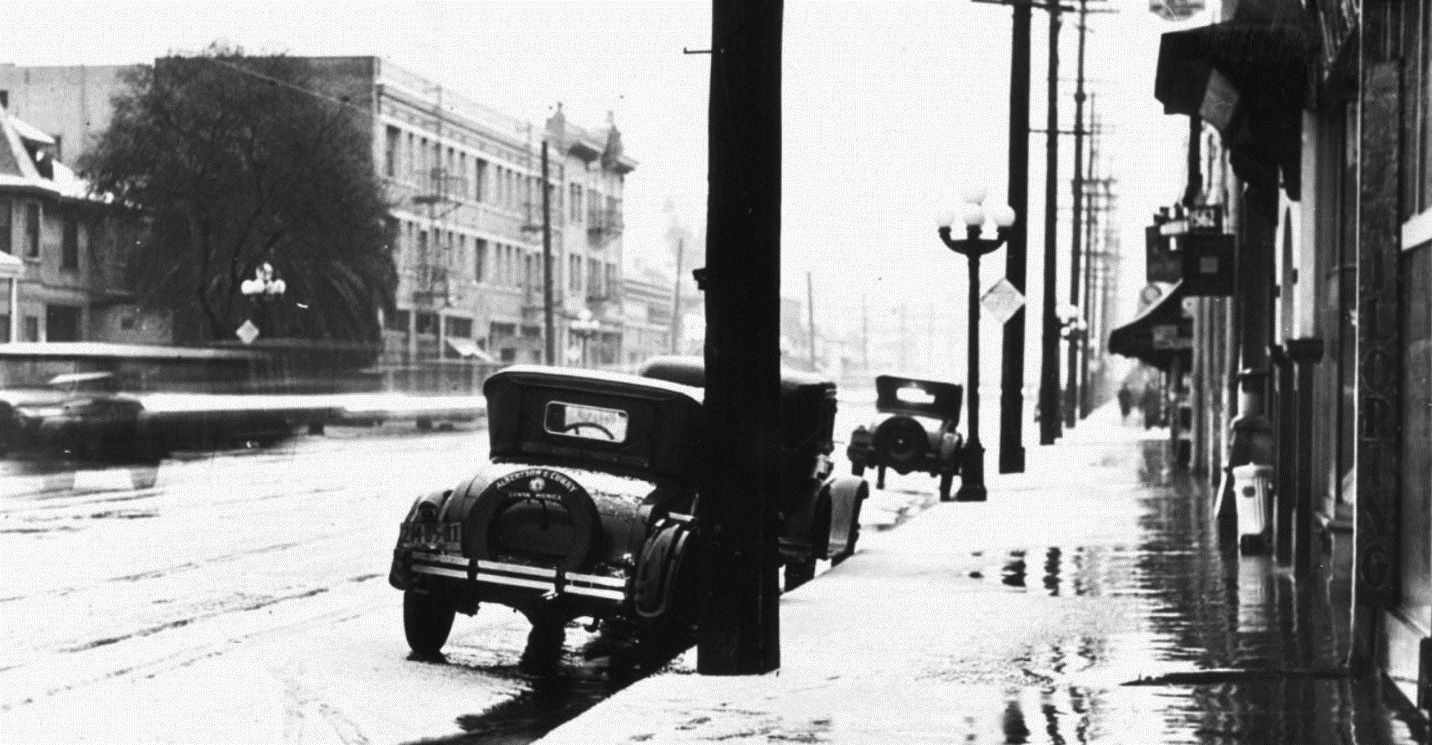 |
|
| (1930)*# - View showing a snow-covered Pico Boulevard east from Union Avenue. Shops and sidewalks line the street at right. Parked along the sidewalks are three early automobiles; another car can be seen traveling at left on the wet street. There are Victorian houses and a tall three-story rectangular building in the background at left. Most of the snow has melted and it has left large puddles that reflect the surrounding scenery. Legible signs include, from left, "ZM8581", "Albertson & Curly Santa Monica", "Tailoring", and "First Class Shoe Repair". |
Historical Notes The Pico Union neighborhood was originally developed between 1880 and 1930 as a fashionable suburb known as the Westlake District. Early residents, including European immigrants, enjoyed easy access to downtown on streetcars along Pico and Washington Boulevards. Mexican-American residents settled in Pico Union in the early twentieth century. As Los Angeles continued to grow westward, the area changed from a suburban retreat at the city’s edge to an increasingly diverse, urban neighborhood at its center.^ |
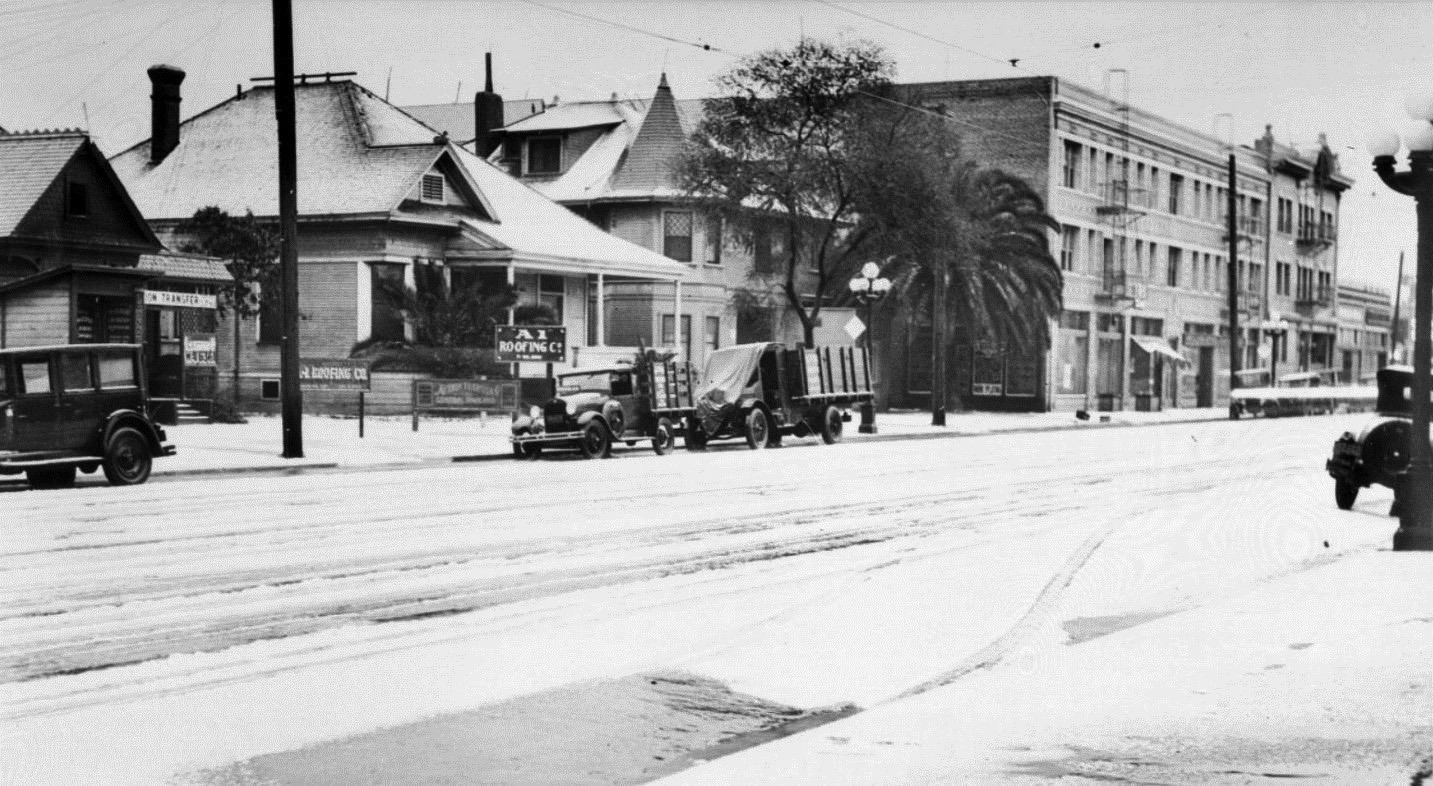 |
|
| (1930)*# – View of a snow-covered Pico Boulevard east from Union Avenue. In the foreground, a small patch of the street was protected from the snow by a car that has since pulled away and left its tracks in the snow. The far side of the street (north side) is lined with Victorian houses and a large, rectangular, three-story building. Legible signs include, from left, "Laundry", "...ion Transfer", "WA 6361", and "A1 Roofing Co.". |
Then and Now
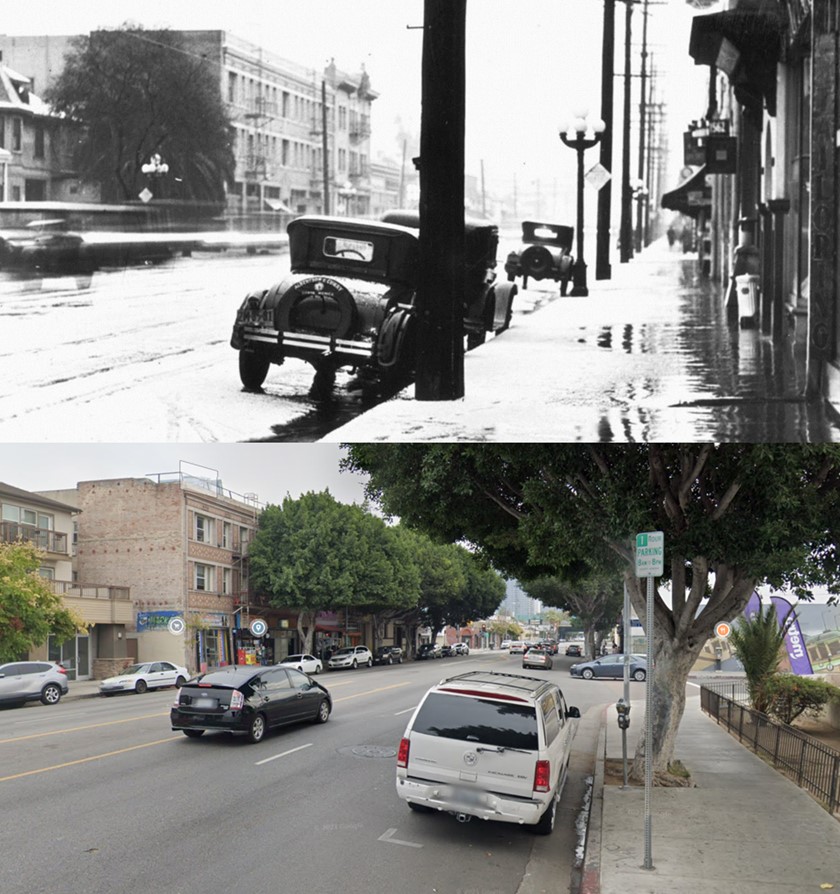 |
|
| (1930 vs. 2022) – Pico Boulevard looking east from near Union Avenue. |
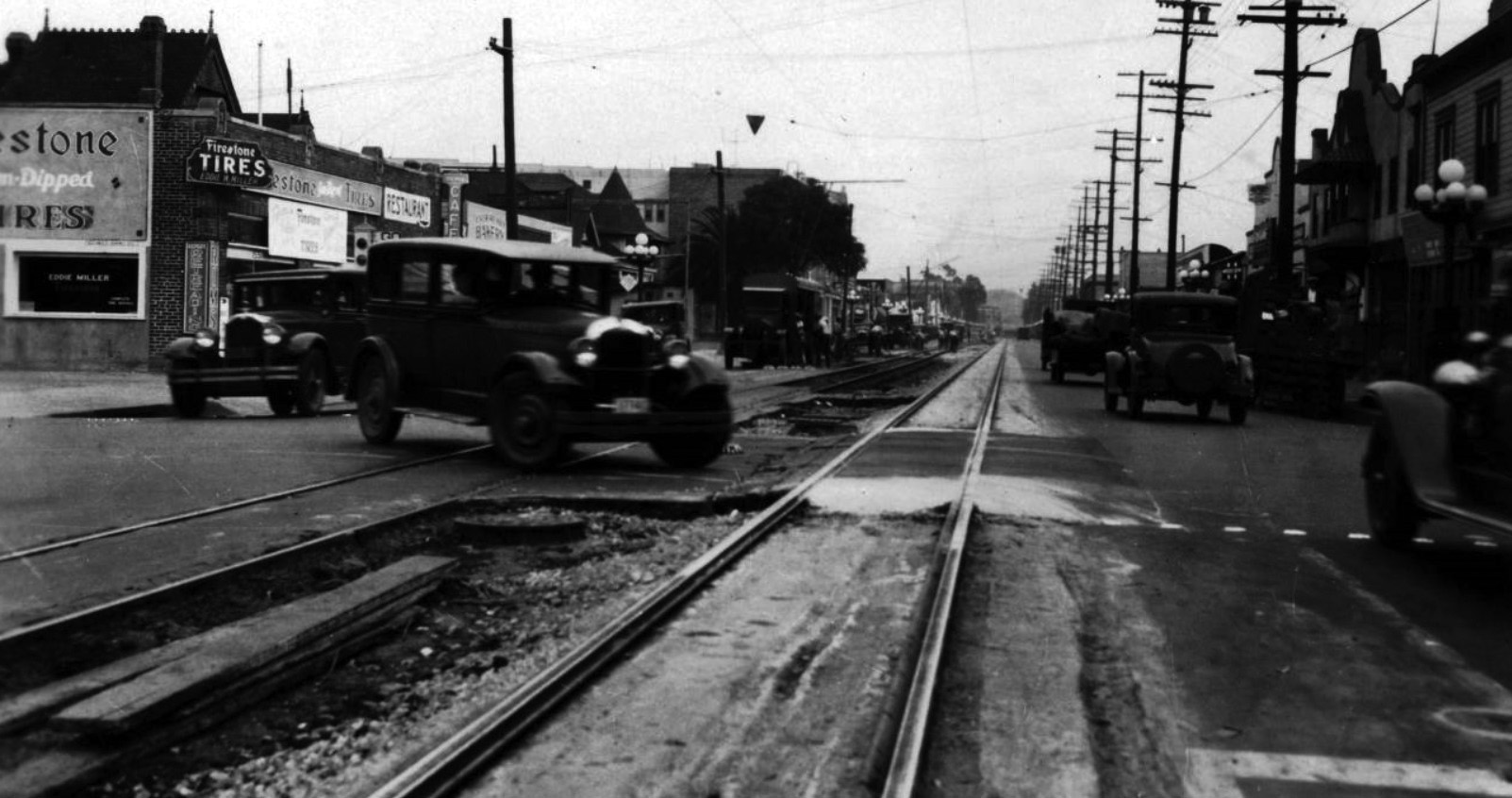 |
|
| (1928)*# - View looking east on Pico Boulevard at Union Avenue showing a car turning left over the Los Angeles Railway crossing. |
Historical Notes The area encompassed by Pico-Union was developed as a middle and upper middle class residential district beginning in the 1910s. Easy access to downtown Los Angeles and the nearby Wilshire District drew large numbers of affluent homeowners. Following the Second World War, the Pico-Union area, like many inner city neighborhoods, experienced an outflux of residents to the suburbs. The loss of residents and business led to high vacancy rates and lower property values in much of the neighborhood by the 1960s.^ |
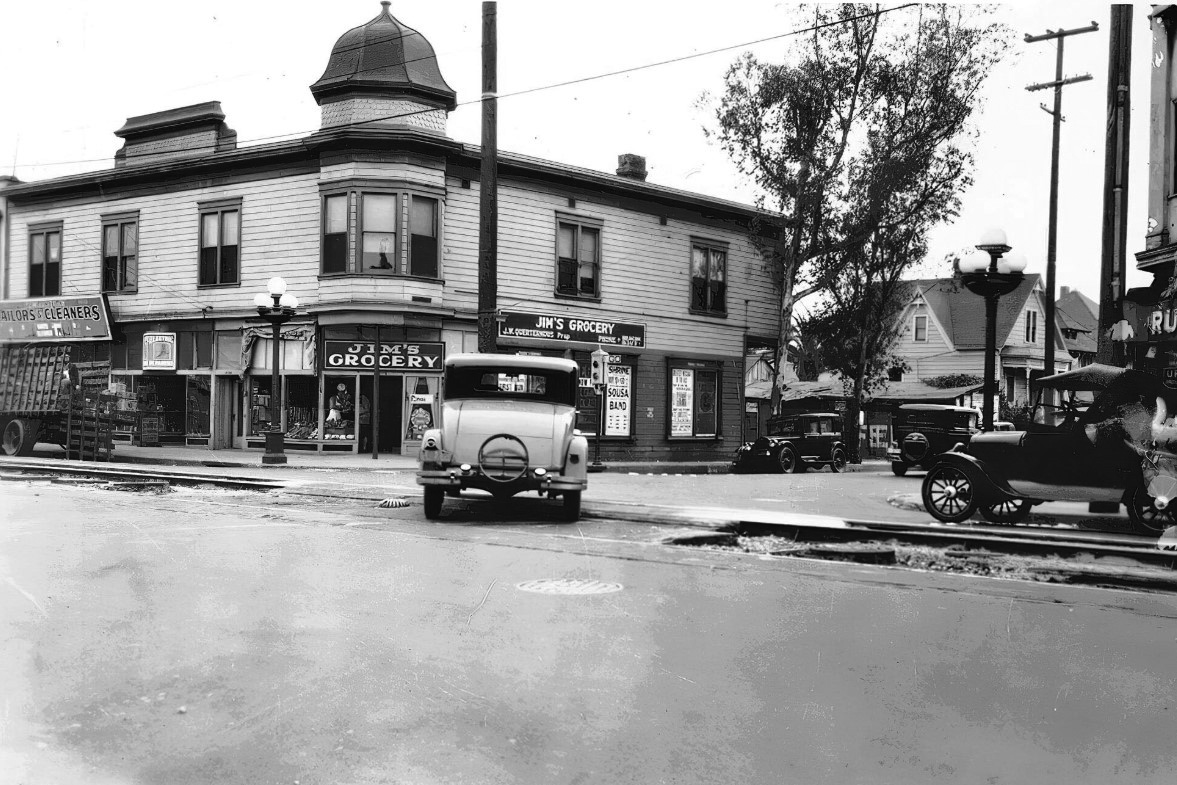 |
|
| (ca. 1932)^.^ – View looking SE showing an early model car makes a left turn unto Union Avenue as it crosses the streetcar tracks on Pico Boulevard. Jim’s Grocery is seen on the ground floor of the corner building. |
Historical Notes The 5-globe streetlights seen above were known as 'Pico' Electroliers. Manufactured by Llewellyn Iron Works Company, these ornate streetlights were found on Pico Boulevard from Main Street on the East to Vermont Avenue on the West. Click HERE to see more. |
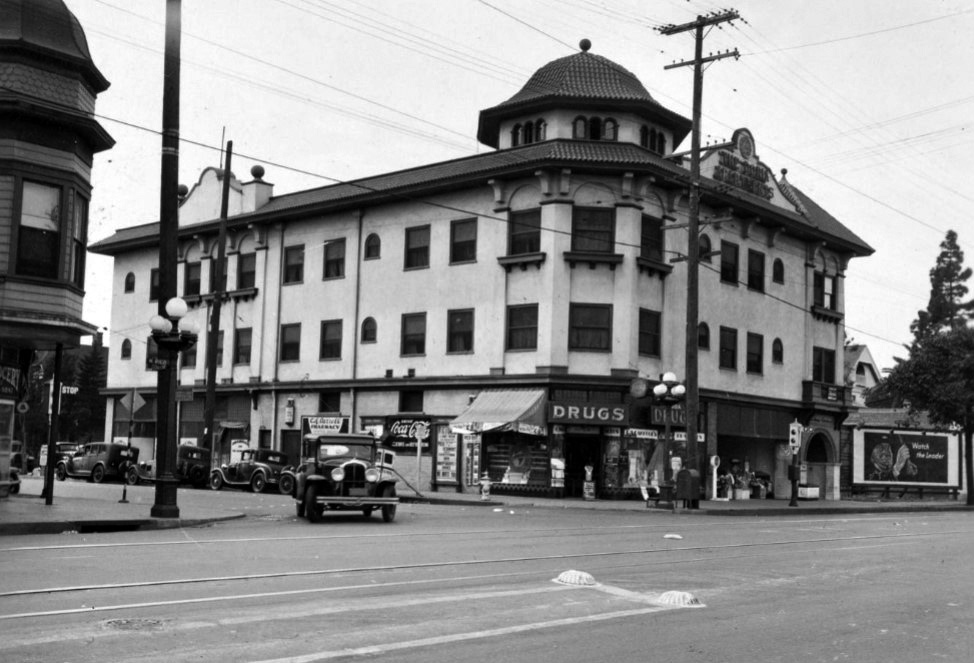 |
|
| (1932)* – View looking SW showing a car making a right turn unto Pico Boulevard from Union Avenue. “The Doria Apartments” stands on the SW corner. Built in 1905, this Mission Revival-style building with a tiled roof dome is still stnding today. Click HERE to see a contemporary view. |
Historical Notes Doria Deighton Jones, an influential player in early Los Angeles, developed the Doria Apartments in 1903. The building is located at Pico Boulevard and Union Avenue on the SW corner. In 1989, the Doria Apartments building was declared Los Angeles Historic-Cultural Monument No. 432. |
Then and Now
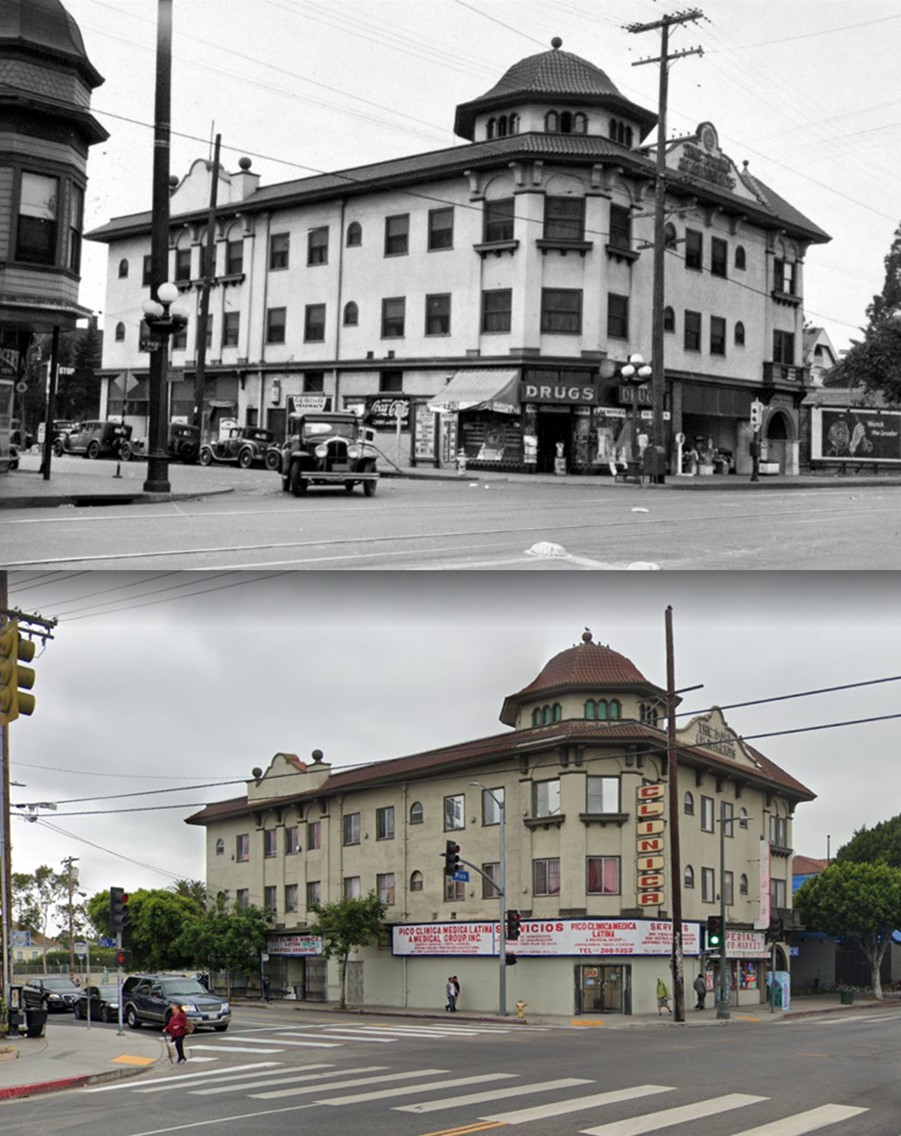 |
|
| (1932 vs. 2019)* – Doria Apartments, SW corner of Pico and Union. |
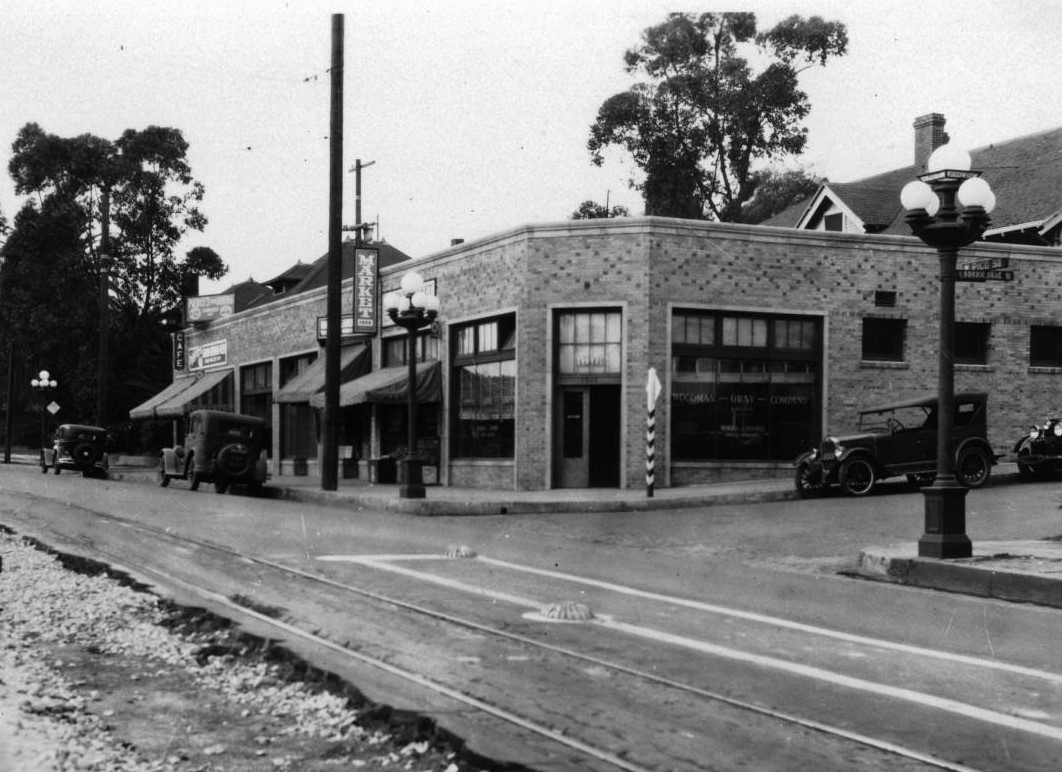 |
|
| (1928)*^ – View looking west on Pico Boulevard at Bonnie Brae Street with ornate streetlights (Pico Llewellyn Streetlights) seen on the corners. The above building located on the NW corner (1901 W. Pico) still stands today. Click HERE for contemporary view. |
Historical Notes The name “Pico Union” refers to the neighborhood that surrounds the intersection of Pico Boulevard and Union Avenue. The Los Angeles Community Redevelopment Agency officially adopted the name in 1970, when it launched a neighborhood renewal program that continues to this day. In the 1980s, the area became a major point of entry for Salvadoran and Guatemalan immigrants seeking refuge from civil war. Once home to primarily European and Mexican-American populations, Pico Union is now home to immigrants from Central America, Mexico, Cuba, and Korea, who add new layers to the neighborhood’s unique character. Although the residents have changed, Pico Union still looks much the same as it did more than a century ago. In 2004, the area became the city’s nineteenth Historic Preservation Overlay Zone (HPOZ)—the city’s term for historic district.^ |
* * * * * |
Mercury and Chaplin Aviation Fields
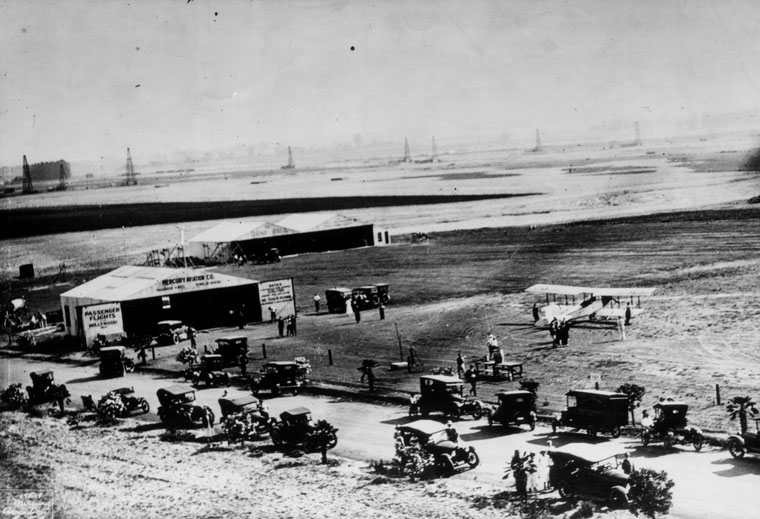 |
|
| (ca. 1920)* - View of Mercury Aviation Field located on Fairfax Avenue (then known as Crescent Avenue) north of Wilshire Bouelvard. |
Historical Notes Cecil B. DeMille founded the Mercury Aviation Company (aka Mercury Air Lines ) in 1919. Mercury was the first American airlines to carry air freight and passengers commercially on regularly scheduled runs. It scheduled service to Santa Catalina Island and San Diego, later San Francisco, with Junker-Larsen JL-6 monoplanes. Inaugurated five months before KLM began operations in Europe.**^^ Mercury’s competitor in the air travel business was across the street at Chaplin Airfield, which was founded in 1919 by Sydney Chaplin. Chaplin was a stage performer and silent film actor before becoming his far more famous sibling’s business manager. |
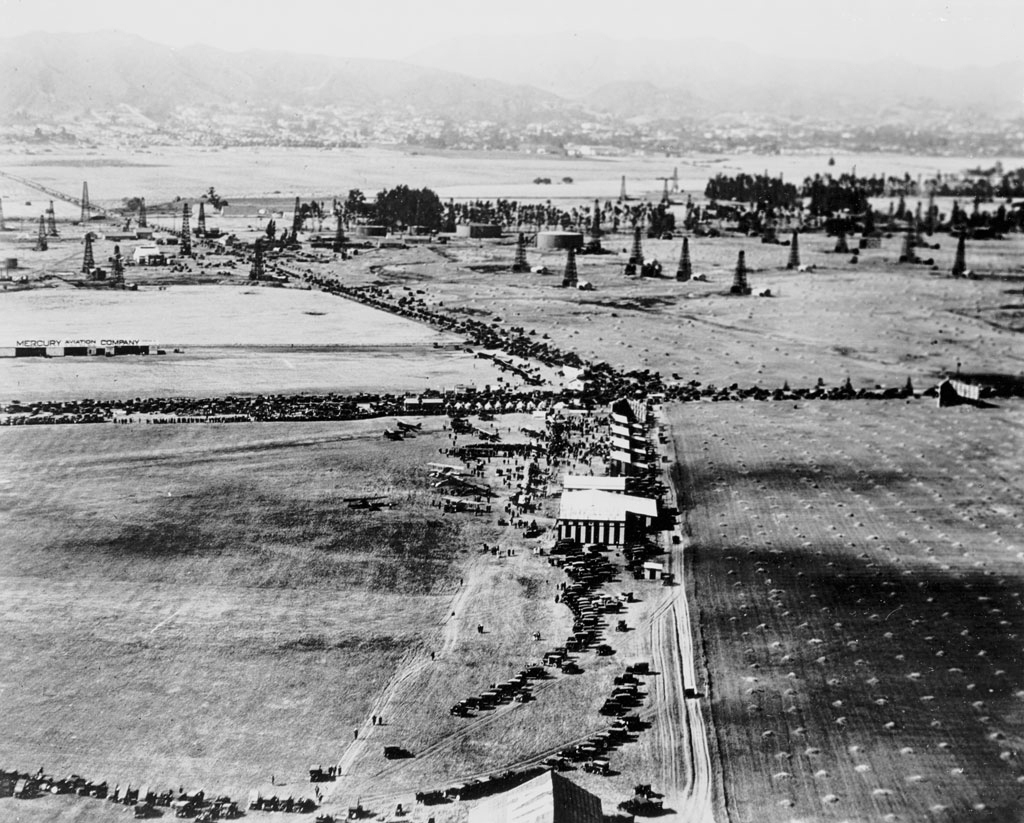 |
|
| (1920s)*# - Aerial view looking northeast showing Crescent Avenue (later Fairfax) heading away from the camera and making a slight turn to the north at Wilshire Boulevard. The Chaplin Airfield, seen southwest of the intersection, is having an air show. Note the oil wells in the distance. |
Historical Notes Chaplin Airport opened in 1918 as Chaplin Airdrome. About 1920 it was called Rogers Airport when it came under the ownership of Emery H. Rogers, owner of Rogers Aircraft Inc.^ Sid Chaplin, the original owner, was also Charlie Chaplin's brother. |
Click HERE to see more in Aviation in Early Los Angeles |
* * * * * |
Early LA Gas Stations
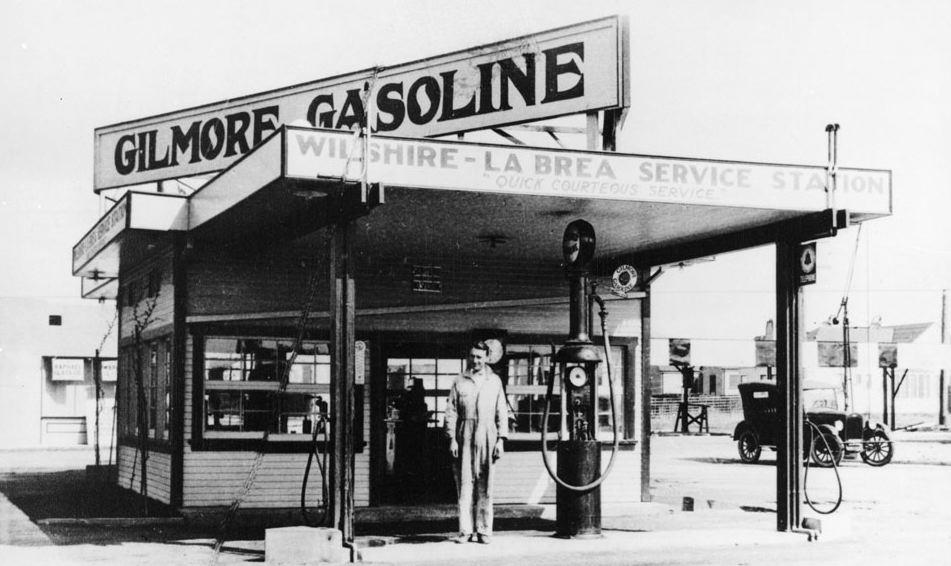 |
|
| (1920s)^^ - The Gilmore Gas Station was one of the first gas stations in Los Angeles. Located at the corner of La Brea and Wilshire Blvd. |
Historical Notes Today, you can find a replica of a gas station modeled after a 1936 era Gilmore Gas Station at Farmers Market. The 1936 replica and the one shown above are very similar. The station was put in place when the Grove Shopping Center was constructed adjacent to Farmers Market in 2002. |
 |
|
| (ca. 1930s)**^ - View of the Gilmore Gas Station located on the southwest corner of Fairfax and Wilshire. The building on the right still stands today. |
Historical Notes Gilmore Gas Stations were eventually bought out by Mobil Oil Co. Click HERE to see more Early Views of LA Gas Stations. |
* * * * * |
Fairfax High School
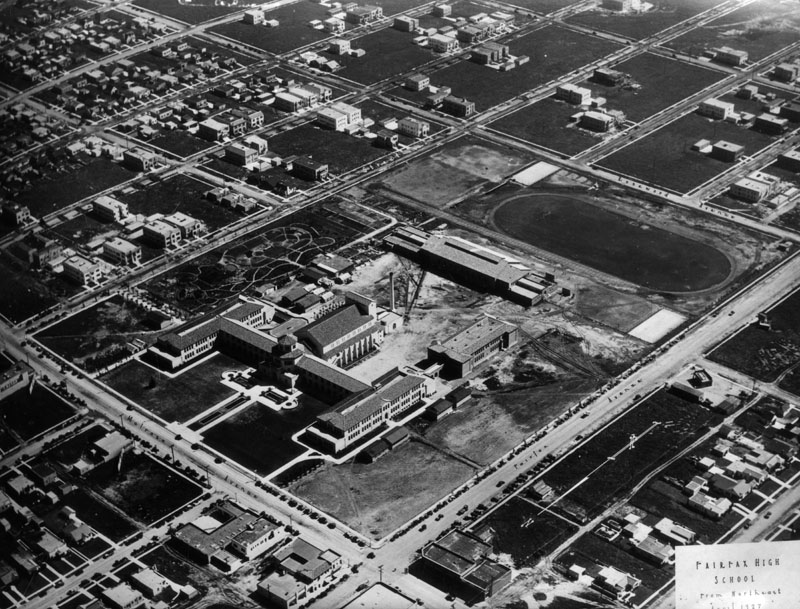 |
|
| (1927)^ - Aerial view looking southeast of Fairfax High School located on the southeast corner of Fairfax and Melrose Avenues. |
Historical Notes Originally, the land around Fairfax “was a swampy area or cienaga, the home of the duck and the mudhen - a veritable hunters’ paradise during the wet season of the year. As land became more valuable, the old cienega was drained and filled and a region suitable for residence created. Because of its swampy condition, the Board of Education was enabled to buy the twenty-eight acres on which this high school stands at a very low figure. When the time came to build our school, through a friend we were able to secure gratis thirty eight thousand loads of dirt. This raised the frontage on Melrose twenty - two inches, and so we are kept out of the water most of the time. Thus we have passed by slow transition from the jungle home of the lords of the forest to the more sheltered home of the Lords of Fairfax.” Written by the first Principal of Fairfax, R.G. Van Cleve - 1963 Yearbook.* |
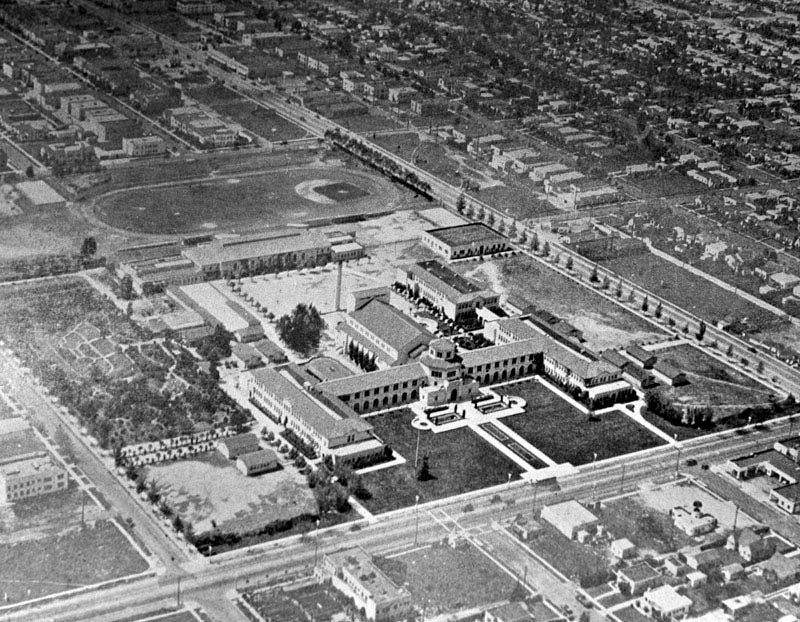 |
|
| (1931)^ - Aerial view of Fairfax High School looking southwest. The tree-lined street running diagonally at top right is Fairfax Avenue. Melrose Ave runs east to west in the foreground. The school's "Rotunda" and auditorium can be seen at center of photo. |
Historical Notes In 1924, Fairfax High School, named for Lord Fairfax of Colonial America, opened its doors. Rae G. Van Cleve, the first principal, wished to make Fairfax very “American and Democratic.” The Fairfax family (direct descendants of Lord Fairfax) in Virginia gave permission to use the coat of arms (Rampant Lion) and the motto “Fare Fax” (“Say and Do”). The student body chose to name “Colonials.” In keeping with the Colonial backgrounds, Student Body officers bore colonial titles. The first boys’ and girls’ groups were called Lords and Ladies, and the student body president was called The Lord High Commissioner. * |
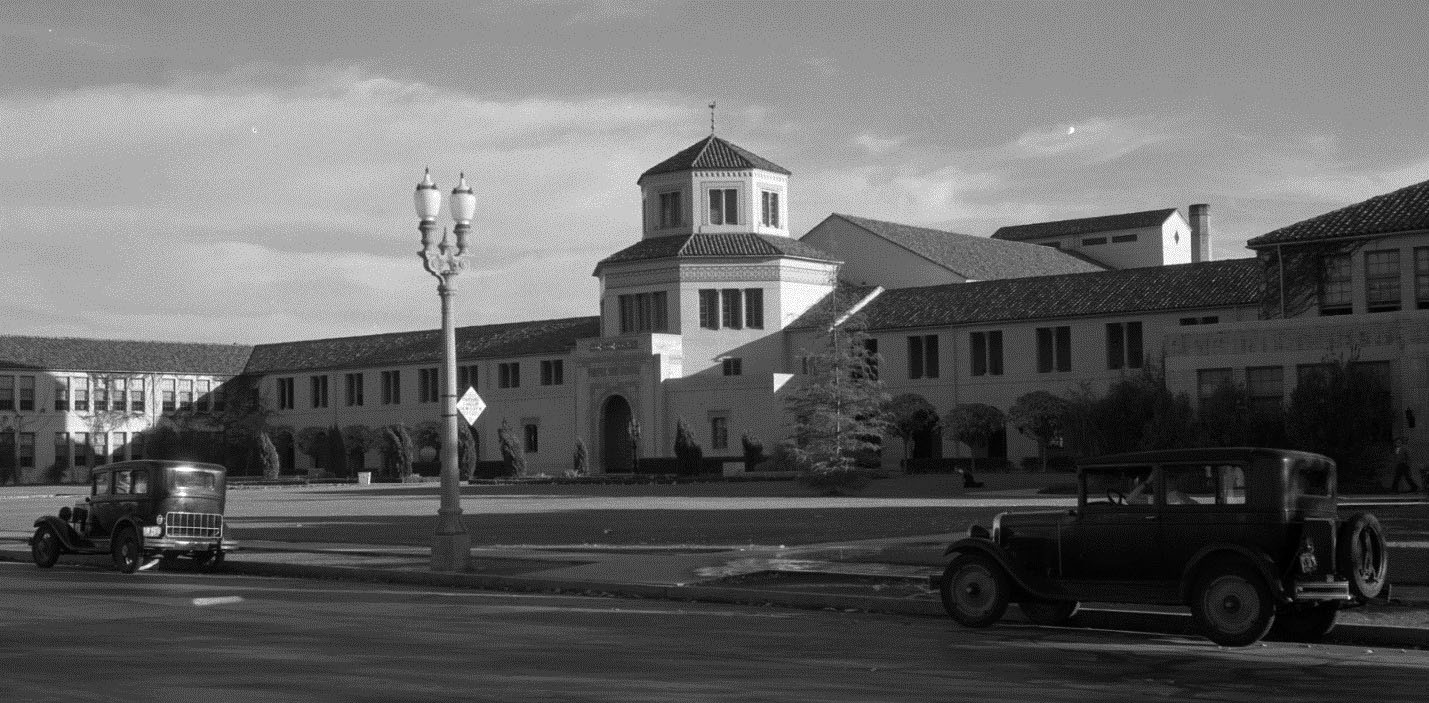 |
|
| (ca. 1931)*– Two early model cars are parked in front of Fairfax High School. Note the ornate two-lamp streetlight. |
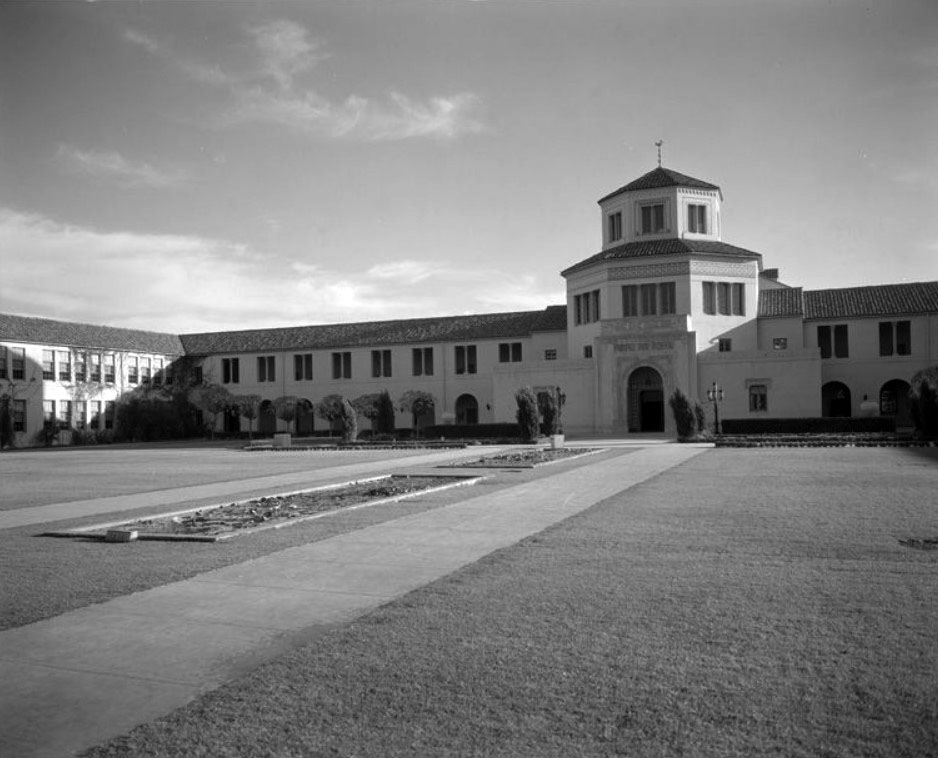 |
|
| (ca. 1931)*– View showing the front lawn leading to the entrance of Fairfax High School as seen from Melrose Avenue. |
Historical Notes Fairfax was initially designed to be an Agricultural & Mechanical school emphasizing “practical” skills. With 28 Acres of campus, school programs included landscape gardening, forestry, architecture, agronomy and an arboretum. The Domestic Science unit supervised the cafeteria so that the “girls” would get practice as well as the theory of cooking and serving “food”. * |
 |
|
| (1926)#*#* - View showing two lily ponds in front of the Fairfax High School Rotunda and Auditorium. Both the Rotunda and Auditorium are the only two original buildings still standing today. |
 |
|
| (ca. 1931)^.^ - View showing a student standing in the Moorish-style entrance of the Fairfax High Rotunda with lily pond seen in the foreground. Note the ornate streetlight at center-left. |
Historical Notes Built in 1924, the 28-acre campus was designed by architectural firm Parkinson & Parkinson in Spanish Colonial Revival style combined with traces of Moorish-style designs. Note the amazing front entrance leading to the still-standing Rotunda. |
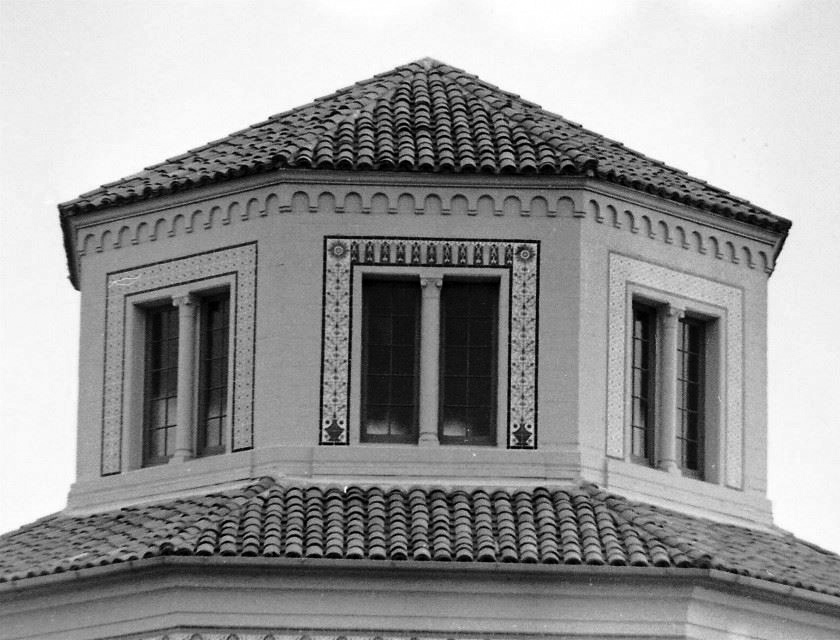 |
|
| (1971)^.^ – Close-up exterior view of the Fairfax Rotunda showing detail tile design including columns bisecting the large windows. Photo by Steven Levine |
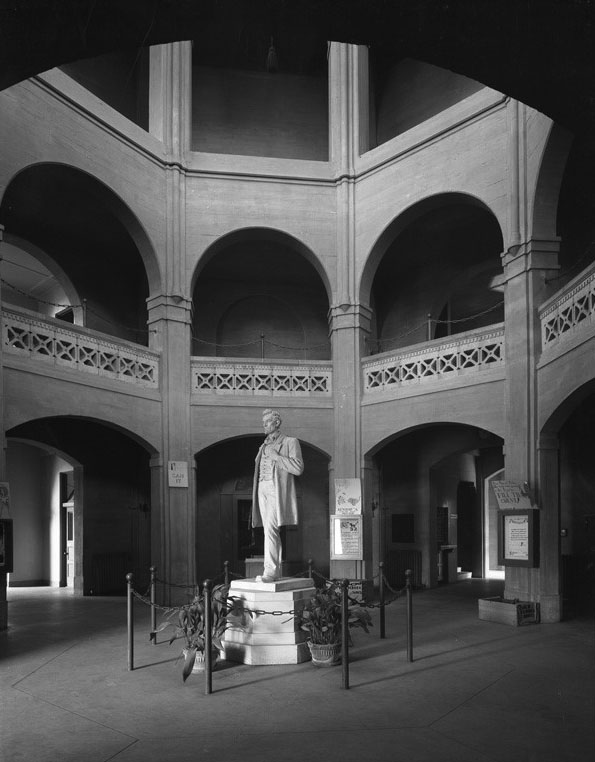 |
|
| (ca. 1931)* – View of the statue of Abraham Lincoln located within the Rotunda of Fairfax High School. |
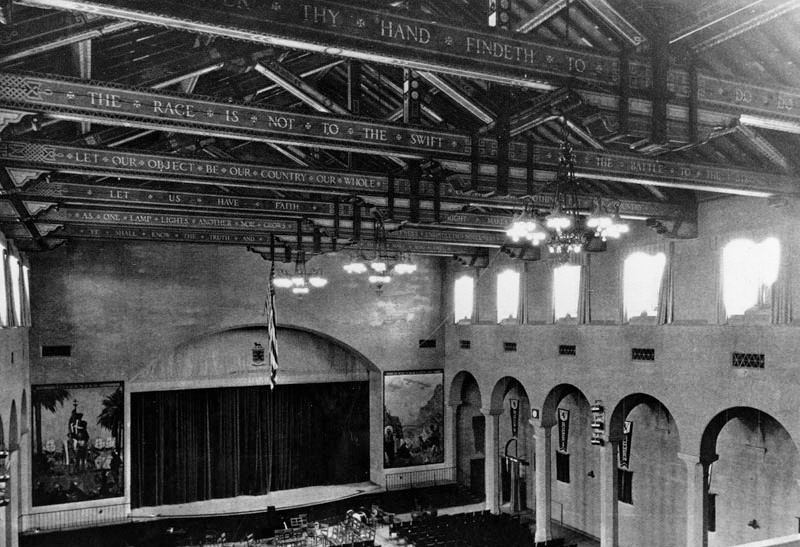 |
|
| (1931)^ - Interior view of the auditorium at Fairfax High School. |
Historical Notes The auditorium was dedicated in 1926 and later named the DeWitt Swan Auditorium, in honor of the first Boys’ Vice Principal. The first annual in 1926 bore the dedication, “Enter to learn; go forth to serve.” In 1927, the summer graduating class dedicated the sunken gardens and the fountain that was located in front of the old building. The same year, a Fine Arts building and a gymnasium were added to the campus. By the time, Fairfax High School (containing grades 7-12) was an established, prestigious element in the Fairfax Community.* |
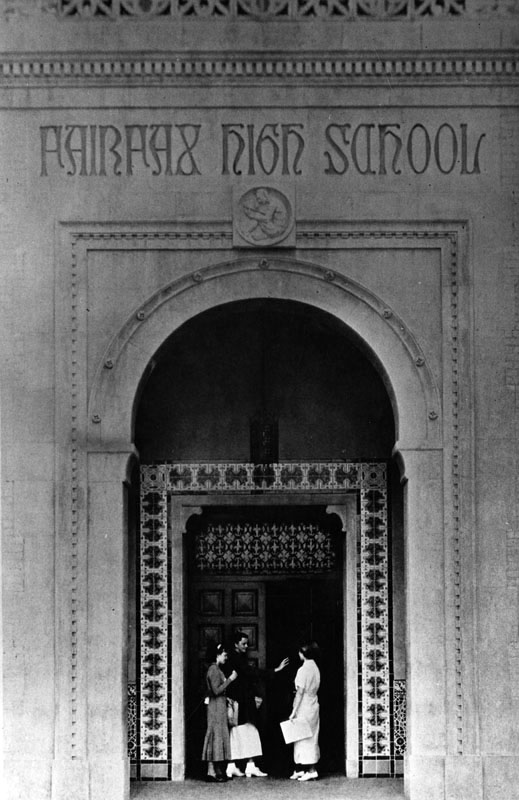 |
|
| (ca. 1931)^ - Students standing outside the Moorish style archway of the entrance to the Fairfax High School auditorium.
“Never say die, say do” - The Fairfax Motto, “Fare Fac”, was the subject of a 1930 contest for the best slogan and motto depicting its meaning. More than 150 entries were submitted. The winning motto: “Noble in speech, honorable in deed”. “Let your words be wise and your actions likewise”. |
Historical Notes When the United States entered the war, hundreds of Fairfax students and alumni joined the military. The 1946 Colonial Yearbook was dedicated to those men and women, 96 of whom lost their lives. During the war years, Fairfax students sold $90,000 in war bonds, conducted numerous recycling material drives. Also in 1946, a Fairfax drama featured Ricardo Montalban and Jim Hardy, once a Lord High Commissioner starred at football. He continued his career at USC and professionally with Rams, Chicago Cardinals and Detroit Lions. * Click HERE for a list of Fairfax High School Notable Alumni. |
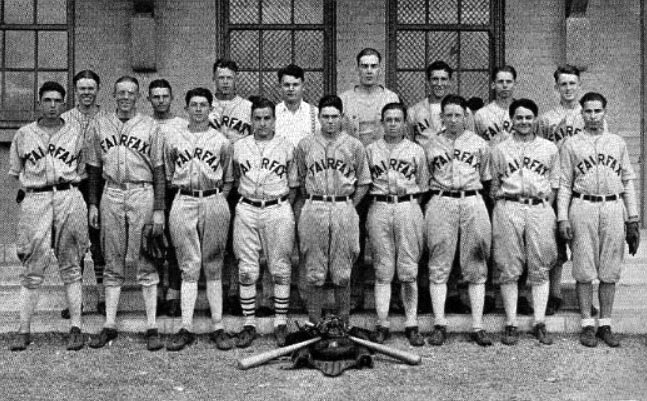 |
|
| (1929)#*#* – The Fairfax Varsity Baseball Team of 1929. Yearbook referred to the team as "Heavyweight Baseball". |
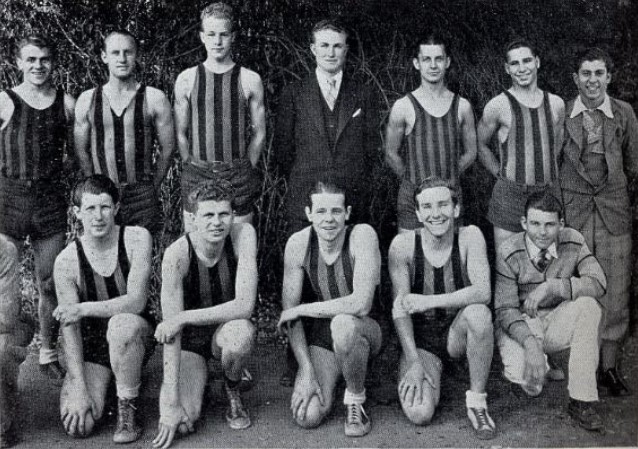 |
|
| (1929)#*#* – The Fairfax Varsity Basketball Team of 1929, at the time referred to as "Heavyweight Basketball". |
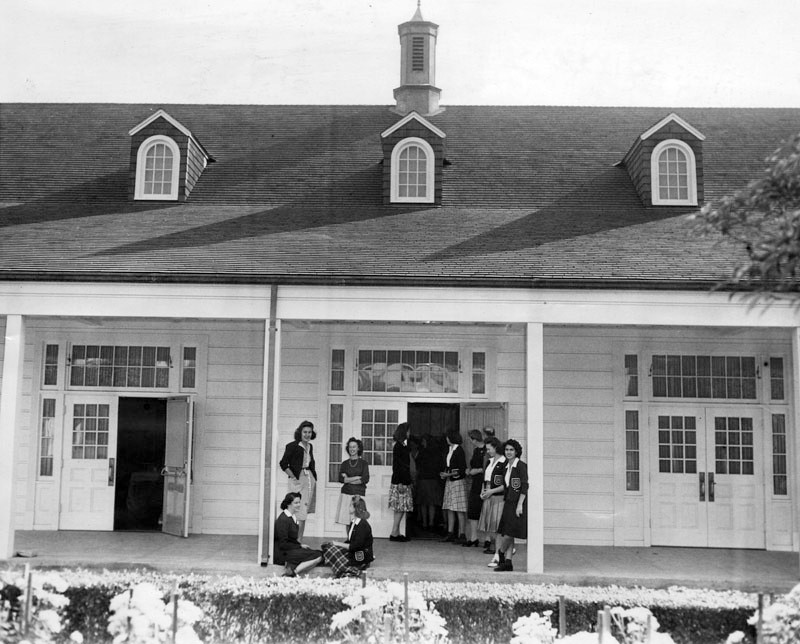 |
|
| (1942)^ - View showing Greenway Court, a replica of the Lord Fairfax mansion in Maryland located on the Fairfax High School campus. |
Historical Notes In 1942, Greenway Court, the Fairfax Social Hall named after Lord Fairfax’s Court in Virginia was dedicated. It was built on campus North of the athletic field and later moved to its present location on Fairfax Avenue. The Greenway Court building sat unused for many years until it was renovated into a professional 99-seat theatre by Greenway Arts Alliance in 2000, to benefit both the school and the surrounding community. Click HERE for contemporary view. |
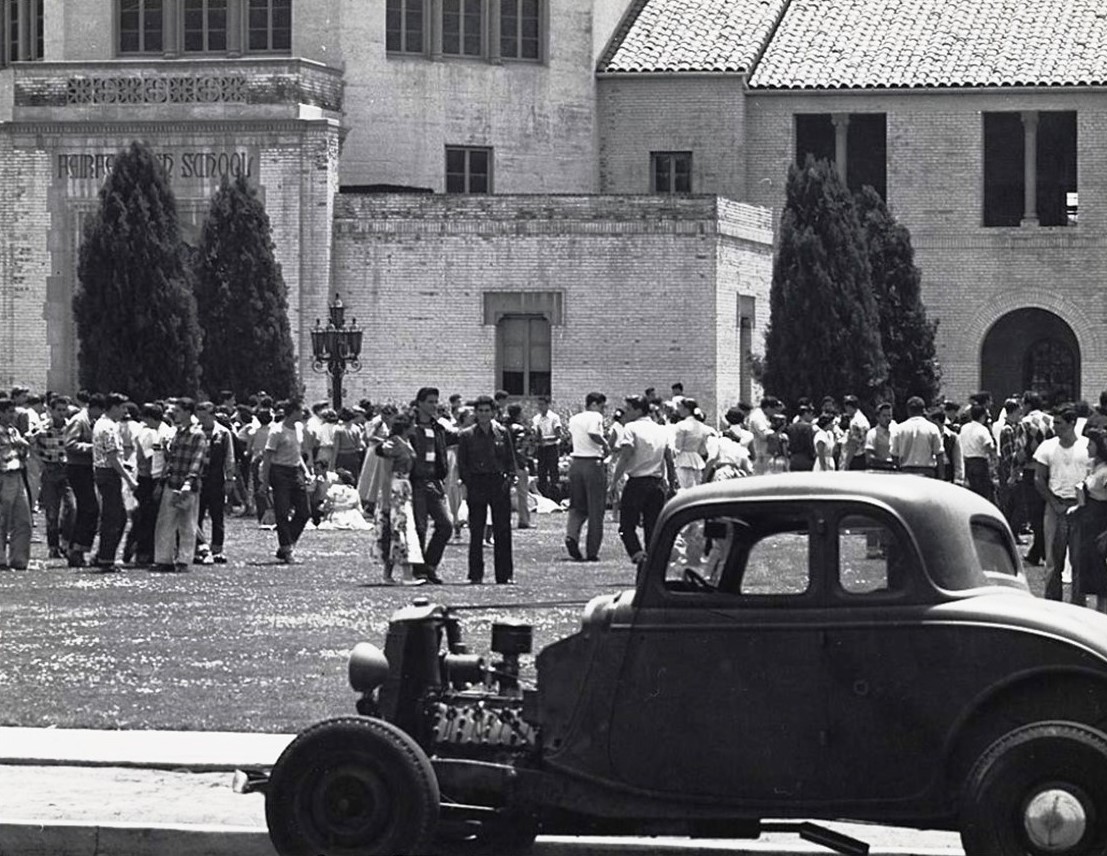 |
|
| (ca. 1946)* - Hot Rod parked in front of Fairfax High School, Max Yavno photo. |
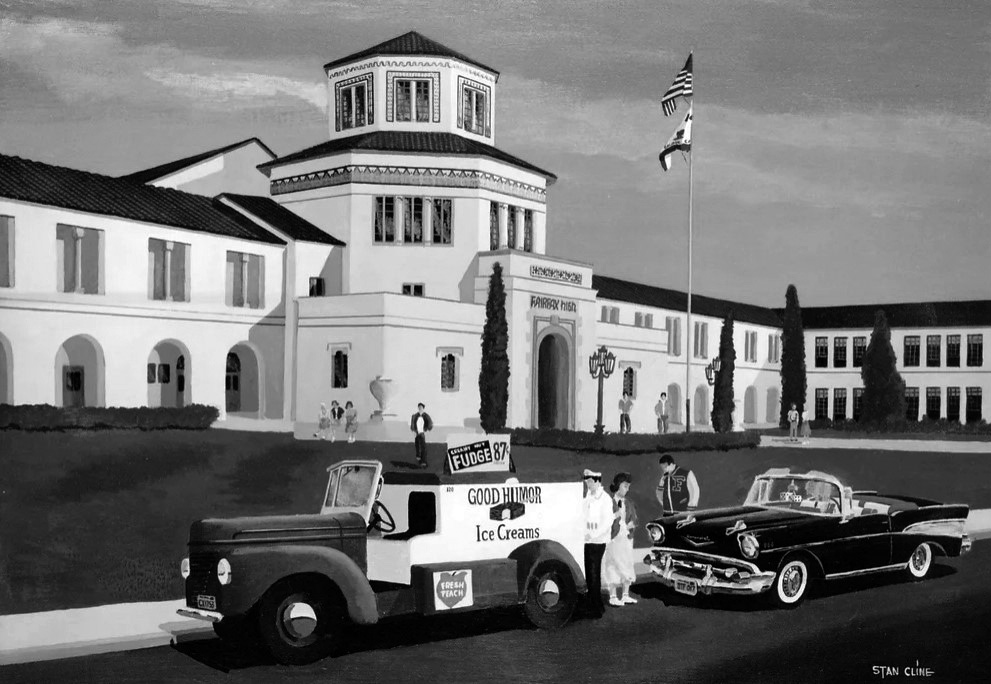 |
|
| A 1957 Chevrolet Convertible is parked behind a Good Humor Ice Cream truck with Fairfax High School in the background. Drawing by Stan Cline |
 |
|
| (1965)^ – Students jump for joy as they celebrate on Graduation Day! |
Historical Notes Because the buildings were not earthquake-safe, the last year of the original campus was 1966. Brick by brick, the old structures came down, and completely new earthquake-safe building arose. New additions included a four-story administration and classroom facility, a physical education plant, an industrial arts complex and cafeteria. Students and faculty moved into the new building in 1968. Because of the unique beauty of the Rotunda and the Auditorium, a public campaign was successful in saving them, and the Auditorium was reinforced for seismic safety. Subsequently, the Fairfax Hall of Fame was established in the Rotunda. * |
 |
|
| (2006)*^ - Fairfax High School as it appears today, with Rotunda in the background. Photo by Gary Minnaert |
Historical Notes Fairfax was the foreign language magnet school in the 1960s and 1970s, offering Hebrew, German, Chinese and Latin, among other languages. The Fairfax Magnet Center for Visual Arts opened in 1981 and remains the only visual arts magnet in the Los Angeles Unified School District. In 1984, Dr. Virginia Uribe, an LAUSD teacher and counselor for 42 years, founded LAUSD’s Project 10 program, the first dropout prevention program specifically for lesbian, gay, bisexual and transgender (LGBT) students in the United States. Organized by a group of local theater artists, the first Melrose Trading Post was held in 1998 in the school's parking lot. Regarded as most successful on-going fund-raising activity in the LAUSD, the flea market evolved into the Greenway Arts Alliance, the Friends of Fairfax and the Institute for the Arts at Fairfax High School, all which are of immense benefit to the school and students. In Fall 2008, Fairfax High School was reconfigured from a comprehensive high school into a complex of five new small learning communities (SLCs) and the existing Fairfax Magnet Center for Visual Arts.*^ |
Then and Now
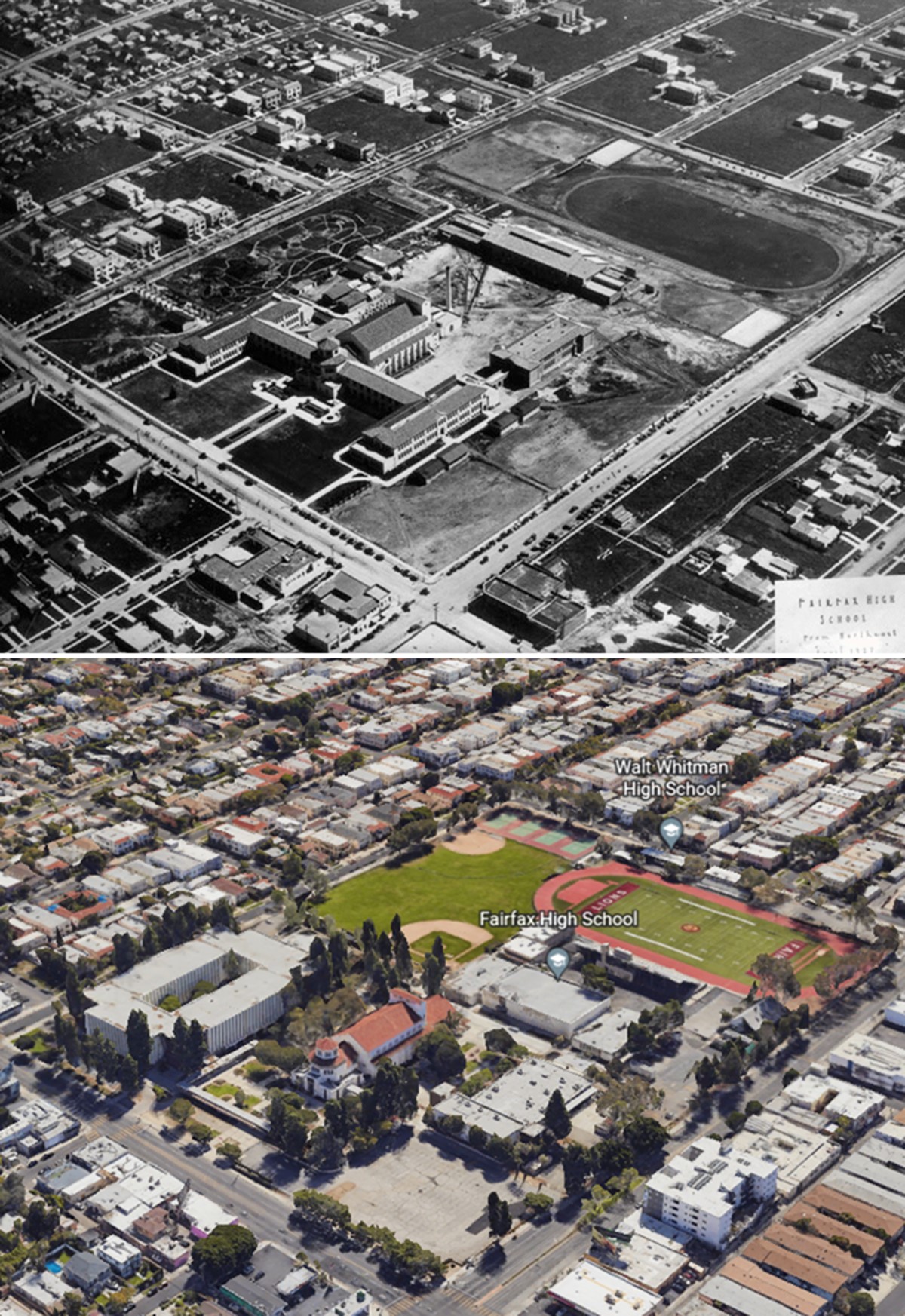 |
|
| (1927 vs 2020) - Aerial view looking southeast showing Fairfax High School. Intersection of Fairfax and Melrose is at lower center. |
Then and Now
 |
|
| (1931 vs. 2019)* - Fairfax High School |
 |
The coat of arms of Thomas Fairfax, 6th Baron Fairfax of Cameron (1693–1781), which became the emblem of the County of Fairfax, Virginia, USA.^* |
Historical Notes There is a connection between Fairfax High School, Gilmore Gas Co., and Thomas Fairfax - a 'Lion'. Fairfax High School and Gilmore's first oil well are located in proximaty to each other and to Fairfax Avenue. It turns out that both Gilmore's logo and Fairfax's mascot is a 'Lion' - which is more than a coincidence. |
|
|
Fairfax High School's Mascot is a lion (left). Gilmore Oil Company's logo was also a lion. |
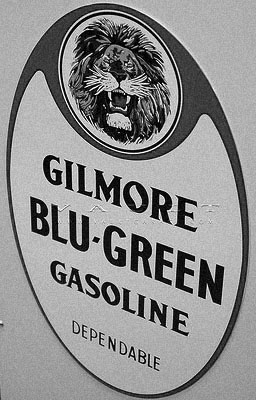 |
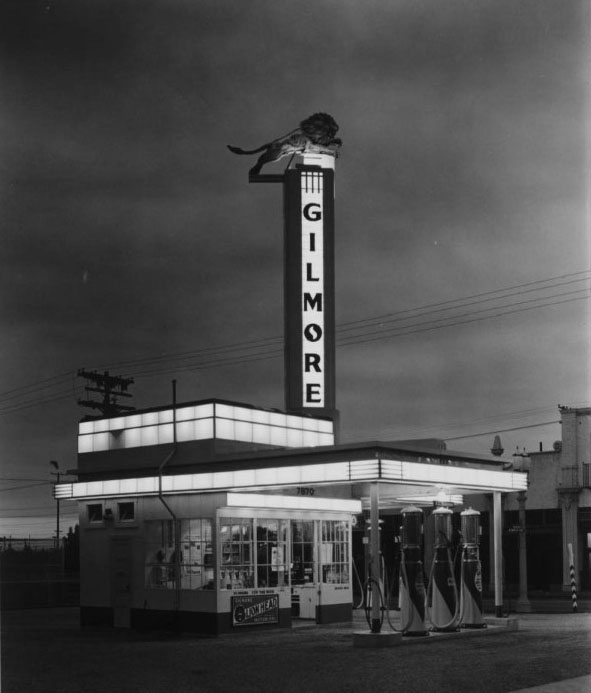 |
|
| (1935)*^#^ – Night view of the Gilmore Service Station located at 7870 Beverly Boulevard, one block east of Fairfax Avenue. Note the lion on top of the illuminated Gilmore sign. |
Historical Notes A.F. Gilmore and his son, Earl Bell (E.B.) turned their Gilmore Oil Company into the largest distributor of petroleum products in the Western U.S. In 1944, Gilmore's 1200 filling stations became Mobil stations.^* Click HERE to see more Early Views of LA Gas Stations. |
 |
|
| (1939)**^ - View of two men standing next to a Gilmore tanker truck. One of the two gentlemen is non-other than Earl Gilmore. |
Historical Notes Earl Gilmore, son of Arthur F. Gilmore, was president of A. F. Gilmore Oil, a California-based petroleum company which was developed after Arthur struck oil on the family property near 3rd and Fairfax. The area was rich in petroleum, which was the source of the "tar" in the nearby La Brea Tar Pits.^* |
* * * * * |
Please Support Our CauseWater and Power Associates, Inc. is a non-profit, public service organization dedicated to preserving historical records and photos. We are of the belief that this information should be made available to everyone—for free, without restriction, without limitation and without advertisements. Your generosity allows us to continue to disseminate knowledge of the rich and diverse multicultural history of the greater Los Angeles area; to serve as a resource of historical information; and to assist in the preservation of the city's historic records.
|
For more Historical Los Angeles Views click one of the following:
For Other Historical Views click one of the following:
See Our Newest Sections:
To see how Water and Electricity shaped the history of Los Angeles click one of the following:
Water:
Power:
* * * * * |
References and Credits
* DWP - LA Public Library Image Archive
^ LA Public Library Image Archive
*^Oviatt Library Digital Archives
^^LA Times Photo Archive; New Viaduct for Red Car Line
#*MTA Transportation and Research Library Archives
#^California Historical Society Digital Archive
^*#Library of Congress: 4th Street Bridge
*^#Los Angeles Conservancy: LA Stock Exchange Building; Warner Bros.Theatre; Downtown Jewelry Exchange/Warner Bros. Theatre
*#*Westland.net: Venice History
+#*LA Curbed
+^^The Eastsider: Riverside-Figueroa Bridge
+++Photobucket
**#The California History Room, California State Library: William Reagh
^^#The George A. Eslinger Street Lighting Photo Gallery
^#^Pacific Electric Railway Historical Society
^## Facebook.com: Photos of Time Travelers
^^*Early Downtown Los Angeles - Cory Stargel, Sarah Stargel
***Los Angeles Historic - Cultural Monuments Listing
*^*California Historical Landmarks Listing (Los Angeles)
*^^Nuestra Señora la Reina de los Ángeles: losangelespast.com
**^^Aerofiles - US Aviation Firsts
**##Facebook.com: Garden of Allah Novels – Martin Turnbull
**^*California State Library Image Archive
*^^*Pinterest.com: Bertrand Lacheze
*^*^Big Orange Landmarks: Los Angeles City Hall
^^^*KCET.org: Three Forgotten Incline Railways; Lost Tunnels of Downtown LA
*^#^Huntington Digital Library Archive
*^^#Los Angeles Past: Temple and Main Streets, Los Angeles - Then and Now
^^*#Historical LA Theatres: Loew's State Theatre; Warner Bros.Theatre; College Theatre
*##^LAist.com: The Knott's Berry Farm You May Not Know
^#^*Noirish Los Angeles - forum.skyscraperpage.com; Broadway Tunnel
^#^^Flickr.com: Michael Ryerson
^#*#LA Magazine: When Knott’s Berry Farm Was Actually a Farm
#*#*Fairfax High School Home Page
#*#^Facebook.com - Los Angeles Theatres: Warner Bros. Downtown
#^#*San Diego Air & Space Museum Archive
^##^Online Archive of California (OAC): Bullock's Department Store Building
##**Franklin HIlls Residents Association
##^*Calisphere: University of California Image Archive
##^^Cinema Treasures: Warner Bros.Theatre
##^#Facebook.com: Classic Hollywood-Los Angeles-SFV
##*^Fourth Street Bridge Over Lorena Street
###+Planet Retro: Mission Soda
++++Facebook.com – Los Angeles Heritage Railroad Museum
#^**Water and Power Associates
**^**Los Angeles City Historical Society
*^*^*Wehadfacesthen.tumblr.com
^^^^#A History of the Los Angeles City Market
**^ Forum.Skyscraperpage.com; 8th and Francisisco; Muller Bros. Service Station; Gilmore Aerial; Shakespeare Bridge; Prospect Studios; Gilmore Tanker Truck; Gilmore Station
^* Wikipedia: Hollywood Sign; Carthay Circle; Carthay Circle Theatre; Fairfax High School; Park La Brea; San Vicente Boulevard; Etymologies of place names in Los Angeles; Los Angeles Central Library; Broadway Tunnel; Pershing Square; Pacific Electric Railway; Gilmore Field; GilmoreStadium; Union Station; Westwood; 6th Street Viaduct Bridge; Figueroa Street Tunnels; Chavez Ravine; 2nd Street Tunnel; Hollywood Freeway; Los Angeles International Airport; Los Angeles City Hall; Wilshire Boulevard Temple; Egyptian Theatre; The Pig 'N Whistle; Sunland-Tujunga; Van de Kamp Bakery Building; Los Angeles County Art Museum; Los Angeles City Oil Field; Los Angeles City Hall; Lafayette Park; Signal Hill; Jonathan Temple; Bullock's; Broadway Theater District: Lowe's State Theater; Obadiah J. Barker; Los Angeles Plaza Historic District; Knott's Berry Farm; KFWB; Rose Bowl Stadium; Olympic Boulevard; Thomas Fairfax; Zeppelin; Los Angeles International Airport; Maddux Air Lines; Charles Lindbergh; Spirit of St. Louis; Hollywood Presbyterian Medical Center; Hollywood; Shakespeare Bridge; Franklin HIlls; John Marshall High School; Prospect Studios; History of Los Angeles; 1926 World Series; Broadway Tunnel
< Back
Menu
- Home
- Mission
- Museum
- Major Efforts
- Recent Newsletters
- Historical Op Ed Pieces
- Board Officers and Directors
- Mulholland/McCarthy Service Awards
- Positions on Owens Valley and the City of Los Angeles Issues
- Legislative Positions on
Water Issues
- Legislative Positions on
Energy Issues
- Membership
- Contact Us
- Search Index
